2019 California Standards for Accessible Design Guide (effective January 1, 2020 with July 1, 2021 amendments)
CHAPTER 11B ACCESSIBILITY TO PUBLIC BUILDINGS, PUBLIC ACCOMMODATIONS, COMMERCIAL BUILDINGS AND PUBLIC HOUSING
11B-101.1 General.
This chapter contains scoping and technical requirements for accessibility to sites, facilities, buildings, and elements by individuals with disabilities. The requirements are to be applied during the design, construction, additions to, and alteration of sites, facilities, buildings, and elements to the extent required by Chapter 1, Section 1.9.

Advisory 11B-101.1 General (2). Accessible features, accommodations and elements must comply with the requirements of Chapter 11B. In some cases Chapter 11B requires compliance with requirements in other parts of the building code. When additional scoping or technical requirements are located in other parts of the building code, the features, accommodations and elements must comply with those regulations and Chapter 11B. ◼
[2010 ADA Standards] 101.1 General. This document contains scoping and technical requirements for accessibility to sites, facilities, buildings, and elements by individuals with disabilities. The requirements are to be applied during the design, construction, additions to, and alteration of sites, facilities, buildings, and elements to the extent required by regulations issued by Federal agencies under the Americans with Disabilities Act of 1990 (ADA).
[ADA Title II] §35.151(a) New construction and alterations; Design and construction.
(1) Each facility or part of a facility constructed by, on behalf of, or for the use of a public entity shall be designed and constructed in such manner that the facility or part of the facility is readily accessible to and usable by individuals with disabilities, if the construction was commenced after January 26, 1992.
[ADA Title III] §36.401(a) New construction; General.
(1) Except as provided in paragraphs (b) and (c) of this section, discrimination for purposes of this part includes a failure to design and construct facilities for first occupancy after January 26, 1993, that are readily accessible to and usable by individuals with disabilities.
(2) For purposes of this section, a facility is designed and constructed for first occupancy after January 26, 1993, only –
(i) If the last application for a building permit or permit extension for the facility is certified to be complete, by a State, County, or local government after January 26, 1992 (or, in those jurisdictions where the government does not certify completion of applications, if the last application for a building permit or permit extension for the facility is received by the State, County, or local government after January 26, 1992); and
(ii) If the first certificate of occupancy for the facility is issued after January 26, 1993.
11B-101.2 Reserved.
[2010 ADA Standards] 101.2 Effect on Removal of Barriers in Existing Facilities. This document does not address existing facilities unless altered at the discretion of a covered entity. The Department of Justice has authority over existing facilities that are subject to the requirement for removal of barriers under title III of the ADA. Any determination that this document applies to existing facilities subject to the barrier removal requirement is solely within the discretion of the Department of Justice and is effective only to the extent required by regulations issued by the Department of Justice.
ETA Editor's Note
While the 2010 ADA Standards and CBC address new construction and alterations of existing facilities, the ADA Title II and ADA Title III regulations include a Safe Harbor provision for existing facilities. These ADA provisions are inserted immediately below. Chapter 11B of CBC does not use the term "Safe Harbor," but contains a limited version of the same principle at Section 11B-202.4, Exception 2. In addition, ADA Title III requires removal of barriers for existing facilities not undergoing alterations as defined in the 2010 ADA Standards, which goes above and beyond responsibilities assigned by CBC. For more information regarding ADA Safe Harbor, go to https://www.ADASafeHarbor.com.
[ADA Title II] §35.150(b) Existing Facilities; Methods.
(2)
i) Safe harbor. Elements that have not been altered in existing facilities on or after March 15, 2012, and that comply with the corresponding technical and scoping specifications for those elements in either the 1991 Standards or in the Uniform Federal Accessibility Standards (UFAS), Appendix A to 41 CFR part 101–19.6 (July 1, 2002 ed.), 49 FR 31528, app. A (Aug. 7, 1984) are not required to be modified in order to comply with the requirements set forth in the 2010 Standards.
ii) The safe harbor provided in §35.150(b)(2)(i) does not apply to those elements in existing facilities that are subject to supplemental requirements (i.e., elements for which there are neither technical nor scoping specifications in the 1991 Standards). Elements in the 2010 Standards not eligible for the element-by-element safe harbor are identified as follows –
A. Residential facilities dwelling units, sections 233 and 809.
B. Amusement rides, sections 234 and 1002; 206.2.9; 216.12.
C. Recreational boating facilities, sections 235 and 1003; 206.2.10.
D. Exercise machines and equipment, sections 236 and 1004; 206.2.13.
E. Fishing piers and platforms, sections 237 and 1005; 206.2.14.
F. Golf facilities, sections 238 and 1006; 206.2.15.
G. Miniature golf facilities, sections 239 and 1007; 206.2.16.
H. Play areas, sections 240 and 1008; 206.2.17.
I. Saunas and steam rooms, sections 241 and 612.
J. Swimming pools, wading pools, and spas, sections 242 and 1009.
K. Shooting facilities with firing positions, sections 243 and 1010.
L. Miscellaneous.
(1) Team or player seating, section 221.2.1.4.
(2) Accessible route to bowling lanes, section. 206.2.11.
(3) Accessible route in court sports facilities, section 206.2.12.
[ADA Title III] §36.304 Removal of Barriers
a. General. A public accommodation shall remove architectural barriers in existing facilities, including communication barriers that are structural in nature, where such removal is readily achievable, i.e., easily accomplishable and able to be carried out without much difficulty or expense
b. Examples. Examples of steps to remove barriers include, but are not limited to, the following actions –
1) Installing ramps;
2) Making curb cuts in sidewalks and entrances;
3) Repositioning shelves;
4) Rearranging tables, chairs, vending machines, display racks, and other furniture;
5) Repositioning telephones;
6) Adding raised markings on elevator control buttons;
7) Installing flashing alarm lights;
8) Widening doors;
9) Installing offset hinges to widen doorways;
10) Eliminating a turnstile or providing an alternative accessible path;
11) Installing accessible door hardware;
12) Installing grab bars in toilet stalls;
13) Rearranging toilet partitions to increase maneuvering space;
14) Insulating lavatory pipes under sinks to prevent burns;
15) Installing a raised toilet seat;
16) Installing a full-length bathroom mirror;
17) Repositioning the paper towel dispenser in a bathroom;
18) Creating designated accessible parking spaces;
19) Installing an accessible paper cup dispenser at an existing inaccessible water fountain;
20) Removing high pile, low density carpeting; or
21) Installing vehicle hand controls.
c) Priorities. A public accommodation is urged to take measures to comply with the barrier removal requirements of this section in accordance with the following order of priorities.
1) First, a public accommodation should take measures to provide access to a place of public accommodation from public sidewalks, parking, or public transportation. These measures include, for example, installing an entrance ramp, widening entrances, and providing accessible parking spaces.
2) Second, a public accommodation should take measures to provide access to those areas of a place of public accommodation where goods and services are made available to the public. These measures include, for example, adjusting the layout of display racks, rearranging tables, providing Brailled and raised character signage, widening doors, providing visual alarms, and installing ramps.
3) Third, a public accommodation should take measures to provide access to restroom facilities. These measures include, for example, removal of obstructing furniture or vending machines, widening of doors, installation of ramps, providing accessible signage, widening of toilet stalls, and installation of grab bars.
4) Fourth, a public accommodation should take any other measures necessary to provide access to the goods, services, facilities, privileges, advantages, or accommodations of a place of public accommodation.
d) Relationship to Alterations Requirements of Subpart D of this Part.
1) Except as provided in paragraph (d)(3) of this section, measures taken to comply with the barrier removal requirements of this section shall comply with the applicable requirements for alterations in §36.402 and §§36.404 through 36.406 of this part for the element being altered. The path of travel requirements of §36.403 shall not apply to measures taken solely to comply with the barrier removal requirements of this section.
i) Safe harbor. Elements that have not been altered in existing facilities on or after March 15, 2012, and that comply with the corresponding technical and scoping specifications for those elements in the 1991 Standards are not required to be modified in order to comply with the requirements set forth in the 2010 Standards.
ii)
(A) Before March 15, 2012, elements in existing facilities that do not comply with the corresponding technical and scoping specifications for those elements in the 1991 Standards must be modified to the extent readily achievable to comply with either the 1991 Standards or the 2010 Standards. Noncomplying newly constructed and altered elements may also be subject to the requirements of §36.406(a)(5).
(B) On or after March 15, 2012, elements in existing facilities that do not comply with the corresponding technical and scoping specifications for those elements in the 1991 Standards must be modified to the extent readily achievable to comply with the requirements set forth in the 2010 Standards. Noncomplying newly constructed and altered elements may also be subject to the requirements of § 36.406(a)(5).
iii) The safe harbor provided in § 36.304(d)(2)(i) does not apply to those elements in existing facilities that are subject to supplemental requirements (i.e., elements for which there are neither technical nor scoping specifications in the 1991 Standards), and therefore those elements must be modified to the extent readily achievable to comply with the 2010 Standards. Noncomplying newly constructed and altered elements may also be subject to the requirements of § 36.406(a)(5). Elements in the 2010 Standards not eligible for the element-by-element safe harbor are identified as follows –
(A) Residential facilities and dwelling units, sections 233 and 809.
(B) Amusement rides, sections 234 and 1002; 206.2.9; 216.12.
(C) Recreational boating facilities, sections 235 and 1003; 206.2.10.
(D) Exercise machines and equipment, sections 236 and 1004; 206.2.13.
(E) Fishing piers and platforms, sections 237 and 1005; 206.2.14.
(F) Golf facilities, sections 238 and 1006; 206.2.15.
(G) Miniature golf facilities, sections 239 and 1007; 206.2.16.
(H) Play areas, sections 240 and 1008; 206.2.17.
(I) Saunas and steam rooms, sections 241 and 612.
(J) Swimming pools, wading pools, and spas, sections 242 and 1009.
(K) Shooting facilities with firing positions, sections 243 and 1010.
(L) Miscellaneous.
1) Team or player seating, section 221.2.1.4.
2) Accessible route to bowling lanes, section 206.2.11.
3) Accessible route in court sports facilities, section 206.2.12.
3) If, as a result of compliance with the alterations requirements specified in paragraph (d)(1) and (d)(2) of this section, the measures required to remove a barrier would not be readily achievable, a public accommodation may take other readily achievable measures to remove the barrier that do not fully comply with the specified requirements. Such measures include, for example, providing a ramp with a steeper slope or widening a doorway to a narrower width than that mandated by the alterations requirements. No measure shall be taken, however, that poses a significant risk to the health or safety of individuals with disabilities or others.
Appendix to §36.304(d) Compliance Dates and Applicable Standards for Barrier Removal and Safe Harbor
|
Date |
Requirement |
Applicable Standards |
|
Before March 15, 2012 |
Elements that do not comply with the requirements for those elements in the 1991 Standards must be modified to the extent readily achievable. Note: Noncomplying newly constructed and altered elements may also be subject to the requirements of § 36.406(a)(5). |
|
|
On or after March 15, 2012 |
Elements that do not comply with the requirements for those elements in the 1991 Standards or that do not comply with the supplemental requirements (i.e., elements for which there are neither technical nor scoping specifications in the 1991 Standards), must be modified to the extent readily achievable. There is an exception for existing pools, wading pools, and spas built before March 15, 2012 [See § 36.304(g)(5)]. Note: Noncomplying newly constructed and altered elements may also be subject to the requirements of § 36.406(a)(5). |
|
|
On or after January 31, 2013 |
For existing pools, wading pools, and spas built before March 15, 2012, elements that do not comply with the supplemental requirements for entry to pools, wading pools, and spas must be modified to the extent readily achievable [See § 36.304(g)(5)] |
Sections 242 and 1009 of the 2010 Standards |
|
Elements not altered after March 15, 2012 |
Elements that comply with the requirements for those elements in the 1991 Standards do not need to be modified |
Safe Harbor |
e) Portable Ramps. Portable ramps should be used to comply with this section only when installation of a permanent ramp is not readily achievable. In order to avoid any significant risk to the health or safety of individuals with disabilities or others in using portable ramps, due consideration shall be given to safety features such as nonslip surfaces, railings, anchoring, and strength of materials.
f) Selling or Serving Space. The rearrangement of temporary or movable structures, such as furniture, equipment, and display racks is not readily achievable to the extent that it results in a significant loss of selling or serving space
g) Limitation on Barrier Removal Obligations.
1) The requirements for barrier removal under §36.304 shall not be interpreted to exceed the standards for alterations in subpart D of this part.
2) To the extent that relevant standards for alterations are not provided in subpart D of this part, then the requirements of §36.304 shall not be interpreted to exceed the standards for new construction in subpart D of this part.
3) This section does not apply to rolling stock and other conveyances to the extent that §36.310 applies to rolling stock and other conveyances.
4) This requirement does not apply to guest rooms in existing facilities that are places of lodging where the guest rooms are not owned by the entity that owns, leases, or operates the overall facility and the physical features of the guest room interiors are controlled by their individual owners.
5) With respect to facilities built before March 15, 2012, the requirements in this section for accessible means of entry for swimming pools, wading pools, and spas, as set forth in sections 242 and 1009 of the 2010 Standards, shall not apply until January 31, 2013.
[ADA Title III] §36.305 Alternatives to Barrier Removal.
a) General. Where a public accommodation can demonstrate that barrier removal is not readily achievable, the public accommodation shall not fail to make its goods, services, facilities, privileges, advantages, or accommodations available through alternative methods, if those methods are readily achievable.
b) Examples. Examples of alternatives to barrier removal include, but are not limited to, the following actions –
1) Providing curb service or home delivery;
2) Retrieving merchandise from inaccessible shelves or racks;
3) Relocating activities to accessible locations;
c) Multiscreen Cinemas. If it is not readily achievable to remove barriers to provide access by persons with mobility impairments to all of the theaters of a multiscreen cinema, the cinema shall establish a film rotation schedule that provides reasonable access for individuals who use wheelchairs to all films. Reasonable notice shall be provided to the public as to the location and time of accessible showings.
11B-102 Dimensions for adults and children.
The technical requirements are based on adult dimensions and anthropometrics. In addition, this chapter includes technical requirements based on children’s dimensions and anthropometrics for drinking fountains, water closets, toilet compartments, lavatories and sinks, dining surfaces, and work surfaces.
11B-103 Equivalent facilitation.
Nothing in these requirements prevents the use of designs, products, or technologies as alternatives to those prescribed, provided they result in substantially equivalent or greater accessibility and usability.

ETA Editor's Note
The acceptance of an Equivalent Facilitation argument by a Local Building Official or other Authority Having Jurisdiction does not warrant that the standards for Equivalent Facilitation expected for ADA compliance are met, since those entities have no authority to certify ADA compliance, and consistently state that they do not review for it. Due diligence is advised whenever Equivalent Facilitation is proposed in lieu of strict compliance with stated scoping and/or technical requirements.
When designs rely on Equivalent Facilitation for compliance, the designer, and any other responsible parties, must verify that the designs, products or technologies actually result in substantially equivalent or greater accessibility and usability for people with all disability types who would have been accommodated by a design meeting the stated requirements.
11B-104.1 Dimensions.
Dimensions that are not stated as “maximum” or “minimum” are absolute.

11B-104.1.1 Construction and manufacturing tolerances.
All dimensions are subject to conventional industry tolerances except where the requirement is stated as a range with specific minimum and maximum end points.

It is good practice when specifying dimensions to avoid specifying a tolerance where dimensions are absolute. For example, if this document requires "1½ inches," avoid specifying "1½ inches plus or minus X inches."
Where the requirement states a specified range, such as in Section 11B-609.4 where grab bars must be installed between 33 inches and 36 inches above the floor, the range provides an adequate tolerance and therefore no tolerance outside of the range at either end point is permitted.
Where a requirement is a minimum or a maximum dimension that does not have two specific minimum and maximum end points, tolerances may apply. Where an element is to be installed at the minimum or maximum permitted dimension, such as "15 inches minimum" or "5 pounds maximum", it would not be good practice to specify "5 pounds (plus X pounds) or 15 inches (minus X inches)." Rather, it would be good practice to specify a dimension less than the required maximum (or more than the required minimum) by the amount of the expected field or manufacturing tolerance and not to state any tolerance in conjunction with the specified dimension.
Specifying dimensions in design in the manner described above will better ensure that facilities and elements accomplish the level of accessibility intended by these requirements. It will also more often produce an end result of strict and literal compliance with the stated requirements and eliminate enforcement difficulties and issues that might otherwise arise.
Information on specific tolerances may be available from industry or trade organizations, code groups and building officials, and published references. ◼
Conventional building industry tolerances include those for field conditions and those that may be a necessary consequence of a particular manufacturing process. Recognized tolerances are not intended to apply to design work.
Where accessibility provisions state a dimensional range, such as Section 11B-505.4 which requires the top of stair handrails to be installed between 34 inches and 38 inches above the nosing, the range already provides an adequate tolerance, therefore, no tolerance outside the range at either end point is permitted.
An element designed to be constructed at either the maximum or minimum permitted dimensions puts the construction at risk if construction errors result in a violation of the standards. It is good practice to specify a dimension less than the required maximum (or more than the required minimum) by the amount of the expected field or manufacturing tolerance and not to state any tolerance in conjunction with the specified dimension.
In other words, dimensions noted in accessibility provisions as “maximum” or “minimum” should not be considered dimensions for design, as they represent the limits of a requirement. To be sure that field tolerances result in usable construction, notes and dimensions in construction documents should anticipate expected tolerances so that a required dimensional range is not exceeded by the addition of a finish or a variation in construction practice.
Specifying dimensions in design in the manner described above will better ensure that facilities and elements accomplish the level of accessibility intended by the provision. It will also more often produce an end result of strict and literal compliance with the stated requirements and eliminate enforcement difficulties and issues that might otherwise arise. ◼
ETA Editor's Note
For additional information regarding construction and manufacturing tolerances, please go to http://www.ADATolerances.com or keyword search Corada for “tolerance”.
11B-104.2 Calculation of percentages.
Where the required number of elements or facilities to be provided is determined by calculations of ratios or percentages and remainders or fractions result, the next greater whole number of such elements or facilities shall be provided. Where the determination of the required size or dimension of an element or facility involves ratios or percentages, rounding down for values less than one half shall be permitted.
11B-104.3 Figures.
Unless specifically stated otherwise, figures are provided for informational purposes only.
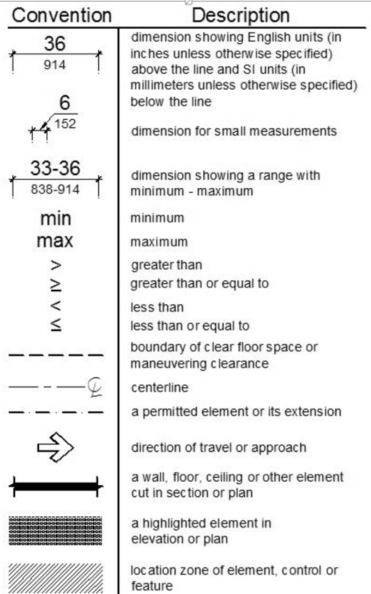
FIGURE 11B-104 GRAPHIC CONVENTION FOR FIGURES
11B-106.1 General.
For the purpose of this chapter, the terms listed in Section 11B-106.5 and defined in Chapter 2 have the indicated meaning.
11B-106.2 Terms defined in referenced standards.
Terms not listed in Section 11B-106.5 and not defined in Chapter 2, Section 202, but specifically defined in a referenced standard, shall have the specified meaning from the referenced standard unless otherwise stated.
11B-106.3 Undefined terms.
The meaning of terms not specifically listed in Section 11B-106.5, and not defined in Chapter 2, Section 202, or in referenced standards shall be as defined by collegiate dictionaries in the sense that the context implies.
11B-106.5 Defined terms.
The following terms are defined in Chapter 2, Section 202.

ASSISTIVE LISTENING SYSTEM (ALS)
AUTOMATIC TELLER MACHINE (ATM)
DRIVE-UP ELECTRIC VEHICLE CHARGING STATION
ELECTRIC VEHICLE CHARGING SPACE (EV SPACE)
ELECTRIC VEHICLE CHARGING STATION (EVCS)
ELECTRIC VEHICLE (EV) CONNECTOR
GRADE (ADJACENT GROUND ELEVATION)
HOUSING AT A PLACE OF EDUCATION
INTERNATIONAL SYMBOL OF ACCESSIBILITY
PROFESSIONAL OFFICE OF A HEALTH CARE PROVIDER
QUALIFIED HISTORIC BUILDING OR FACILITY
SHOPPING CENTER (OR SHOPPING MALL)
11B-107 Special conditions appeals action.
See Chapter 1, Section 1.9.1.5.
ETA Editor's Note
A successful appeal does not warrant ADA compliance. Appeals Boards, Local Building Officials or other Authorities Having Jurisdiction have no authority to certify ADA compliance, and consistently state that they do not review for it. Due diligence is advised whenever an appeal is made in lieu of strict compliance with stated scoping and/or technical requirements.
11B-108 Maintenance of accessible features.
A public accommodation shall maintain in operable working condition those features of facilities and equipment that are required to be accessible to and useable by persons with disabilities. Isolated or temporary interruptions in service or accessibility due to maintenance or repairs shall be permitted.

11B-201.1 Scope.
All areas of newly designed and newly constructed buildings and facilities and altered portions of existing buildings and facilities shall comply with these requirements.

[ADA Title II] §35.151(d) New Construction and Alterations; Scope of Coverage.
(d) Scope of coverage. The 1991 Standards and the 2010 Standards apply to fixed or built-in elements of buildings, structures, site improvements, and pedestrian routes or vehicular ways located on a site. Unless specifically stated otherwise, the advisory notes, appendix notes, and figures contained in the 1991 Standards and the Standards explain or illustrate the requirements of the rule; they do not establish enforceable requirements.
[ADA Title III] §36.406(b) Standards for New Construction and Alterations; Scope of Coverage.
(b) Scope of coverage. The 1991 Standards and the 2010 Standards apply to fixed or built-in elements of buildings, structures, site improvements, and pedestrian routes or vehicular ways located on a site. Unless specifically stated otherwise, the advisory notes, appendix notes, and figures contained in the 1991 Standards and 2010 Standards explain or illustrate the requirements of the rule; they do not establish enforceable requirements.
11B-201.2 Application based on building or facility use.
Where a site, building, facility, room, or space contains more than one use, each portion shall comply with the applicable requirements for that use.
11B-201.3 Temporary and permanent structures.
These requirements shall apply to temporary and permanent buildings and facilities.
11B-201.4 Construction Support Facilities.
These requirements shall apply to temporary or permanent construction support facilities for uses and activities not directly associated with the actual processes of construction, including but not limited to offices, meeting rooms, plan rooms, other administrative or support functions. When provided, toilet and bathing facilities serving construction support facilities shall comply with 11B-213. When toilet and bathing facilities serving construction support facilities are provided by portable units, at least one of each type shall be accessible and connected to the construction support facilities it serves by an accessible route.
EXCEPTION: During construction an accessible route shall not be required between site arrival points or the boundary of the area of construction and the entrance to the construction support facilities if the only means of access between them is a vehicular way not providing pedestrian access.

11B-202.1 General.
Additions and alterations to existing buildings or facilities shall comply with Section 11B-202.
11B-202.2 Additions.
Each addition to an existing building or facility shall comply with the requirements for new construction and shall comply with 11B-202.4.

[2010 ADA Standards] 202.2 Additions. Each addition to an existing building or facility shall comply with the requirements for new construction. Each addition that affects or could affect the usability of or access to an area containing a primary function shall comply with 202.4.
11B-202.3 Alterations.
Where existing elements or spaces are altered, each altered element or space shall comply with the applicable requirements of Division 2, including Section 11B-202.4.
[2010 ADA Standards] 202.3 Alterations. Where existing elements or spaces are altered, each altered element or space shall comply with the applicable requirements of Chapter 2.

In existing buildings or facilities, if seismic strengthening or upgrade work does not alter the primary use or function of the building or facility and/or does not alter the design of specific rooms or spaces, then the requirement for an accessible path of travel to the area of specific alteration does not apply. However, an accessible primary entrance, toilet and bathing facilities, drinking fountains, signs and public telephones, as well as an accessible route connecting these elements must be provided.
In existing buildings or facilities, when the primary use or function of the building or facility and/or design of specific rooms or spaces are altered, the seismic strengthening or upgrade work must comply with all applicable accessibility regulations for new construction. In addition, an accessible primary entrance to the building or facility and path of travel to the specific area of alteration, including toilet and bathing facilities, drinking fountains, signs, and public telephones serving the area must be provided. ◼

US Department of Justice technical assistance letter #772, dated August 26, 1998, indicates reconstruction after a fire is considered an alteration. Chapter 2, Section 202 defines alteration as “…a change, addition or modification in construction, change in occupancy or use, or structural repair to an existing building or facility. …” Reroofing, painting or wallpapering, or changes to mechanical and electrical systems are generally not considered to be alterations.
When the damage caused by a fire is minor and can be corrected by cleaning, re-painting or re-wallpapering, accessibility provisions based on alterations are not triggered. The accessibility requirements of Section 11B-202.3 would apply where alterations are made in the fire damaged area, for example, if wall or roof structures are being reconstructed or repaired. These requirements include: (1) reconstruction work in the specific area of fire damage that complies with all applicable accessibility provisions for new construction and (2) the obligation to provide an accessible primary entrance to the building or facility and primary path of travel to the specific area of alteration, including toilet and bathing facilities, drinking fountains, signs, and public telephones that serve the area. ◼

Exceptions:
1. Reserved.
[2010 ADA Standards] 1. Unless required by 202.4, where elements or spaces are altered and the circulation path to the altered element or space is not altered, an accessible route shall not be required.
2. Technically infeasible. In alterations, where the enforcing authority determines compliance with applicable requirements is technically infeasible, the alteration shall provide equivalent facilitation or comply with the requirements to the maximum extent feasible. The details of the finding that full compliance with the requirements is technically infeasible shall be recorded and entered into the files of the enforcing agency.
[2010 ADA Standards] 2. In alterations, where compliance with applicable requirements is technically infeasible, the alteration shall comply with the requirements to the maximum extent feasible.
ETA Editor's Note
A key difference between CBC and ADA is that matters of judgment, such as technical infeasibility, equivalent facilitation, and compliance to the maximum extent feasible are subject to the opinions of the Authority Having Jurisdiction with regard to CBC, while there is no such governing authority for ADA. Instead, these matters are subject to being tested through the legal system. Risk is minimized when there is clear evidence that proactive measures have been taken to enable individuals with varying types of disabilities to acquire goods and services independently, or to receive the same benefits of participation or employment as anyone else.
3. Residential dwelling units not required to be accessible in compliance with this code shall not be required to comply with 11B-202.3.
[2010 ADA Standards] 3. Residential dwelling units not required to be accessible in compliance with a standard issued pursuant to the Americans with Disabilities Act or Section 504 of the Rehabilitation Act of 1973, as amended, shall not be required to comply with 202.3.
[ADA Title II] §35.151(b) New Construction and Alterations; Alterations.
1. Each facility or part of a facility altered by, on behalf of, or for the use of a public entity in a manner that affects or could affect the usability of the facility or part of the facility shall, to the maximum extent feasible, be altered in such manner that the altered portion of the facility is readily accessible to and usable by individuals with disabilities, if the alteration was commenced after January 26, 1992.
[ADA Title III] §36.402(a) Alterations; General.
1. Any alteration to a place of public accommodation or a commercial facility, after January 26, 1992, shall be made so as to ensure that, to the maximum extent feasible, the altered portions of the facility are readily accessible to and usable by individuals with disabilities, including individuals who use wheelchairs.
2. An alteration is deemed to be undertaken after January 26, 1992, if the physical alteration of the property begins after that date.
11B-202.3.1 Prohibited reduction in access.
An alteration that decreases or has the effect of decreasing the accessibility of a building or facility below the requirements for new construction at the time of the alteration is prohibited.
[ADA Title II] §35.133 Maintenance of accessible features.
c. If the 2010 Standards reduce the technical requirements or the number of required accessible elements below the number required by the 1991 Standards, the technical requirements or the number of accessible elements in a facility subject to this part may be reduced in accordance with the requirements of the 2010 Standards.
[ADA Title III] §36.211 Maintenance of accessible features.
c. If the 2010 Standards reduce the technical requirements or the number of required accessible elements below the number required by the 1991 Standards, the technical requirements or the number of accessible elements in a facility subject to this part may be reduced in accordance with the requirements of the 2010 Standards.
11B-202.3.2 Extent of application.
An alteration of an existing element, space, or area of a building or facility shall not impose a requirement for accessibility greater than required for new construction.
11B-202.3.3 Alteration of single elements.
If alterations of single elements, when considered together, amount to an alteration of a room or space in a building or facility, the entire room or space shall be made accessible.
11B-202.4 Path of travel requirements in alterations, additions and structural repairs.
When alterations or additions are made to existing buildings or facilities, an accessible path of travel to the specific area of alteration or addition shall be provided. The primary accessible path of travel shall include:
-
A primary entrance to the building or facility,
-
Toilet and bathing facilities serving the area,
-
Drinking fountains serving the area,
-
Public telephones serving the area, and
-
Signs.
Exceptions:
1. Residential dwelling units shall comply with Section 11B-233.3.4.2.
2. If the following elements of a path of travel have been constructed or altered in compliance with the accessibility requirements of the immediately preceding edition of the California Building Code, it shall not be required to retrofit such elements to reflect the incremental changes in this code solely because of an alteration to an area served by those elements of the path of travel:
- A primary entrance to the building or facility,
- Toilet and bathing facilities serving the area,
- Drinking fountains serving the area,
- Public telephones serving the area, and
- Signs.
Note: The language in this exception, which refers to the “immediately preceding edition of the California Building Code,” shall permit a reference back to one CBC edition only and is not accumulative to prior editions.
The language in this exception which refers to the “immediately preceding edition of the California Building Code,” permits a reference back to one CBC edition only and is not accumulative to prior editions. It is not appropriate to misconstrue the language of the immediately preceding edition to allow additional reference back to earlier editions. ◼
ETA Editor's Note
CBC Chapter 11B does not apply the same qualification as ADA for imposing the responsibility to make the path of travel to an addition or alteration accessible, implying that existing barriers to accessibility must be mitigated, subject to codified hardship and/or safe harbor limitations. ADA imposes the responsibility when an alteration or addition to a public accommodation or commercial facility includes or affects an area containing a primary function. Lacking this qualification, the CBC Chapter 11B scoping is more inclusive. However, the CBC scoping is interpreted and enforced by Local Building Officials and other Authorities Having Jurisdiction, whereas the ADA scoping is not. Therefore, in cases where the CBC scoping for mitigation of existing path of travel barriers as part of a building alteration or addition is not enforced, or is enforced to a lesser degree than the ADA obligation would require, the ADA obligation remains in effect, if the alteration or addition meets the ADA primary function qualification.
It is also important to note that ADA Title III imposes a perpetual obligation for public accommodations to mitigate existing barriers to the extent readily achievable, not merely limited to those on an accessible path of travel, and not tied to other alterations or additions.
In order to mitigate existing barriers, it is first necessary to identify them. The subject of who is responsible for doing this is not addressed directly by CBC or ADA, and it is perhaps the most common failing for public accommodations. Design professionals frequently note "Existing Accessible Parking," "Existing Accessible Toilets," and similar, which Authorities Having Jurisdiction take to imply that they are compliant. The failure to mitigate existing barriers that are overlooked by this practice can be, and frequently is, an ADA violation. It is also inconsistent with the intent of CBC Chapter 11B.
The ADA path of travel requirements are included in this Guide following those of CBC Section 11B-202.4.
3. Additions or alterations to meet accessibility requirements consisting of one or more of the following items shall be limited to the actual scope of work of the project and shall not be required to comply with Section 11B-202.4:
- Altering one building entrance.
- Altering one existing toilet facility.
- Altering existing elevators.
- Altering existing steps.
- Altering existing handrails.
4. Alterations solely for the purpose of barrier removal undertaken pursuant to the requirements of the Americans with Disabilities Act (Public Law 101-336, 28 C.F.R., Section 36.304) or the accessibility requirements of this code as those requirements or regulations now exist or are hereafter amended including, but not limited to, one or more of the following items shall be limited to the actual scope of work of the project and shall not be required to comply with Section 11B-202.4:
- Installing ramps.
- Making curb cuts in sidewalks and entrance.
- Repositioning shelves.
- Rearranging tables, chairs, vending machines, display racks, and other furniture.
- Repositioning telephones.
- Adding raised markings on elevator control buttons.
- Installing flashing alarm lights.
- Widening doors.
- Installing offset hinges to widen doorways.
- Eliminating a turnstile or providing an alternative accessible route.
- Installing accessible door hardware.
- Installing grab bars in toilet stalls.
- Rearranging toilet partitions to increase maneuvering space.
- Insulating lavatory pipes under sinks to prevent burns.
- Installing a raised toilet seat.
- Installing a full-length bathroom mirror.
- Repositioning the paper towel dispenser in a bathroom.
- Creating designated accessible parking spaces.
- Removing high-pile, low-density carpeting.
5. Alterations of existing parking lots by resurfacing and/or restriping shall be limited to the actual scope of work of the project and shall not be required to comply with Section 11B-202.4.
6. The addition or replacement of signs and/or identification devices shall be limited to the actual scope of work of the project and shall not be required to comply with Section 11B-202.4.
7. Projects consisting only of heating, ventilation, air conditioning, reroofing, electrical work not involving placement of switches and receptacles, cosmetic work that does not affect items regulated by this code, such as painting, equipment not considered to be a part of the architecture of the building or area, such as computer terminals and office equipment shall not be required to comply with Section 11B-202.4 unless they affect the usability of the building or facility.
8. When the adjusted construction cost, as defined, is less than or equal to the current valuation threshold, as defined, the cost of compliance with Section 11B-202.4 shall be limited to 20 percent of the adjusted construction cost of alterations, structural repairs or additions. When the cost of full compliance with Section 11B-202.4 would exceed 20 percent, compliance shall be provided to the greatest extent possible without exceeding 20 percent.
When the adjusted construction cost, as defined, exceeds the current valuation threshold, as defined, and the enforcing agency determines the cost of compliance with Section 11B-202.4 is an unreasonable hardship, as defined, full compliance with Section 11B-202.4 shall not be required. Compliance shall be provided by equivalent facilitation or to the greatest extent possible without creating an unreasonable hardship; but in no case shall the cost of compliance be less than 20 percent of the adjusted construction cost of alterations, structural repairs or additions. The details of the finding of unreasonable hardship shall be recorded and entered into the files of the enforcing agency and shall be subject to Chapter 1, Section 1.9.1.5, Special Conditions for Persons with Disabilities Requiring Appeals Action Ratification.
For the purposes of this exception, the adjusted construction cost of alterations, structural repairs or additions shall not include the cost of alterations to path of travel elements required to comply with Section 11B-202.4.
In choosing which accessible elements to provide, priority should be given to those elements that will provide the greatest access in the following order:
- An accessible entrance;
- An accessible route to the altered area;
- At least one accessible restroom for each sex or one accessible unisex (single-user or family) restroom;
- Accessible telephones;
- Accessible drinking fountains; and
- When possible, additional accessible elements such as parking, signs, storage and alarms.
If an area has been altered without providing an accessible path of travel to that area, and subsequent alterations of that area or a different area on the same path of travel are undertaken within three years of the original alteration, the total cost of alterations to the areas on that path of travel during the preceding three-year period shall be considered in determining whether the cost of making that path of travel accessible is disproportionate.
9. Certain types of privately funded, multistory buildings and facilities were formerly exempt from accessibility requirements above and below the first floor under this code, but as of, April 1, 1994, are no longer exempt due to more restrictive provisions in the federal Americans with Disabilities Act. In alteration projects involving buildings and facilities previously approved and built without elevators, areas above and below the ground floor are subject to the 20-percent disproportionality provisions described in Exception 8, above, even if the value of the project exceeds the valuation threshold in Exception 8. The types of buildings and facilities are:
- Office buildings and passenger vehicle service stations of three stories or more and 3,000 or more square feet (279 m2) per floor.
- Offices of physicians and surgeons.
- Shopping centers.
- Other buildings and facilities three stories or more and 3,000 or more square feet (279 m2) per floor if a reasonable portion of services sought and used by the public is available on the accessible level.
For the general privately funded multistory building exception applicable to new construction and alterations, see Section 11B-206.2.3, Exception 1.
The elevator exception set forth in this section does not obviate or limit in any way the obligation to comply with the other accessibility requirements in this code. For example, floors above or below the accessible ground floor must meet the requirements of this section except for elevator service. If toilet or bathing facilities are provided on a level not served by an elevator, then toilet or bathing facilities must be provided on the accessible ground floor.
10. Alterations solely for the purpose of installing electric vehicle charging stations (EVCS) at facilities where vehicle fueling, recharging, parking or storage is a primary function shall comply with Section 11B-202.4 to the maximum extent feasible without exceeding 20 percent of the cost of the work directly associated with the installation of EVCS. A “primary function” is a major activity for which the facility is intended.
Alterations solely for the purpose of installing EVCS at facilities where vehicle fueling, recharging, parking or storage is not a primary function shall not be required to comply with Section 11B-202.4.

[2010 ADA Standards] 202.4 Alterations Affecting Primary Function Areas. In addition to the requirements of 202.3, an alteration that affects or could affect the usability of or access to an area containing a primary function shall be made so as to ensure that, to the maximum extent feasible, the path of travel to the altered area, including the rest rooms, telephones, and drinking fountains serving the altered area, are readily accessible to and usable by individuals with disabilities, unless such alterations are disproportionate to the overall alterations in terms of cost and scope as determined under criteria established by the Attorney General. In existing transportation facilities, an area of primary function shall be as defined under regulations published by the Secretary of the Department of Transportation or the Attorney General.
EXCEPTION: Residential dwelling units shall not be required to comply with 202.4.
[2010 ADA Standards] Advisory 202.4 Alterations Affecting Primary Function Areas. An area of a building or facility containing a major activity for which the building or facility is intended is a primary function area. Department of Justice ADA regulations state, "Alterations made to provide an accessible path of travel to the altered area will be deemed disproportionate to the overall alteration when the cost exceeds 20% of the cost of the alteration to the primary function area." (28 CFR 36.403 (f)(1)). See also Department of Transportation ADA regulations, which use similar concepts in the context of public sector transportation facilities (49 CFR 37.43 (e)(1)).
There can be multiple areas containing a primary function in a single building. Primary function areas are not limited to public use areas. For example, both a bank lobby and the bank's employee areas such as the teller areas and walk-in safe are primary function areas. Also, mixed use facilities may include numerous primary function areas for each use. Areas containing a primary function do not include: mechanical rooms, boiler rooms, supply storage rooms, employee lounges or locker rooms, janitorial closets, entrances, corridors, or restrooms.
ETA Editor's Note
Per ADA Title II, §35.151(b)(4)(i)(B), and ADA Title III, §36.403(c)(2), alterations to windows, hardware, controls, electrical outlets and signage shall not be deemed to be alterations that affect the usability of or access to an area containing a primary function.
[ADA Title II] §35.151(b)(4) New Construction and Alterations; Alterations; Path of Travel.
(ii)(C) Safe harbor. If a public entity has constructed or altered required elements of a path of travel in accordance with the specifications in either the 1991 Standards or the Uniform Federal Accessibility Standards before March 15, 2012, the public entity is not required to retrofit such elements to reflect incremental changes in the 2010 Standards solely because of an alteration to a primary function area served by that path of travel.
[ADA Title III] §36.403 Alterations: Path of travel.
(a) General.
(2) If a private entity has constructed or altered required elements of a path of travel at a place of public accommodation or commercial facility in accordance with the specifications in the 1991 Standards, the private entity is not required to retrofit such elements to reflect the incremental changes in the 2010 Standards solely because of an alteration to a primary function area served by that path of travel. …
(c) Alterations to an area containing a primary function.
(1) Alterations that affect the usability of or access to an area containing a primary function include but are not limited to:
(i) Remodeling merchandise display areas or employee work areas in a department store;
(ii) Replacing an inaccessible floor surface in the customer service or employee work areas of a bank;
(iii) Redesigning the assembly line area of a factory; or
(iv) Installing a computer center in an accounting firm.
(d) Landlord/tenant: If a tenant is making alterations as defined in §36.402 that would trigger the requirements of this section, those alterations by the tenant in areas that only the tenant occupies do not trigger a path of travel obligation upon the landlord with respect to areas of the facility under the landlord´s authority, if those areas are not otherwise being altered.
[ADA Title II] §35.151(b) New Construction and Alterations; Alterations.
(2) The path of travel requirements of §35.151(b)(4) shall apply only to alterations undertaken solely for purposes other than to meet the program accessibility requirements of §35.150.
[ADA Title III] §36.304(d) Removal of Barriers; Relationship to alterations requirements of subpart D of this part.
(1) . . . The path of travel requirements of §36.403 shall not apply to measures taken solely to comply with the barrier removal requirements of this section.
[ADA Title II] §35.151(b)(4)(iii) New Construction and Alterations; Alterations; ... Disproportionality.
(A) Alterations made to provide an accessible path of travel to the altered area will be deemed disproportionate to the overall alteration when the cost exceeds 20% of the cost of the alteration to the primary function area.
(B) Costs that may be counted as expenditures required to provide an accessible path of travel may include:
1) Costs associated with providing an accessible entrance and an accessible route to the altered area, for example, the cost of widening doorways or installing ramps;
2) Costs associated with making restrooms accessible, such as installing grab bars, enlarging toilet stalls, insulating pipes, or installing accessible faucet controls;
3) Costs associated with providing accessible telephones, such as relocating the telephone to an accessible height, installing amplification devices, or installing a text telephone (TTY); and
4) Costs associated with relocating an inaccessible drinking fountain.
[ADA Title III] §36.403(f) Alterations: Path of Travel; Disproportionality.
(1) Alterations made to provide an accessible path of travel to the altered area will be deemed disproportionate to the overall alteration when the cost exceeds 20% of the cost of the alteration to the primary function area.
(2) Costs that may be counted as expenditures required to provide an accessible path of travel may include:
(i) Costs associated with providing an accessible entrance and an accessible route to the altered area, for example, the cost of widening doorways or installing ramps;
(ii) Costs associated with making restrooms accessible, such as installing grab bars, enlarging toilet stalls, insulating pipes, or installing accessible faucet controls;
(iii) Costs associated with providing accessible telephones, such as relocating the telephone to an accessible height, installing amplification devices, or installing a text telephone (TTY);
(iv) Costs associated with relocating an inaccessible drinking fountain.
[ADA Title II] §35.151(b)(4)(iv) New Construction and Alterations; Alterations; ... Duty to provide accessible features in the event of disproportionality.
(A) When the cost of alterations necessary to make the path of travel to the altered area fully accessible is disproportionate to the cost of the overall alteration, the path of travel shall be made accessible to the extent that it can be made accessible without incurring disproportionate costs.
(B) In choosing which accessible elements to provide, priority should be given to those elements that will provide the greatest access, in the following order—
1) An accessible entrance;
2) An accessible route to the altered area;
3) At least one accessible restroom for each sex or a single unisex restroom;
4) Accessible telephones;
5) Accessible drinking fountains; and
6) When possible, additional accessible elements such as parking, storage, and alarms.
[ADA Title III] §36.403(g) Alterations: Path of Travel; Duty to provide accessible features in the event of disproportionality
(1) When the cost of alterations necessary to make the path of travel to the altered area fully accessible is disproportionate to the cost of the overall alteration, the path of travel shall be made accessible to the extent that it can be made accessible without incurring disproportionate costs.
(2) In choosing which accessible elements to provide, priority should be given to those elements that will provide the greatest access, in the following order:
(i) An accessible entrance;
(ii) An accessible route to the altered area;
(iii) At least one accessible restroom for each sex or a single unisex restroom;
(iv) Accessible telephones;
(v) Accessible drinking fountains; and
(vi) When possible, additional accessible elements such as parking, storage, and alarms.
[ADA Title II] §35.151(b)(4)(v) New Construction and Alterations; Alterations; ... Series of smaller alterations.
(A) The obligation to provide an accessible path of travel may not be evaded by performing a series of small alterations to the area served by a single path of travel if those alterations could have been performed as a single undertaking.
(B)
(1) If an area containing a primary function has been altered without providing an accessible path of travel to that area, and subsequent alterations of that area, or a different area on the same path of travel, are undertaken within three years of the original alteration, the total cost of alterations to the primary function areas on that path of travel during the preceding three year period shall be considered in determining whether the cost of making that path of travel accessible is disproportionate.
(2) Only alterations undertaken on or after March 15, 2011 shall be considered in determining if the cost of providing an accessible path of travel is disproportionate to the overall cost of the alterations.
[ADA Title III] §36.403(h) Alterations: Path of Travel; Series of smaller alterations.
(1) The obligation to provide an accessible path of travel may not be evaded by performing a series of small alterations to the area served by a single path of travel if those alterations could have been performed as a single undertaking.
(2)
(i) If an area containing a primary function has been altered without providing an accessible path of travel to that area, and subsequent alterations of that area, or a different area on the same path of travel, are undertaken within three years of the original alteration, the total cost of alterations to the primary function areas on that path of travel during the preceding three year period shall be considered in determining whether the cost of making that path of travel accessible is disproportionate.
(ii) Only alterations undertaken after January 26, 1992, shall be considered in determining if the cost of providing an accessible path of travel is disproportionate to the overall cost of the alterations.
11B-202.5 Alterations to qualified historic buildings and facilities.
Alterations to a qualified historic building or facility shall comply with the State Historical Building Code, Part 8, Title 24, of the California Code of Regulations.
Exception: Reserved.
The State Historical Building Code provides a definition of qualified historic building or property, and can be used to determine if a building or facility is qualified. The State Historical Building Code is used in conjunction with the accessibility requirements of Chapter 11B. In general, alteration projects in qualified historic buildings and facilities must comply with the new construction requirements of Chapter 11B, however, the State Historical Building Code provides alternative accessibility provisions when an entity believes that compliance with the Chapter 11B requirements for specific elements would threaten or destroy the historical significance of the building or facility. Alternative provisions are provided for entrances, doors, power-assisted doors, toilet rooms, and exterior and interior ramps and lifts. Equivalent facilitation is permitted in specific cases when the alternative provisions themselves would threaten or destroy the historical significance or character defining features of the historic building or facility. Alternative provisions and equivalent facilitation are applied on a case-by-case basis only. ◼
[2010 ADA Standards] 202.5 Alterations to Qualified Historic Buildings and Facilities. Alterations to a qualified historic building or facility shall comply with 202.3 and 202.4.
EXCEPTION: Where the State Historic Preservation Officer or Advisory Council on Historic Preservation determines that compliance with the requirements for accessible routes, entrances, or toilet facilities would threaten or destroy the historic significance of the building or facility, the exceptions for alterations to qualified historic buildings or facilities for that elements shall be permitted to apply.
[ADA Title II] §35.151(b) New Construction and Alterations; Alterations.
(3)(i) Alterations to historic properties shall comply, to the maximum extent feasible, with the provisions applicable to historic properties in the design standards specified in §35.151(c).
(ii) If it is not feasible to provide physical access to an historic property in a manner that will not threaten or destroy the historic significance of the building or facility, alternative methods of access shall be provided pursuant to the requirements of §35.150.
[ADA Title III] §36.405 Alterations: Historic Preservation.
(a) Alterations to buildings or facilities that are eligible for listing in the National Register of Historic Places under the National Historic Preservation Act (16 U.S.C. 470 et seq), or are designated as historic under State or local law, shall comply to the maximum extent feasible with this part.
(b) If it is determined that it is not feasible to provide physical access to an historic property that is a place of public accommodation in a manner that will not threaten or destroy the historic significance of the building or the facility, alternative methods of access shall be provided pursuant to the requirements of subpart C of this part.
[2010 ADA Standards] Advisory 202.5 Alterations to Qualified Historic Buildings and Facilities Exception. State Historic Preservation Officers are State appointed officials who carry out certain responsibilities under the National Historic Preservation Act. State Historic Preservation Officers consult with Federal and State agencies, local governments, and private entities on providing access and protecting significant elements of qualified historic buildings and facilities. There are exceptions for alterations to qualified historic buildings and facilities for accessible routes (206.2.1 Exception 1 and 206.2.3 Exception 7); entrances (206.4 Exception 2); and toilet facilities (213.2 Exception 2). When an entity believes that compliance with the requirements for any of these elements would threaten or destroy the historic significance of the building or facility, the entity should consult with the State Historic Preservation Officer. If the State Historic Preservation Officer agrees that compliance with the requirements for a specific element would threaten or destroy the historic significance of the building or facility, use of the exception is permitted. Public entities have an additional obligation to achieve program accessibility under the Department of Justice ADA regulations. See 28 CFR 35.150. These regulations require public entities that operate historic preservation programs to give priority to methods that provide physical access to individuals with disabilities. If alterations to a qualified historic building or facility to achieve program accessibility would threaten or destroy the historic significance of the building or facility, fundamentally alter the program, or result in undue financial or administrative burdens, the Department of Justice ADA regulations allow alternative methods to be used to achieve program accessibility. In the case of historic preservation programs, such as an historic house museum, alternative methods include using audio-visual materials to depict portions of the house that cannot otherwise be made accessible. In the case of other qualified historic properties, such as an historic government office building, alternative methods include relocating programs and services to accessible locations. The Department of Justice ADA regulations also allow public entities to use alternative methods when altering qualified historic buildings or facilities in the rare situations where the State Historic Preservation Officer determines that it is not feasible to provide physical access using the exceptions permitted in Section 202.5 without threatening or destroying the historic significance of the building or facility. See 28 CFR 35.151(d).
The AccessAbility Office at the National Endowment for the Arts (NEA) provides a variety of resources for museum operators and historic properties including: the Design for Accessibility Guide and the Disability Symbols. Contact NEA about these and other resources at (202) 682-5532 or http://www.arts.gov/.
11B-203.1 General.
Sites, buildings, facilities, and elements are exempt from these requirements to the extent specified by 11B-203.
11B-203.2 Construction sites.
Structures and sites directly associated with the actual processes of construction, including but not limited to, scaffolding, bridging, materials hoists, materials storage, and construction trailers shall not be required to comply with these requirements or to be on an accessible route. Portable toilet units provided for use exclusively by construction personnel on a construction site shall not be required to comply with Section 11B-213 or to be on an accessible route.

11B-203.3 Raised areas.
Areas raised primarily for purposes of security, life safety, or fire safety, including but not limited to, observation or lookout galleries, prison guard towers, fire towers, or life guard stands shall not be required to comply with these requirements or to be on an accessible route.
11B-203.4 Limited access spaces.
Spaces not customarily occupied and accessed only by ladders, catwalks, crawl spaces, or very narrow passageways shall not be required to comply with these requirements or to be on an accessible route.
11B-203.5 Machinery spaces.
Spaces frequented only by service personnel for maintenance, repair, or occasional monitoring of equipment shall not be required to comply with these requirements or to be on an accessible route. Machinery spaces include, but are not limited to, elevator pits or elevator penthouses; mechanical, electrical or communications equipment rooms; piping or equipment catwalks; water or sewage treatment pump rooms and stations; electric substations and transformer vaults; and highway and tunnel utility facilities.
11B-203.6 Single occupant structures.
Single occupant structures accessed only by passageways below grade or elevated above standard curb height, including but not limited to, toll booths that are accessed only by underground tunnels, shall not be required to comply with these requirements or to be on an accessible route.
11B-203.7 Detention and correctional facilities.
In detention and correctional facilities, common use areas that are used only by inmates or detainees and security personnel and that do not serve holding cells or housing cells required to comply with Section 11B-232, shall not be required to comply with these requirements or to be on an accessible route.
11B-203.8 Residential facilities.
In residential facilities, common use areas that do not serve residential dwelling units required to provide mobility features complying with Sections 11B-809.2 through 11B-809.4 or adaptable features complying with Sections 11B-809.6 through 11B-809.12 shall not be required to comply with these requirements or to be on an accessible route.
[2010 ADA Standards] 203.8 Residential Facilities. In residential facilities, common use areas that do not serve residential dwelling units required to provide mobility features complying with 809.2 through 809.4 shall not be required to comply with these requirements or to be on an accessible route.
11B-203.9 Employee workstations.
Employee workstations shall be on an accessible route complying with Division 4. Spaces and elements within employee workstations shall only be required to comply with Sections 11B-207.1, 11B-215.3, 11B-302, 11B-303, 11B-308.1.1, 11B-308.1.2, and 11B-404.2.3, unless exempted by other parts of this code. Common use circulation paths within employee workstations shall comply with Section 11B-206.2.8. [Safe Harbor 11B-203.9]
Exception: Receptacles, controls, and switches that are an integral part of workstation furnishings, fixtures, and equipment shall not be required to comply with Sections 11B-308.1.1 and 11B-308.1.2.
[2010 ADA Standards] 203.9 Employee Work Areas. Spaces and elements within employee work areas shall only be required to comply with 206.2.8, 207.1, and 215.3 and shall be designed and constructed so that individuals with disabilities can approach, enter, and exit the employee work area. Employee work areas, or portions of employee work areas, other than raised courtroom stations, that are less than 300 square feet (28 m2) and elevated 7 inches (180 mm) or more above the finish floor or ground where the elevation is essential to the function of the space shall not be required to comply with these requirements or to be on an accessible route.
ETA Editor's Note
2016 CBC did not include the requirement to comply with Sections 11B-308.1.1 and 11B-308.1.2.
The ADA requirements included at Section 11B-203.9 are provided for information only. The CBC scoping requirements do not exempt raised employee work areas, except as specifically mentioned in Section 11B-203, General Exceptions, or elsewhere.
11B-203.10 Raised refereeing, judging, and scoring areas.
Raised structures used solely for refereeing, judging, or scoring a sport shall not be required to comply with these requirements or to be on an accessible route. An accessible route complying with Division 4 shall be provided to the ground- or floor-level entry points, where provided, of stairs, ladders, or other means of reaching the raised elements or areas.
11B-203.11 Water slides.
Water slides shall not be required to comply with these requirements or to be on an accessible route. An accessible route complying with Division 4 shall be provided to the ground- or floor-level entry points, where provided, of stairs, ladders, or other means of reaching the raised elements or areas.
11B-203.12 Animal containment areas.
Animal containment areas that are not for public use shall not be required to comply with these requirements or to be on an accessible route. Animal containment areas for public use shall be on an accessible route.
11B-203.13 Raised boxing or wrestling rings.
Raised boxing or wrestling rings shall not be required to comply with these requirements or to be on an accessible route. An accessible route complying with Division 4 shall be provided to the ground- or floor-level entry points, where provided, of stairs, ladders, or other means of reaching the raised elements or areas.
11B-203.14 Raised diving boards and diving platforms.
Raised diving boards and diving platforms shall not be required to comply with these requirements or to be on an accessible route. An accessible route complying with Division 4 shall be provided to the ground- or floor-level entry points, where provided, of stairs, ladders, or other means of reaching the raised elements or areas.
11B-204.1 General.
Protruding objects on circulation paths shall comply with Section 11B-307.
Exceptions:
- Within areas of sport activity, protruding objects on circulation paths shall not be required to comply with Section 11B-307.
- Within play areas, protruding objects on circulation paths shall not be required to comply with Section 11B-307 provided that ground level accessible routes provide vertical clearance in compliance with Section 11B-1008.2.
11B-205.1 General.
Operable parts on accessible elements, accessible routes, and in accessible rooms and spaces shall comply with Section 11B-309.
Exceptions:
1. Operable parts that are intended for use only by service or maintenance personnel shall not be required to comply with Section 11B-309.
2. Electrical or communication receptacles serving a dedicated use shall not be required to comply with Section 11B-309.
3. Reserved.
[2010 ADA Standards] 3. Where two or more outlets are provided in a kitchen above a length of counter top that is uninterrupted by a sink or appliance, one outlet shall not be required to comply with 309.
ETA Editor's Note
The ADA requirement included at Section 11B-205.1 Exception 3 is provided for information only. The CBC scoping requirement is more inclusive.
4. Floor electrical receptacles shall not be required to comply with Section 11B-309.
5. HVAC diffusers shall not be required to comply with Section 11B-309.
6. Except for light switches, where redundant controls are provided for a single element, one control in each space shall not be required to comply with Section 11B-309.
7. Cleats and other boat securement devices shall not be required to comply with Section 11B-309.3.
8. Exercise machines and exercise equipment shall not be required to comply with Section 11B-309.
9. In residential dwelling units with mobility features where receptacles are provided in a kitchen at a corner work surface, one receptacle shall be located 36 inches (915 mm) from either wall at the inside corner.
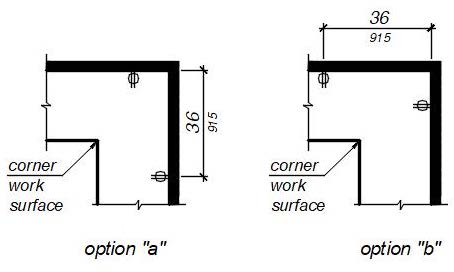
FIGURE 11B-205.1 Ex. 9
ELECTRICAL RECEPTACLES AT CORNER WORKSURFACES.

11B-206.1 General.
Accessible routes shall be provided in accordance with Section 11B-206 and shall comply with Division 4.
11B-206.2 Where required.
Accessible routes shall be provided where required by Section 11B-206.2.
11B-206.2.1 Site arrival points.
At least one accessible route shall be provided within the site from accessible parking spaces and accessible drop-off and passenger loading zones; public streets and sidewalks; and public transportation stops to the accessible building or facility entrance they serve. Where more than one route is provided, all routes must be accessible.
[2010 ADA Standards] 206.2.1 Site Arrival Points. At least one accessible route shall be provided within the site from accessible parking spaces and accessible passenger loading zones; public streets and sidewalks; and public transportation stops to the accessible building or facility entrance they serve.
Exceptions:
1. Reserved.
[2010 ADA Standards] 1. Where exceptions for alterations to qualified historic buildings or facilities are permitted by 202.5, no more than one accessible route from a site arrival point to an accessible entrance shall be required.
2. An accessible route shall not be required between site arrival points and the building or facility entrance if the only means of access between them is a vehicular way not providing pedestrian access.
3. General circulation paths shall be permitted when located in close proximity to an accessible route.


[ADA Title II] §35.151(i) New Construction and Alterations; Curb Ramps.
(1) Newly constructed or altered streets, roads, and highways must contain curb ramps or other sloped areas at any intersection having curbs or other barriers to entry from a street level pedestrian walkway.
(2) Newly constructed or altered street level pedestrian walkways must contain curb ramps or other sloped areas at intersections to streets, roads, or highways.
ETA Editor's Note
Requirements for curb ramps, sidewalks and other elements in the public right of way may be covered by other Federal, State or local standards and regulations. The U.S. Department of Transportation and most State departments of transportation are revising their design standards and regulations for the public right of way based on recent research and guidelines being developed by the U.S. Access Board and the Federal Highway Administration. It is the responsibility of the design professional to comply with these public right of way requirements.
11B-206.2.2 Within a site.
At least one accessible route shall connect accessible buildings, accessible facilities, accessible elements, and accessible spaces that are on the same site.
Exception: An accessible route shall not be required between accessible buildings, accessible facilities, accessible elements, and accessible spaces if the only means of access between them is a vehicular way not providing pedestrian access.
11B-206.2.3 Multi-story buildings and facilities.
At least one accessible route shall connect each story and mezzanine in multi-story buildings and facilities.
Exceptions:
1. The following types of privately funded multistory buildings do not require a ramp or elevator above and below the first floor:
1.1 Multi-storied office buildings (other than the professional office of a health care provider) and passenger vehicle service stations less than three stories high or less than 3,000 square feet (279 m2) per story.
1.2. Any other privately funded multi-storied building that is not a shopping center, shopping mall or the professional office of a health care provider, or a terminal, depot or other station used for specified public transportation, or an airport passenger terminal and that is less than three stories high or less than 3,000 square feet (279 m2) per story if a reasonable portion of all facilities and accommodations normally sought and used by the public in such a building are accessible to and usable by persons with disabilities.
[2010 ADA Standards] 1. In private buildings or facilities that are less than three stories or that have less than 3000 square feet (279 m2) per story, an accessible route shall not be required to connect stories provided that the building or facility is not a shopping center, a shopping mall, the professional office of a health care provider, a terminal, depot or other station used for specified public transportation, an airport passenger terminal, or another type of facility as determined by the Attorney General.
2. Reserved.
[2010 ADA Standards] 2. Where a two story public building or facility has one story with an occupant load of five or fewer persons that does not contain public use space, that story shall not be required to be connected to the story above or below.
3. In detention and correctional facilities, an accessible route shall not be required to connect stories where cells with mobility features required to comply with Section 11B-807.2, all common use areas serving cells with mobility features required to comply with Section 11B-807.2, and all public use areas are on an accessible route.
4. In residential facilities, an accessible route shall not be required to connect stories where residential dwelling units with mobility features required to comply with Sections 11B-809.2 through 11B-809.4, residential dwelling units with adaptable features complying with Sections 11B-809.6 through 11B-809.12, all common use areas serving residential dwelling units with mobility features required to comply with Sections 11B-809.2 through 11B-809.4, all common use areas serving residential dwelling units with adaptable features complying with Sections 11B-809.6 through 11B-809.12, and public use areas serving residential dwelling units are on an accessible route.
5. Within multi-story transient lodging guest rooms with mobility features required to comply with Section 11B-806.2, an accessible route shall not be required to connect stories provided that spaces complying with Section 11B-806.2 are on an accessible route and sleeping accommodations for two persons minimum are provided on a story served by an accessible route.
6. In air traffic control towers, an accessible route shall not be required to serve the cab and the equipment areas on the floor immediately below the cab.
7. Reserved.
[2010 ADA Standards] 7. Where exceptions for alterations to qualified historic buildings or facilities are permitted by 202.5, an accessible route shall not be required to stories located above or below the accessible story.






ETA Editor's Note
The ADA requirements included at the Subsection 11B-206.2.3 Exceptions are provided for information only. The CBC scoping requirements are more inclusive.
11B-206.2.3.1 Stairs and escalators in existing buildings.
In alterations and additions, where an escalator or stair is provided where none existed previously and major structural modifications are necessary for the installation, an accessible route shall be provided between the levels served by the escalator or stair unless exempted by Section 11B-206.2.3 Exceptions 1 through 7.
11B-206.2.3.2 Distance to Elevators.
In new construction of buildings where elevators are required by Section 11B-206.2.3, and which exceed 10,000 square feet (929 m2) on any floor, an accessible means of vertical access via ramp, elevator or lift shall be provided within 200 feet (60,960 mm) of travel of each stair and each escalator. In existing buildings that exceed 10,000 square feet (929 m2) on any floor and in which elevators are required by Section 11B-206.2.3, whenever a newly constructed means of vertical access is provided via stairs or an escalator, an accessible means of vertical access via ramp, elevator or lift shall be provided within 200 feet (60,960 mm) of travel of each new stair or escalator.
Exception: Stairs used solely for emergency egress.
11B-206.2.4 Spaces and elements.
At least one accessible route shall connect accessible building or facility entrances with all accessible spaces and elements within the building or facility, including mezzanines, which are otherwise connected by a circulation path unless exempted by Section 11B-206.2.3 Exceptions 1 through 7.
Exceptions:
1. Reserved.
[2010 ADA Standards] 1. Raised courtroom stations, including judges' benches, clerks' stations, bailiffs' stations, deputy clerks' stations, and court reporters' stations shall not be required to provide vertical access provided that the required clear floor space, maneuvering space, and, if appropriate, electrical service are installed at the time of initial construction to allow future installation of a means of vertical access complying with 405, 407, 408, or 410 without requiring substantial reconstruction of the space.
[2010 ADA Standards] Advisory 206.2.4 Spaces and Elements Exception 1. The exception does not apply to areas that are likely to be used by members of the public who are not employees of the court such as jury areas, attorney areas, or witness stands.
2. In assembly areas with fixed seating required to comply with Section 11B-221, an accessible route shall not be required to serve fixed seating where wheelchair spaces required to be on an accessible route are not provided.
3. Reserved.
[2010 ADA Standards] 3. Accessible routes shall not be required to connect mezzanines where buildings or facilities have no more than one story. In additions, accessible routes shall not be required to connect stories or mezzanines where multi-story buildings or facilities are exempted by 206.2.3 Exceptions 1 through 7.
ETA Editor's Note
The ADA requirements included at the Subsection 11B-206.2.4 Exceptions are provided for information only. The CBC scoping requirements are more inclusive.
11B-206.2.5 Restaurants, cafeterias, banquet facilities and bars.
In restaurants, cafeterias, banquet facilities, bars, and similar facilities, an accessible route shall be provided to all functional areas, including raised or sunken areas, and outdoor areas.
Exceptions:
1. In alterations of buildings or facilities not required to provide an accessible route between stories, an accessible route shall not be required to a mezzanine dining area where the mezzanine contains less than 25 percent of the total combined area for seating and dining and where the same decor and services are provided in the accessible area.
2. Reserved.
[2010 ADA Standards] 2. In alterations, an accessible route shall not be required to existing raised or sunken dining areas, or to all parts of existing outdoor dining areas where the same services and decor are provided in an accessible space usable by the public and not restricted to use by people with disabilities.
[2010 ADA Standards] Advisory 206.2.5 Restaurants and Cafeterias Exception 2. Examples of "same services" include, but are not limited to, bar service, rooms having smoking and non-smoking sections, lotto and other table games, carry-out, and buffet service. Examples of "same decor" include, but are not limited to, seating at or near windows and railings with views, areas designed with a certain theme, party and banquet rooms, and rooms where entertainment is provided.
ETA Editor's Note
The ADA requirements included at the Subsection 11B-206.2.5 Exception 2 are provided for information only. The CBC scoping requirements are more inclusive.
3. In sports facilities, tiered dining areas providing seating required to comply with Section 11B-221 shall be required to have accessible routes serving at least 25 percent of the dining area provided that accessible routes serve seating complying with Section 11B-221 and each tier is provided with the same services.
11B-206.2.6 Performance areas.
Where a circulation path directly connects a performance area to an assembly seating area, an accessible route shall directly connect the assembly seating area with the performance area. An accessible route shall be provided from performance areas to ancillary areas or facilities used by performers unless exempted by Section 11B-206.2.3, Exceptions 1 through 7.
Generally, the accessible route to the stage shall coincide with the route for the general public per Section 11B-206.3, to the maximum extent feasible. For example, requiring persons with disabilities to go outside the building and reenter the building to gain access the stage when others have a direct route would not be considered coinciding. ◼
11B-206.2.7 Press boxes.
Press boxes in assembly areas shall be on an accessible route.
Exceptions:
- An accessible route shall not be required to press boxes in bleachers that have points of entry at only one level provided that the aggregate area of all press boxes is 500 square feet (46 m2) maximum.
- An accessible route shall not be required to free-standing press boxes that are elevated above grade 12 feet (3660 mm) minimum provided that the aggregate area of all press boxes is 500 square feet (46 m2) maximum.
11B-206.2.8 Employee work areas.
Common use circulation paths within employee work areas shall comply with Section 11B-402.
Exceptions:
1. Reserved.
[2010 ADA Standards] 1. Common use circulation paths located within employee work areas that are less than 1000 square feet (93 m2) and defined by permanently installed partitions, counters, casework, or furnishings shall not be required to comply with 402.
[2010 ADA Standards] Advisory 206.2.8 Employee Work Areas Exception 1. Modular furniture that is not permanently installed is not directly subject to these requirements. The Department of Justice ADA regulations provide additional guidance regarding the relationship between these requirements and elements that are not part of the built environment. Additionally, the Equal Employment Opportunity Commission (EEOC) implements Title I of the ADA which requires non-discrimination in the workplace. EEOC can provide guidance regarding employers' obligations to provide reasonable accommodations for employees with disabilities.
2. Common use circulation paths located within employee work areas that are an integral component of work area equipment shall not be required to comply with Section 11B-402.
3. Common use circulation paths located within exterior employee work areas that are fully exposed to the weather shall not be required to comply with Section 11B-402.


11B-206.2.9 Amusement rides.
Amusement rides required to comply with Section 11B-234 shall provide accessible routes in accordance with Section 11B-206.2.9. Accessible routes serving amusement rides shall comply with Division 4 except as modified by Section 11B-1002.2.
11B-206.2.9.1 Load and unload areas.
Load and unload areas shall be on an accessible route. Where load and unload areas have more than one loading or unloading position, at least one loading and unloading position shall be on an accessible route.
11B-206.2.9.2 Wheelchair spaces, ride seats designed for transfer, and transfer devices.
When amusement rides are in the load and unload position, wheelchair spaces complying with Section 11B-1002.4, amusement ride seats designed for transfer complying with Section 11B-1002.5, and transfer devices complying with Section 11B-1002.6 shall be on an accessible route.
11B-206.2.10 Recreational boating facilities.
Boat slips required to comply with Section 11B-235.2 and boarding piers at boat launch ramps required to comply with Section 11B-235.3 shall be on an accessible route. Accessible routes serving recreational boating facilities shall comply with Division 4, except as modified by Section 11B-1003.2.
11B-206.2.11 Bowling lanes.
Where bowling lanes are provided, at least 5 percent, but no fewer than one of each type of bowling lane, shall be on an accessible route.
11B-206.2.12 Court sports.
In court sports, at least one accessible route shall directly connect both sides of the court.
11B-206.2.13 Exercise machines and equipment.
Exercise machines and equipment required to comply with 11B-236 shall be on an accessible route.
11B-206.2.14 Fishing piers and platforms.
Fishing piers and platforms shall be on an accessible route. Accessible routes serving fishing piers and platforms shall comply with Division 4 except as modified by Section 11B-1005.1.
11B-206.2.15 Golf facilities.
At least one accessible route shall connect accessible elements and spaces within the boundary of the golf course. In addition, accessible routes serving golf car rental areas; bag drop areas; course weather shelters complying with Section 11B-238.2.3; course toilet rooms; and practice putting greens, practice teeing grounds, and teeing stations at driving ranges complying with Section 11B-238.3 shall comply with Division 4 except as modified by Section 11B-1006.2.
Exception: Golf car passages complying with Section 11B-1006.3 shall be permitted to be used for all or part of accessible routes required by Section 11B-206.2.15.
11B-206.2.16 Miniature golf facilities.
Holes required to comply with Section 11B-239.2, including the start of play, shall be on an accessible route. Accessible routes serving miniature golf facilities shall comply with Division 4 except as modified by Section 11B-1007.2.
11B-206.2.17 Play areas.
Play areas shall provide accessible routes in accordance with Section 11B-206.2.17. Accessible routes serving play areas shall comply with Division 4 except as modified by Section 11B-1008.2.
11B-206.2.17.1 Ground level and elevated play components.
At least one accessible route shall be provided within the play area. The accessible route shall connect ground level play components required to comply with Section 11B-240.2.1 and elevated play components required to comply with Section 11B-240.2.2, including entry and exit points of the play components.
11B-206.2.17.2 Soft contained play structures.
Where three or fewer entry points are provided for soft contained play structures, at least one entry point shall be on an accessible route. Where four or more entry points are provided for soft contained play structures, at least two entry points shall be on an accessible route.
11B-206.2.18 Area of sport activity.
An accessible route shall be provided to the boundary of each area of sport activity.
11B-206.2.19 Pedestrian street crossings.
Where walks or sidewalks are provided, a curb ramp, blended transition, or a combination of curb ramps and blended transitions complying with Section 11B-406 shall connect the walks or sidewalks at each pedestrian street crossing. The curb ramp (excluding any flared sides) or blended transition shall be contained wholly within the width of the pedestrian street crossing served.
EXCEPTION: Compliance with Section 11B-206.2.19 shall not be required where pedestrian crossing is prohibited by the appropriate administrative authority.
ETA Editor's Note
The scoping requirement for pedestrian street crossings is new in CBC 2019.
11B-206.3 Location.
Accessible routes shall coincide with or be located in the same area as general circulation paths. Where circulation paths are interior, required accessible routes shall also be interior. An accessible route shall not pass through kitchens, storage rooms, restrooms, closets or other spaces used for similar purposes, except as permitted by Chapter 10.
U.S. Access Board's Note to Reader:
The Department of Transportation's ADA Standards include additional requirements for the location of accessible routes: [ADA Title II - Public Transportation] 206.3 Location. Accessible routes shall coincide with, or be located in the same area as general circulation paths. Where circulation paths are interior, required accessible routes shall also be interior. Elements such as ramps, elevators, or other circulation devices, fare vending or other ticketing areas, and fare collection areas shall be placed to minimize the distance which wheelchair users and other persons who cannot negotiate steps may have to travel compared to the general public.

11B-206.4 Entrances.
Entrances shall be provided in accordance with Section 11B-206.4. Entrance doors, doorways, and gates shall comply with Section 11B-404 and shall be on an accessible route complying with Section 11B-402.
Exceptions:
1. Reserved.
[2010 ADA Standards] 1. Where an alteration includes alterations to an entrance, and the building or facility has another entrance complying with 404 that is on an accessible route, the altered entrance shall not be required to comply with 206.4 unless required by 202.4.
2. Reserved.
[2010 ADA Standards] 2. Where exceptions for alterations to qualified historic buildings or facilities are permitted by 202.5, no more than one public entrance shall be required to comply with 206.4. Where no public entrance can comply with 206.4 under criteria established in 202.5 Exception, then either an unlocked entrance not used by the public shall comply with 206.4; or a locked entrance complying with 206.4 with a notification system or remote monitoring shall be provided.
ETA Editor's Note
The ADA requirements included in Section 11B-206.4 Exceptions are provided for information only. Lacking these Exceptions, the CBC scoping requirements are more inclusive.
11B-206.4.1 Entrances and exterior ground floor exits.
All entrances and exterior ground-floor exits to buildings and facilities shall comply with Section 11B-404.
[2010 ADA Standards] 206.4.1 Public Entrances. In addition to entrances required by 206.4.2 through 206.4.9, at least 60 percent of all public entrances shall comply with 404.
Exceptions:
- Exterior ground floor exits serving smoke-proof enclosures, stairwells, and exit doors serving stairs only shall not be required to comply with Section 11B-404.
- Exits in excess of those required by Chapter 10, and which are more than 24 inches (610 mm) above grade shall not be required to comply with Section 11B-404. Directional signs shall comply with Chapter 10, Section 1009.10.

ETA Editor's Note
The ADA requirements included in Subsection 11B-206.4.1 are provided for information. While the CBC scoping requirements are more inclusive in most cases, there are rare scenarios under which the ADA scoping requirements become more inclusive (e.g., if more than 40 percent of Public Entrances are more than 24 inches above grade).
11B-206.4.2 Parking structure entrances.
Where direct access is provided for pedestrians from a parking structure to a building or facility entrance, each direct access to the building or facility entrance shall comply with Section 11B-404.
11B-206.4.3 Entrances from tunnels or elevated walkways.
Where direct access is provided for pedestrians from a pedestrian tunnel or elevated walkway to a building or facility, all entrances to the building or facility from each tunnel or walkway shall comply with Section 11B-404.
[2010 ADA Standards] 206.4.3 Entrances from Tunnels or Elevated Walkways. Where direct access is provided for pedestrians from a pedestrian tunnel or elevated walkway to a building or facility, at least one direct entrance to the building or facility from each tunnel or walkway shall comply with 404.
ETA Editor's Note
The ADA requirements included in Subsection 11B-206.4.3 are provided for information only. The CBC scoping requirements are more inclusive.
11B-206.4.4 Transportation facilities.
In addition to the requirements of Sections 11B-206.4.2, 11B-206.4.3, and 11B-206.4.5 through 11B-206.4.9, transportation facilities shall provide entrances in accordance with Section 11B-206.4.4.
In transportation facilities, where different entrances serve different transportation fixed routes or groups of fixed routes, entrances serving each fixed route or group of fixed routes shall comply with Section 11B-404.
[2010 ADA Standards] 206.4.4.1 Location. In transportation facilities, where different entrances serve different transportation fixed routes or groups of fixed routes, at least one public entrance serving each fixed route or group of fixed routes shall comply with 404.
Exception: Entrances to key stations and existing intercity rail stations retrofitted in accordance with 49 CFR 37.49 or 49 CFR 37.51 shall not be required to comply with Section 11B-206.4.4.1.
11B-206.4.4.2 Direct connections.
Direct connections to other facilities shall provide an accessible route complying with Section 11B-404 from the point of connection to boarding platforms and all transportation system elements required to be accessible. Any elements provided to facilitate future direct connections shall be on an accessible route connecting boarding platforms and all transportation system elements required to be accessible.
Exception: In key stations and existing intercity rail stations, existing direct connections shall not be required to comply with Section 11B-404.
11B-206.4.4.3 Key stations and intercity rail stations.
Key stations and existing intercity rail stations required by Subpart C of 49 CFR part 37 to be altered, shall have entrances complying with Section 11B-404.
[2010 ADA Standards] 206.4.4.3 Key Stations and Intercity Rail Stations. Key stations and existing intercity rail stations required by Subpart C of 49 CFR part 37 to be altered, shall have at least one entrance complying with 404.
ETA Editor's Note
The ADA requirements included in Subsection 11B-206.4.4 are provided for information only. The CBC scoping requirements are more inclusive.
11B-206.4.5 Tenant spaces.
All entrances to each tenancy in a facility shall comply with Section 11B-404.
[2010 ADA Standards] 206.4.5 Tenant Spaces. At least one accessible entrance to each tenancy in a facility shall comply with 404.
Exception: Self-service storage facilities not required to comply with Section 11B-225.3 shall not be required to be on an accessible route.
ETA Editor's Note
The ADA requirements included in Subsection 11B-206.4.5 are provided for information only. The CBC scoping requirements are more inclusive.
11B-206.4.6 Residential dwelling unit primary entrance.
In residential dwelling units, at least one primary entrance shall comply with Section 11B-404. The primary entrance to a residential dwelling unit shall not be to a bedroom.
11B-206.4.7 Restricted entrances.
Where restricted entrances are provided to a building or facility, all restricted entrances to the building or facility shall comply with Section 11B-404.
[2010 ADA Standards] 206.4.7 Restricted Entrances. Where restricted entrances are provided to a building or facility, at least one restricted entrance to the building or facility shall comply with 404.
ETA Editor's Note
The ADA requirements included in Subsection 11B-206.4.7 are provided for information only. The CBC scoping requirements are more inclusive.
11B-206.4.8 Service entrances.
If a service entrance is the only entrance to a building or to a tenancy in a facility, that entrance shall comply with Section 11B-404. In existing buildings and facilities, a service entrance shall not be the sole accessible entrance unless it is the only entrance to a building or facility.
[2010 ADA Standards] 206.4.8 Service Entrances. If a service entrance is the only entrance to a building or to a tenancy in a facility, that entrance shall comply with 404.
ETA Editor's Note
The ADA requirements included in Subsection 11B-206.4.8 are provided for information only. The CBC scoping requirements are more inclusive for alterations.
11B-206.4.9 Entrances for inmates or detainees.
Where entrances used only by inmates or detainees and security personnel are provided at judicial facilities, detention facilities, or correctional facilities, at least one such entrance shall comply with Section 11B-404.
11B-206.4.10 Medical care and long-term care facilities.
Weather protection by a canopy or roof overhang shall be provided at a minimum of one accessible entrance to licensed medical care and licensed long-term care facilities where the period of stay may exceed twenty-four hours. The area of weather protection shall include the passenger loading zone complying with Section 11B-209.3 and the accessible route from the passenger loading zone to the accessible entrance it serves.

ETA Editor's Note
The Office of Statewide Health Planning and Development (OSHPD), which has jurisdiction over hospitals and long-term care facilities in California, issued Code Application Notice CAN 2-11B, dated 9/9/14, which includes the following interpretation of Subsection 11B-206.4.10:
Section 11B-206.4.10 requires a minimum of one accessible entrance to be provided with weather protection, passenger loading zone, and vehicle pull-up space. The code does not require more than one entrance with these features.
- The protected accessible entrance is not required to be the primary entrance to the facility.
- Only the passenger loading zone is required to be protected from the weather. The vehicle pull-up space is not required to be protected from the weather.
- For existing buildings that do not have a protected accessible entrance, projects subject to Section 11B-202 are not required to provide one. A protected accessible entrance is required when an addition is proposed for a facility that does not have an existing accessible entrance. The protected accessible entrance may be provided at the addition or at an appropriate location in the existing building.
At hospitals and long-term care facilities, 1991 ADAAG required an accessible entrance protected from the weather, incorporating a passenger loading zone. This requirement is no longer present in 2010 ADA Standards. Neither ADA nor CBC provide a definition for passenger loading zone. It seems evident that, where OSHPD uses the term "passenger loading zone" at Item 2 of its interpretation, it is referring to the access aisle, as described at Section 11B-503.3.
As of the initial publication of this Guide, OSHPD has not updated CAN 2-11B for applicability to 2019 CBC. Since there is no change to the wording of Subsection 11B-206.4.10 from 2013 CBC to 2019 CBC, there is no reason to expect that OSHPD will change its interpretation.
11B-206.5 Doors, doorways, and gates.
Doors, doorways, and gates providing user passage shall be provided in accordance with Section 11B-206.5.
11B-206.5.1 Entrances.
Each entrance to a building or facility required to comply with Section 11B-206.4 shall comply with Section 11B-404.
[2010 ADA Standards] 206.5.1 Entrances. Each entrance to a building or facility required to comply with 206.4 shall have at least one door, doorway, or gate complying with 404.
11B-206.5.2 Rooms and spaces.
Within a building or facility, every door, doorway or gate serving rooms and spaces complying with this chapter shall comply with Section 11B-404.
[2010 ADA Standards] 206.5.2 Rooms and Spaces. Within a building or facility, at least one door, doorway, or gate serving each room or space complying with these requirements shall comply with 404.
ETA Editor's Note
The ADA requirements included at Subsections 11B-206.5.1 and 11B-206.5.2 are provided for information only. The CBC scoping requirements are more inclusive.
11B-206.5.3 Transient lodging facilities.
In transient lodging facilities, entrances, doors, and doorways providing user passage into and within guest rooms that are not required to provide mobility features complying with Section 11B-806.2 shall comply with Section 11B-404.2.3.
Exception: Shower and sauna doors in guest rooms that are not required to provide mobility features complying with Section 11B-806.2 shall not be required to comply with Section 11B-404.2.3.
11B-206.5.4 Residential dwelling units.
In residential dwelling units required to provide mobility features complying with Sections 11B-809.2 through 11B-809.4, all doors and doorways providing user passage shall comply with Section 11B-404.
11B-206.6 Elevators.
Elevators provided for passengers shall comply with Section 11B-407. Where multiple elevators are provided, each elevator shall comply with Section 11B-407.
Exceptions:
- In a building or facility permitted to use the exceptions to Section 11B-206.2.3 or permitted by Section 11B-206.7 to use a platform lift, elevators complying with Section 11B-408 shall be permitted.
- Elevators complying with Section 11B-408 or 11B-409 shall be permitted in multi-story residential dwelling units. Elevators provided as a means of access within a private residence shall be installed so that they are not accessible to the general public or to other occupants of the building.
- Destination-oriented elevators complying with Section 11B-411 shall be permitted.
Where elements of existing elevators are altered, the same element shall also be altered in all elevators that are programmed to respond to the same hall call control as the altered elevator and shall comply with the requirements of Section 11B-407 for the altered element.
Exception: Where a group of existing elevators are altered into a destination-oriented elevator system, or where elements of existing destination-oriented elevators are altered, the same elements shall also be altered in all elevators that are programmed to respond to the same call console or group of call consoles and shall comply with the requirements of Section 11B-411 for the altered elements.
11B-206.7 Platform lifts.
Platform lifts shall comply with Section 11B-410. Platform lifts shall be permitted as a component of an accessible route in new construction in accordance with Section 11B-206.7. Platform lifts shall be permitted as a component of an accessible route in an existing building or facility.
11B-206.7.1 Performance areas and speakers’ platforms.
Platform lifts shall be permitted to provide accessible routes to performance areas and speakers’ platforms.
11B-206.7.2 Wheelchair spaces.
Platform lifts shall be permitted to provide an accessible route to comply with the wheelchair space dispersion and line-of-sight requirements of Sections 11B-221 and 11B-802.
11B-206.7.3 Incidental spaces.
Platform lifts shall be permitted to provide an accessible route to incidental spaces which are not public use spaces and which are occupied by five persons maximum.
11B-206.7.4 Judicial spaces.
Platform lifts shall be permitted to provide an accessible route to: jury boxes and witness stands; raised courtroom stations including, judges’ benches, clerks’ stations, bailiffs’ stations, deputy clerks’ stations, and court reporters’ stations; and to depressed areas such as the well of a court.
11B-206.7.5 Existing site constraints.
Platform lifts shall be permitted where existing exterior site constraints make use of a ramp or elevator infeasible.

11B-206.7.6 Guest rooms and residential dwelling units.
Platform lifts shall be permitted to connect levels within transient lodging guest rooms required to provide mobility features complying with Section 11B-806.2 or residential dwelling units required to provide mobility features complying with Sections 11B-809.2 through 11B-809.4 or adaptable features complying with Sections 11B-809.6 through 11B-809.12.
[2010 ADA Standards] 206.7.6 Guest Rooms and Residential Dwelling Units. Platform lifts shall be permitted to connect levels within transient lodging guest rooms required to provide mobility features complying with 806.2 or residential dwelling units required to provide mobility features complying with 809.2 through 809.4.
11B-206.7.7 Amusement rides.
Platform lifts shall be permitted to provide accessible routes to load and unload areas serving amusement rides.
11B-206.7.8 Play areas.
Platform lifts shall be permitted to provide accessible routes to play components or soft contained play structures.
11B-206.7.9 Team or player seating.
Platform lifts shall be permitted to provide accessible routes to team or player seating areas serving areas of sport activity.

11B-206.7.10 Recreational boating facilities and fishing piers and platforms.
Platform lifts shall be permitted to be used instead of gangways that are part of accessible routes serving recreational boating facilities and fishing piers and platforms.
11B-206.8 Security barriers.
Security barriers, including but not limited to, security bollards and security check points, shall not obstruct a required accessible route or accessible means of egress.
Exception: Where security barriers incorporate elements that cannot comply with these requirements such as certain metal detectors, fluoroscopes, or other similar devices, the accessible route shall be permitted to be located adjacent to security screening devices. The accessible route shall permit persons with disabilities passing around security barriers to maintain visual contact with their personal items to the same extent provided others passing through the security barrier.
11B-207.1 General.
Means of egress shall comply with Chapter 10, Section 1009.
[2010 ADA Standards] 207.1 General. Means of egress shall comply with section 1003.2.13 of the International Building Code (2000 edition and 2001 Supplement) or section 1007 of the International Building Code (2003 edition) (incorporated by reference, see "Referenced Standards" in Chapter 1).
Exceptions:
- Where means of egress are permitted by local building or life safety codes to share a common path of egress travel, accessible means of egress shall be permitted to share a common path of egress travel.
- Areas of refuge shall not be required in detention and correctional facilities.
- Accessible means of egress are not required to be provided in existing buildings.

11B-207.2 Platform lifts.
Standby power shall be provided for platform lifts permitted by Chapter 10, Section 1009.5 to serve as a part of an accessible means of egress. To ensure continued operation in case of primary power loss, platform lifts shall be provided with standby power or with self-rechargeable battery power that provides sufficient power to operate all platform lift functions for a minimum of five upward and downward trips.
[2010 ADA Standards] 207.2 Platform Lifts. Standby power shall be provided for platform lifts permitted by section 1003.2.13.4 of the International Building Code (2000 edition and 2001 Supplement) or section 1007.5 of the International Building Code (2003 edition) (incorporated by reference, see "Referenced Standards" in Chapter 1) to serve as a part of an accessible means of egress.
11B-208.1 General.
Where parking spaces are provided, parking spaces shall be provided in accordance with Section 11B-208. For the purposes of this section, electric vehicle charging stations are not parking spaces; see Section 11B-228.
Exceptions:
1. Parking spaces used exclusively for buses, trucks, other delivery vehicles, or vehicular impound shall not be required to comply with Section 11B-208 provided that lots accessed by the public are provided with a passenger drop-off and loading zone complying with Section 11B-503.
2. In public housing facilities, electric vehicle chargers are permitted to be installed at an accessible parking space assigned to the resident.
[2010 ADA Standards] EXCEPTION: Parking spaces used exclusively for buses, trucks, other delivery vehicles, law enforcement vehicles, or vehicular impound shall not be required to comply with 208 provided that lots accessed by the public are provided with a passenger loading zone complying with 503.
ETA Editor's Note
The ADA Exception included at Section 11B-208.1 is provided for information only. Since the CBC Exception omits parking for law enforcement vehicles, the CBC scoping requirements are more inclusive.
11B-208.2 Minimum number.
Parking spaces complying with Section 11B-502 shall be provided in accordance with Table 11B-208.2 except as required by Sections 11B-208.2.1, 11B-208.2.2, and 11B-208.2.3. Where more than one parking facility is provided on a site, the number of accessible spaces provided on the site shall be calculated according to the number of spaces required for each parking facility.
TABLE 11B-208.2 PARKING SPACES
|
MINIMUM NUMBER OF REQUIRED ACCESSIBLE PARKING SPACES |
|
|
1 to 25 |
1 |
|
26 to 50 |
2 |
|
51 to 75 |
3 |
|
76 to 100 |
4 |
|
101 to 150 |
5 |
|
151 to 200 |
6 |
|
201 to 300 |
7 |
|
301 to 400 |
8 |
|
401 to 500 |
9 |
|
501 to 1000 |
2 percent of total |
|
1001 and over |
20, plus 1 for each 100, or fraction thereof, over 1000 |

11B-208.2.1 Hospital outpatient facilities.
Ten percent of patient and visitor parking spaces provided to serve hospital outpatient facilities, and free-standing buildings providing outpatient clinical services of a hospital, shall comply with Section 11B-502.
[2010 ADA Standards] 208.2.1 Hospital Outpatient Facilities. Ten percent of patient and visitor parking spaces provided to serve hospital outpatient facilities shall comply with 502.

At hospitals or other facilities where parking does not specifically serve an outpatient unit, only a portion of the lot would need to comply with the 10% scoping requirement. A local zoning code that requires a minimum number of parking spaces according to occupancy type and square footage may be an appropriate guide in assessing the number of spaces in the lot that "belong" to the outpatient unit. These spaces would be held to the 10% requirement while the rest of the lot would be subject to the general scoping requirement in the table. Those accessible spaces required for the outpatient unit should be located at the accessible entrance serving the unit. This method may also be used in applying the 20% requirement to hospitals or other facilities where only a portion or unit provides specialized rehabilitation or physical therapy treatment or services for persons with mobility impairments. ◼
ETA Editor's Note
The ADA requirements and Advisory included at Subsection 11B-208.2.1 are provided for information only. Since the CBC requirements include free-standing buildings providing outpatient clinical services of a hospital, the CBC scoping requirements are more inclusive. However, the meaning of this inclusion appears likely to be debated, prompting DSA-AC and/or OSHPD to provide further guidance.
11B-208.2.2 Rehabilitation facilities and outpatient physical therapy facilities.
Twenty percent of patient and visitor parking spaces provided to serve rehabilitation facilities specializing in treating conditions that affect mobility and outpatient physical therapy facilities shall comply with Section 11B-502.

11B-208.2.3 Residential facilities.
Parking spaces provided to serve residential facilities shall comply with Section 11B-208.2.3.
11B-208.2.3.1 Parking for residents.
Where at least one parking space is provided for each residential dwelling unit, at least one parking space complying with Section 11B-502 shall be provided for each residential dwelling unit required to provide mobility features complying with Sections 11B-809.2 through 11B-809.4. Where fewer than one parking space is provided for each residential dwelling unit, parking spaces complying with Section 11B-502 shall be provided in accordance with Table 11B-208.2.
11B-208.2.3.2 Additional parking spaces for residents.
Where the total number of parking spaces provided for each residential dwelling unit exceeds one parking space per residential dwelling unit, 2 percent, but no fewer than one space, of all the parking spaces not covered by Section 11B-208.2.3.1 shall comply with Section 11B-502.
11B-208.2.3.3 Parking for guests, employees, and other non-residents.
Where parking spaces are provided for persons other than residents, parking shall be provided in accordance with Table 11B-208.2.
Note: When assigned parking is provided, Chapter 11A indicates designated accessible parking for the adaptable residential dwelling units shall be provided on requests of residents with disabilities on the same terms and with the full range of choices (e.g., off-street parking, carport or garage) that are available to other residents.
11B-208.2.4 Van parking spaces.
For every six or fraction of six parking spaces required by Section 11B-208.2 to comply with Section 11B-502, at least one shall be a van parking space complying with Section 11B-502.
11B-208.3.1 General.
Parking spaces complying with Section 11B-502 that serve a particular building or facility shall be located on the shortest accessible route from parking to an entrance complying with Section 11B-206.4. Where parking serves more than one accessible entrance, parking spaces complying with Section 11B-502 shall be dispersed and located on the shortest accessible route to the accessible entrances. In parking facilities that do not serve a particular building or facility, parking spaces complying with Section 11B-502 shall be located on the shortest accessible route to an accessible pedestrian entrance of the parking facility.
Exceptions:
- All van parking spaces shall be permitted to be grouped on one level within a multi-story parking facility.
- Parking spaces shall be permitted to be located in different parking facilities if substantially equivalent or greater accessibility is provided in terms of distance from an accessible entrance or entrances, parking fee, and user convenience.


11B-208.3.2 Residential facilities.
In residential facilities containing residential dwelling units required to provide mobility features complying with Sections 11B-809.2 through 11B-809.4, and adaptable features complying with Sections 11B-809.6 through 11B-809.12 parking spaces provided in accordance with Section 11B-208.2.3.1 shall be located on the shortest accessible route to the residential dwelling unit entrance they serve. Spaces provided in accordance with Section 11B-208.2.3.2 shall be dispersed throughout all types of parking provided for the residential dwelling units.
[2010 ADA Standards] 208.3.2 Residential Facilities. In residential facilities containing residential dwelling units required to provide mobility features complying with 809.2 through 809.4, parking spaces provided in accordance with 208.2.3.1 shall be located on the shortest accessible route to the residential dwelling unit entrance they serve. Spaces provided in accordance with 208.2.3.2 shall be dispersed throughout all types of parking provided for the residential dwelling units.
Exception: Parking spaces provided in accordance with Section 11B-208.2.3.2 shall not be required to be dispersed throughout all types of parking if substantially equivalent or greater accessibility is provided in terms of distance from an accessible entrance, parking fee, and user convenience.

11B-208.3.3 Private garages accessory to residential dwelling units.
Private garages accessory to residential dwelling units shall comply with Section 11B-208.3. Private garages include individual garages and multiple individual garages grouped together.
Detached private garages accessory to residential dwelling units, shall be accessible as required by Section 11B-208.3.
Attached private garages directly serving a single residential dwelling unit shall provide at least one of the following options:
- A door leading directly from the residential dwelling unit which immediately enters the garage.
- An accessible route from the residential dwelling unit to an exterior door entering the garage.
- An accessible route from the residential dwelling unit's primary entry door to the vehicular entrance at the garage.
11B-209 Passenger drop-off and loading zones and bus stops
209 Passenger Loading Zones and Bus Stops
ETA Editor’s Note
The CBC includes passenger drop-off. Therefore, the CBC is more inclusive.
Passenger drop-off and loading zones shall be provided in accordance with Section 11B-209.
[2010 ADA Standards] 209.1 General. Passenger loading zones shall be provided in accordance with 209.
ETA Editor’s Note
The CBC includes passenger drop-off. Therefore, the CBC is more inclusive.
11B-209.2 Type.
Where provided, passenger drop-off and loading zones shall comply with Section 11B-209.2.
[2010 ADA Standards] 209.2 Type. Where provided, passenger loading zones shall comply with 209.2.
11B-209.2.1 Passenger drop-off and loading zones.
Passenger drop-off and loading zones, except those required to comply with Sections 11B-209.2.2 and 11B-209.2.3, shall provide at least one passenger drop-off and loading zone complying with Section 11B-503 in every continuous 100 linear feet (30480 mm) of drop-off and loading zone space, or fraction thereof.
[2010 ADA Standards] 209.2.1 Passenger Loading Zones. Passenger loading zones, except those required to comply with 209.2.2 and 209.2.3, shall provide at least one passenger loading zone complying with 503 in every continuous 100 linear feet (30 m) of loading zone space, or fraction thereof.
ETA Editor’s Note
The CBC includes passenger drop-off. Therefore, the CBC is more inclusive.
11B-209.2.2 Bus loading zones.
In bus loading zones restricted to use by designated or specified public transportation vehicles, each bus bay, bus stop, or other area designated for lift or ramp deployment shall comply with Section 11B-810.2.

11B-209.2.3 On-street bus stops.
On-street bus stops shall comply with Section 11B-810.2 to the maximum extent practicable.
11B-209.3 Medical care and long-term care facilities.
At least one passenger drop-off and loading zone complying with Section 11B-503 shall be provided at an accessible entrance to licensed medical care and licensed long-term care facilities where the period of stay may exceed twenty-four hours.
[2010 ADA Standards] 209.3 Medical Care and Long-Term Care Facilities. At least one passenger loading zone complying with 503 shall be provided at an accessible entrance to licensed medical care and licensed long-term care facilities where the period of stay exceeds twenty-four hours.
ETA Editor’s Note
The CBC includes passenger drop-off. Therefore, the CBC is more inclusive.
11B-209.4 Valet parking.
Parking facilities that provide valet parking services shall provide at least one passenger drop-off and loading zone complying with Section 11B-503. The parking requirements of 11B-208.1 apply to facilities with valet parking.

11B-209.5 Mechanical access parking garages.
Mechanical access parking garages shall provide at least one passenger drop-off and loading zone complying with Section 11B-503 at vehicle drop-off and vehicle pick-up areas.
[2010 ADA Standards] 209.5 Mechanical Access Parking Garages. Mechanical access parking garages shall provide at least one passenger loading zone complying with 503 at vehicle drop-off and vehicle pick-up areas.
ETA Editor’s Note
The CBC includes passenger drop-off. Therefore, the CBC is more inclusive.
11B-210.1 General.
Interior and exterior stairs shall comply with Section 11B-504.
[2010 ADA Standards] 210.1 General. Interior and exterior stairs that are part of a means of egress shall comply with 504.
Exceptions:
1. In detention and correctional facilities, stairs that are not located in public use areas shall not be required to comply with Section 11B-504.
2. In alterations, stairs between levels that are connected by an accessible route shall not be required to comply with Section 11B-504, except that striping complying with Section 11B-504.4.1 and handrails complying with Section 11B-505 shall be provided when the stairs are altered.
[2010 ADA Standards] 2. In alterations, stairs between levels that are connected by an accessible route shall not be required to comply with 504, except that handrails complying with 505 shall be provided when the stairs are altered.
3. In assembly areas, aisle stairs shall not be required to comply with Section 11B-504 except that striping complying with Section 11B-504.4.1 shall be provided.
[2010 ADA Standards] 3. In assembly areas, aisle stairs shall not be required to comply with 504.
4. Stairs that connect play components shall not be required to comply with Section 11B-504 except that striping complying with Section 11B-504.1 shall be provided.
[2010 ADA Standards] 4. Stairs that connect play components shall not be required to comply with 504.
ETA Editor's Note
The ADA requirements included at Section 11B-210.1, including Exceptions, are provided for information only. The CBC scoping requirements are more inclusive.
11B-211 Drinking fountains and bottle filling stations
11B-211.1 General.
Where drinking fountains are provided on an exterior site, on a floor, or within a secured area they shall be provided in accordance with Section 11B-211.
Exception: In detention or correctional facilities, drinking fountains only serving holding or housing cells not required to comply with Section 11B-232 shall not be required to comply with Section 11B-211.
11B-211.2 Minimum number.
No fewer than two drinking fountains shall be provided. When provided, one drinking fountain shall comply with Sections 11B-602.1 through 11B-602.6, 11B-602.8 and 11B-602.9 and one drinking fountain shall comply with Sections 11B-602.7 and 11B-602.9.
Exception: Where a single drinking fountain complies with Sections 11B-602.1 through 11B-602.9, it shall be permitted to be substituted for two separate drinking fountains.

11B-211.3 More than minimum number.
Where more than the minimum number of drinking fountains specified in Section 11B-211.2 are provided, 50 percent of the total number of drinking fountains provided shall comply with Sections 11B-602.1 through 11B-602.6, 11B-602.8 and 11B-602.9, and 50 percent of the total number of drinking fountains provided shall comply with Section 11B-602.7 and 11B-602.9.
Exception: Where 50 percent of the drinking fountains yields a fraction, 50 percent shall be permitted to be rounded up or down provided that the total number of drinking fountains complying with Section 11B-211 equals 100 percent of drinking fountains.
11B-211.4 Bottle filling stations.
Where bottle filling stations are provided they shall comply with Section 11B-602.10.
Exception: In detention or correctional facilities, bottle filling stations only serving holding or housing cells not required to comply with Section 11B-232 shall not be required to comply with Section 11B-211.4.
11B-212 Kitchens, kitchenettes, wet bars and sinks
212 Kitchens, Kitchenettes, and Sinks
ETA Editor’s Note
The CBC includes wet bars. Therefore, the CBC is more inclusive.
11B-212.1 General.
Where provided, kitchens, kitchenettes, wet bars and sinks shall comply with Section 11B-212.
[2010 ADA Standards] 212.1 General. Where provided, kitchens, kitchenettes, and sinks shall comply with 212.
ETA Editor’s Note
The CBC includes wet bars. Therefore, the CBC is more inclusive.
11B-212.2 Kitchens, kitchenettes, and wet bars.
Kitchens, kitchenettes and wet bars shall comply with Section 11B-804.
[2010 ADA Standards] 212.2 Kitchens and Kitchenettes. Kitchens and kitchenettes shall comply with 804.
ETA Editor’s Note
The CBC includes wet bars. Therefore, the CBC is more inclusive.
11B-212.3 Sinks.
Where sinks are provided, at least 5 percent, but no fewer than one, of each type provided in each accessible room or space shall comply with Section 11B-606.
Exceptions:
- Mop, service or scullery sinks shall not be required to comply with Section 11B-212.3.
- Scrub sinks, as defined in California Plumbing Code Section 221.0, shall not be required to comply with Section 11B-606.
[2010 ADA Standards] EXCEPTION: Mop or service sinks shall not be required to comply with 212.3.
ETA Editor's Note
The definition of "Sink" in CBC Chapter 2, adopted by DSA-AC, is as follows: SINK. A fixed bowl or basin with running water and drainpipe, as in a kitchen or laundry, for washing dishes, clothing, etc. (As differentiated from the definition of "Lavatory".). The definition of "Lavatory" in Chapter 2, also adopted by DSA-AC, is as follows: LAVATORY. A fixed bowl or basin with running water and drainpipe, as in a toilet or bathing facility, for washing or bathing purposes. (As differentiated from the definition of "Sink".). It would appear that the difference is that a "Lavatory" is for washing a part of the body, while a "Sink" is for washing anything else. It is unclear whether a "Lavatory" can exist in other places than a toilet room or bathroom, even when specifically intended for washing a part of the body. The ADA requirements and exceptions make no mention of wet bars, scullery sinks or scrub sinks. Both ADA and CBC lack definitions for mop sinks, service sinks, and scullery sinks, so their identifications rely upon definitions in collegiate dictionaries (unspecified) per CBC 11B-106.3. In fact, the 2010 ADA Standards, as well as 1991 ADAAG, decline to define sinks or lavatories at all. Oxford American Dictionaries have no definitions for "Mop Sink," "Service Sink," or "Scullery Sink." "Sink" is defined as: A fixed basin with a water supply and a drain. "Lavatory" is defined as: A sink or washbasin in a bathroom. The definitions for "Mop" and "Service" are of little use, and "Scullery" is defined as: A small kitchen or room at the back of a house used for washing dishes and other dirty household work.
The California Plumbing Code (CPC) definition for "Scrub Sink", referenced in 11B-212.3 Exception 2, is as follows: Scrub Sink [OSHPD 1, 2, 3 & 4]. Is a sink used to wash and scrub the hands and arms during the septic preparation for surgery and equipped with a supply spout and controls as required for a handwashing fixture. Sensor operated fixtures shall be capable of functioning during loss of normal power. CPC does not have a definition for "Sink," "Mop Sink," "Service Sink," or "Scullery Sink," but it does define "Lavatory" as follows: Lavatory [HCD 1 & HCD 2]. "Lavatory" shall mean a plumbing fixture used for washing the hands, arms, face and head. This definition has not been adopted by DSA-AC.
The Office of Statewide Health Planning and Development (OSHPD) has expressed (see ETA Editor's Note at 11B-805.6) that it considers the "Handwashing Fixtures" required at such places as exam rooms, nurses' stations and medication preparation rooms to be "Sinks" for accessibility purposes, and not "Lavatories."
Some sink types are unmentioned in ADA and CBC Chapter 11B, including laundry sinks, clinic sinks (with flushing rims), eyewash fixtures, sinks at dental exam rooms used by patients for rinsing, and others. Except for laundry sinks, these are not in locations included in the CBC definitions for "Sink" or "Lavatory": kitchens, laundries, toilet or bathing facilities. By their omission, one might infer that accessibility requirements do not apply. However, that is not an entirely safe assumption, particularly since the ADA requirements default to the extremely broad definition of "Sink" found in collegiate dictionaries. It is also noteworthy that many sinks serve multiple purposes, such as those at employee break rooms, craft rooms at senior living centers, or school classrooms. Those purposes may include washing a part of the body, as well as other items.
These ambiguities have led to much debate as to the identification of plumbing fixtures, scoping of accessibility to them, and which technical requirements apply. It is beyond the scope of this Guide to resolve those issues. It is generally recommended that, before declining to make a sink accessible, consideration should be given to the number of different users and purposes for which the fixture is intended, unless it is specifically exempted from accessibility requirements.
Agencies responsible for promulgating and enforcing accessibility regulations have previously issued guidance, such as DSA-AC's Access Compliance Reference Manual.
11B-213.1 General.
Where toilet facilities and bathing facilities are provided, they shall comply with Section 11B-213. Where toilet facilities and bathing facilities are provided in facilities permitted by Section 11B-206.2.3 Exception 1 not to connect stories by an accessible route, toilet facilities and bathing facilities shall be provided on a story connected by an accessible route to an accessible entrance.
11B-213.1.1 Toilet facilities for designated user groups.
Where separate toilet facilities are provided for the exclusive use of separate user groups, the toilet facilities serving each user group shall comply with Section 11B-213.
11B-213.2 Toilet rooms and bathing rooms.
Where toilet rooms are provided, each toilet room shall comply with Section 11B-603. Where bathing rooms are provided, each bathing room shall comply with Section 11B-603.
Exceptions:
1. In alterations where it is technically infeasible to comply with Section 11B-603, altering existing toilet or bathing rooms shall not be required where a single unisex (single-user or family) toilet room or bathing room complying with Section 11B-213.2.1 is provided and located in the same area and on the same floor as existing inaccessible toilet or bathing rooms.
2. Reserved.
[2010 ADA Standards] 2. Where exceptions for alterations to qualified historic buildings or facilities are permitted by 202.5, no fewer than one toilet room for each sex complying with 603 or one unisex toilet room complying with 213.2.1 shall be provided.
3. Where multiple single user portable toilet or bathing units are clustered at a single location, 5 percent, but no fewer than one, of the toilet units and bathing units at each cluster shall comply with Section 11B-603. Portable toilet units and bathing units complying with Section 11B-603 shall be identified by the International Symbol of Accessibility complying with Section 11B-707.2.1.
[2010 ADA Standards] 3. Where multiple single user portable toilet or bathing units are clustered at a single location, no more than 5 percent of the toilet units and bathing units at each cluster shall be required to comply with 603. Portable toilet units and bathing units complying with 603 shall be identified by the International Symbol of Accessibility complying with 703.7.2.1.
4. Where multiple single user toilet rooms are clustered at a single location, 50 percent, but no fewer than one, of the single user toilet rooms for each use at each cluster shall comply with Section 11B-603.
[2010 ADA Standards] 4. Where multiple single user toilet rooms are clustered at a single location, no more than 50 percent of the single user toilet rooms for each use at each cluster shall be required to comply with 603.
5. Where toilet and bathing rooms are provided in guest rooms that are not required to provide mobility features complying with Section 11B-806.2, toilet and bathing fixtures shall only be required to comply with Section 11B-603.6.


ETA Editor's Note
The ADA requirements included at Section 11B-213.2 Exceptions are provided for information only. The CBC scoping requirements are more inclusive.
11B-213.2.1 Unisex (single-user or family) toilet and unisex (single-user or family) bathing rooms.
Unisex (single-user or family) toilet rooms shall contain not more than one lavatory, and not more than two water closets without urinals or one water closet and one urinal. Unisex (single-user or family) bathing rooms shall contain one shower or one shower and one bathtub, one lavatory, and one water closet. Doors to unisex (single-user or family) toilet rooms and unisex bathing rooms shall have privacy latches.
11B-213.2.2 Unisex (Patient) toilet rooms in medical care and long-term care facilities.
Common-use unisex toilet rooms for exclusive patient use not located within patient bedrooms shall contain a lavatory and one water closet.
11B-213.2.3 Unisex (Patient) bathing rooms in medical care and long-term care facilities.
Common-use unisex bathing rooms for exclusive patient use not located within patient bedrooms shall contain one shower or one bathtub, one lavatory, and one water closet.
11B-213.3 Plumbing fixtures and accessories.
Plumbing fixtures and accessories provided in a toilet room or bathing room required to comply with Section 11B-213.2 shall comply with Section 11B-213.3.

11B-213.3.1 Toilet compartments.
Where toilet compartments are provided, at least five percent of the toilet compartments, or five percent of the combination of toilet compartments and urinals, but no fewer than one toilet compartment shall comply with Section 11B-604.8.1. In addition to the compartments required to comply with Section 11B-604.8.1, where six or more toilet compartments are provided, or where the combination of urinals and water closets totals six or more fixtures, toilet compartments complying with Section 11B-604.8.2 shall be provided in the same quantity as the toilet compartments required to comply with Section 11B-604.8.1.
[2010 ADA Standards] 213.3.1 Toilet Compartments. Where toilet compartments are provided, at least one toilet compartment shall comply with 604.8.1. In addition to the compartment required to comply with 604.8.1, at least one compartment shall comply with 604.8.2 where six or more toilet compartments are provided, or where the combination of urinals and water closets totals six or more fixtures.
ETA Editor's Note
With the revisions to scoping requirements in Subsections 11B-213.3.1 through 11B-213.3.4 implemented by the 2013 CBC Supplement dated July 1, 2015, DSA-AC increased the number of wheelchair accessible toilet compartments required at very large multi-user toilet rooms. Since the CBC path of travel obligation to remove existing barriers only allows "safe harbor" dating back to the "immediately preceding edition" (see 11B-202.4, Exception 2), existing facilities having toilet rooms that do not comply with the increased scoping will be compelled by this obligation to upgrade these toilet rooms if alterations are performed to an area served by them.
11B-213.3.2 Water closets.
Where water closets are provided, at least 5 percent but no fewer tan one shall comply with Section 11B-604.
[2010 ADA Standards] 213.3.2 Water Closets. Where water closets are provided, at least one shall comply with 604.
ETA Editor's Note
With the revisions to scoping requirements in Subsections 11B-213.3.1 through 11B-213.3.4 implemented by the 2013 CBC Supplement dated July 1, 2015, DSA-AC increased the number of accessible water closets required at very large multi-user toilet rooms. Since the CBC path of travel obligation to remove existing barriers only allows "safe harbor" dating back to the "immediately preceding edition" (see 11B-202.4, Exception 2), existing facilities having toilet rooms that do not comply with the increased scoping will be compelled by this obligation to upgrade these toilet rooms if alterations are performed to an area served by them.
11B-213.3.3 Urinals.
Where one or more urinals are provided, at least 10 percent but no fewer than one shall comply with Section 11B-605.
[2010 ADA Standards] 213.3.3 Urinals. Where more than one urinal is provided, at least one shall comply with 605.
ETA Editor's Note
With the revisions to scoping requirements in Subsections 11B-213.3.1 through 11B-213.3.4 implemented by the 2013 CBC Supplement dated July 1, 2015, DSA-AC increased the number of accessible urinals required at very large multi-user toilet rooms. Since the CBC path of travel obligation to remove existing barriers only allows "safe harbor" dating back to the "immediately preceding edition" (see 11B-202.4, Exception 2), existing facilities having toilet rooms that do not comply with the increased scoping will be compelled by this obligation to upgrade these toilet rooms if alterations are performed to an area served by them.
11B-213.3.4 Lavatories.
Where lavatories are provided, at least 10 percent but no fewer than one shall comply with Section 11B-606 and shall not be located in a toilet compartment.
[2010 ADA Standards] 213.3.4 Lavatories. Where lavatories are provided, at least one shall comply with 606 and shall not be located in a toilet compartment.
ETA Editor's Note
With the revisions to scoping requirements in Subsections 11B-213.3.1 through 11B-213.3.4 implemented by the 2013 CBC Supplement dated July 1, 2015, DSA-AC increased the number of accessible lavatories required at very large multi-user toilet rooms. Since the CBC path of travel obligation to remove existing barriers only allows "safe harbor" dating back to the "immediately preceding edition" (see 11B-202.4, Exception 2), existing facilities having toilet rooms that do not comply with the increased scoping will be compelled by this obligation to upgrade these toilet rooms if alterations are performed to an area served by them.
11B-213.3.5 Mirrors.
Where mirrors are provided, at least one shall comply with Section 11B-603.3.
11B-213.3.6 Bathing facilities.
Where bathtubs or showers are provided, at least one bathtub complying with Section 11B-607 or at least one shower complying with Section 11B-608 shall be provided. Where two or more accessible showers are provided within the same functional area, at least one shower shall be opposite hand from the other or others (that is, one left-hand controls versus right-hand controls). Transfer type shower compartments shall be permitted in transient lodging guest rooms, multi-bedroom housing units in undergraduate student housing and residential dwelling units; and shall not be permitted at other locations to meet the requirements of Section 11B-213.3.6.
[2010 ADA Standards] 213.3.6 Bathing Facilities. Where bathtubs or showers are provided, at least one bathtub complying with 607 or at least one shower complying with 608 shall be provided.
ETA Editor's Note
The ADA requirements included at Subsection 11B-213.3.6 are provided for information only. The CBC scoping requirements are more stringent since they address not only the quantity of accessible showers, but also their orientation.
11B-213.3.7 Coat hooks and shelves.
Where coat hooks or shelves are provided in toilet rooms without toilet compartments, at least one of each type shall comply with Section 11B-603.4. Where coat hooks or shelves are provided in toilet compartments, at least one of each type complying with Section 11B-604.8.3 shall be provided in toilet compartments required to comply with Section 11B-213.3.1. Where coat hooks or shelves are provided in bathing facilities, at least one of each type complying with Section 11B-603.4 shall serve fixtures required to comply with Section 11B-213.3.6.
11B-214.1 General.
Where provided, washing machines and clothes dryers shall comply with Section 11B-214.
11B-214.2 Washing machines.
Where three or fewer washing machines are provided, at least one shall comply with Section 11B-611. Where more than three washing machines are provided, at least two shall comply with Section 11B-611.
11B-214.3 Clothes dryers.
Where three or fewer clothes dryers are provided, at least one shall comply with Section 11B-611. Where more than three clothes dryers are provided, at least two shall comply with Section 11B-611.
11B-215 Fire alarm systems and carbon monoxide alarm systems
[2010 ADA Standards] 215 Fire Alarm Systems
ETA Editor’s Note
The CBC includes carbon monoxide alarm systems. Therefore, the CBC is more inclusive.
11B-215.1 General.
Where fire alarm systems and carbon monoxide alarm systems provide audible alarm coverage, alarms shall comply with Section 11B-215.
[2010 ADA Standards] 215.1 General. Where fire alarm systems provide audible alarm coverage, alarms shall comply with 215.
Exception: In existing facilities, visible alarms for fire alarm systems shall not be required except where an existing fire alarm system is upgraded or replaced, or a new fire alarm system is installed.
ETA Editor’s Note
The CBC includes carbon monoxide alarm systems. Therefore, the CBC is more inclusive.
11B-215.2 Public and common use areas.
Alarms in public use areas and common use areas shall comply with Chapter 9, Section 907.5.2.3.1.
[2010 ADA Standards] 215.2 Public and Common Use Areas. Alarms in public use areas and common use areas shall comply with 702.
11B-215.3 Employee work areas.
Where employee work areas have audible alarm coverage, the wiring system shall be designed so that visible alarms complying with Chapter 9, Section 907.5.2.3.1 Exception can be integrated into the alarm system.
[2010 ADA Standards] 215.3 Employee Work Areas. Where employee work areas have audible alarm coverage, the wiring system shall be designed so that visible alarms complying with 702 can be integrated into the alarm system.
11B-215.4 Transient lodging.
Guest rooms required to comply with Section 11B-224.4 shall provide fire alarms complying with Chapter 9, Section 907.5.2.3.2, and carbon monoxide alarms, where provided, complying with Chapter 9, Section 915.
[2010 ADA Standards] 215.4 Transient Lodging. Guest rooms required to comply with 224.4 shall provide alarms complying with 702.
11B-215.5 Residential facilities.
Where provided in residential dwelling units required to comply with Section 11B-809.5, fire alarms shall comply with Chapter 9, Section 907.5.2.3.3 and carbon monoxide alarms shall comply with Chapter 9, Section 915.
[2010 ADA Standards] 215.5 Residential Facilities. Where provided in residential dwelling units required to comply with 809.5, alarms shall comply with 702.
ETA Editor's Note
The ADA requirements included at Sections 11B-215.2 through 11B-215.5 are provided for information only. 2010 ADA Standards Section 702 refers to NFPA 72 for the scoping of visible alarms, while CBC Section 907.5.2.3 contains specific scoping.
11B-216.1 General.
New or altered signs shall be provided in accordance with Section 11B-216 and shall comply with Section 11B-703. The addition of or replacement of signs shall not trigger any additional path of travel requirements.
[2010 ADA Standards] 216.1 General. Signs shall be provided in accordance with 216 and shall comply with 703.
Exceptions:
1. Building directories, menus, seat and row designations in assembly areas, occupant names, building addresses, and company names and logos shall not be required to comply with Section 11B-216.
2. Reserved.
[2010 ADA Standards] 2. In parking facilities, signs shall not be required to comply with 216.2, 216.3, and 216.6 through 216.12.
ETA Editor's Notes
The ADA requirements included at Exception 2 are provided for information only. The substantive difference between the CBC and 2010 ADA Standards scoping for signage at parking facilities is that signs identifying permanent rooms and spaces, directional and informational signs (except those relating to accessible means of egress), and entrance signs are not required to comply with tactile and/or visible sign requirements by ADA Standards, while they are required to comply by CBC. It would be extremely rare for parking facilities to have signs relating to toilets, TTYs, assistive listening systems, etc. anyway. Both CBC and ADA Standards require signs at parking facilities relating to means of egress (11B-216.4) and parking (11B-216.5) to comply with accessibility requirements.
3. Temporary, 7 days or less, signs shall not be required to comply with Section 11B-216.
4. In detention and correctional facilities, signs not located in public use areas shall not be required to comply with Section 11B-216.
11B-216.2 Designations.
Interior and exterior signs identifying permanent rooms and spaces shall comply with Sections 11B-703.1, 11B-703.2, 11B-703.3, and 11B-703.5. Where pictograms are provided as designations of permanent rooms and spaces, the pictograms shall comply with Section 11B-703.6 and shall have text descriptors complying with Sections 11B-703.2 and 11B-703.5.
Exception: Exterior signs that are not located at the door to the space they serve shall not be required to comply with Section 11B-703.2.
ETA Editor's Note
The Exception at 11B-216.2 does not mention that braille is also not required at exterior signs that are not located at the door to the space that they serve, but this is inferable from the fact that the requirement for braille is contained within 11B-703.2, as are the requirements pertaining to the height and location of tactile signs.


11B-216.3 Directional and informational signs.
Signs that provide direction to or information about interior and exterior spaces and facilities of the site shall comply with Section 11B-703.5.
[2010 ADA Standards] 216.3 Directional and Informational Signs. Signs that provide direction to or information about interior spaces and facilities of the site shall comply with 703.5.
ETA Editor's Note
The ADA requirements and Advisory included at Section 11B-216.3 are provided for information only. Since the CBC requirements pertain to both interior and exterior signs, the CBC scoping requirements are more inclusive. It should be noted that exterior signs are likely to be viewed at a greater distance than interior signs, which would affect the prescribed height of visual characters.
11B-216.4.1 Exit doors.
Signs required by Chapter 10, Section 1013.4 at doors to exit passageways, exit discharge, and exit stairways shall comply with Sections 11B-703.1, 11B-703.2, 11B-703.3, and 11B-703.5.

11B-216.4.2 Areas of refuge and exterior areas for assisted rescue.
Signs required by Chapter 10, Section 1009.11 to provide instructions in areas of refuge shall comply with Section 11B-703.5. Signs required by Chapter 10, Section 1009.9 at doors to areas of refuge and exterior areas for assisted rescue shall comply with Sections 11B-703.1, 11B-703.2, 11B-703.3, and 11B-703.5 and include an International Symbol of Accessibility complying with Section 11B-703.7.2.1.
[2010 ADA Standards] 216.4.2 Areas of Refuge. Signs required by section 1003.2.13.5.4 of the International Building Code (2000 edition) or section 1007.6.4 of the International Building Code (2003 edition) (incorporated by reference, see “Referenced Standards” in Chapter 1) to provide instructions in areas of refuge shall comply with 703.5.
ETA Editor’s Note
The CBS includes signs at exterior areas for assisted rescue. Therefore, CBC is more inclusive.
11B-216.4.3 Directional signs.
Signs required by Chapter 10, Section 1009.10 to provide directions to accessible means of egress shall comply with Section 11B-703.5.
11B-216.4.4 Delayed egress locks.
Signs required by Chapter 10, Section 1010.1.9.7, Item 6.4 at doors with delayed egress locks shall comply with Sections 11B-703.1, 11B-703.2, 11B-703.3, and 11B-703.5.
11B-216.5 Parking.
Signs identifying parking spaces and signs within parking facilities shall comply with Section 11B-216.5.
11B-216.5.1 Parking spaces.
Parking spaces complying with Section 11B-502 shall be identified by signs complying with Sections 11B-502.6 and 11B-502.8.
Exceptions:
1. Reserved.
[2010 ADA Standards] 1. Where a total of four or fewer parking spaces, including accessible parking spaces, are provided on a site, identification of accessible parking spaces shall not be required.
ETA Editor's Note
The ADA requirements included at Section 11B-216.5.1 Exception 1 are provided for information only. The CBC scoping requirements for parking signs are more inclusive
2. In residential facilities, where parking spaces are assigned to specific residential dwelling units, identification of accessible parking spaces shall not be required.
11B-216.5.2 Parking facilities.
Signs within parking facilities shall comply with Section 11B-216.5.2.
11B-216.5.2.1 Signs intended for use by pedestrians.
Signs intended for use by pedestrians within parking facilities, including directional or informational signs indicating parking sections or levels, shall comply with the requirements of Section 11B-216.
11B-216.5.2.2 Additional signs.
Signs within parking facilities containing parking spaces complying with Section 11B-502 shall comply with Section 11B-502.8.
11B-216.6 Entrances.
In existing buildings and facilities where not all entrances comply with Section 11B-404, entrances complying with Section 11B-404 shall be identified by the International Symbol of Accessibility complying with Section 11B-703.7.2.1. Directional signs complying with Section 11B-703.5 that indicate the location of the nearest entrance complying with Section 11B-404 shall be provided at entrances that do not comply with Section 11B-404. Directional signs complying with Section 11B-703.5, including the International Symbol of Accessibility complying with Section 11B-703.7.2.1, indicating the accessible route to the nearest accessible entrance shall be provided at junctions when the accessible route diverges from the regular circulation path.
[2010 ADA Standards] 216.6 Entrances. Where not all entrances comply with 404, entrances complying with 404 shall be identified by the International Symbol of Accessibility complying with 703.7.2.1. Directional signs complying with 703.5 that indicate the location of the nearest entrance complying with 404 shall be provided at entrances that do not comply with 404.
The signage program should be designed to provide the appropriate level of signs at points necessary for convenient navigation around the site. Too many signs can be confusing to everyone utilizing the site. ◼
11B-216.7 Elevators.
Where existing elevators do not comply with Section 11B-407, elevators complying with Section 11B-407 shall be clearly identified with the International Symbol of Accessibility complying with Section 11B-703.7.2.1. Existing buildings that have been remodeled to provide specific elevators for public use that comply with these building standards shall have the location of and the directions to these elevators posted in the building lobby on a sign complying with Section 11B-703.5, including the International Symbol of Accessibility complying with Section 11B-703.7.2.1.
[2010 ADA Standards] 216.7 Elevators. Where existing elevators do not comply with 407, elevators complying with 407 shall be clearly identified with the International Symbol of Accessibility complying with 703.7.2.1.
ETA Editor's Note
The ADA requirements included at Section 11B-216.7 are provided for information only. The CBC scoping requirements are more inclusive.
11B-216.8 Toilet rooms and bathing rooms.
Where existing toilet rooms or bathing rooms do not comply with Section 11B-603, directional signs indicating the location of the nearest toilet room or bathing room complying with Section 11B-603 within the facility shall be provided. Signs shall comply with Section 11B-703.5 and shall include the International Symbol of Accessibility complying with Section 11B-703.7.2.1. Where existing toilet rooms or bathing rooms do not comply with Section 11B-603, the toilet rooms or bathing rooms complying with Section 11B-603 shall be identified by the International Symbol of Accessibility complying with Section 11B-703.7.2.1. Where clustered single user toilet rooms or bathing facilities are permitted to use exceptions to Section 11B-213.2, toilet rooms or bathing facilities complying with Section 11B-603 shall be identified by the International Symbol of Accessibility complying with Section 11B-703.7.2.1 unless all toilet rooms and bathing facilities comply with Section 11B-603. Existing buildings that have been remodeled to provide specific toilet rooms or bathing rooms for public use that comply with these building standards shall have the location of and the directions to these rooms posted in or near the building lobby or entrance on a sign complying with Section 11B-703.5, including the International Symbol of Accessibility complying with Section 11B-703.7.2.1.
[2010 ADA Standards] 216.8 Toilet Rooms and Bathing Rooms. Where existing toilet rooms or bathing rooms do not comply with 603, directional signs indicating the location of the nearest toilet room or bathing room complying with 603 within the facility shall be provided. Signs shall comply with 703.5 and shall include the International Symbol of Accessibility complying with 703.7.2.1. Where existing toilet rooms or bathing rooms do not comply with 603, the toilet rooms or bathing rooms complying with 603 shall be identified by the International Symbol of Accessibility complying with 703.7.2.1. Where clustered single user toilet rooms or bathing facilities are permitted to use exceptions to 213.2, toilet rooms or bathing facilities complying with 603 shall be identified by the International Symbol of Accessibility complying with 703.7.2.1 unless all toilet rooms and bathing facilities comply with 603.
ETA Editor's Note
The ADA requirements included at Section 11B-216.8 are provided for information only. The CBC scoping requirements are more inclusive.
11B-216.8.1 Geometric symbols.
Geometric symbols complying with Section 11B-703.7.2.6 shall be provided at entrances to toilet and bathing rooms.
Exceptions:
- Geometric symbols shall not be required at entrances to toilet and bathing rooms located within private or semi-private rooms or spaces. Such spaces include but are not limited to; patient sleeping rooms, transient lodging guest rooms, and residential dwelling units.
- Geometric symbols shall not be required at entrances to inmate toilet rooms and bathing rooms in detention and correctional facilities where only one gender is housed.
11B-216.9 TTYs.
Identification and directional signs for public TTYs shall be provided in accordance with Section 11B-216.9.
11B-216.9.1 Identification signs.
Public TTYs shall be identified by the International Symbol of TTY complying with Section 11B-703.7.2.2.
11B-216.9.2 Directional signs.
Directional signs indicating the location of the nearest public TTY shall be provided at all banks of public pay telephones not containing a public TTY. In addition, where signs provide direction to public pay telephones, they shall also provide direction to public TTYs. If a facility has no banks of telephones, the directional signs shall be provided at the entrance or in a building directory. Directional signs shall comply with Section 11B-703.5 and shall include the International Symbol of TTY complying with Section 11B-703.7.2.2.
[2010 ADA Standards] 216.9.2 Directional Signs. Directional signs indicating the location of the nearest public TTY shall be provided at all banks of public pay telephones not containing a public TTY. In addition, where signs provide direction to public pay telephones, they shall also provide direction to public TTYs. Directional signs shall comply with 703.5 and shall include the International Symbol of TTY complying with 703.7.2.2.
ETA Editor's Note
The ADA requirements included at Section 11B-216.9 are provided for information only. The CBC scoping requirements are more definitive regarding banks of public telephones.
11B-216.10 Assistive listening systems.
Each assembly area required by Section 11B-219 to provide assistive listening systems shall provide signs informing patrons of the availability of the assistive listening system. The sign shall include wording that states “Assistive-Listening System Available” and shall be posted in a prominent place at or near the assembly area entrance. Assistive listening signs shall comply with Section 11B-703.5 and shall include the International Symbol of Access for Hearing Loss complying with Section 11B-703.7.2.4.

[2010 ADA Standards] 216.10 Assistive Listening Systems. Each assembly area required by 219 to provide assistive listening systems shall provide signs informing patrons of the availability of the assistive listening system. Assistive listening signs shall comply with 703.5 and shall include the International Symbol of Access for Hearing Loss complying with 703.7.2.4.
Exception: Where ticket offices or windows are provided, signs shall not be required at each assembly area provided that signs are displayed at each ticket office or window informing patrons of the availability of assistive listening systems.
ETA Editor's Note
The ADA requirements included at Section 11B-216.10 are provided for information only. The CBC scoping requirements are more definitive regarding sign wording.
11B-216.11 Check-out aisles.
Where more than one check-out aisle is provided, check-out aisles complying with Section 11B-904.3 shall be identified by a sign complying with Section 11B-904.3.4. Where check-out aisles are identified by numbers, letters, or functions, signs identifying check-out aisles complying with Section 11B-904.3 shall be located in the same location as the check-out aisle identification.
[2010 ADA Standards] 216.11 Check-Out Aisles. Where more than one check-out aisle is provided, check-out aisles complying with 904.3 shall be identified by the International Symbol of Accessibility complying with 703.7.2.1. Where check-out aisles are identified by numbers, letters, or functions, signs identifying check-out aisles complying with 904.3 shall be located in the same location as the check-out aisle identification.
EXCEPTION: Where all check-out aisles comply with Section 11B-904.3, signs complying with Section 11B-703.7.2.1 shall not be required.
ETA Editor's Note
The ADA requirements included at Section 11B-216.11 are provided for information only. The referenced CBC identification signage requirements are more definitive regarding sign size and placement.
11B-216.12 Amusement rides.
Signs identifying the type of access provided on amusement rides shall be provided at entries to queues and waiting lines. In addition, where accessible unload areas also serve as accessible load areas, signs indicating the location of the accessible load and unload areas shall be provided at entries to queues and waiting lines. Signs shall comply with Section 11B-703.5 and shall include the International Symbol of Accessibility complying with Section 11B-703.7.2.1.
[2010 ADA Standards] 216.12 Amusement Rides. Signs identifying the type of access provided on amusement rides shall be provided at entries to queues and waiting lines. In addition, where accessible unload areas also serve as accessible load areas, signs indicating the location of the accessible load and unload areas shall be provided at entries to queues and waiting lines.
ETA Editor's Note
The ADA requirements included at Section 11B-216.12 are provided for information only. The CBC signage requirements are more definitive regarding sign characteristics.
11B-216.13 Variable message signs.
Where provided in transportation facilities, variable message signs conveying transportation-related information shall comply with Section 11B-703.8. Where provided in buildings that are designed as emergency shelters, variable message signs conveying emergency-related information shall comply with Section 11B-703.8.
11B-217.1 General.
Where coin-operated public pay telephones, coinless public pay telephones, public closed-circuit telephones, public courtesy phones, or other types of public telephones are provided, public telephones shall be provided in accordance with Section 11B-217 for each type of public telephone provided. For purposes of this section, a bank of telephones shall be considered to be two or more adjacent telephones.

11B-217.2 Wheelchair accessible telephones.
Where public telephones are provided, wheelchair accessible telephones complying with Section 11B-704.2 shall be provided in accordance with Table 11B-217.2.
Exception: Drive-up only public telephones shall not be required to comply with Section 11B-217.2.
TABLE 11B-217.2 WHEELCHAIR ACCESSIBLE TELEPHONES
|
NUMBER OF TELEPHONES PROVIDED ON A FLOOR, LEVEL, OR EXTERIOR SITE |
MINIMUM NUMBER OF REQUIRED WHEELCHAIR ACCESSIBLE TELEPHONES |
|---|---|
|
1 or more single units |
At least 50 percent of telephone units, but not less than 1 per floor, level, and exterior site [2010 ADA Standards] 1 per floor, level, and exterior site |
|
1 bank |
At least 50 percent of telephone units per bank, but not less than 1 per floor, level, and exterior site [2010 ADA Standards] 1 per floor, level, and exterior site |
|
1 bank |
At least 50 percent of telephone units per bank, but not less than 1 per bank At least 1 telephone per floor shall meet the requirements for a forward reach telephone. [2010 ADA Standards] 1 per bank |
11B-217.3 Volume controls.
All public telephones shall have volume controls complying with Section 11B-704.3.
11B-217.4 TTYs.
TTYs complying with Section 11B-704.4 shall be provided in accordance with Section 11B-217.4.

11B-217.4.1 Bank requirement.
Where four or more public pay telephones are provided at a bank of telephones, at least one public TTY complying with Section 11B-704.4 shall be provided at that bank.
Exception: Reserved.
[2010 ADA Standards] EXCEPTION: TTYs shall not be required at banks of telephones located within 200 feet (61 m) of, and on the same floor as, a bank containing a public TTY.
ETA Editor's Note
The ADA Exception is not included at Subsection 11B-217.4.1. Lacking this Exception, the CBC scoping requirements are more inclusive.
11B-217.4.2 Floor requirement.
TTYs in public buildings shall be provided in accordance with Section 11B-217.4.2.1. TTYs in private buildings shall be provided in accordance with Section 11B-217.4.2.2.
11B-217.4.2.1 Public buildings.
Where at least one public pay telephone is provided on a floor of a public building, at least one public TTY shall be provided on that floor.
11B-217.4.2.2 Private buildings.
Where four or more public pay telephones are provided on a floor of a private building, at least one public TTY shall be provided on that floor.
11B-217.4.3 Building requirement.
TTYs in public buildings shall be provided in accordance with Section 11B-217.4.3.1. TTYs in private buildings shall be provided in accordance with Section 11B-217.4.3.2.
11B-217.4.3.1 Public buildings.
Where at least one public pay telephone is provided in a public building, at least one public TTY shall be provided in the building. Where at least one public pay telephone is provided in a public use area of a public building, at least one public TTY shall be provided in the public building in a public use area.
11B-217.4.3.2 Private buildings.
Where four or more public pay telephones are provided in a private building, at least one public TTY shall be provided in the building.
Exception: In a stadium or arena, in a convention center, in a hotel with a convention center or in a covered mall, if an interior public pay telephone is provided at least one interior public TTY shall be provided in the facility.
11B-217.4.4 Exterior site requirement.
Where four or more public pay telephones are provided on an exterior site, at least one public TTY shall be provided on the site.
11B-217.4.5 Rest stops, emergency roadside stops, and service plazas.
Where at least one public pay telephone is provided at a public rest stop, emergency roadside stop, or service plaza, at least one public TTY shall be provided.
11B-217.4.6 Hospitals.
Where at least one public pay telephone is provided serving a hospital emergency room, hospital recovery room, or hospital waiting room, at least one public TTY shall be provided at each location.
11B-217.4.7 Transportation facilities.
In transportation facilities, in addition to the requirements of Sections 11B-217.4.1 through 11B-217.4.4, where at least one public pay telephone serves a particular entrance to a bus or rail facility, at least one public TTY shall be provided to serve that entrance. In airports, in addition to the requirements of Sections 11B-217.4.1 through 11B-217.4.4, where four or more public pay telephones are located in a terminal outside the security areas, a concourse within the security areas, or a baggage claim area in a terminal, at least one public TTY shall be provided in each location.
11B-217.4.8 Detention and correctional facilities.
In detention and correctional facilities, where at least one pay telephone is provided in a secured area used only by detainees or inmates and security personnel, at least one TTY shall be provided in at least one secured area.
11B-217.5 Shelves for portable TTYs.
Where a bank of telephones in the interior of a building consists of three or more public pay telephones, at least one public pay telephone at the bank shall be provided with a shelf and an electrical outlet in accordance with Section 11B-704.5.
Exceptions:
- Secured areas of detention and correctional facilities where shelves and outlets are prohibited for purposes of security or safety shall not be required to comply with Section 11B-217.5.
- The shelf and electrical outlet shall not be required at a bank of telephones with a TTY.
11B-218.1 General.
Transportation facilities shall comply with Section 11B-218.
11B-218.2 New and altered fixed guideway stations.
New and altered stations in rapid rail, light rail, commuter rail, intercity rail, high speed rail, and other fixed guideway systems shall comply with Sections 11B-810.5 through 11B-810.10.
11B-218.3 Key stations and existing intercity rail stations.
Key stations and existing intercity rail stations shall comply with Sections 11B-810.5 through 11B-810.10.
11B-218.4 Bus shelters.
Where provided, bus shelters shall comply with Section 11B-810.3.
11B-218.5 Other transportation facilities.
In other transportation facilities, public address systems shall comply with Section 11B-810.7 and clocks shall comply with Section 11B-810.8.
11B-219.1 General.
Assistive listening systems shall be provided in accordance with Section 11B-219 and shall comply with Section 11B-706.
11B-219.2 Required systems.
An assistive listening system shall be provided in assembly areas, including conference and meeting rooms.
[2010 ADA Standards] 219.2 Required Systems. In each assembly area where audible communication is integral to the use of the space, an assistive listening system shall be provided.
Exception: This section does not apply to systems used exclusively for paging, background music, or a combination of these two uses.
[2010 ADA Standards] EXCEPTION: Other than in courtrooms, assistive listening systems shall not be required where audio amplification is not provided.
11B-219.3 Receivers.
The minimum number of receivers to be provided shall be equal to 4 percent of the total number of seats, but in no case less than two. Twenty-five percent minimum of receivers provided, but no fewer than two, shall be hearing-aid compatible in accordance with Section 11B-706.3.
[2010 ADA Standards] 219.3 Receivers. Receivers complying with 706.2 shall be provided for assistive listening systems in each assembly area in accordance with Table 219.3. Twenty-five percent minimum of receivers provided, but no fewer than two, shall be hearing-aid compatible in accordance with 706.3.
Exceptions:
- Where a building contains more than one assembly area and the assembly areas required to provide assistive listening systems are under one management, the total number of required receivers shall be permitted to be calculated according to the total number of seats in the assembly areas in the building provided that all receivers are usable with all systems.
- Where all seats in an assembly area are served by an induction loop assistive listening system, the minimum number of receivers required by Section 11B-219.3 to be hearing-aid compatible shall not be required to be provided.
[2010 ADA Standards] Table 219.3 Receivers for Assistive Listening Systems
|
Capacity of Seating in Assembly Area |
Minimum Number of Required Receivers |
Minimum Number of Required Receivers Required to be Hearing-aid Compatible |
|---|---|---|
|
50 or less |
2 |
2 |
|
51 to 200 |
2, plus 1 per 25 seats over 50 seats1 |
2 |
|
201 to 500 |
2, plus 1 per 25 seats over 50 seats1 |
1 per 4 receivers1 |
|
501 to 1000 |
20, plus 1 per 33 seats over 500 seats1 |
1 per 4 receivers1 |
|
1001 to 2000 |
35, plus 1 per 50 seats over 1000 seats1 |
1 per 4 receivers1 |
|
2001 and over |
55 plus 1 per 100 seats over 2000 seats1 |
1 per 4 receivers1 |
1. Or fraction thereof.
11B-219.4 Location.
If the assistive-listening system provided is limited to specific areas or seats, then such areas or seats shall be within a 50-foot (15240 mm) viewing distance of the stage or playing area and shall have a complete view of the stage or playing area.

11B-219.5 Permanent and portable systems.
Permanently installed assistive-listening systems are required in areas if (1) they accommodate at least 50 persons or if they have audio-amplification systems, and (2) they have fixed seating. If portable assistive-listening systems are used for conference or meeting rooms, the system may serve more than one room. An adequate number of electrical outlets or other supplementary wiring necessary to support a portable assistive-listening system shall be provided.

|
Assembly Areas With Room Occupancy Under 50 (where audible communication is integral to the use of the space) |
||
|---|---|---|
|
Audio-Amplification System Provided? |
Fixed Seating Provided? |
Required: |
|
no |
n/a |
outlets or wiring |
|
yes |
no |
outlets or wiring |
|
yes |
yes |
permanent system |
|
Assembly Areas With Room Occupancy Over 50 (where audible communication is integral to the use of the space) |
|
|---|---|
|
Fixed Seating Provided? |
Required: |
|
yes |
permanent system |
|
no |
outlets or wiring |
ETA Editor's Note
The ADA requirements included at Section 11B-219 are provided for information only. The CBC scoping requirements are more inclusive. The 2010 ADA Standards Exception at Section 219.2 clarifies that, except for courtrooms, the ADA scoping for assistive listening systems is limited to assembly areas where audio amplification is utilized, either permanent or portable, since this type of equipment is necessary to transmit a signal to the receiver (see ASSISTIVE LISTENING SYSTEM definition in Chapter 2). The wording of CBC Section 11B-219.2 and its Exception makes this prerequisite less clear, and therefore the calculation of the required number of receivers may need to be negotiated with the Authority Having Jurisdiction.
11B-220 Automatic teller machines, fare machines and point-of-sale devices.
[2010 ADA Standards] 220 Automatic Teller Machines and Fare Machines
ETA Editor’s Note
The CBC includes point-of-sale devices. Therefore, the CBC is more inclusive.
11B-220.1 Automatic teller machines and fare machines.
Where automatic teller machines or self-service fare vending, collection, or adjustment machines are provided they shall comply with Section 11B-220.1. Where bins are provided for envelopes, waste paper, or other purposes, at least one of each type shall comply with Section 11B-811.
[2010 ADA Standards] 220.1 General. Where automatic teller machines or self-service fare vending, collection, or adjustment machines are provided, at least one of each type provided at each location shall comply with 707. Where bins are provided for envelopes, waste paper, or other purposes, at least one of each type shall comply with 811.

11B-220.1.1 One automatic teller machine or fare machine.
Where one automatic teller machine or fare machine is provided at a location, it shall comply with Sections 11B-707.2 through 11B-707.8.
11B-220.1.2 Two automatic teller machines or fare machines.
Where two automatic teller machines or fare machines are provided at a location, one shall comply with Sections 11B-707.2 through 11B-707.8 and one shall comply with Sections 11B-707.3, 11B-707.4, 11B-707.5, 11B-707.6, 11B-707.7.2 and 11B-707.8.
11B-220.1.3 Three or more automatic teller machines or fare machines.
Where three or more automatic teller machines or fare machines are provided at a location, at least 50 percent shall comply with Sections 11B-707.2 through 11B-707.8 and the rest shall comply with Sections 11B-707.3, 11B-707.4, 11B-707.5, 11B-707.6, 11B-707.7.2 and 11B-707.8.
11B-220.2 Point-of-sale devices.
Where point-of-sale devices are provided, all devices at each location shall comply with Sections 11B-707.3, 11B-707.7.2, and 11B-707.9. Where point-of-sale devices are provided at check stands and sales and service counters required to comply with Sections 11B-227.2 and 11B-227.3, they shall comply with Sections 11B-707.2, 11B-707.3, 11B-707.7.2 and 11B-707.9.
Exceptions:
- Where a single point-of-sale device is installed for use with any type of motor fuel, it shall comply with Sections 11B-707.2, 11B-707.3, 11B-707.7.2, and 11B-707.9. Where more than one point-of-sale device is installed for use with a specific type of motor fuel, a minimum of two for that type shall comply with Sections 11B-707.2, 11B-707.3, 11B-707.7.2, and 11B-707.9. Types of motor fuel include, but are not limited to, gasoline, diesel, compressed natural gas, methanol, or ethanol.
- Point-of-sale devices at electric vehicle charging stations required to comply with Section 11B-812 shall comply with Section 11B-812.10.3.
11B-221.1 General.
Assembly areas shall provide wheelchair spaces, companion seats, designated aisle seats and semi-ambulant seats complying with Sections 11B-221 and 11B-802. In addition, lawn seating shall comply with Section 11B-221.5.
[2010 ADA Standards] 221.1 General. Assembly areas shall provide wheelchair spaces, companion seats, and designated aisle seats complying with 221 and 802. In addition, lawn seating shall comply with 221.5.
Wheelchair seating areas, integrated into the general seating plan, are required so that people using wheelchairs are not isolated from other spectators or their friends and family. These seating areas must comply with Section 11B-221.2.
Companion seats are required next to each wheelchair seating location. The companion seat is a conventional seat that accommodates a friend or companion. These seats must comply with Section 11B-221.3.
Aisle seating is required to be provided in addition to the wheelchair seating areas. At least five percent of aisle seats (but not less than one) are required to either have no armrest on the aisle side or to have a removable or folding armrest on the aisle side. These seats accommodate people who have a mobility disability but who wish to use a seat that is not in a wheelchair seating location. These seats must comply with Section 11B-221.4.
Semi-ambulant seating is required in addition to the spaces provided for wheelchair users. At least one percent of all seats (but no fewer than two) are required to provide 24 inches clear leg room from the front edge of the seat to the nearest obstruction or to the back of the seat immediately in front. These seats accommodate people who have a mobility disability but who wish to use a seat that is not in a wheelchair seating location. These seats must comply with Section 11B-221.6. ◼
ETA Editor's Note
For seating at assembly areas, the ADA scoping requirements are included for information. The CBC scoping requirements are more inclusive.
For ADA scoping requirements of Title II §35.151(g) and Title III §36.406(f) Standards for New Construction and Alterations; Assembly Areas, see U.S. Access Board's Note to Reader after Section 11B-221.6.
11B-221.2 Wheelchair spaces.
Wheelchair spaces complying with Section 11B-221.2 shall be provided in assembly areas with fixed seating.
NOTE: When required wheelchair spaces are not occupied by persons eligible for those spaces, individual, removable seats may be placed in those spaces.

11B-221.2.1 Number and location.
Wheelchair spaces shall be provided complying with Section 11B-221.2.1.
11B-221.2.1.1 General seating.
Wheelchair spaces complying with Section 11B-802.1 shall be provided in accordance with Table 11B-221.2.1.1.
TABLE 11B-221.2.1.1 NUMBER OF WHEELCHAIR SPACES IN ASSEMBLY AREAS
|
NUMBER OF SEATS |
MINIMUM NUMBER OF REQUIRED WHEELCHAIR SPACES |
|||||||||
|---|---|---|---|---|---|---|---|---|---|---|
|
4 to 25 |
1 |
|||||||||
|
26 to 50 |
2 |
|||||||||
|
51 to 150 |
4 |
|||||||||
|
151 to 300 |
5 |
|||||||||
|
301 to 500 |
6 |
|||||||||
|
501 to 5000 |
6, plus 1 for each 100, or fraction thereof, between 501 through 5000 [2010 ADA Standards] 6, plus 1 for each 150, or fraction thereof, between 501 through 5000 |
|||||||||
|
5001 and over |
46, plus 1 for each 200, or fraction thereof, over 5000 [2010 ADA Standards] 36, plus 1 for each 200, or fraction thereof, over 5000 |
|||||||||
11B-221.2.1.2 Luxury boxes, club boxes, and suites in arenas, stadiums, and grandstands.
In each luxury box, club box, and suite within arenas, stadiums, and grandstands, wheelchair spaces complying with Section 11B-802.1 shall be provided in accordance with Table 11B-221.2.1.1.

In boxes other than those required to comply with Section 11B-221.2.1.2, the total number of wheelchair spaces required shall be determined in accordance with Table 11B-221.2.1.1. Wheelchair spaces shall be located in not less than 20 percent of all boxes provided. Wheelchair spaces shall comply with Section 11B-802.1.
11B-221.2.1.4 Team or player seating.
At least one wheelchair space complying with 11B-802.1 shall be provided in team or player seating areas serving areas of sport activity.
Exception: Wheelchair spaces shall not be required in team or player seating areas serving bowling lanes not required to comply with Section 11B-206.2.11.
11B-221.2.1.5 Stadium-style movie theaters.
In stadium-style movie theaters, the total number of wheelchair spaces required shall be determined in accordance with Table 11B-221.2.1.1. The required wheelchair spaces shall be located on risers or cross-aisles in the stadium section that satisfy at least one of the following criteria:
- Located within the rear 60 percent of the seats provided in the theater; or
- Located within the area of the theater in which the vertical viewing angles (as measured to the top of the screen) are from the 40th to the 100th percentile of vertical viewing angles for all seats as ranked from the seats in the first row (1st percentile) to seats in the back row (100th percentile).
11B-221.2.1.6 Specialty seating areas.
In assembly areas, wheelchair spaces shall be provided in each specialty seating area that provides spectators with distinct services or amenities that generally are not available to other spectators. The number of wheelchair spaces provided in specialty seating areas shall be included in, rather than be in addition to, the total number of wheelchair spaces required by Table 11B-221.2.1.1.
Exception: In existing buildings and facilities, if it is not readily achievable for wheelchair spaces to be placed in each specialty seating area, those services or amenities shall be provided to individuals with disabilities, and their companions, at other designated accessible locations at no additional cost.
[ADA Title III] §36.308 Seating in assembly areas. A public accommodation shall ensure that wheelchair spaces and companion seats are provided in each specialty seating area that provides spectators with distinct services or amenities that generally are not available to other spectators. If it is not readily achievable for a public accommodation to place wheelchair spaces and companion seats in each such specialty seating area, it shall provide those services or amenities to individuals with disabilities and their companions at other designated accessible locations at no additional cost. The number of wheelchair spaces and companion seats provided in specialty seating areas shall be included in, rather than in addition to, wheelchair space requirements set forth in table 221.2.1.1 in the 2010 Standards.
11B-221.2.2 Integration.
Wheelchair spaces shall be an integral part of the seating plan.
11B-221.2.3 Lines of sight and dispersion.
Wheelchair spaces shall provide lines of sight complying with Section 11B-802.2 and shall comply with Section 11B-221.2.3. In providing lines of sight, wheelchair spaces shall be dispersed. Wheelchair spaces shall provide spectators with choices of seating locations and viewing angles that are substantially equivalent to, or better than, the choices of seating locations and viewing angles available to all other spectators. When the number of wheelchair spaces required by Section 11B-221.2.1 has been met, further dispersion shall not be required. In stadiums, arenas and grandstands, wheelchair spaces shall be dispersed to all levels that include seating served by an accessible route.
[2010 ADA Standards] 221.2.3 Lines of Sight and Dispersion. Wheelchair spaces shall provide lines of sight complying with 802.2 and shall comply with 221.2.3. In providing lines of sight, wheelchair spaces shall be dispersed. Wheelchair spaces shall provide spectators with choices of seating locations and viewing angles that are substantially equivalent to, or better than, the choices of seating locations and viewing angles available to all other spectators. When the number of wheelchair spaces required by 221.2.1 has been met, further dispersion shall not be required.
Exception: Wheelchair spaces in team or player seating areas serving areas of sport activity shall not be required to comply with Section 11B-221.2.3.
11B-221.2.3.1 Horizontal dispersion.
Wheelchair spaces shall be dispersed horizontally. In assembly areas that have seating encircling, in whole or in part, a field of play or performance, wheelchair spaces shall be dispersed horizontally around the field of play or performance area.
[2010 ADA Standards] 221.2.3.1 Horizontal Dispersion. Wheelchair spaces shall be dispersed horizontally.
Exceptions:
- Horizontal dispersion shall not be required in assembly areas with 300 or fewer seats if the companion seats required by Section 11B-221.3 and wheelchair spaces are located within the 2nd or 3rd quartile of the total row length. Intermediate aisles shall be included in determining the total row length. If the row length in the 2nd and 3rd quartile of a row is insufficient to accommodate the required number of companion seats and wheelchair spaces, the additional companion seats and wheelchair spaces shall be permitted to be located in the 1st and 4th quartile of the row.
- In row seating, two wheelchair spaces shall be permitted to be located side-by-side.

11B-221.2.3.2 Vertical dispersion.
Wheelchair spaces shall be dispersed vertically at varying distances from the screen, performance area, or playing field. In addition, wheelchair spaces shall be located in each balcony or mezzanine that is located on an accessible route.
Exceptions:
- Vertical dispersion shall not be required in assembly areas with 300 or fewer seats if the wheelchair spaces provide viewing angles that are equivalent to, or better than, the average viewing angle provided in the facility.
- In bleachers, wheelchair spaces shall not be required to be provided in rows other than rows at points of entry to bleacher seating.


11B-221.2.4 Temporary structures.
Wheelchair spaces shall not be located on, or be obstructed by, temporary platforms or other movable structures.
Exception: When an entire seating section is placed on temporary platforms or other movable structures in an area where fixed seating is not provided, in order to increase seating for an event, wheelchair spaces may be placed in that section.

11B-221.3 Companion seats.
At least one companion seat complying with Section 11B-802.3 shall be provided immediately adjacent to each wheelchair space required by Section 11B-221.2.1.
People purchasing a ticket for an accessible seat may purchase up to three additional seats for their companions in the same row and these seats must be contiguous with the accessible seat. If contiguous seats have already been sold and are not available, the venue must offer other seats as close as possible to the accessible seat. If those seats are in a different price category, the venue is not required to modify the price and may charge the same price as it charges others for those seats. When designing, best practice is to locate wheelchair spaces in rows where seating for a minimum of four is provided. Where two wheelchair spaces are provided adjacent to one another, one can be used as a companion seat.
Where a venue limits ticket sales to fewer than four tickets, those limits also apply to tickets for accessible seats. Similarly, when a venue allows the purchase of more than four tickets, that policy also applies to tickets for accessible seats, but only three companion seats must be contiguous with the accessible seat.
Many venues offer a group sales rate for groups of a pre-determined size. If a group includes one or more individuals who need accessible seating, the entire group should be seated together in an area that includes accessible seating. If it is not possible to seat the entire group together and the group must be split, the tickets should be allocated so that the individuals with disabilities are not isolated from others in their group.
Additional information regarding wheelchair accessible seating in venues that sell tickets for assigned seats is available on the US Department of Justice website at http://www.ada.gov/ticketing_2010.htm. ◼
11B-221.4 Designated aisle seats.
At least 5 percent of the total number of aisle seats provided shall comply with Section 11B-802.4 and shall be the aisle seats located closest to accessible routes.
Exception: Team or player seating areas serving areas of sport activity shall not be required to comply with Section 11B-221.4.
11B-221.5 Lawn seating.
Lawn seating areas and exterior overflow seating areas, where fixed seats are not provided, shall connect to an accessible route.
11B-221.6 Semi-ambulant seats.
At least 1 percent of the total number of seats, and no fewer than two, shall be semi-ambulant seats complying with Section 11B-802.5.
ETA Editor's Note
The following Access Board Note was taken from ADA Title II §35.151(g) New Construction and Alterations; Assembly Areas, and from ADA Title III §36.406(f) Standards for New Construction and Alterations; Assembly Areas. Wording from the two sections is the same.
[ADA Titles II & III] U.S. Access Board's Note to Reader:
The Department of Justice’s ADA standards also require the following:
Assembly areas. Assembly areas that are subject to this part shall comply with the provisions of the 2010 Standards applicable to assembly areas, including, but not limited to, sections 221 and 802. In addition, assembly areas shall ensure that —
1) In stadiums, arenas, and grandstands, wheelchair spaces and companion seats are dispersed to all levels that include seating served by an accessible route;
2) Assembly areas that are required to horizontally disperse wheelchair spaces and companion seats by section 221.2.3.1 of the 2010 Standards and have seating encircling, in whole or in part, a field of play or performance area shall disperse wheelchair spaces and companion seats around that field of play or performance area;
3) Wheelchair spaces and companion seats are not located on (or obstructed by) temporary platforms or other movable structures, except that when an entire seating section is placed on temporary platforms or other movable structures in an area where fixed seating is not provided, in order to increase seating for an event, wheelchair spaces and companion seats may be placed in that section. When wheelchair spaces and companion seats are not required to accommodate persons eligible for those spaces and seats, individual, removable seats may be placed in those spaces and seats;
4) Stadium-style movie theaters shall locate wheelchair spaces and companion seats on a riser or cross-aisle in the stadium section that satisfies at least one of the following criteria —
i) It is located within the rear 60% of the seats provided in an auditorium; or
i) It is located within the area of an auditorium in which the vertical viewing angles (as measured to the top of the screen) are from the 40th to the 100th percentile of vertical viewing angles for all seats as ranked from the seats in the first row (1st percentile) to seats in the back row (100th percentile).
11B-222.1 General.
Where dressing rooms, fitting rooms, or locker rooms are provided, at least 5 percent, but no fewer than one, of each type of use in each cluster provided shall comply with Section 11B-803.
Exception: In alterations, where it is technically infeasible to provide rooms in accordance with Section 11B-222.1, one room for each sex on each level shall comply with Section 11B-803. Where only unisex rooms are provided, unisex rooms shall be permitted.

11B-222.2 Coat hooks and shelves.
Where coat hooks or shelves are provided in dressing, fitting or locker rooms without individual compartments, at least one of each type shall comply with Section 11B-803.5. Where coat hooks or shelves are provided in individual compartments at least one of each type complying with Section 11B-803.5 shall be provided in individual compartments in dressing, fitting, or locker rooms required to comply with Section 11B-222.1.
11B-222.3 Mirrors.
Where mirrors are provided in dressing, fitting or locker rooms without individual compartments, at least one of each type shall comply with Section 11B-803.6. Where mirrors are provided in individual compartments at least one of each type complying with Section 11B-803.6 shall be provided in individual compartments in dressing, fitting, or locker rooms required to comply with Section 11B-222.1.
11B-223.1 General.
In licensed medical care facilities and licensed long-term care facilities where the period of stay exceeds twenty-four hours, patient bedrooms or resident sleeping rooms shall be provided in accordance with Sections 11B-223 and 11B-805.
[2010 ADA Standards] 223.1 General. In licensed medical care facilities and licensed long-term care facilities where the period of stay exceeds twenty-four hours, patient or resident sleeping rooms shall be provided in accordance with 223.
Exception: Toilet rooms that are part of critical or intensive care patient sleeping rooms shall not be required to comply with Section 11B-603.
11B-223.1.1 Alterations.
Where patient bedrooms or resident sleeping rooms are altered or added, the requirements of Section 11B-223 shall apply only to the patient bedrooms or resident sleeping rooms being altered or added until the number of patient bedrooms or resident sleeping rooms complies with the minimum number required for new construction.
[2010 ADA Standards] 223.1.1 Alterations. Where sleeping rooms are altered or added, the requirements of 223 shall apply only to the sleeping rooms being altered or added until the number of sleeping rooms complies with the minimum number required for new construction.
11B-223.1.1.1 Area alterations.
Patient bedrooms or resident sleeping rooms added or altered as part of a planned renovation of an entire wing, a department, or other discrete area of an existing medical facility shall comply with Section 11B-805.2 until the number of patient bedrooms or resident sleeping rooms provided within the area of renovation complies with the minimum number required for new construction by Section 11B-223.2 or 11B-223.3.
11B-223.1.1.2 Individual alterations.
Patient bedrooms or resident sleeping rooms added or altered individually, and not as part of an alteration of an entire area, shall comply with Section 11B-805.2, until either: a) the number of patient bedrooms or resident sleeping rooms provided in the department or area containing the individually altered or added patient bedrooms or resident sleeping rooms complies with the minimum number required if the percentage requirements of Section 11B-223.2 or 11B-223.3 were applied to that department or area; or b) the overall number of patient bedrooms or resident sleeping rooms in the facility complies with the minimum number required for new construction by Section 11B-223.2 or 11B-223.3.
11B-223.1.1.3 Toilet and bathing facilities.
Toilet/bathing rooms which are part of patient bedrooms added or altered and required to be accessible shall comply with Section 11B-805.2.4.
11B-223.2 Hospitals, rehabilitation facilities, psychiatric facilities and detoxification facilities.
Hospitals, rehabilitation facilities, psychiatric facilities and detoxification facilities shall comply with Section 11B-223.2. All public use and common use areas shall be accessible in compliance with this chapter.
[2010 ADA Standards] 223.2 Hospitals, Rehabilitation Facilities, Psychiatric Facilities and Detoxification Facilities. Hospitals, rehabilitation facilities, psychiatric facilities and detoxification facilities shall comply with 223.2.
11B-223.2.1 Facilities not specializing in treating conditions that affect mobility.
In facilities not specializing in treating conditions that affect mobility, including hospitals, psychiatric and detoxification facilities, at least 10 percent, but no fewer than one, of the patient bedrooms or resident sleeping rooms shall provide mobility features complying with Section 11B-805. Accessible patient bedrooms or resident sleeping rooms https://www.corada.com/documents/2019CBCPG/shall
be dispersed in a manner that is proportionate by type of medical specialty.
[2010 ADA Standards] 223.2.1 Facilities Not Specializing in Treating Conditions That Affect Mobility. In facilities not specializing in treating conditions that affect mobility, at least 10 percent, but no fewer than one, of the patient sleeping rooms shall provide mobility features complying with 805.
11B-223.2.2 Facilities specializing in treating conditions that affect mobility.
In facilities specializing in treating conditions that affect mobility, 100 percent of the patient bedrooms shall provide mobility features complying with Section 11B-805.
[2010 ADA Standards] 223.2.2 Facilities Specializing in Treating Conditions That Affect Mobility. In facilities specializing in treating conditions that affect mobility, 100 percent of the patient sleeping rooms shall provide mobility features complying with 805.
11B-223.2.3 On-call rooms.
Where physician or staff on-call sleeping rooms are provided, at least 10 percent, but no fewer than one, of the on-call rooms shall provide mobility features complying with Sections 11B-806.2.3, 11B-806.2.4 and 11B-806.2.6.
11B-223.3 Long-term care facilities.
In licensed long-term care facilities, including skilled nursing facilities, intermediate care facilities and nursing homes, at least 50 percent, but no fewer than one, of each type of patient bedroom or resident sleeping room shall provide mobility features complying with Section 11B-805.
[2010 ADA Standards] 223.3 Long-Term Care Facilities. In licensed long-term care facilities, at least 50 percent, but no fewer than one, of each type of resident sleeping room shall provide mobility features complying with 805.
11B-223.4 Professional offices of health care providers.
Professional offices of health care providers shall comply with Section 11B-805.
11B-224.1 General.
Hotels, motels, inns, dormitories, resorts and similar transient lodging facilities shall provide guest rooms in accordance with Sections 11B-224.1 through 11B-224.6.
[2010 ADA Standards] 224.1 General. Transient lodging facilities shall provide guest rooms in accordance with 224.

ETA Editor's Note
For transient lodging guest rooms, the CBC scoping requirements are more inclusive.
See U.S. Access Board's Note To Reader after Section 224.5 for ADA scoping requirements of Title III §36.406(c) Standards for New Construction and Alterations; Places of Lodging, and also Title II §35.151(f) and Title III §36.406(e) Standards for New Construction and Alterations; Housing at a Place of Education.
11B-224.1.1 Alterations.
Where guest rooms are altered or added, the requirements of Section 11B-224 shall apply only to the guest rooms being altered or added until the number of guest rooms complies with the minimum number required for new construction.
11B-224.1.2 Guest room doors and doorways.
Entrances, doors, and doorways providing user passage into and within guest rooms that are not required to provide mobility features complying with Section 11B-806.2 shall comply with Section 11B-404.2.3. Bathrooms doors shall be either sliding or hung to swing in the direction of egress from the bathroom.
[2010 ADA Standards] 224.1.2 Guest Room Doors and Doorways. Entrances, doors, and doorways providing user passage into and within guest rooms that are not required to provide mobility features complying with 806.2 shall comply with 404.2.3.
Exception: Shower and sauna doors in guest rooms that are not required to provide mobility features complying with Section 11B-806.2 shall not be required to comply with Section 11B-404.2.3.
11B-224.1.3 Range of accommodations.
Accessible guest rooms or suites shall be dispersed among the various classes of sleeping accommodations to provide a range of options applicable to room sizes, costs, and amenities provided.
11B-224.1.4 Guest room toilet and bathing rooms.
Where toilet and bathing rooms are provided in guest rooms that are not required to provide mobility features complying with Section 11B-806.2, toilet and bathing fixtures shall only be required to comply with Section 11B-603.6.
11B-224.2 Guest rooms with mobility features.
In transient lodging facilities, guest rooms with mobility features complying with Section 11B-806.2 shall be provided in accordance with Table 11B-224.2, as follows. [Safe Harbor 11B-224.2]
[2010 ADA Standards] 224.2 Guest Rooms with Mobility Features. In transient lodging facilities, guest rooms with mobility features complying with 806.2 shall be provided in accordance with Table 224.2.
TABLE 11B-224.2 GUEST ROOMS WITH MOBILITY FEATURES
|
TOTAL NUMBER OF GUEST ROOMS PROVIDED |
MINIMUM NUMBER OF REQUIRED ROOMS WITHOUT ROLL-IN SHOWERS1 | MINIMUM NUMBER OF REQUIRED ROOMS WITH ROLL-IN SHOWERS 2 |
TOTAL NUMBER OF REQUIRED ROOMS |
|---|---|---|---|
| 1 | 1 | 0 | 1 |
| 2 to 25 | 1 |
1 |
2 |
|
26 to 50 |
2 |
1 |
3 |
|
51 to 75 |
3 | 1 | 4 |
|
76 to 100 |
4 | 1 | 5 |
|
101 to 150 |
5 | 2 | 7 |
|
151 to 200 |
6 | 2 | 8 |
|
201 to 300 |
7 | 3 | 10 |
|
301 to 400 |
8 | 4 | 12 |
|
401 to 500 |
9 | 4 | 13 |
|
501 to 1000 |
2 percent of total | 1 percent of total |
3 percent of total |
|
1001 and over |
20, plus 1 for each 100, or fraction thereof, over 1000 | 10, plus 1 for each 100, or fraction thereof, over 1000 |
30, plus 2 for each 100, or fraction thereof, over 1000 |
1. Provide either a bathtub complying with Section 11B-607 or a transfer type shower complying with Section 11B-608.2.1.
2. Provide either a standard roll-in type shower complying with Section 11B-608.2.2 or an alternate type roll-in shower complying with Section 11B-608.2.3.

For example, a new 275-room hotel must have a total of ten mobility accessible guest rooms; a minimum of three of the ten must have roll-in showers per Table 11B-224.2. In addition to those ten mobility accessible rooms, 17 guest rooms are required to provide communication features per Table 11B-224.4. Only 10 percent of the rooms required to provide mobility features, or one mobility accessible room, may also be used to satisfy the requirements of Table 11B-224.4. Sixteen additional communication accessible rooms must be provided. ◼
ETA Editor's Note
2019 CBC allows a 36” x 36” transfer shower to be used in transient lodging guest rooms, housing at a place of education, and social service center establishments and aligns the CBC requirements with the requirements of the ADA Standards. However, the scoping requirements for facilities with two to fifty guest rooms is more stringent than the 2010 ADA Standards. The differences between the number of guest rooms with particular mobility features required by ADA as compared with CBC can be problematic for small transient lodging facilities (less than 51 guest rooms). ETA considers the ADA requirement for rooms without roll-in showers to be a recognition that some individuals with mobility impairments actually prefer an accessible bathtub or transfer-type shower (36" x 36" – see 11B-608.2.1). In order to comply with the ADA and CBC requirements for transient lodging facilities with 25 guest rooms or less, it is necessary to provide a minimum of two rooms with mobility features, one with a roll-in shower, and one with an accessible bathtub or transfer-type shower (36" x 36" – see 11B-608.2.1). For transient lodging facilities with 26 to 50 guest rooms, it is necessary to provide a minimum of three rooms with mobility features, one with a roll-in shower, and two with either an accessible bathtub or a transfer-type shower (36" x 36" – see 11B-608.2.1).
It should also be noted that the definition of transient lodging in both ADA and CBC excludes residential dwelling units intended to be used as a residence, as well as private facilities occupied by the proprietor as his/her residence, containing no more than five rooms for rent.
11B-224.2.1 Fifty or less guest room facilities.
Facilities that are subject to the same permit application on a common site that each have fifty or fewer guest rooms may be combined for the purposes of determining the required number of accessible rooms and type of accessible bathing facility.
11B-224.2.2 More than fifty guest room facilities.
Facilities with more than fifty guest rooms shall be treated separately for the purposes of determining the required number of accessible rooms and type of accessible bathing facility.
11B-224.3 Beds.
In guest rooms having more than 25 beds, 5 percent minimum of the beds shall have clear floor space complying with Section 11B-806.2.3.
11B-224.4 Guest rooms with communication features.
In transient lodging facilities, guest rooms with communication features complying with Section 11B-806.3 shall be provided in accordance with Table 11B-224.4.
TABLE 11B-224.4 GUEST ROOMS WITH COMMUNICATION FEATURES
|
TOTAL NUMBER OF GUEST ROOMS PROVIDED |
MINIMUM NUMBER OF REQUIRED GUEST ROOMS WITH COMMUNICATION FEATURES |
|---|---|
|
1 |
1 |
|
2 to 25 |
2 |
|
26 to 50 |
4 |
|
51 to 75 |
7 |
|
76 to 100 |
9 |
|
101 to 150 |
12 |
|
151 to 200 |
14 |
|
201 to 300 |
17 |
|
301 to 400 |
20 |
|
301 to 400 |
22 |
|
501 to 1000 |
5 percent of total |
|
1001 and over |
50, plus 3 for each 100 over 1000 |
11B-224.5 Dispersion.
Guest rooms required to provide mobility features complying with Section 11B-806.2 and guest rooms required to provide communication features complying with Section 11B-806.3 shall be dispersed among the various classes of guest rooms, and shall provide choices of types of guest rooms, number of beds, and other amenities comparable to the choices provided to other guests. Where the minimum number of guest rooms required to comply with Section 11B-806 is not sufficient to allow for complete dispersion, guest rooms shall be dispersed in the following priority: guest room type, number of beds, and amenities. At least one guest room required to provide mobility features complying with Section 11B-806.2 shall also provide communication features complying with Section 11B-806.3. Not more than 10 percent of guest rooms required to provide mobility features complying with Section 11B-806.2 shall be used to satisfy the minimum number of guest rooms required to provide communication features complying with Section 11B-806.3.

ETA Editor's Note
This Access Board Note was taken from ADA Title III §36.406(c) Standards for New Construction and Alterations; Places of Lodging.
[ADA Title III] U.S. Access Board's Note to Reader:
The Department of Justice’s ADA standards also require the following:
§36.406(c) Places of lodging. Places of lodging subject to this part shall comply with the provisions of the 2010 Standards applicable to transient lodging, including, but not limited to, the requirements for transient lodging guest rooms in sections 224 and 806.
1) Guest rooms. Guest rooms with mobility features in places of lodging subject to the transient lodging requirements of 2010 Standards shall be provided as follows--
i) Facilities that are subject to the same permit application on a common site that each have 50 or fewer guest rooms may be combined for the purposes of determining the required number of accessible rooms and type of accessible bathing facility in accordance with table 224.2 to section 224.2 of the 2010 Standards
i) Facilities with more than 50 guest rooms shall be treated separately for the purposes of determining the required number of accessible rooms and type of accessible bathing facility in accordance with table 224.2 to section 224.2 of the 2010 Standards.
2) Exception. Alterations to guest rooms in places of lodging where the guest rooms are not owned or substantially controlled by the entity that owns, leases, or operates the overall facility and the physical features of the guest room interiors are controlled by their individual owners are not required to comply with § 36.402 or the alterations requirements in section 224.1.1 of the 2010 Standards.
3) Facilities with residential units and transient lodging units. Residential dwelling units that are designed and constructed for residential use exclusively are not subject to the transient lodging standards.
ETA Editor's Note
The following Access Board Note was taken from ADA Title II §35.151(f) New Construction and Alterations; Housing at a Place of Education, and from ADA Title III §36.406(e) Standards for New Construction and Alterations; Housing at a Place of Education. Wording from these two sections is the same.
[ADA Titles II & III] U.S. Access Board's Note to Reader:
The Department of Justice’s ADA standards also require the following:
Housing at a place of education. Housing at a place of education that is subject to this part shall comply with the provisions of the 2010 Standards applicable to transient lodging, including, but not limited to, the requirements for transient lodging guest rooms in sections 224 and 806, subject to the following exceptions. For the purposes of the application of this section, the term "sleeping room" is intended to be used interchangeably with the term "guest room" as it is used in the transient lodging standards.
1) Kitchens within housing units containing accessible sleeping rooms with mobility features (including suites and clustered sleeping rooms) or on floors containing accessible sleeping rooms with mobility features shall provide turning spaces that comply with section 809.2.2 of the 2010 Standards and kitchen work surfaces that comply with section 804.3 of the 2010 Standards.
2) Multi-bedroom housing units containing accessible sleeping rooms with mobility features shall have an accessible route throughout the unit in accordance with section 809.2 of the 2010 Standards.
3) Apartments or townhouse facilities that are provided by or on behalf of a place of education, which are leased on a year-round basis exclusively to graduate students or faculty and do not contain any public use or common use areas available for educational programming, are not subject to the transient lodging standards and shall comply with the requirements for residential facilities in sections 233 and 809 of the 2010 Standards.
The Department of Justice's title II and title III regulations include requirements for social service center establishments which are noted in section 233 (Residential Facilities).
11B-224.6 Storage.
Fixed or built-in storage facilities within guest rooms required to provide mobility features shall comply with Section 11B-225.
11B-224.7 Housing at a place of education.
Housing at a place of education subject to this section shall comply with Sections 11B-224.1 through 11B-224.6 and 11B-806 for transient lodging guest rooms. For the purposes of the application of this section, the term “sleeping room” is interchangeable with “guest room” as used in the transient lodging standards.
Exception: Housing facilities that are provided by or on behalf of a place of education, with residential dwelling units leased on a year round basis exclusively to graduate students or faculty, and that do not contain any public use or common use areas available for educational programming, are not subject to Section 11B-224 and shall comply with Section 11B-233.
11B-224.7.1 Multi-bedroom housing units with mobility features.
Multi-bedroom housing units containing accessible sleeping rooms with mobility features shall have an accessible route throughout the unit in compliance with Section 11B-809.2. Kitchens, when provided, within housing units containing accessible sleeping rooms with mobility features shall comply with Section 11B-804.
11B-224.7.2 Multi-bedroom housing units with adaptable features.
Multi-bedroom housing units with adaptable features shall be provided as required by Section 11B-233.3.1.2. The number of required multi-bedroom housing units with adaptable features shall be reduced by the number of multi-bedroom housing units with mobility features required by Section 11B-224.2.
ETA Editor's Note
The following Access Board Note was taken from ADA Title II §35.151(f) New Construction and Alterations; Housing at a Place of Education, and ADA Title III §36.406(e) Standards for New Construction and Alterations; Housing at a Place of Education. Wording from both sections is the same.
[ADA Titles II & III] U.S. Access Board's Note to Reader: The Department of Justice’s ADA standards also require the following:
Housing at a place of education. Housing at a place of education that is subject to this part shall comply with the provisions of the 2010 Standards applicable to transient lodging, including, but not limited to, the requirements for transient lodging guest rooms in sections 224 and 806, subject to the following exceptions. For the purposes of the application of this section, the term "sleeping room" is intended to be used interchangeably with the term "guest room" as it is used in the transient lodging standards.
- Kitchens within housing units containing accessible sleeping rooms with mobility features (including suites and clustered sleeping rooms) or on floors containing accessible sleeping rooms with mobility features shall provide turning spaces that comply with section 809.2.2 of the 2010 Standards and kitchen work surfaces that comply with section 804.3 of the 2010 Standards.
- Multi-bedroom housing units containing accessible sleeping rooms with mobility features shall have an accessible route throughout the unit in accordance with section 809.2 of the 2010 Standards.
- Apartments or townhouse facilities that are provided by or on behalf of a place of education, which are leased on a year-round basis exclusively to graduate students or faculty and do not contain any public use or common use areas available for educational programming, are not subject to the transient lodging standards and shall comply with the requirements for residential facilities in sections 233 and 809 of the 2010 Standards.
11B-224.8 Social service center establishments.
Group homes, halfway houses, shelters, or similar social service center establishments that provide either temporary sleeping accommodations or residential dwelling units subject to this section shall comply with Section 11B-233.3.
11B-224.8.1 More than 25-bed sleeping rooms.
In sleeping rooms with more than 25 beds, a minimum of 5 percent of the beds shall have clear floor space complying with Section 11B-806.2.3.
11B-224.8.2 More than 50-bed facilities.
Facilities with more than 50 beds that provide common use bathing facilities, shall provide at least one roll-in shower with a seat that complies with Section 11B-608. When separate shower facilities are provided for men and women, at least one roll-in shower shall be provided for each group.
ETA Editor's Note
The following Access Board Note was taken from ADA Title II §35.151(e) New Construction and Alterations; Social Service Center Establishments, and ADA Title III §36.406(d) Standards for New Construction and Alterations; Social Service Center Establishments. Wording from both sections is the same.
[ADA Titles II & III] U.S. Access Board's Note to Reader: The Department of Justice’s ADA standards also require the following:
Social service center establishments. Group homes, halfway houses, shelters, or similar social service center establishments that provide either temporary sleeping accommodations or residential dwelling units that are subject to this part shall comply with the provisions of the 2010 Standards applicable to residential facilities, including, but not limited to, the provisions in sections 233 and 809.
- In sleeping rooms with more than 25 beds covered by this part, a minimum of 5% of the beds shall have clear floor space complying with section 806.2.3 of the 2010 Standards.
- Facilities with more than 50 beds covered by this part that provide common use bathing facilities shall provide at least one roll-in shower with a seat that complies with the relevant provisions of section 608 of the 2010 Standards. Transfer-type showers are not permitted in lieu of a roll-in shower with a seat, and the exceptions in sections 608.3 and 608.4 for residential dwelling units are not permitted. When separate shower facilities are provided for men and for women, at least one roll-in shower shall be provided for each group.
11B-225.2 Storage.
Where storage is provided in accessible spaces, at least one of each type shall comply with Section 11B-811.
11B-225.2.1 Lockers.
Where lockers are provided, at least 5 percent, but no fewer than one of each type, shall comply with Section 11B-811.
11B-225.2.2 Self-service shelving.
Self-service shelves shall be located on an accessible route complying with Section 11B-402. Self-service shelving shall not be required to comply with Section 11B-308.
11B-225.2.3 Library book stacks.
Book stacks available for public use shall be 54 inches (1372 mm) maximum above the finish floor.
Exceptions:
- Book stacks available for public use may be higher than 54 inches (1372 mm) maximum above the finish floor when an attendant is available to assist persons with disabilities.
- Book stacks restricted to employee use are not required to comply with these requirements.
ETA Editor's Note
The ADA Advisory identifies library shelving as self-service shelving, which does not have a height limitation. Therefore, the height limitation imposed by CBC where no attendant is available is more restrictive. Otherwise, the storage requirements imposed by ADA are essentially identical to CBC. See also 11B-227.4 and 11B-904.5.1 pertaining to Self-Service Shelves and Dispensing Devices at Food Service Lines.
11B-225.3 Self-service storage facilities.
Self-service storage facilities shall provide individual self-service storage spaces complying with these requirements in accordance with Table 11B-225.3.
TABLE 11B-225.3 SELF-SERVICE STORAGE FACILITIES
|
MINIMUM NUMBER OF SPACES REQUIRED TO BE ACCESSIBLE |
||
|---|---|---|
|
1 to 200 |
5 percent, but no fewer than 1 |
|
|
201 and over |
10, plus 2 percent of total number of units over 200 |
|
11B-225.3.1 Dispersion.
Individual self-service storage spaces shall be dispersed throughout the various classes of spaces provided. Where more classes of spaces are provided than the number required to be accessible, the number of spaces shall not be required to exceed that required by Table 11B-225.3. Self-service storage spaces complying with Table 11B-225.3 shall not be required to be dispersed among buildings in a multi-building facility.
11B-226.1 General.
Where dining surfaces are provided for the consumption of food or drink, at least 5 percent of the seating spaces and standing spaces at the dining surfaces shall comply with Section 11B-902. In addition, where work surfaces are provided for use by other than employees, at least 5 percent shall comply with Section 11B-902.
Exceptions:
- Sales counters and service counters shall not be required to comply with Section 11B-902. See Section 11B-227.
- Check writing surfaces provided at check-out aisles not required to comply with Section 11B-904.3 shall not be required to comply with Section 11B-902.

11B-226.2 Dispersion.
Dining surfaces required to comply with Section 11B-902 shall be dispersed throughout the space or facility containing dining surfaces for each type of seating in a functional area. Work surfaces required to comply with Section 11B-902 shall be dispersed throughout the space or facility containing work surfaces.
[2010 ADA Standards] 226.2 Dispersion. Dining surfaces and work surfaces required to comply with 902 shall be dispersed throughout the space or facility containing dining surfaces and work surfaces.
11B-226.3 Dining surfaces exceeding 34 inches in height.
Where food or drink is served for consumption at a counter exceeding 34 inches (864 mm) in height, a portion of the main counter 60 inches (1525 mm) minimum in length shall be provided in compliance with Section 11B-902.3.
11B-226.4 Baby diaper changing station.
Baby diaper changing stations shall comply with Sections 11B-309 and 11B-902. Baby diaper changing stations when deployed shall not obstruct the required width of an accessible route except as allowed by Section 11B-307.2. Baby diaper changing stations shall not be located in toilet compartments complying with Section 11B-604.8 within a multiple accommodation toilet facility.
11B-227.1 General.
Where provided, check-out aisles, sales counters, service counters, food service lines, queues, and waiting lines shall comply with Sections 11B-227 and 11B-904.
11B-227.2 Check-out aisles.
Where check-out aisles are provided, check-out aisles complying with Section 11B-904.3 shall be provided in accordance with Table 11B-227.2. Where check-out aisles serve different functions, check-out aisles complying with Section 11B-904.3 shall be provided in accordance with Table 11B-227.2 for each function. Where check-out aisles are dispersed throughout the building or facility, check-out aisles complying with Section 11B-904.3 shall be dispersed. When not all check-out aisles are accessible, accessible check-out aisles shall be identified by a sign complying with Section 11B-904.3.4.
Note: Operational procedures are often necessary to ensure the Americans with Disabilities Act accessibility requirements are met. When check-out aisles are open for customer use, the business should ensure that a minimum of one accessible check-out aisle is always available for use by persons with disabilities. As check-out aisles are opened and closed based on fluctuating customer levels, the business should ensure that the number of accessible check-out aisles available complies with Table 11B-227.2.
[2010 ADA Standards] 227.2 Check-Out Aisles. Where check-out aisles are provided, check-out aisles complying with 904.3 shall be provided in accordance with Table 227.2. Where check-out aisles serve different functions, check-out aisles complying with 904.3 shall be provided in accordance with Table 227.2 for each function. Where check-out aisles are dispersed throughout the building or facility, check-out aisles complying with 904.3 shall be dispersed.
Exception: In existing buildings, where the selling space is under 5000 square feet (465 m2) no more than one check-out aisle complying with Section 11B-904.3 shall be required.
[2010 ADA Standards] EXCEPTION: Where the selling space is under 5000 square feet (465 m2) no more than one check-out aisle complying with 904.3 shall be required.
TABLE 11B-227.2 CHECK-OUT AISLES
|
NUMBER OF CHECK-OUT AISLES OF EACH FUNCTION |
MINIMUM NUMBER OF CHECK-OUT AISLES OF EACH FUNCTION REQUIRED TO COMPLY WITH 11B-904.3 |
|
|---|---|---|
|
1 to 4 |
1 | |
|
5 to 8 |
2 | |
|
9 to 15 |
3 | |
|
16 and over |
3, plus 20 percent of additional aisles |
|

11B-227.2.1 Altered check-out aisles.
Where check-out aisles are altered, at least one of each check-out aisle serving each function shall comply with Section 11B-904.3 until the number of check-out aisles complies with Section 11B-227.2.
11B-227.3 Counters.
Where provided, at least one of each type of sales counter and service counter shall comply with Section 11B-904.4. Where counters are dispersed throughout the building or facility, counters complying with Section 11B-904.4 also shall be dispersed.

11B-227.4 Food service lines.
Food service lines shall comply with Section 11B-904.5. Where self-service shelves are provided, at least 50 percent, but no fewer than one, of each type provided shall comply with Section 11B-308.
11B-227.5 Queues and Waiting Lines.
Queues and waiting lines servicing counters or check-out aisles required to comply with Sections 11B-904.3 or 11B-904.4 shall comply with Section 11B-403.
11B-228 Depositories, vending machines, change machines, mail boxes, fuel dispensers, and electric vehicle charging stations.
[2010 ADA Standards] 228 Depositories, Vending Machines, Change Machines, Mail Boxes, and Fuel Dispensers
11B-228.1 General.
Where provided, at least one of each type of depository, vending machine, change machine, and fuel dispenser shall comply with Section 11B-309. Electric vehicle charging stations shall comply with Section 11B-228.3.
[2010 ADA Standards] 228.1 General. Where provided, at least one of each type of depository, vending machine, change machine, and fuel dispenser shall comply with 309.
Exception: Drive-up only depositories shall not be required to comply with Section 11B-309.
11B-228.2 Mail boxes.
Where mail boxes are provided in an interior location, at least 5 percent, but no fewer than one, of each type shall comply with Section 11B-309. In residential facilities, where mail boxes are provided for each residential dwelling unit, mail boxes complying with Section 11B-309 shall be provided for each residential dwelling unit required to provide mobility features complying with Sections 11B-809.2 through 11B-809.4 and adaptable features complying with Sections 11B-809.6 through 11B-809.12.
[2010 ADA Standards] 228.2 Mail Boxes. Where mail boxes are provided in an interior location, at least 5 percent, but no fewer than one, of each type shall comply with 309. In residential facilities, where mail boxes are provided for each residential dwelling unit, mail boxes complying with 309 shall be provided for each residential dwelling unit required to provide mobility features complying with 809.2 through 809.4.
11B-228.3.1 General.
Where electric vehicle charging stations (EVCS) are provided, EVCS shall be provided in accordance with Section 11B-228.3.
11B-228.3.1.1 Existing facilities.
Where new EVCS are added to a facility with existing EVCS, the requirements of Section 11B-812 shall apply only to the new EVCS installed. Alterations to existing EVCS shall comply with Section 11B-228.3.
Where EV chargers are provided, operable parts on all EV chargers shall comply with Section 11B-309.4.
11B-228.3.2 Minimum number.
EVCS complying with Section 11B-812 shall be provided in accordance with Section 11B-228.3.2 for each combination of charging level and EV connector type integral to the EV charger. Each combination of charging level (such as: AC Level 1, AC Level 2, DC Fast Charge) and EV connector type shall be considered as a facility. Where EVCS are provided in more than one facility on a site, the number of EVCS complying with Section 11B-228.3.2 provided on the site shall be calculated according to the number required for each facility. In public housing facilities, EVCS provided for common use of residents shall comply with Section 11B-228.3.2. Where an EV charger can simultaneously charge more than one vehicle, the number of EV chargers provided shall be considered equivalent to the number of electric vehicles that can be simultaneously charged.
Exceptions:
-
EVCS not available to the general public and intended for use by a designated vehicle or driver shall not be required to comply with Section 11B-228.3.2. Examples include, but are not limited to, EVCS serving public or private fleet vehicles and EVCS assigned to an employee.
-
In public housing facilities, EVCS intended for use by an EV owner or operator at their residence shall not be required to comply with Section 11B-228.3.2.
Note: Electric vehicle charging provided in newly constructed facilities are also subject to the California Green Building Standards Code.
11B-228.3.2.1 Public use or common use EVCS.
Where EVCS are provided for public use or common use, EVCS complying with Section 11B-812 shall be provided in accordance with Table 11B-228.3.2.1. Where new EVCS are installed in facilities with existing EVCS, the “Total Number of EVCS at a Facility” in Table 11B-228.3.2.1 shall include both existing and new EVCS.
Exception: All drive-up EVCS shall comply with Section 11B-812.
TABLE 11B-228.3.2.1 ELECTRIC VEHICLE CHARGING STATIONS FOR PUBLIC USE AND COMMON USE
|
MINIMUM NUMBER (by type) OF EVCS REQUIRED TO COMPLY WITH SECTION 11B-8121 |
||||
| Van Accessible |
Standard Accessible |
Ambulatory |
||
|
1 to 4 |
1 | 0 |
0 |
|
|
5 to 25 |
1 | 1 |
0 |
|
|
26 to 50 |
1 | 1 |
1 |
|
|
51 to 75 |
1 | 2 |
2 |
|
|
76 to 100 |
1 | 3 |
3 |
|
|
101 and over |
1, plus 1 for each 300, or fraction thereof, over 100 |
3, plus 1 for each 60, or fraction thereof, over 100 |
3, plus 1 for each 50, or fraction thereof, over 100 |
|
1. Where an EV charger can simultaneously charge more than one vehicle, the number of EVCS provided shall be considered equivalent to the number of electric vehicles that can be simultaneously charged.
ETA Editor's Note
The electric vehicle charging station scoping requirements were new to CBC as of 2016, complemented by new definitions in Section 202 and technical requirements in Section 11B-812. EVCS are not addressed by 2010 ADA Standards, although a case could be made, based on the general obligation for governments to make their services, programs or activities available to individuals with disabilities [ADA Title II §35.130], and for public accommodations and commercial facilities to make their goods, services, facilities, etc. available [ADA Title III §36.201(a)], that, if EVCS are made available to the public by any of these entities, they must be made available to individuals with disabilities. However, the absence of scoping or technical requirements in the Standards would make it difficult to conclude what that means.
11B-229.1 General.
Where glazed openings are provided in accessible rooms or spaces for operation by occupants, at least one opening shall comply with Section 11B-309. Each glazed opening required by an administrative authority to be operable shall comply with Section 11B-309.
Exception:
- Glazed openings in residential dwelling units required to comply with Section 11B-809 shall not be required to comply with Section 11B-229.
- Glazed openings in guest rooms required to provide communication features and in guest rooms required to comply with Section 11B-206.5.3 shall not be required to comply with Section 11B-229.
11B-230.1 General.
Where a two-way communication system is provided to gain admittance to a building or facility or to restricted areas within a building or facility, the system shall comply with Section 11B-708.
11B-231.2 Courtrooms.
Each courtroom shall comply with Section 11B-808.
11B-231.3 Holding cells.
Where provided, central holding cells and court-floor holding cells shall comply with Section 11B-231.3.
11B-231.3.1 Central holding cells.
Where separate central holding cells are provided for adult male, juvenile male, adult female, or juvenile female, one of each type shall comply with Section 11B-807.2. Where central holding cells are provided and are not separated by age or sex, at least one cell complying with Section 11B-807.2 shall be provided.
11B-231.3.2 Court-floor holding cells.
Where separate court-floor holding cells are provided for adult male, juvenile male, adult female, or juvenile female, each courtroom shall be served by one cell of each type complying with Section 11B-807.2. Where court-floor holding cells are provided and are not separated by age or sex, courtrooms shall be served by at least one cell complying with Section 11B-807.2. Cells may serve more than one courtroom.
11B-231.4 Visiting areas.
Visiting areas shall comply with Section 11B-231.4.
11B-231.4.1 Cubicles and counters.
At least 5 percent, but no fewer than one, of cubicles shall comply with Section 11B-902 on both the visitor and detainee sides. Where counters are provided, at least one shall comply with Section 11B-904.4.2 on both the visitor and detainee sides.
Exception: The detainee side of cubicles or counters at non-contact visiting areas not serving holding cells required to comply with Section 11B-231 shall not be required to comply with Sections 11B-902 or 11B-904.4.2.
11B-231.4.2 Partitions.
Where solid partitions or security glazing separate visitors from detainees at least one of each type of cubicle or counter partition shall comply with Section 11B-904.6.
11B-232.1 General.
Buildings, facilities, or portions thereof, in which people are detained for penal or correction purposes, or in which the liberty of the inmates is restricted for security reasons shall comply with Section 11B-232.
[2010 ADA Standards] 232.1 General. Buildings, facilities, or portions thereof, in which people are detained for penal or correction purposes, or in which the liberty of the inmates is restricted for security reasons shall comply with 232.

ETA Editor's Note
This Access Board Note was taken from ADA Title II §35.151(k) New Construction and Alterations; Detention and Correctional Facilities:
[ADA Title II] U.S. Access Board's Note to Reader:
The Department of Justice’s ADA standards also require the following:
§35.151(k) Detention and correctional facilities
1) New construction of jails, prisons, and other detention and correctional facilities shall comply with the 2010 Standards except that public entities shall provide accessible mobility features complying with section 807.2 of the 2010 Standards for a minimum of 3%, but no fewer than one, of the total number of cells in a facility. Cells with mobility features shall be provided in each classification level.
2) Alterations to detention and correctional facilities. Alterations to jails, prisons, and other detention and correctional facilities shall comply with the 2010 Standards except that public entities shall provide accessible mobility features complying with section 807.2 of the 2010 Standards for a minimum of 3%, but no fewer than one, of the total number of cells being altered until at least 3%, but no fewer than one, of the total number of cells in a facility shall provide mobility features complying with section 807.2. Altered cells with mobility features shall be provided in each classification level. However, when alterations are made to specific cells, detention and correctional facility operators may satisfy their obligation to provide the required number of cells with mobility features by providing the required mobility features in substitute cells (cells other than those where alterations are originally planned), provided that each substitute cell—
i) Is located within the same prison site;
ii) Is integrated with other cells to the maximum extent feasible;
iii) Has, at a minimum, equal physical access as the altered cells to areas used by inmates or detainees for visitation, dining, recreation, educational programs, medical services, work programs, religious services, and participation in other programs that the facility offers to inmates or detainees; and,
iv) If it is technically infeasible to locate a substitute cell within the same prison site, a substitute cell must be provided at another prison site within the corrections system.
3) With respect to medical and long-term care facilities in jails, prisons, and other detention and correctional facilities, public entities shall apply the 2010 Standards technical and scoping requirements for those facilities irrespective of whether those facilities are licensed.
11B-232.2 General holding cells and general housing cells.
General holding cells and general housing cells shall be provided in accordance with Section 11B-232.2.
Exception: Reserved.
[2010 ADA Standards] EXCEPTION: Alterations to cells shall not be required to comply except to the extent determined by the Attorney General.
[2010 ADA Standards] Advisory 232.2 General Holding Cells and General Housing Cells Exception. Although these requirements do not specify that cells be accessible as a consequence of an alteration, title II of the ADA requires that each service, program, or activity conducted by a public entity, when viewed in its entirety, be readily accessible to and usable by individuals with disabilities. This requirement must be met unless doing so would fundamentally alter the nature of a service, program, or activity or would result in undue financial and administrative burdens.
11B-232.2.1 Cells with mobility features.
At least 3 percent, but no fewer than one, of the total number of cells in a facility shall provide mobility features complying with Section 11B-807.2.
[2010 ADA Standards] 232.2.1 Cells with Mobility Features. At least 2 percent, but no fewer than one, of the total number of cells in a facility shall provide mobility features complying with 807.2.
In cells having more than 25 beds, at least 5 percent of the beds shall have clear floor space complying with Section 11B-807.2.3.
Cells with mobility features shall be provided in each classification level.
11B-232.2.1.3 Substitute cells.
When alterations are made to specific cells, detention and correctional facility operators may satisfy their obligation to provide the required number of cells with mobility features by providing the required mobility features in substitute cells (cells other than those where alterations are originally planned), provided that each substitute cell meets the following conditions:
- Located within the same prison site.
- Integrated with the other cells to the maximum extent feasible.
- Has equal physical access as the altered cells to areas used by inmates or detainees for visitation, dining, recreation, educational programs, medical services, work programs, religious services, and participation in other programs that the facility offers to inmates or detainees.
11B-232.2.1.4 Technically infeasible.
Where it is technically infeasible to locate a substitute cell within the same prison site in compliance with Section 11B-232.2.1.3, a substitute cell shall be provided at another prison site within the correctional system.
11B-232.2.2 Cells with communication features.
At least 2 percent, but no fewer than one, of the total number of general holding cells and general housing cells equipped with audible emergency alarm systems and permanently installed telephones within the cell shall provide communication features complying with Section 11B-807.3.
11B-232.3 Special holding cells and special housing cells.
Where special holding cells or special housing cells are provided, at least one cell serving each purpose shall provide mobility features complying with Section 11B-807.2. Cells subject to this requirement include, but are not limited to, those used for purposes of orientation, protective custody, administrative or disciplinary detention or segregation, detoxification, and medical isolation.
Exception: Reserved.
[2010 ADA Standards] EXCEPTION: Alterations to cells shall not be required to comply except to the extent determined by the Attorney General.
11B-232.4 Medical care facilities.
Patient bedrooms or cells required to comply with Section 11B-223 shall be provided in addition to any medical isolation cells required to comply with Section 11B-232.3.
11B-232.5 Visiting areas.
Visiting areas shall comply with Section 11B-232.5.
11B-232.5.1 Cubicles and counters.
At least 5 percent, but no fewer than one, of cubicles shall comply with Section 11B-902 on both the visitor and detainee sides. Where counters are provided, at least one shall comply with Section 11B-904.4.2 on both the visitor and detainee or inmate sides.
Exception: The inmate or detainee side of cubicles or counters at non-contact visiting areas not serving holding cells or housing cells required to comply with Section 11B-232 shall not be required to comply with Section 11B-902 or 11B-904.4.2.
11B-232.5.2 Partitions.
Where solid partitions or security glazing separate visitors from detainees or inmates at least one of each type of cubicle or counter partition shall comply with Section 11B-904.6.
ETA Editor's Note
The ADA requirements included at Section 11B-232 are provided for information only. The CBC scoping requirements are more inclusive.
11B-233.1 General.
Public housing facilities with residential dwelling units shall comply with Section 11B-233. See Chapter 2, Section 202 of this code for the definition of Public Housing.
[2010 ADA Standards] 233.1 General. Facilities with residential dwelling units shall comply with 233.
ETA Editor's Note
For residential facilities, the ADA scoping requirements are included for information. The CBC scoping requirements are more inclusive. Many of the CBC accessibility requirements relating to residential facilities are located in Chapter 11A, administered by the California Department of Housing and Community Development (HCD), rather than Division of the State Architect - Access Compliance (DSA-AC), which only has jurisdiction over public housing residential dwelling units.
For ADA scoping requirements of Title II §35.151(e) New Construction and Alterations; Social Service Center Establishments, Title III §36.406(d) Standards for New Construction and Alterations; Social Service Center Establishments, and also Title II §35.151(f) New Construction and Alterations; Housing at a Place of Education, and Title III §36.406(e) Standards for New Construction and Alterations; Housing at a Place of Education, see U.S. Access Board's Note To Reader after Section 11B-233.3.6.
Following are sections in the ADA Title II (28 CFR Part 35) and 2010 ADAS applicable to state and local government services, programs and activities.
§35.102(a) “this part applies to all services, programs or activities provided or made available by public entities.”
§35.151(a) “each facility or part of a facility constructed by, on behalf of, or for the use of a public entity…..”
§35.151(b) “each facility or part of a facility altered by, on behalf of, or for the use of a public entity…..”
§35.151(e) “Group homes, halfway houses, shelters, or similar social service center establishments…..”
§35.151(f) “Housing at a place of education…..”
§35.151(j) “Residential dwelling units designed and constructed or altered by public entities that will be offered for sale to individuals shall comply with the requirements for residential facilities…..”
For additional guidance see Appendix A to Part 35 – Guidance to Revisions to ADA Regulations on Nondiscrimination on the Basis of Disability in State and Local Government Services §35.151(j).
Title II of the ADA mandates that when State or local governments establish a program that provides housing to its residents, that public entity has the obligation to ensure that its program is operated in a non-discriminatory manner whether the program is provided directly by the public entity or through “contractual, licensing, or other arrangements with a private entity.”
When a State or local government enters into an agreement with a private party the obligation to comply with the ADA is not contracted away. Where public and private entities act jointly, the public entity must ensure that the relevant requirements of title II are met; and the private entity must ensure compliance with title III. Adherence to the 2010 ADAS is required in such an agreement.
It is important to note that the ADA and thereby Chapter 11B do not apply to a private entity simply because it is a recipient of funds from a public entity. The public entity may provide significant assistance by the provision of property or equipment, loans, grants, funds or other means.
A private owner of housing facilities may be a beneficiary of significant assistance that does not trigger compliance with the ADA or Chapter 11B. The significant assistance may be provided for programs such as seismic mitigation, energy efficiency upgrades or historic preservation that are not considered housing programs. However, the provisions in Chapter 11B for alterations may be applicable depending on the extent of modifications undertaken during such projects.
Frequently Asked Questions
1. A housing project is receiving low-income tax credits from the California Tax Credit Allocation Committee (CTAC). Is compliance with Chapter 11B required?
The California Tax Credit Allocation Committee facilitates the investment of private capital into the development of affordable rental housing for low-income Californians. The CTCAC regulations may be more restrictive that the provisions in Chapter 11B of the CBC. For questions related to the CTCAC Regulations contact the treasurer’s office: http://www.treasurer.ca.gov/ctcac/
The Division of the State Architect (DSA) promulgates the regulations for public housing in Chapter 11B of the CBC. For questions related to Chapter 11B contact DSA: http://www.dgs.ca.gov/dsa/AboutUs/contact/hdqtrs.aspx
2. Does Chapter 11B regulate single family detached dwellings that are privately owned?
Strictly privately-owned single-family dwellings are not covered by Chapter 11B; however, certain privately-owned facilities, either single-family or multi-family, that provide housing on behalf of or for the use of a public entity are subject to Chapter 11B. Examples include, but are not limited to; public housing, student and faculty housing, employee housing, nursing homes, and social service center establishments such as homeless shelters and halfway houses.
It is not necessary for the public entity to hold title to housing facilities however each facility or part of a facility constructed by, on behalf of, or for the use of a public entity ….” (emphasis added) must be designed and constructed so that it is “readily accessible to and useable by individuals with disabilities.
When residential dwelling units are designed and constructed or altered by public entities that will be offered for sale to individuals accessibility in compliance with Chapter 11B Section 11B-233.3.2 is required.
3. What is the number of residential dwellings units in a public housing project that trigger compliance with Chapter 11B?
Compliance with Chapter 11B is required for as few as one unit. An example is publicly owned housing where five residential dwelling units are provided at five different sites. Where fifteen or fewer residential dwelling units are provided each must comply with Chapter 11B when constructed under separate contracts. When constructed under a single contract then one residential dwelling unit must comply with Chapter 11B.
4. The tenants in an apartment complex receive Section 8 tenant-based vouchers in payment for rent. Does that trigger compliance with Chapter 11B?
A recipient is defined as any State or its political subdivision, any instrumentality of a state or its political subdivision, any public or private agency, institution, organization or other entity or any person to which federal financial assistance is extended for any program or activity directly or through another recipient, including any successor, assignee, or transferee of a recipient, but excluding the ultimate beneficiary of the assistance.
A private landlord who accepts Section 8 tenant-based vouchers in payment for rent from a low-income individual is not a recipient of federal financial assistance. The ultimate beneficiary of the assistance is the tenant. Therefore, when the project is not as described in the “public housing” definition then compliance with Chapter 11B is not required.
5. What is required for access compliance when project based vouchers are received from the U.S. Department of Housing and Urban Development (HUD)?
Project-based vouchers (PBVs) are a component of a public housing agency’s (PHA’s) Housing Choice Voucher (HCV) program. A PHA can use up to 20 percent of its authorized voucher units to project-base units in a specific project if the owner agrees to either rehabilitate or construct the units, or the owner agrees to set-aside a portion of the units in an existing development. The requirements for accessibility can be found in the PBV Regulations (24 CFR Part 983) Subpart C-Dwelling Units § 983.102 Housing accessibility for persons with disabilities.
6. Can residential dwelling units provide both mobility and communication features within the same unit?
The 2010 ADAS and Chapter 11B are silent on the overlap of mobility and communication features in residential dwelling units. The 2010 ADAS and Chapter 11B apply to as few as one residential dwelling unit and in that instance the features must overlap.
For projects subject to HUD’s Section 504 regulations the dwelling unit with communication features is in addition to the unit with mobility features. HUD’s Section 504 regulations apply when five or more residential dwellings units are provided.
It’s important to determine which regulations and standards apply to a project and comply with the most stringent provisions of the pertinent regulations.
Agency Websites for more information:
U.S. Department of Housing and Urban Development https://www.hud.gov/
U.S. Department of Justice Civil Rights Division https://www.ada.gov/
Internal Revenue Service – Low Income Housing Tax Credits https://www.irs.gov/credits-deductions/individuals/low-income-housing-credit-at-a-glance
Fair Housing Accessibility First http://www.fairhousingfirst.org
California Department of Housing and Community Development http://www.hcd.ca.gov ◼
Residential facilities containing residential dwelling units provided by entities subject to HUD's Section 504 regulations and residential dwelling units covered by Section 11B-233.3 must comply with the technical and scoping requirements in Divisions 1 through 10 included this chapter. Section 11B-233 is not a stand-alone section; this section only addresses the minimum number of residential dwelling units within a facility required to comply with Division 8. However, residential facilities must also comply with the requirements of this chapter. For example: Section 11B-206.5.4 requires all doors and doorways providing user passage in residential dwelling units providing mobility features to comply with Section 11B-404; Section 11B-206.7.6 permits platform lifts to be used to connect levels within residential dwelling units providing mobility features; Section 11B-208 provides general scoping for accessible parking and Section 11B-208.2.3.1 specifies the required number of accessible parking spaces for each residential dwelling unit providing mobility features; Section 11B-228.2 requires mail boxes to be within reach ranges when they serve residential dwelling units providing mobility features; play areas are addressed in Section 11B-240; and swimming pools are addressed in Section 11B-242. There are special provisions applicable to facilities containing residential dwelling units at: Exception 3 to 11B-202.3; Exception 1 to 11B-202.4; 11B-203.8; and Exception 4 to 11B-206.2.3. ◼
11B-233.2 Reserved
[2010 ADA Standards] 233.2 Residential Dwelling Units Provided by Entities Subject to HUD Section 504 Regulations. Where facilities with residential dwelling units are provided by entities subject to regulations issued by the Department of Housing and Urban Development (HUD) under Section 504 of the Rehabilitation Act of 1973, as amended, such entities shall provide residential dwelling units with mobility features complying with 809.2 through 809.4 in a number required by the applicable HUD regulations. Residential dwelling units required to provide mobility features complying with 809.2 through 809.4 shall be on an accessible route as required by 206. In addition, such entities shall provide residential dwelling units with communication features complying with 809.5 in a number required by the applicable HUD regulations. Entities subject to 233.2 shall not be required to comply with 233.3.

ETA Editor's Note
At this point, the alignment of CBC section numbering with 2010 ADA Standards becomes inconsistent. Since ADA does not require residential units with adaptable features, the 2010 ADA Standards section pertaining to Residential Dwelling Units with Communication Features is numbered 233.3.1.2.
11B-233.3 Public housing facilities.
Public housing facilities with residential dwelling units shall comply with Section 11B-233.3.
Note: Senior citizen housing may also be subject to Civil Code, Division 1. Part 2. Sections 51.2, 51.3 and 51.4.
[2010 ADA Standards] 233.3 Residential Dwelling Units Provided by Entities Not Subject to HUD Section 504 Regulations. Facilities with residential dwelling units provided by entities not subject to regulations issued by the Department of Housing and Urban Development (HUD) under Section 504 of the Rehabilitation Act of 1973, as amended, shall comply with 233.3.

11B-233.3.1 Minimum number: new construction.
Newly constructed facilities with residential dwelling units shall comply with Section 11B-233.3.1.
Exception: Where facilities contain 15 or fewer residential dwelling units, the requirements of Sections 11B-233.3.1.1 and 11B-233.3.1.3 shall apply to the total number of residential dwelling units that are constructed under a single contract, or are developed as a whole, whether or not located on a common site.
11B-233.3.1.1 Residential dwelling units with mobility features.
In facilities with residential dwelling units, at least 5 percent, but no fewer than one unit, of the total number of residential dwelling units shall provide mobility features complying with Sections 11B-809.2 through 11B-809.4 and shall be on an accessible route as required by Section 11B-206.
11B-233.3.1.2 Residential dwelling units with adaptable features.
ETA Editor's Note
This section of the 2019 California Building Code was amended by the Division of the State Architect. The requirements in this section were previously found in Chapter 11A. Please see section 1150A.1 for the 2019 Chapter 11A language.
In facilities with residential dwelling units, adaptable residential dwelling units complying with Sections 11B-809.6 through 11B-809.12. shall be provided as required by Sections 11B-233.3.1.2.1 through 11B-233.3.1.2.6. Adaptable residential dwelling units shall be on an accessible route as required by Section 11B-206.
Exception: The number of required adaptable residential dwelling units shall be reduced by the number of units required by Section 11B-233.3.1.1.
11B-233.3.1.2.1 Elevator buildings.
ETA Editor's Note
This section of the 2019 California Building Code was amended by the Division of the State Architect. The requirements in this section were previously found in Chapter 11A. Please see section 1150A.1 for the 2019 Chapter 11A language.
Residential dwelling units on floors served by an elevator shall be adaptable.
11B-233.3.1.2.2 Non-elevator buildings.
ETA Editor's Note
This section of the 2019 California Building Code was amended by the Division of the State Architect. The requirements in this section were previously found in Chapter 11A. Please see section 1150A.1 for the 2019 Chapter 11A language.
Ground floor residential dwelling units in non-elevator buildings shall be adaptable.
11B-233.3.1.2.3 Ground floors above grade.
ETA Editor's Note
This section of the 2019 California Building Code was amended by the Division of the State Architect. The requirements in this section were previously found in Chapter 11A. Please see section 1150A.1 for the 2019 Chapter 11A language.
Where the first floor in a building containing residential dwelling units is a floor above grade, all units on that floor shall be adaptable.
11B-233.3.1.2.4 Multi-story residential dwelling units in buildings with one or more elevators.
In elevator buildings, facilities with multi-story residential dwelling units shall comply with the following:
-
The primary entry of the multi-story residential dwelling unit shall be on an accessible route.
-
At least one powder room or bathroom and kitchen shall be located on the primary entry level.
-
Rooms or spaces located on the primary entry level shall be served by an accessible route and comply with Sections 11B-809.6 through 11B-809.12.
11B-233.3.1.2.5 Multi-story residential dwelling units in buildings with no elevator.
In non-elevator buildings, a minimum of 10 percent but not less than one of the ground floor multi-story residential dwelling units shall be calculated using the total number of multi-story residential dwelling units in buildings on a site and shall comply with the following:
-
The primary entry of the multi-story residential dwelling unit shall be on an accessible route.
-
At least one powder room or bathroom shall be located on the primary entry level.
-
Rooms or spaces located on the primary entry level shall be served by an accessible route and comply with Sections 11B-809.6 through 11B-809.12.
11B-233.3.1.2.6 Public housing facility site impracticality
ETA Editor's Note
This section of the 2019 California Building Code was amended by the Division of the State Architect. The requirements in this section were previously found in Chapter 11A. Please see section 1150A.1 for the 2019 Chapter 11A language.
The site impracticality tests in this section may be used to determine the number of required residential dwelling units with adaptable features in buildings without an elevator, located on sites with difficult terrain conditions or unusual characteristics.
Except as provided for in Section 11B-233.3.1.2.5, the provisions of this section do not apply to multistory dwelling units in non-elevator buildings.
11B-233.3.1.2.6.1 Single building with one common (lobby) entrance.
The following may only be used for determining required access to multifamily dwelling units, in a single building with one common (lobby) entrance, located on a site with difficult terrain conditions or unusual characteristics:
All ground floor units in non-elevator buildings shall be adaptable and on an accessible route unless an accessible route to the common (lobby) entrance is not required as determined by Test No. 1, Individual Building Test, or Test No. 3, Unusual Characteristics Test, as described in this section.
Sites where either Test No. 1 or Test No. 3 is used and it is determined that an accessible route to the common (lobby) entrance is not required, a minimum of 20 percent of the ground floor dwelling units shall comply with Section 11B-809.6, and all remaining ground floor dwelling units shall comply with the features listed in Section 11B-233.3.1.2.6.2 unless exempted by Test No. 3, Unusual Characteristics Test.
Test No. 1 -- Individual Building Test may only be used if the site has terrain over 15 percent slope.
Test No. 3 -- Unusual Characteristics Test may be used if applicable.
Provisions to Test Nos. 1 and 2. Where a building elevator is provided only as means of creating an accessible route to dwelling units on a ground floor, the building is not considered to be an elevator building for purposes of this code; hence, only the ground floor dwelling units would be covered.
11B-233.3.1.2.6.2 Test number one, individual building test
It is not required by this code to provide an accessible route when the terrain of the site is such that both of the following apply:
1. The slopes of the undisturbed site measured in a straight line between the planned entrance and all vehicular or pedestrian arrival points within 50 feet (15,240 mm) of the planned entrance exceed 15 percent; and
2. The slopes of the planned finished grade measured between the entrance and all vehicular or pedestrian arrival points within 50 feet (15,240 mm) of the planned entrance also exceed 15 percent.
If there are no vehicular or pedestrian arrival points within 50 feet (15,240 mm) of the planned entrance, the slope for the purposes of Test No. 1 will be measured to the closest vehicular or pedestrian arrival point. For purposes of these requirements, vehicular or pedestrian site arrival points include public or resident parking areas, public transportation stops, passenger loading zones and public streets or sidewalks. To determine site impracticality, the slope would be measured at ground level from the point of the planned entrance on a straight line to:
1. Each vehicular or pedestrian arrival point that is within 50 feet (15,240 mm) of the planned entrance, or
2. If there are no vehicular or pedestrian arrival points within the specified area, the vehicular or pedestrian arrival point closest to the planned entrance.
In the case of sidewalks, the closest point to the entrance will be where a public sidewalk entering the site intersects with the walk to the entrance. In the case of resident parking areas, the closest point to the planned entrance will be measured from the entry point to the parking area that is located closest to the planned entrance.
11B-233.3.1.2.6.3 Test number two, site analysis test
For a site having multiple buildings, or a site with a single building with multiple entrances, it is not required to provide a building entrance on an accessible route to all ground floor units under the following conditions:
1. Calculate the percentage of the total buildable area of the undisturbed site with a natural grade less than 10 percent slope. The analysis of the existing slope (before grading) shall be done on a topographic survey with 2 foot (610 mm) contour intervals with slope determination made between each successive interval. The accuracy of the slope analysis shall be certified by a licensed engineer, landscape architect, architect or surveyor.
2. Determine the requirement of providing an accessible route to planned multifamily dwellings based on the topography of the existing natural terrain. The minimum percentage of ground floor units required on an accessible route shall equal the percentage of the total buildable area (not restricted-use areas, flood plains or wetlands) of the undisturbed site with an existing natural grade of less than 10 percent slope.
3. In addition to the percentage established in paragraph (2), all ground floor units in a building, or ground floor units served by a particular entrance on an accessible route defined by a calculation of the straight line slope not exceeding 8.33 percent, between their planned entrances and an arrival point, shall be on an accessible route and comply with the provisions of Section 11B-809.6.
4. All additional ground floor units in a building, or ground floor units served by a particular entrance, not on an accessible route shall comply with the features listed in Section 11B-233.3.1.2.6.5.
5. In no case shall less than 20 percent of the ground floor dwelling units be on an accessible route and comply with the provisions of Sections 11B-809.6 through 11B-809.12.
11B-233.3.1.2.6.4 Test number three, unusual characteristics test
Unusual characteristics include sites located in a state or federally designated floodplain or coastal high-hazard areas and sites subject to other similar requirements of law or code that require the lowest floor or the lowest structural member of the lowest floor be designed to a specified level at or above the base flood elevation. An accessible route to a building entrance is impractical due to unusual characteristics of the site when:
1. The original site characteristics result in a difference in finished grade elevation exceeding 30 inches (762 mm) and 10 percent measured between an entrance and all vehicular or pedestrian arrival points within 50 feet (15 240 mm) of the planned entrance; or
2. If there are no vehicular or pedestrian arrival points within 50 feet (15 240 mm) of the planned entrance, the unusual characteristics result in a difference in finished grade elevation exceeding 30 inches (762 mm) and 10 percent measured between an entrance and the closest vehicular or pedestrian arrival point.
11B-233.3.1.2.6.5 Additional requirements.
1. Grab bar reinforcement complying with Sections 11B-809.10.5.2, 11B-809.10.6.4, or 11B-809.10.7.3.
2. Interior door opening width complying with Section 11B-404.3.1.
3. Door and gate hardware complying with Section 11B-404.2.7.
4. Door signal devices complying with Section 11B-809.8.1.
5. Door maneuvering clearance complying with Section 11B-809.8.
6. Water closet seat height complying with Section 11B-809.10.7.4.
7. Electrical receptacles, switches and controls complying with Section 11B-809.12.
8. Faucets complying with Section 11B-809.10.8.6.
9. Water closet, bathtub and lavatory maneuvering clearances complying with Section 11B-809.10.
10. Removable base cabinets complying with Section 11B-809.9.3.
11B-233.3.1.3 Residential dwelling units with communication features.
In public housing facilities with residential dwelling units, at least 2 percent, but no fewer than one unit, of the total number of residential dwelling units shall provide communication features complying with Section 11B-809.5.
11B-233.3.2 Residential dwelling units for sale.
Residential dwelling units designed and constructed or altered by public entities that will be offered for sale to individuals shall provide accessible features to the extent required by this chapter.
[2010 ADA Standards] 233.3.2 Residential Dwelling Units for Sale. Residential dwelling units offered for sale shall provide accessible features to the extent required by regulations issued by Federal agencies under the Americans with Disabilities Act or Section 504 of the Rehabilitation Act of 1973, as amended.

Exception: Existing residential dwellings or residential dwelling units acquired by public entities that will be offered for resale to individuals without additions or alterations shall not be required to comply with this chapter.
ETA Editor's Note
This Access Board Note was taken from ADA Title II §35.151(j) New Construction and Alterations; Facilities with Residential Dwelling Units for Sale to Individual Owners.
[ADA Title II] U.S. Access Board's Note to Reader:
The Department of Justice’s ADA standards also require the following:
§35.151(j) Facilities with residential dwelling units for sale to individual owners.
1) Residential dwelling units designed and constructed or altered by public entities that will be offered for sale to individuals shall comply with the requirements for residential facilities in the 2010 Standards including sections 233 and 809.
2) The requirements of paragraph (1) also apply to housing programs that are operated by public entities where design and construction of particular residential dwelling units takes place only after a specific buyer has been identified. In such programs, the covered entity must provide the units that comply with the requirements for accessible features to those pre-identified buyers with disabilities who have requested such a unit.
11B-233.3.2.1 Buyer identified residential dwelling units for sale.
The requirements of Section 11B-233.3.2 also apply to housing programs that are operated by public entities where design and construction of particular residential dwelling units take place only after a specific buyer has been identified. In such programs, the covered entity must provide the units that comply with the requirements for accessible features to those pre-identified buyers with disabilities who have requested such a unit.
11B-233.3.3 Additions.
Where an addition to an existing building results in an increase in the number of residential dwelling units, the requirements of Section 11B-233.3.1 shall apply only to the residential dwelling units that are added until the total number of residential dwelling units complies with the minimum number required by Section 11B-233.3.1. Residential dwelling units required to comply with Sections 11B-233.3.1.1 and 11B-233.3.1.2 shall be on an accessible route as required by Section 11B-206.
11B-233.3.4 Alterations.
Alterations shall comply with Section 11B-233.3.4.
Exception: Where compliance with Sections 11B-809.2, 11B-809.3, or 11B-809.4 is technically infeasible, or where it is technically infeasible to provide an accessible route to a residential dwelling unit, the entity shall be permitted to alter or construct a comparable residential dwelling unit to comply with Sections 11B-809.2 through 11B-809.4 provided that the minimum number of residential dwelling units required by Sections 11B-233.3.1.1 and 11B-233.3.1.3, as applicable, is satisfied.
11B-233.3.4.1 Alterations to vacated buildings.
Where a building is vacated for the purposes of alteration, and the altered building contains more than 15 residential dwelling units, at least 5 percent of the residential dwelling units shall comply with Sections 11B-809.2 through 11B-809.4 and shall be on an accessible route as required by Section 11B-206. In addition, at least 2 percent of the residential dwelling units shall comply with Section 11B-809.5.
11B-233.3.4.2 Alterations to individual residential dwelling units.
In individual residential dwelling units, where a bathroom or a kitchen is substantially altered, and at least one other room is altered, the requirements of Section 11B-233.3.1 shall apply to the altered residential dwelling units until the total number of residential dwelling units complies with the minimum number required by Sections 11B-233.3.1.1, and 11B-233.3.1.3. Residential dwelling units required to comply with Section 11B-233.3.1.1 shall be on an accessible route as required by Section 11B-206.
Exception: Where facilities contain 15 or fewer residential dwelling units, the requirements of Sections 11B-233.3.1.1 and 11B-233.3.1.3 shall apply to the total number of residential dwelling units that are altered under a single contract, or are developed as a whole, whether or not located on a common site.
11B-233.3.4.3 Alterations to residential dwelling units with adaptable features.
The building standards for residential dwelling units with adaptable features do not apply to the alteration, repair, rehabilitation or maintenance of residential dwelling units constructed for first occupancy on or prior to March 13, 1991. Multifamily dwelling units with adaptable features constructed for first occupancy after March 13, 1991 shall be maintained in compliance with the accessibility standards in effect at the time of construction.
Exception: Where any portion of a building’s exterior is preserved, but the interior of the building is removed, including all structural portions of floors and ceilings and a new building is constructed behind the existing exterior, the building is considered a new building for determining the application of this chapter.
11B-233.3.5 Dispersion.
Residential dwelling units required to provide mobility features complying with Sections 11B-809.2 through 11B-809.4 and residential dwelling units required to provide communication features complying with Section 11B-809.5 shall be dispersed among the various types of residential dwelling units in the facility and shall provide choices of residential dwelling units comparable to, and integrated with, those available to other residents.
Exception: Where multi-story residential dwelling units are one of the types of residential dwelling units provided, one-story residential dwelling units shall be permitted as a substitute for multi-story residential dwelling units where equivalent spaces and amenities are provided in the one-story residential dwelling unit.
11B-233.3.6 Graduate student and faculty housing at a place of education.
Housing facilities that are provided by or on behalf of a place of education, with residential dwelling units leased on a year round basis exclusively to graduate students or faculty, and that do not contain any public use or common use areas available for educational programming, are not subject to Section 11B-224 and shall comply with Section 11B-233.
ETA Editor's Note
The following Access Board Note was taken from ADA Title II §35.151(e) New Construction and Alterations; Social Service Center Establishments, and ADA Title III §36.406(d) Standards for New Construction and Alterations; Social Service Center Establishments. Wording from both sections is the same.
[ADA Titles II & III] U.S. Access Board's Note to Reader:
The Department of Justice’s ADA standards also require the following:
Social service center establishments. Group homes, halfway houses, shelters, or similar social service center establishments that provide either temporary sleeping accommodations or residential dwelling units that are subject to this part shall comply with the provisions of the 2010 Standards applicable to residential facilities, including, but not limited to, the provisions in sections 233 and 809.
1) In sleeping rooms with more than 25 beds covered by this part, a minimum of 5% of the beds shall have clear floor space complying with section 806.2.3 of the 2010 Standards.
2) Facilities with more than 50 beds covered by this part that provide common use bathing facilities shall provide at least one roll-in shower with a seat that complies with the relevant provisions of section 608 of the 2010 Standards. Transfer-type showers are not permitted in lieu of a roll-in shower with a seat, and the exceptions in sections 608.3 and 608.4 for residential dwelling units are not permitted. When separate shower facilities are provided for men and for women, at least one roll-in shower shall be provided for each group.
ETA Editor's Note
The following Access Board Note was taken from ADA Title II §35.151(f) New Construction and Alterations; Housing at a Place of Education, and ADA Title III §36.406(e) Standards for New Construction and Alterations; Housing at a Place of Education. Wording from both sections is the same.
[ADA Titles II & III] U.S. Access Board's Note to Reader:
The Department of Justice’s ADA standards also require the following:
Housing at a place of education. Housing at a place of education that is subject to this part shall comply with the provisions of the 2010 Standards applicable to transient lodging, including, but not limited to, the requirements for transient lodging guest rooms in sections 224 and 806, subject to the following exceptions. For the purposes of the application of this section, the term "sleeping room" is intended to be used interchangeably with the term "guest room" as it is used in the transient lodging standards.
1) Kitchens within housing units containing accessible sleeping rooms with mobility features (including suites and clustered sleeping rooms) or on floors containing accessible sleeping rooms with mobility features shall provide turning spaces that comply with section 809.2.2 of the 2010 Standards and kitchen work surfaces that comply with section 804.3 of the 2010 Standards.
2) Multi-bedroom housing units containing accessible sleeping rooms with mobility features shall have an accessible route throughout the unit in accordance with section 809.2 of the 2010 Standards.
3) Apartments or townhouse facilities that are provided by or on behalf of a place of education, which are leased on a year-round basis exclusively to graduate students or faculty and do not contain any public use or common use areas available for educational programming, are not subject to the transient lodging standards and shall comply with the requirements for residential facilities in sections 233 and 809 of the 2010 Standards.
11B-234.1 General.
Amusement Rides shall comply with Section 11B-234.
Some amusement rides and attractions that have unique designs and features are not addressed by these requirements. In those situations, these requirements are to be applied to the extent possible. An example of an amusement ride not specifically addressed by these requirements includes "virtual reality" rides where the device does not move through a fixed course within a defined area. An accessible route must be provided to these rides. Where an attraction or ride has unique features for which there are no applicable scoping provisions, then a reasonable number, but at least one, of the features must be located on an accessible route. Where there are appropriate technical provisions, they must be applied to the elements that are covered by the scoping provisions. ◼
Exception: Mobile or portable amusement rides shall not be required to comply with Section 11B-234.

11B-234.2 Load and unload areas.
Load and unload areas serving amusement rides shall comply with Section 11B-1002.3.
11B-234.3 Minimum number.
Amusement rides shall provide at least one wheelchair space complying with Section 11B-1002.4, or at least one amusement ride seat designed for transfer complying with Section 11B-1002.5, or at least one transfer device complying with Section 11B-1002.6.
Exceptions:
- Amusement rides that are controlled or operated by the rider shall not be required to comply with Section 11B-234.3.
- Amusement rides designed primarily for children, where children are assisted on and off the ride by an adult, shall not be required to comply with Section 11B-234.3.
- Amusement rides that do not provide amusement ride seats shall not be required to comply with Section 11B-234.3.


11B-234.4 Existing amusement rides.
Where existing amusement rides are altered, the alteration shall comply with Section 11B-234.4.
11B-234.4.1 Load and unload areas.
Where load and unload areas serving existing amusement rides are newly designed and constructed, the load and unload areas shall comply with Section 11B-1002.3.
11B-234.4.2 Minimum number.
Where the structural or operational characteristics of an amusement ride are altered to the extent that the amusement ride’s performance differs from that specified by the manufacturer or the original design, the amusement ride shall comply with Section 11B-234.3.
11B-235.1 General.
Recreational boating facilities shall comply with Section 11B-235.
11B-235.2 Boat slips.
Boat slips complying with Section 11B-1003.3.1 shall be provided in accordance with Table 11B-235.2. Where the number of boat slips is not identified, each 40 feet (12192 mm) of boat slip edge provided along the perimeter of the pier shall be counted as one boat slip for the purpose of this section.
TABLE 11B-235.2 BOAT SLIPS
|
TOTAL NUMBER OF BOAT SLIPS PROVIDED IN FACILITY |
MINIMUM NUMBER OF REQUIRED ACCESSIBLE BOAT SLIPS |
|
|---|---|---|
|
1 to 25 |
1 | |
|
26 to 50 |
2 | |
|
51 to 100 |
3 | |
|
101 to 150 |
4 | |
|
151 to 300 |
5 | |
|
301 to 400 |
6 | |
|
401 to 500 |
7 | |
|
501 to 600 |
8 | |
|
601 to 700 |
9 | |
|
701 to 800 |
10 | |
|
801 to 900 |
11 | |
|
901 to 1000 |
12 | |
|
1001 and over |
12, plus 1 for every 100, or fraction thereof, over 1000 |
|

11B-235.2.1 Dispersion.
Boat slips complying with Section 11B-1003.3.1 shall be dispersed throughout the various types of boat slips provided. Where the minimum number of boat slips required to comply with Section 11B-1003.3.1 has been met, no further dispersion shall be required.

11B-235.3 Boarding piers at boat launch ramps.
Where boarding piers are provided at boat launch ramps, at least 5 percent, but no fewer than one, of the boarding piers shall comply with Section 11B-1003.3.2.
11B-236.1 General.
At least one of each type of exercise machine and equipment shall comply with Section 11B-1004.
Similarly, there are many types of cardiovascular exercise machines, such as stationary bicycles, rowing machines, stair climbers, and treadmills. Each machine provides a cardiovascular exercise and is considered a different type for purposes of these requirements. ◼
11B-237.1 General.
Fishing piers and platforms shall comply with Section 11B-1005.
11B-238.2 Golf courses.
Golf courses shall comply with Section 11B-238.2.
11B-238.2.1 Teeing grounds.
Where one teeing ground is provided for a hole, the teeing ground shall be designed and constructed so that a golf car can enter and exit the teeing ground. Where two teeing grounds are provided for a hole, the forward teeing ground shall be designed and constructed so that a golf car can enter and exit the teeing ground. Where three or more teeing grounds are provided for a hole, at least two teeing grounds, including the forward teeing ground, shall be designed and constructed so that a golf car can enter and exit each teeing ground.
Exception: In existing golf courses, the forward teeing ground shall not be required to be one of the teeing grounds on a hole designed and constructed so that a golf car can enter and exit the teeing ground where compliance is not feasible due to terrain.
11B-238.2.2 Putting greens.
Putting greens shall be designed and constructed so that a golf car can enter and exit the putting green.
11B-238.2.3 Weather shelters.
Where provided, weather shelters shall be designed and constructed so that a golf car can enter and exit the weather shelter and shall comply with Section 11B-1006.4.
11B-238.3 Practice putting greens, practice teeing grounds, and teeing stations at driving ranges.
At least 5 percent, but no fewer than one, of practice putting greens, practice teeing grounds, and teeing stations at driving ranges shall be designed and constructed so that a golf car can enter and exit the practice putting greens, practice teeing grounds, and teeing stations at driving ranges.
11B-239.1 General.
Miniature golf facilities shall comply with Section 11B-239.
11B-239.2 Minimum number.
At least 50 percent of holes on miniature golf courses shall comply with Section 11B-1007.3.

11B-239.3 Miniature golf course configuration.
Miniature golf courses shall be configured so that the holes complying with Section 11B-1007.3 are consecutive. Miniature golf courses shall provide an accessible route from the last hole complying with Section 11B-1007.3 to the course entrance or exit without requiring travel through any other holes on the course.
Exception: One break in the sequence of consecutive holes shall be permitted provided that the last hole on the miniature golf course is the last hole in the sequence.
11B-240.1 General.
Play areas for children ages 2 and over shall comply with Section 11B-240. Where separate play areas are provided within a site for specific age groups, each play area shall comply with Section 11B-240.
Exceptions:
- Play areas located in family child care facilities where the proprietor actually resides shall not be required to comply with Section 11B-240.
- In existing play areas, where play components are relocated for the purposes of creating safe use zones and the ground surface is not altered or extended for more than one use zone, the play area shall not be required to comply with Section 11B-240.
- Amusement attractions shall not be required to comply with Section 11B-240.
- Where play components are altered and the ground surface is not altered, the ground surface shall not be required to comply with Section 11B-1008.2.6 unless required by Section 11B-202.4.

11B-240.1.1 Additions.
Where play areas are designed and constructed in phases, the requirements of Section 11B-240 shall apply to each successive addition so that when the addition is completed, the entire play area complies with all the applicable requirements of Section 11B-240.

11B-240.2 Play components.
Where provided, play components shall comply with Section 11B-240.2.
11B-240.2.1 Ground level play components.
Ground level play components shall be provided in the number and types required by Section 11B-240.2.1. Ground level play components that are provided to comply with Section 11B-240.2.1.1 shall be permitted to satisfy the additional number required by Section 11B-240.2.1.2 if the minimum required types of play components are satisfied. Where two or more required ground level play components are provided, they shall be dispersed throughout the play area and integrated with other play components.
Ground level play components accessed by children with disabilities must be integrated into the play area. Designers should consider the optimal layout of ground level play components accessed by children with disabilities to foster interaction and socialization among all children. Grouping all ground level play components accessed by children with disabilities in one location is not considered integrated.
Where a stand-alone slide is provided, an accessible route must connect the base of the stairs at the entry point to the exit point of the slide. A ramp or transfer system to the top of the slide is not required. Where a sand box is provided, an accessible route must connect to the border of the sand box. Accessibility to the sand box would be enhanced by providing a transfer system into the sand or by providing a raised sand table with knee clearance complying with Section 11B-1008.4.3.
Ramps are preferred over transfer systems since not all children who use wheelchairs or other mobility devices may be able to use, or may choose not to use, transfer systems. Where ramps connect elevated play components, the maximum rise of any ramp run is limited to 12 inches (305 mm). Where possible, designers and operators are encouraged to provide ramps with a slope less than the 1:12 maximum. Berms or sculpted dirt may be used to provide elevation and may be part of an accessible route to composite play structures.
Platform lifts are permitted as a part of an accessible route. Because lifts must be independently operable, operators should carefully consider the appropriateness of their use in unsupervised settings. ◼
11B-240.2.1.1 Minimum number and types.
Where ground level play components are provided, at least one of each type shall be on an accessible route and shall comply with Section 11B-1008.4.
11B-240.2.1.2 Additional number and types.
Where elevated play components are provided, ground level play components shall be provided in accordance with Table 11B-240.2.1.2 and shall comply with Section 11B-1008.4.
Exception: If at least 50 percent of the elevated play components are connected by a ramp and at least 3 of the elevated play components connected by the ramp are different types of play components, the play area shall not be required to comply with Section 11B-240.2.1.2.
TABLE 11B-240.2.1.2 NUMBER AND TYPES OF GROUND LEVEL PLAY COMPONENTS REQUIRED TO BE ON ACCESSIBLE ROUTES
|
NUMBER OF ELEVATED PLAY COMPONENTS PROVIDED |
MINIMUM NUMBER OF GROUND LEVEL PLAY COMPONENTS REQUIRED TO BE ON AN ACCESSIBLE ROUTE |
MINIMUM NUMBER OF DIFFERENT TYPES OF GROUND LEVEL PLAY COMPONENTS REQUIRED TO BE ON AN ACCESSIBLE ROUTE |
||||||||||||||||||||||||||||||||||||||||||
|---|---|---|---|---|---|---|---|---|---|---|---|---|---|---|---|---|---|---|---|---|---|---|---|---|---|---|---|---|---|---|---|---|---|---|---|---|---|---|---|---|---|---|---|---|
|
1 |
1 |
1 |
||||||||||||||||||||||||||||||||||||||||||
|
5 to 7 |
2 |
2 |
||||||||||||||||||||||||||||||||||||||||||
|
8 to 10 |
3 |
3 |
||||||||||||||||||||||||||||||||||||||||||
|
11 to 13 |
4 |
3 |
||||||||||||||||||||||||||||||||||||||||||
|
14 to 16 |
5 |
3 |
||||||||||||||||||||||||||||||||||||||||||
|
17 to 19 |
6 |
3 |
||||||||||||||||||||||||||||||||||||||||||
|
20 to 22 |
7 |
4 |
||||||||||||||||||||||||||||||||||||||||||
|
23 to 25 |
8 |
4 |
||||||||||||||||||||||||||||||||||||||||||
|
26 and over |
8, plus 1 for each additional 3, or fraction thereof, over 25 |
5 |

11B-240.2.2 Elevated play components.
Where elevated play components are provided, at least 50 percent shall be on an accessible route and shall comply with Section 11B-1008.4.
Some play components that are attached to a composite play structure can be approached or exited at the ground level or above grade from a platform or deck. For example, a climber attached to a composite play structure can be approached or exited at the ground level or above grade from a platform or deck on a composite play structure. Play components that are attached to a composite play structure and can be approached from a platform or deck (e.g., climbers and overhead play components) are considered elevated play components. These play components are not considered ground level play components and do not count toward the requirements in Section 11B-240.2.1.2 regarding the number of ground level play components that must be located on an accessible route. ◼
11B-241.1 General.
Where provided, saunas and steam rooms shall comply with Section 11B-612.
Exception: Where saunas or steam rooms are clustered at a single location, no more than 5 percent of the saunas and steam rooms, but no fewer than one, of each type in each cluster shall be required to comply with Section 11B-612.
11B-242.1 General.
Swimming pools, wading pools, and spas shall comply with Section 11B-242.
11B-242.2 Swimming pools.
At least two accessible means of entry shall be provided for swimming pools. Accessible means of entry shall be swimming pool lifts complying with Section 11B-1009.2; sloped entries complying with Section 11B-1009.3; transfer walls complying with Section 11B-1009.4; transfer systems complying with Section 11B-1009.5; and pool stairs complying with Section 11B-1009.6. At least one accessible means of entry provided shall comply with Section 11B-1009.2 or Section 11B-1009.3.

Exceptions:
1. Where a swimming pool has less than 300 linear feet (91 m) of swimming pool wall, no more than one accessible means of entry shall be required provided that the accessible means of entry is a swimming pool lift complying with Section 11B-1009.2 or sloped entry complying with Section 11B-1009.3.

2. Wave action pools, leisure rivers, sand bottom pools, and other pools where user access is limited to one area shall not be required to provide more than one accessible means of entry provided that the accessible means of entry is a swimming pool lift complying with Section 11B-1009.2, a sloped entry complying with Section 11B-1009.3, or a transfer system complying with Section 11B-1009.5.
3. Catch pools shall not be required to provide an accessible means of entry provided that the catch pool edge is on an accessible route.
11B-242.3 Wading pools.
At least one accessible means of entry shall be provided for wading pools. Accessible means of entry shall comply with sloped entries complying with Section 11B-1009.3.
11B-242.4 Spas.
At least one accessible means of entry shall be provided for spas. Accessible means of entry shall comply with swimming pool lifts complying with Section 11B-1009.2; transfer walls complying with Section 11B-1009.4; or transfer systems complying with Section 11B-1009.5.
Exception: Where spas are provided in a cluster, no more than 5 percent, but no fewer than one, spa in each cluster shall be required to comply with Section 11B-242.4.
11B-243.1 General.
Where shooting facilities with firing positions are designed and constructed at a site, at least 5 percent, but no fewer than one, of each type of firing position shall comply with Section 11B-1010.
11B-244.1 General.
Religious facilities shall be accessible in accordance with the provisions of this code. Where specific areas within religious facilities contain more than one use, each portion shall comply with the applicable requirements for that use.

11B-245.1 General.
Public accommodations located in private residences shall comply with Section 11B-245.
11B-245.2 Application.
When a public accommodation is located in a private residence, that portion used exclusively in the operation of the public accommodation or that portion used both for the public accommodation and for residential purposes is covered by the new construction and alterations requirements of this chapter.
Exception: The portion of the residence used exclusively as a residence is not required to be accessible in accordance with this chapter.
11B-245.3 Accessible elements required.
The accessible portion of the residence extends to those elements used to enter the commercial facility, including the front sidewalk, if any, the door or entryway, and hallways; and those portions of the residence, interior or exterior, available to or used by employees or visitors of the commercial facility, including restrooms.
11B-246.1 General.
Outdoor developed areas shall comply with Section 11B-246.
Exceptions:
- Where the enforcing agency finds that, in specific areas, the natural environment would be materially damaged by compliance with these regulations, such areas shall be subject to these regulations only to the extent that such material damage would not occur.
- Automobile access or accessible routes are not required when the enforcing agency determines compliance with this chapter would create an unreasonable hardship as defined in Chapter 2, Section 202.

11B-246.2 Camping facilities.
In camping facilities where campsites are provided, at least two campsites and one additional campsite for each 100 campsites or fraction thereof, shall be accessed by and connected to sanitary facilities by travel routes with a maximum slope of 1:12. Permanent toilet and bathing facilities serving campsites shall comply with Section 11B-603.
11B-246.3 Beaches.
Beaches shall be accessible.
11B-246.4 Day use areas and vista points.
Day use areas, vista points, and similar areas shall be accessible.
11B-246.5 Picnic areas.
Where picnic tables are provided, at least one picnic table, and one additional table for each 20 tables or fraction thereof, shall be accessible and comply with Section 11B-902.
11B-246.6 Parking lots.
Parking lots shall comply with Sections 11B-208 and 11B-502 and shall be provided with curb cuts leading to adjacent walks, paths or trails.
11B-246.7 Trails and paths.
Trails, paths and nature walk areas, or portions of them, shall be constructed with gradients permitting at least partial use by wheelchair occupants. Buildings and other functional areas shall be served by paths or walks with firm and stable surfaces.
11B-246.8 Nature trails.
Nature trails and similar educational and informational areas shall be accessible to individuals with vision impairments by the provision of rope guidelines, raised Arabic numerals and symbols, or other similar guide and assistance devices.
11B-247.1.1 General.
Detectable warnings shall be provided in accordance with Section 11B-247.1 and shall comply with Section 11B-705.1.

11B-247.1.2 Where required.
Detectable warnings shall be provided where required by Section 11B-247.1.2.
Platform boarding edges shall have detectable warnings complying with Sections 11B-705.1.1 and 11B-705.1.2.1.
11B-247.1.2.3 Islands or cut-through medians.
Islands or cut-through medians shall have detectable warnings complying with Sections 11B-705.1.1 and 11B-705.1.2.3.
Where detectable warnings are provided at bus stop boarding and alighting areas in compliance with Section 11B-810.2.3, detectable warnings shall comply with Sections 11B-705.1.1 and 11B-705.1.2.4.
11B-247.1.2.5 Blended transitions. Blended transitions shall have detectable warnings complying with Sections 11B-705.1.1 and 11B-705.1.2.5.
11B-247.1.2.6 Reflecting pools.
The edges of reflecting pools shall be protected by railings, walls, warning curbs or detectable warnings complying with Sections 11B-705.1.1 and 11B-705.1.2.6.
11B-247.1.2.7 Track crossings.
Where it is necessary to cross tracks to reach transit boarding platforms, detectable warnings complying with Sections 11B-705.1.1 and 11B-705.1.2.7 shall be provided.
11B-247.2 Detectable directional texture.
At transit boarding platforms, the pedestrian access shall be identified with a detectable directional texture complying with Section 11B-705.2.
11B-248.1 Common use areas.
Common use areas shall comply with this chapter.
11B-248.2 Employee work areas.
Employee work areas shall comply with this chapter.
ETA Editor's Note
The scoping and technical requirements for common use areas and employee work areas are new in CBC 2019.
11B-249.1.1.
Where adult changing facilities are provided, each adult changing facility shall comply with Section 11B-813.
11B-249.1.2.
Newly constructed commercial places of public amusement shall provide no fewer than one adult changing facility in compliance with Section 11B-813.
ETA Editor's Note
The scoping and technical requirements for adult changing facilities are new in CBC 2019.
11B-250.1 General.
Circulation paths contiguous to vehicular traffic shall be physically separated from vehicular traffic. Vehicular traffic includes travel through parking facilities, into and out of parking spaces, into and out of electric vehicle charging spaces, and along roadways, driveways and drive aisles. Physical separation shall be provided with circulation paths raised 4 inches (102 mm) minimum above the area where vehicular traffic occurs.
Exceptions:
-
Curb ramps and blended transitions with detectable warnings complying with Section 11B-247 may be used to connect raised circulation paths and pedestrian crossings within areas of vehicular traffic. Blended transitions and cut-through medians with detectable warnings complying with Section 11B-247 may be used to connect circulation paths and pedestrian crossings at similar elevations within areas of vehicular traffic.
-
At locations where sidewalks and walks in the public right-of-way cross driveways without yield or stop traffic control, compliance with this section shall not be required.
-
At locations where circulation paths cross driveways or drive aisles, circulation paths shall not be required to comply with this section and detectable warnings shall not be permitted. Beyond the crossing where continuation of the circulation path within a parking facility leads immediately to and does not continue beyond only parking spaces complying with Section 11B-502, passenger drop-off and loading zones complying with Section 11B-503 and electric vehicle charging stations complying with Section 11B-812, the circulation path shall not be required to be raised.
-
In alterations to existing parking facilities, including alterations required by Section 11B-202.4, physical separation may be provided with detectable warnings complying with Sections 11B-247 and 11B-705.1 in lieu of raised circulation paths.
-
Access aisles serving any electric vehicle charging station vehicle spaces complying with Section 11B-812, parking spaces complying with Section 11B-502, or passenger drop-off and loading zones complying with Section 11B-503 shall not be required to comply with this section.
-
At each electric vehicle charging station complying with Section 11B-812 where the charger and its controls are oriented toward the vehicle space it serves and the charger’s clear floor spaces for operable parts and point-of-sale devices are at the same elevation as the vehicle space, the accessible route complying with Section 11B-812.5.2 shall not be required to comply with this section.
11B-301.1 Scope.
The provisions of Division 3 shall apply where required by Division 2 or where referenced by a requirement in this chapter.
11B-302.1 General.
Floor and ground surfaces shall be stable, firm, and slip resistant and shall comply with 11B-302.
Exceptions:
- Within animal containment areas, floor and ground surfaces shall not be required to be stable, firm, and slip resistant.
- Areas of sport activity shall not be required to comply with 11B-302.


Additional information regarding accessible exterior surfaces is available on the US Access Board website at http://www.access-board.gov/research/completed-research/accessible-exterior-surfaces. ◼
11B-302.2 Carpet.
Carpet or carpet tile shall be securely attached and shall have a firm cushion, pad, or backing or no cushion or pad. Carpet or carpet tile shall have a level loop, textured loop, level cut pile, or level cut/uncut pile texture. Pile height shall be ½ inch (12.7 mm) maximum. Exposed edges of carpet shall be fastened to floor surfaces and shall have trim on the entire length of the exposed edge. Carpet edge trim shall comply with Section 11B-303.


However, in addition to circumstances in which the California Building Code applies to built-in floor mats, there may also be circumstances in which Americans with Disabilities Act (ADA) requirements apply to floor mats that are not built in. If movable floor mats impede access for people with disabilities, they may need to be moved or removed under Section 36.304 of the ADA Title III regulations. That section requires that a public accommodation remove barriers in existing facilities where removing them is "readily achievable," that is, easily accomplishable and able to be carried out without much difficulty or expense. Even though the requirements of this chapter would not apply to the mats themselves, the ADA regulations can provide helpful guidance in ensuring that mats do not constitute barriers. ◼

FIGURE 11B-302.2 CARPET PILE HEIGHT
11B-302.3 Openings.
Openings in floor or ground surfaces shall not allow passage of a sphere more than ½ inch (12.7 mm) diameter except as allowed in Sections 11B-407.4.3, 11B-409.4.3, 11B-410.4, 11B-810.5.3 and 11B-810.10. Elongated openings shall be placed so that the long dimension is perpendicular to the dominant direction of travel.

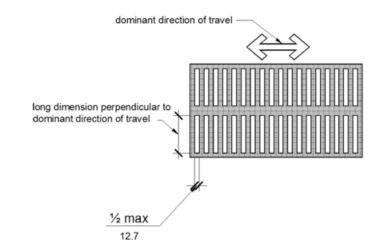
FIGURE 11B-302.3 ELONGATED OPENINGS IN FLOOR OR GROUND SURFACES
11B-303.1 General.
Where changes in level are permitted in floor or ground surfaces, they shall comply with Section 11B-303.
Exceptions:
- Animal containment areas shall not be required to comply with Section 11B-303.
- Areas of sport activity shall not be required to comply with Section 11B-303.
11B-303.2 Vertical.
Changes in level of ¼ inch (6.4 mm) high maximum shall be permitted to be vertical and without edge treatment.
[2010 ADA Standards] 303.2 Vertical. Changes in level of ¼ inch high maximum shall be permitted to be vertical.

FIGURE 11B-303.2 VERTICAL CHANGE IN LEVEL
11B-303.3 Beveled.
Changes in level between ¼ inch (6.4 mm) high minimum and ½ inch (12.7 mm) high maximum shall be beveled with a slope not steeper than 1:2.

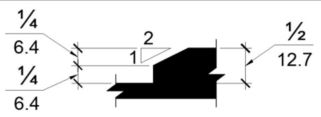
FIGURE 11B-303.3 BEVELED CHANGE IN LEVEL
11B-303.4 Ramps.
Changes in level greater than ½ inch (12.7 mm) high shall be ramped, and shall comply with Section 11B-405 or 11B-406.
11B-303.5 Warning curbs.
Abrupt changes in level exceeding 4 inches (102 mm) in a vertical dimension between walks, sidewalks or other pedestrian ways and adjacent surfaces or features shall be identified by warning curbs at least 6 inches (152 mm) in height above the walk or sidewalk surface.
Exceptions:
11B-304.1 General.
Turning space shall comply with Section 11B-304.
11B-304.2 Floor or ground surfaces.
Floor or ground surfaces of a turning space shall comply with Section 11B-302. Changes in level, slopes exceeding 1:48, and detectable warnings shall not be permitted.
Exception: Reserved.

11B-304.3 Size.
Turning space shall comply with Section 11B-304.3.1 or 11B-304.3.2.
11B-304.3.1 Circular space.
The turning space shall be a space of 60 inches (1524 mm) diameter minimum. The space shall be permitted to include knee and toe clearance complying with Section 11B-306.
11B-304.3.2 T-Shaped space.
The turning space shall be a T-shaped space within a 60 inch (1524 mm) square minimum with arms and base 36 inches (914 mm) wide minimum. Each arm of the T shall be clear of obstructions 12 inches (305 mm) minimum in each direction and the base shall be clear of obstructions 24 inches (610 mm) minimum. The space shall be permitted to include knee and toe clearance complying with Section 11B-306 only at the end of either the base or one arm.
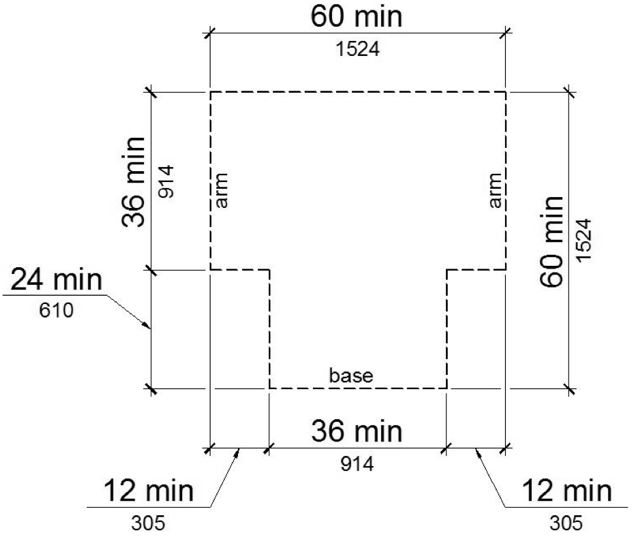
FIGURE 11B-304.3.2 T-SHAPED TURNING SPACE
11B-304.4 Door swing.
Doors shall be permitted to swing into turning spaces.
11B-305.2 Floor or ground surfaces.
Floor or ground surfaces of a clear floor or ground space shall comply with Section 11B-302. Changes in level, slopes exceeding 1:48, and detectable warnings shall not be permitted.
Exception: Reserved.
11B-305.3 Size.
The clear floor or ground space shall be 30 inches (762 mm) minimum by 48 inches (1219 mm) minimum.
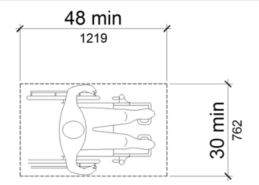
FIGURE 11B-305.3 CLEAR FLOOR OR GROUND SPACE
11B-305.4 Knee and toe clearance.
Unless otherwise specified, clear floor or ground space shall be permitted to include knee and toe clearance complying with Section 11B-306.
11B-305.5 Position.
Unless otherwise specified, clear floor or ground space shall be positioned for either forward or parallel approach to an element.
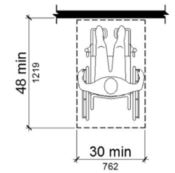
(a) forward
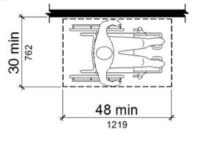
(b) parallel
FIGURE 11B-305.5 POSITION OF CLEAR FLOOR OR GROUND SPACE
11B-305.6 Approach.
One full unobstructed side of the clear floor or ground space shall adjoin an accessible route or adjoin another clear floor or ground space. Clear floor or ground space may overlap an accessible route, unless specifically prohibited elsewhere in this chapter.
11B-305.7 Maneuvering clearance.
Where a clear floor or ground space is located in an alcove or otherwise confined on all or part of three sides, additional maneuvering clearance shall be provided in accordance with Sections 11B-305.7.1 and 11B-305.7.2.
11B-305.7.1 Forward approach.
Alcoves shall be 36 inches (914 mm) wide minimum where the depth exceeds 24 inches (610 mm).
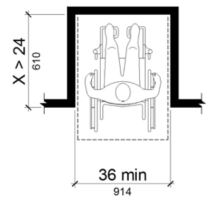
FIGURE 11B-305.7.1 MANEUVERING CLEARANCE IN AN ALCOVE, FORWARD APPROACH
11B-305.7.2 Parallel approach.
Alcoves shall be 60 inches (1524 mm) wide minimum where the depth exceeds 15 inches (381 mm).
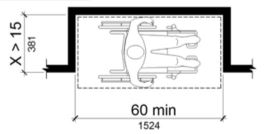
FIGURE 11B-305.7.2 MANEUVERING CLEARANCE IN AN ALCOVE, PARALLEL APPROACH
11B-306.1 General.
Where space beneath an element is included as part of clear floor or ground space or turning space, the space shall comply with Section 11B-306. Additional space shall not be prohibited beneath an element but shall not be considered as part of the clear floor or ground space or turning space.

11B-306.2.1 General.
Space under an element between the finish floor or ground and 9 inches (229 mm) above the finish floor or ground shall be considered toe clearance and shall comply with Section 11B-306.2.
11B-306.2.2 Maximum depth.
Toe clearance shall extend 25 inches (635 mm) maximum under an element.
Exception: Toe clearance shall extend 19 inches (483 mm) maximum under lavatories required to be accessible by Section 11B-213.3.4.
11B-306.2.3 Minimum required depth.
Where toe clearance is required at an element as part of a clear floor space, the toe clearance shall extend 17 inches (432 mm) minimum under the element.
Exceptions:
- The toe clearance shall extend 19 inches (483 mm) minimum under sinks required to be accessible by Section 11B-212.3.
- The toe clearance shall extend 19 inches (483 mm) minimum under built-in dining and work surfaces required to be accessible by Section 11B-226.1.
11B-306.2.4 Additional clearance.
Space extending greater than 6 inches (152 mm) beyond the available knee clearance at 9 inches (229 mm) above the finish floor or ground shall not be considered toe clearance.
11B-306.2.5 Width.
Toe clearance shall be 30 inches (762 mm) wide minimum.
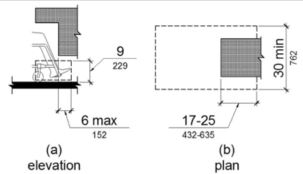
FIGURE 11B-306.2 TOE CLEARANCE ‡‡
11B-306.3.1 General.
Space under an element between 9 inches (229 mm) and 27 inches (686 mm) above the finish floor or ground shall be considered knee clearance and shall comply with Section 11B-306.3.
Exception: At lavatories required to be accessible by Section 11B-213.3.4, space between 9 inches (229 mm) and 29 inches (737 mm) above the finish floor or ground, shall be considered knee clearance.
11B-306.3.2 Maximum depth.
Knee clearance shall extend 25 inches (635 mm) maximum under an element at 9 inches (229 mm) above the finish floor or ground.
11B-306.3.3 Minimum required depth.
Where knee clearance is required under an element as part of a clear floor space, the knee clearance shall be 11 inches (279 mm) deep minimum at 9 inches (229 mm) above the finish floor or ground, and 8 inches (203 mm) deep minimum at 27 inches (686 mm) above the finish floor or ground.
Exceptions:
- At lavatories required to be accessible by Section 11B-213.3.4, the knee clearance shall be 27 inches (686 mm) high minimum above the finish floor or ground at a depth of 8 inches (203 mm) minimum increasing to 29 inches (737 mm) high minimum above the finish floor or ground at the front edge of a counter with a built-in lavatory or at the front edge of a wall-mounted lavatory fixture.
- At dining and work surfaces required to be accessible by Section 11B-226.1, knee clearance shall extend 19 inches (483 mm) deep minimum at 27 inches (686 mm) above the finish floor or ground.
11B-306.3.4 Clearance reduction.
Between 9 inches (229 mm) and 27 inches (686 mm) above the finish floor or ground, the knee clearance shall be permitted to reduce at a rate of 1 inch (25 mm) in depth for each 6 inches (152 mm) in height.
Exception: The knee clearance shall not be reduced at built-in dining and work surfaces required to be accessible by Section 11B-226.1.
11B-306.3.5 Width.
Knee clearance shall be 30 inches (762 mm) wide minimum.
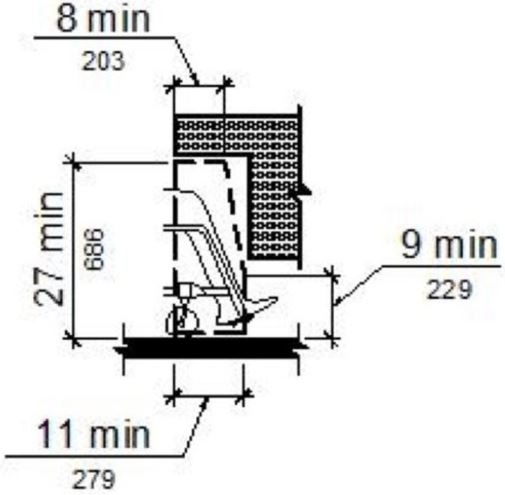
(a) elevation
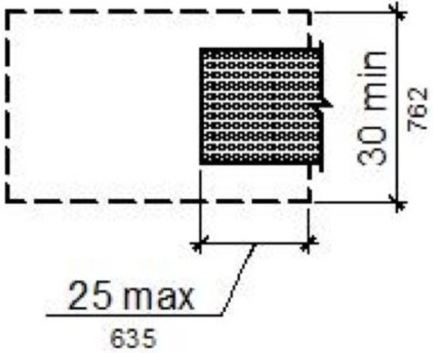
(b) plan
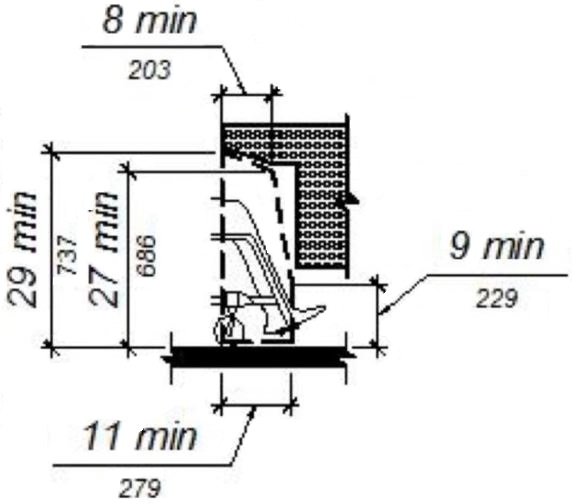
(c) elevation @ lavatory
FIGURE 11B-306.3 KNEE CLEARANCE ‡‡
11B-307.1 General.
Protruding objects shall comply with Section 11B-307.
11B-307.2 Protrusion limits.
Objects with leading edges more than 27 inches (686 mm) and not more than 80 inches (2032 mm) above the finish floor or ground shall protrude 4 inches (102 mm) maximum horizontally into the circulation path.
Exception: Handrails shall be permitted to protrude 4½ inches (114 mm) maximum.

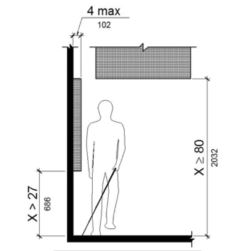
FIGURE 11B-307.2 LIMITS OF PROTRUDING OBJECTS
11B-307.3 Post-mounted objects.
Free-standing objects mounted on posts or pylons shall overhang circulation paths 12 inches (305 mm) maximum when located 27 inches (686 mm) minimum and 80 inches (2032 mm) maximum above the finish floor or ground. Where a sign or other obstruction is mounted between posts or pylons and the clear distance between the posts or pylons is greater than 12 inches (305 mm), the lowest edge of such sign or obstruction shall be 27 inches (686 mm) maximum or 80 inches (2032 mm) minimum above the finish floor or ground.
Exception: The sloping portions of handrails serving stairs and ramps shall not be required to comply with Section 11B-307.3.
11B-307.3.1 Edges and corners.
Where signs or other objects are mounted on posts or pylons, and their bottom edges are less than 80 inches (2032 mm) above the floor or ground surface, the edges of such signs and objects shall be rounded or eased and the corners shall have a minimum radius of 1/8 inch (3.2 mm).
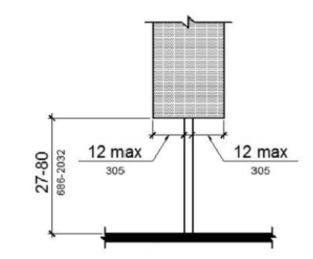
(a)
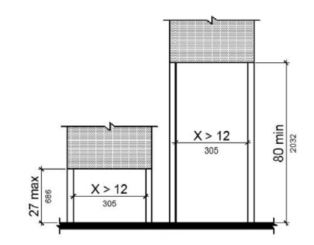
(b)
FIGURE 11B-307.3 POST-MOUNTED PROTRUDING OBJECTS
11B-307.4 Vertical clearance.
Vertical clearance shall be 80 inches (2032 mm) high minimum. Guardrails or other barriers shall be provided where the vertical clearance is less than 80 inches (2032 mm) high. The leading edge of such guardrail or barrier shall be located 27 inches (686 mm) maximum above the finish floor or ground.
Exception: Door closers and door stops shall be permitted to be 78 inches (1981 mm) minimum above the finish floor or ground.
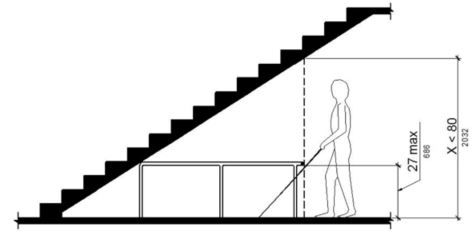
FIGURE 11B-307.4 VERTICAL CLEARANCE
11B-307.4.1 Guy braces.
Where a guy support is used within either the width of a circulation path or 24 inches maximum outside of a circulation path, a vertical guy brace, sidewalk guy or similar device shall be used to prevent a hazard or an overhead obstruction.
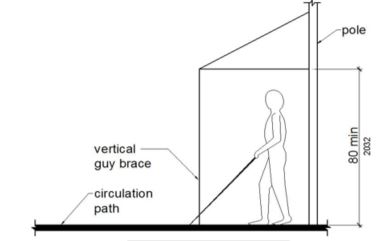
FIGURE 11B-307.4.1 GUY BRACES
11B-307.5 Required clear width.
Protruding objects shall not reduce the clear width required for accessible routes.
11B-308.1 General.
Reach ranges shall comply with Section 11B-308.

|
Children's Reach Ranges |
|||
|---|---|---|---|
|
Forward or Side Reach |
Ages 3 and 4 | Ages 5 through 8 |
Ages 9 through 12 |
|
High (maximum) |
36 in (915 mm) |
40 in (1015 mm) |
44 in (1120 mm) |
|
Low (minimum) |
20 in (510 mm) |
18 in (455 mm) |
16 in (405 mm) |
11B-308.1.1 Electrical switches.
Controls and switches intended to be used by the occupant of a room or area to control lighting and receptacle outlets, appliances or cooling, heating and ventilating equipment, shall comply with Section 11B-308 except the low reach shall be measured to the bottom of the outlet box and the high reach shall be measured to the top of the outlet box.
11B-308.1.2 Electrical receptacle outlets.
Electrical receptacle outlets on branch circuits of 30 amperes or less and communication system receptacles shall comply with Section 11B-308 except the low reach shall be measured to the bottom of the outlet box and the high reach shall be measured to the top of the outlet box.
11B-308.2.1 Unobstructed.
Where a forward reach is unobstructed, the high forward reach shall be 48 inches (1219 mm) maximum and the low forward reach shall be 15 inches (381 mm) minimum above the finish floor or ground.
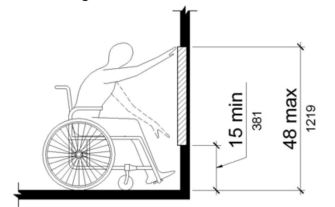
FIGURE 11B-308.2.1 UNOBSTRUCTED FORWARD REACH
11B-308.2.2 Obstructed high reach.
Where a high forward reach is over an obstruction, the clear floor space shall extend beneath the element for a distance not less than the required reach depth over the obstruction. The high forward reach shall be 48 inches (1219 mm) maximum where the reach depth is 20 inches (508 mm) maximum. Where the reach depth exceeds 20 inches (508 mm), the high forward reach shall be 44 inches (1118 mm) maximum and the reach depth shall be 25 inches (635 mm) maximum.
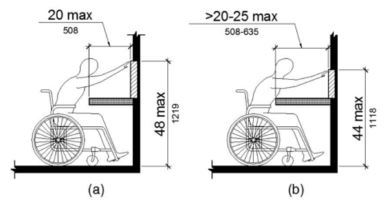
FIGURE 11B-308.2.2 OBSTRUCTED HIGH FORWARD REACH
11B-308.3.1 Unobstructed.
Where a clear floor or ground space allows a parallel approach to an element and the side reach is unobstructed, the high side reach shall be 48 inches (1219 mm) maximum and the low side reach shall be 15 inches (381 mm) minimum above the finish floor or ground.
Exceptions:
- An obstruction shall be permitted between the clear floor or ground space and the element where the depth of the obstruction is 10 inches (254 mm) maximum.
- Operable parts of fuel dispensers shall be permitted to be 54 inches (1372 mm) maximum measured from the surface of the vehicular way where fuel dispensers are installed on existing curbs.
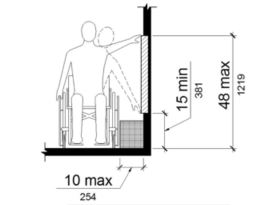
FIGURE 11B-308.3.1 UNOBSTRUCTED SIDE REACH
11B-308.3.2 Obstructed high reach.
Where a clear floor or ground space allows a parallel approach to an element and the high side reach is over an obstruction, the height of the obstruction shall be 34 inches (864 mm) maximum and the depth of the obstruction shall be 24 inches (610 mm) maximum. The high side reach shall be 48 inches (1219 mm) maximum for a reach depth of 10 inches (254 mm) maximum. Where the reach depth exceeds 10 inches (254 mm), the high side reach shall be 46 inches (1168 mm) maximum for a reach depth of 24 inches (610 mm) maximum.
Exceptions:
- The top of washing machines and clothes dryers shall be permitted to be 36 inches (914 mm) maximum above the finish floor.
- Operable parts of fuel dispensers shall be permitted to be 54 inches (1372 mm) maximum measured from the surface of the vehicular way where fuel dispensers are installed on existing curbs.
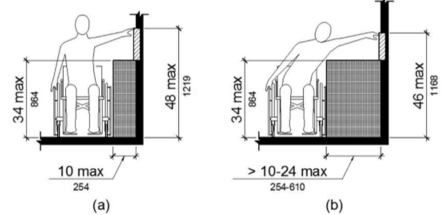
FIGURE 11B-308.3.2 OBSTRUCTED HIGH SIDE REACH
11B-308.4 Suggested reach ranges for children.
Where building elements such as coat hooks, lockers, or operable parts are designed for use primarily by children, the suggested dimensions of Table 11B-308.4 shall be permitted. These dimensions apply to either forward or side reaches.
TABLE 11B-308.4 SUGGESTED DIMENSIONS FOR CHILDREN'S USE
|
SUGGESTED REACH RANGES FOR CHILDREN AGES 3 THROUGH 12 |
|||
|---|---|---|---|
|
Forward or Side Reach |
Ages 3 and 4 | Ages 5 through 8 |
Ages 9 through 12 |
|
High (maximum) |
36 inches (914 mm) | 40 inches (1016 mm) |
44 inches (1118 mm) |
|
Low (minimum) |
20 inches (508 mm) | 18 inches (457 mm) |
16 inches (406 mm) |
11B-309.2 Clear floor space.
A clear floor or ground space complying with Section 11B-305 shall be provided.
11B-309.3 Height.
Operable parts shall be placed within one or more of the reach ranges specified in Section 11B-308.
11B-309.4 Operation.
Operable parts shall be operable with one hand and shall not require tight grasping, pinching, or twisting of the wrist. The force required to activate operable parts shall be 5 pounds (22.2 N) maximum.
Exception: Gas pump nozzles and electric vehicle connectors shall not be required to provide operable parts that have an activating force of 5 pounds (22.2 N) maximum.
11B-401.1 Scope.
The provisions of Division 4 shall apply where required by Division 2 or where referenced by a requirement in this chapter.
11B-402.2 Components.
Accessible routes shall consist of one or more of the following components: walking surfaces with a running slope not steeper than 1:20, doorways, ramps, curb ramps excluding the flared sides, elevators, and platform lifts. All components of an accessible route shall comply with the applicable requirements of Division 4.

11B-403.1 General.
Walking surfaces that are a part of an accessible route shall comply with Section 11B-403.
11B-403.2 Floor or ground surface.
Floor or ground surfaces shall comply with Section 11B-302.
11B-403.3 Slope.
The running slope of walking surfaces shall not be steeper than 1:20. The cross slope of walking surfaces shall not be steeper than 1:48.
Exception: The running slope of sidewalks shall not exceed the general grade established for the adjacent street or highway.

When the running slope of a walking surface exceeds 5%, it must comply with the accessibility requirements for ramps.
A sloping sidewalk with a running slope in excess of 5% is excluded from ramp requirements for landings and handrails but it must comply with cross-slope and width requirements. ◼
ETA Editor's Note
The 2019 CBC Exception at 11B-403.3 is not present in the 2010 ADA Standards. Therefore, technically, the 2010 ADA Standards are more stringent with regard to the slope of sidewalks at streets or highways. CBC does not define street or highway but does define sidewalk as " ... contiguous to a street used by the public." It is inferable, whether intended or not, that sidewalks serving as accessible routes alongside private roadways are not excepted from the slope limitation.
In 2011, the U.S. Access Board published in the Federal Register its Proposed Guidelines for Pedestrian Facilities in the Public Right-Of-Way, along with a Notice of Proposed Rulemaking. The public comment period was concluded in 2012, and the guidelines are in the Final Rulemaking stage now. Until these guidelines become law, the Access Board is offering guidance on its website, where one can also request technical assistance and/or sign up for updates as to the rulemaking status: http://www.access-board.gov/guidelines-and-standards/streets-sidewalks/public-rights-of-way/.
In 2013, in response to feedback, the U.S. Access Board issued a proposed Supplemental Rule to address accessibility for Shared Use Paths (used by pedestrians, bicyclists, and others for transportation or recreation), distinguished from sidewalks, as well as from trails. More information about this rulemaking process is available on the Access Board’s website: https://www.access-board.gov/guidelines-and-standards/streets-sidewalks/shared-use-paths.
11B-403.4 Changes in level.
Changes in level shall comply with Section 11B-303.
11B-403.5 Clearances.
Walking surfaces shall provide clearances complying with Section 11B-403.5.
Exception: Within employee work areas, clearances on common use circulation paths shall be permitted to be decreased by work area equipment provided that the decrease is essential to the function of the work being performed.
11B-403.5.1 Clear width.
Except as provided in Sections 11B-403.5.2 and 11B-403.5.3, the clear width of walking surfaces shall be 36 inches (914 mm) minimum.
Exceptions:
- The clear width shall be permitted to be reduced to 32 inches (813 mm) minimum for a length of 24 inches (610 mm) maximum provided that reduced width segments are separated by segments that are 48 inches (1219 mm) long minimum and 36 inches (914 mm) wide minimum.
- The clear width for walking surfaces in corridors serving an occupant load of 10 or more shall be 44 inches (1118 mm) minimum.
- The clear width for sidewalks and walks shall be 48 inches (1219 mm) minimum. When, because of right-of-way restrictions, natural barriers or other existing conditions, the enforcing agency determines that compliance with the 48-inch (1219 mm) clear sidewalk width would create an unreasonable hardship, the clear width may be reduced to 36 inches (914 mm).
- The clear width for aisles shall be 36 inches (914 mm) minimum if serving elements on only one side, and 44 inches (1118 mm) minimum if serving elements on both sides.
- The clear width for accessible routes to accessible toilet compartments shall be 44 inches (1118 mm) except for door-opening widths and door swings.
ETA Editor's Note
CBC Exceptions 2, 3 and 4 at 11B-403.5.1 are not present in the 2010 ADA Standards. Therefore, CBC requirements related to the clear width of accessible routes are more stringent.
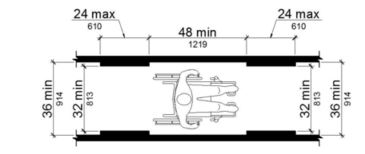
FIGURE 11B-403.5.1 CLEAR WIDTH OF AN ACCESSIBLE ROUTE
11B-403.5.2 Clear width at turn.
Where the accessible route makes a 180 degree turn around an element which is less than 48 inches (1219 mm) wide, clear width shall be 42 inches (1067 mm) minimum approaching the turn, 48 inches (1219 mm) minimum at the turn and 42 inches (1067 mm) minimum leaving the turn.
Exception: Where the clear width at the turn is 60 inches (1524 mm) minimum compliance with Section 11B-403.5.2 shall not be required.
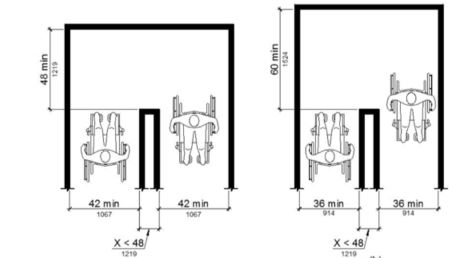
FIGURE 11B-403.5.2 CLEAR WIDTH AT TURN
11B-403.5.3 Passing spaces.
An accessible route with a clear width less than 60 inches (1524 mm) shall provide passing spaces at intervals of 200 feet (60,960 mm) maximum. Passing spaces shall be either: a space 60 inches (1524 mm) minimum by 60 inches (1524 mm) minimum; or, an intersection of two walking surfaces providing a T-shaped space complying with Section 11B-304.3.2 where the base and arms of the T-shaped space extend 48 inches (1219 mm) minimum beyond the intersection.
11B-403.6 Handrails.
Where handrails are provided along walking surfaces with running slopes not steeper than 1:20 they shall comply with Section 11B-505.

11B-403.7 Continuous gradient.
All walks with continuous gradients shall have resting areas, 60 inches (1524 mm) in length, at intervals of 400 feet (121,920 mm) maximum. The resting area shall be at least as wide as the walk. The slope of the resting area in all directions shall be 1:48 maximum.
ETA Editor's Note
CBC requirement 11B-403.7 is not present in the 2010 ADA Standards. Therefore, CBC requirements related to continuous gradients are more stringent.
11B-404.1 General.
Doors, doorways, and gates that are part of an accessible route shall comply with Section 11B-404.
Exceptions:
- Doors, doorways, and gates designed to be operated only by security personnel shall not be required to comply with Sections 11B-404.2.7, 11B-404.2.8, 11B-404.2.9, 11B-404.3.2 and 11B-404.3.4 through 11B-404.3.7. A sign visible from the approach side complying with Section 11B-703.5 shall be posted stating “Entry restricted and controlled by security personnel”.
- At detention and correctional facilities, doors, doorways, and gates designed to be operated only by security personnel shall not be required to comply with Sections 11B-404.2.7, 11B-404.2.8, 11B-404.2.9, 11B-404.3.2 and 11B-404.3.4 through 11B-404.3.7.
[2010 ADA Standards] EXCEPTION: Doors, doorways, and gates designed to be operated only by security personnel shall not be required to comply with 404.2.7, 404.2.8, 404.2.9, 404.3.2 and 404.3.4 through 404.3.7.

ETA Editor's Note
CBC provides a second exception at 11B-404.1 to distinguish doors that are operated only by security personnel at detention and correctional facilities vs. other facility types. The latter are required to have an informational sign, while the former are not.
11B-404.2 Manual doors, doorways, and manual gates
Manual doors and doorways and manual gates intended for user passage shall comply with Section 11B-404.2.
11B-404.2.1 Revolving doors, gates, and turnstiles.
Revolving doors, revolving gates, and turnstiles shall not be part of an accessible route.
11B-404.2.2 Double-leaf doors and gates.
At least one of the active leaves of doorways with two leaves shall comply with Sections 11B-404.2.3 and 11B-404.2.4.
11B-404.2.3 Clear width.
Door openings shall provide a clear width of 32 inches (813 mm) minimum. Clear openings of doorways with swinging doors shall be measured between the face of the door and the stop, with the door open 90 degrees. Openings more than 24 inches (610 mm) deep shall provide a clear opening of 36 inches (914 mm) minimum. There shall be no projections into the required clear opening width lower than 34 inches (864 mm) above the finish floor or ground. Projections into the clear opening width between 34 inches (864 mm) and 80 inches (2032 mm) above the finish floor or ground shall not exceed 4 inches (102 mm).
Exceptions:
- In alterations, a projection of 5/8 inch (15.9 mm) maximum into the required clear width shall be permitted for the latch side stop.
- Door closers and door stops shall be permitted to be 78 inches (1981 mm) minimum above the finish floor or ground.
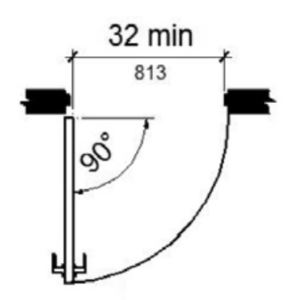
(a) hinged door

(b) sliding door
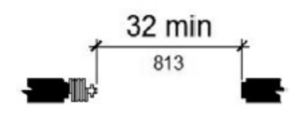
(c) folding door
FIGURE 11B-404.2.3 CLEAR WIDTH OF DOORWAYS
11B-404.2.4 Maneuvering clearances.
Minimum maneuvering clearances at doors and gates shall comply with Section 11B-404.2.4. Maneuvering clearances shall extend the full width of the doorway and the required latch side or hinge side clearance.
Exception: Reserved.
[2010 ADA Standards] EXCEPTION: Entry doors to hospital patient rooms shall not be required to provide the clearance beyond the latch side of the door.
ETA Editor's Note
CBC does not include the 2010 ADA Standards Exception at 404.2.4. Therefore, CBC requirements related to entry doors at patient rooms are more stringent.
11B-404.2.4.1 Swinging doors and gates.
Swinging doors and gates shall have maneuvering clearances complying with Table 11B-404.2.4.1.
TABLE 11B-404.2.4.1 MANEUVERING CLEARANCES AT MANUAL SWINGING DOORS AND GATES
|
TYPE OF USE |
MINIMUM MANEUVERING CLEARANCE |
||
|---|---|---|---|
|
Approach direction |
Door or gate side | Perpendicular to doorway |
Parallel to doorway (beyond latch side unless noted) |
|
From front |
Pull | 60 inches (1524 mm) |
18 inches (457 mm)5 |
|
From front |
Push | 48 inches (1219 mm) |
0 inches (0 mm)1 |
|
From hinge side |
Pull | 60 inches (1524 mm) |
36 inches (914 mm) |
|
From hinge side |
Push |
44 inches (1118 mm)2 [2010 ADA Standards] 42 inches, add 6 inches if closer and latch provided |
22 inches (559 mm)3 |
|
From latch side |
Pull |
60 inches (1524 mm) [2010 ADA Standards] 48 inches, add 6" if closer provided |
24 inches (610 mm) |
|
From latch side |
Push |
44 inches (1118 mm)4 [2010 ADA Standards] 42 inches, add 6" if closer provided |
24 inches (610 mm) |
1. Add 12 inches (305 mm) if closer and latch are provided.
2. Add 4 inches (102 mm) if closer and latch are provided.
3. Beyond hinge side.
4. Add 4 inches (102 mm) if closer is provided.
5. Add 6 inches (152 mm) at exterior side of exterior doors.
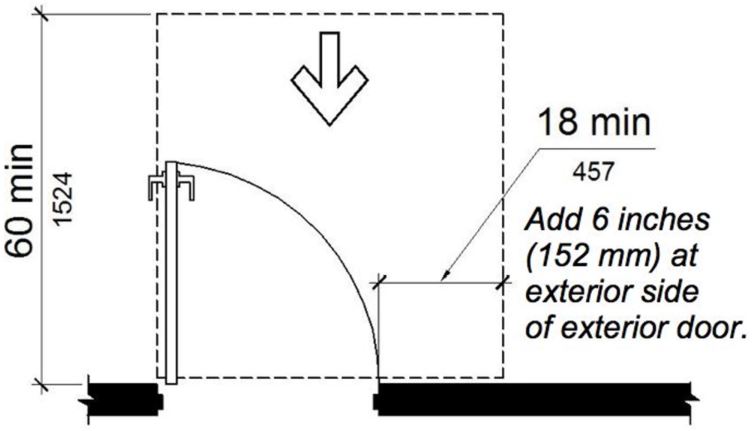
(a) front approach, pull side
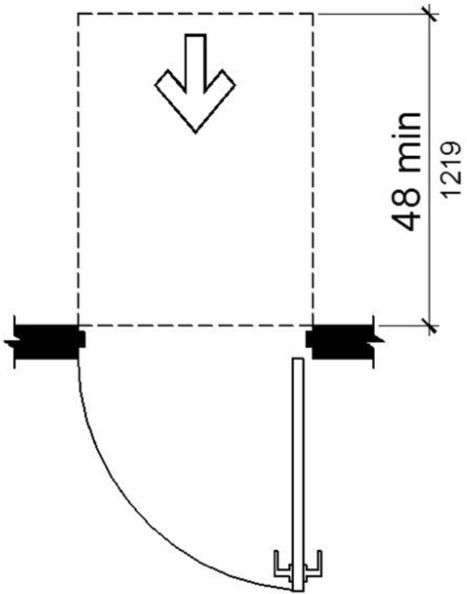
(b) front approach, push side
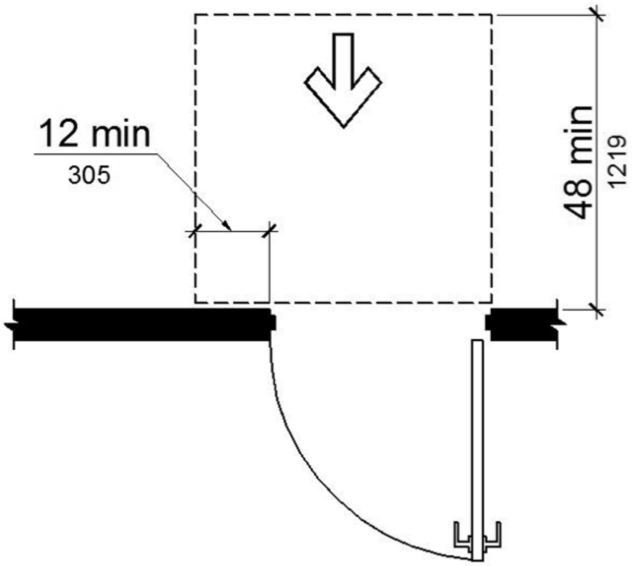
(c) front approach, push side, door provided with both closer and latch
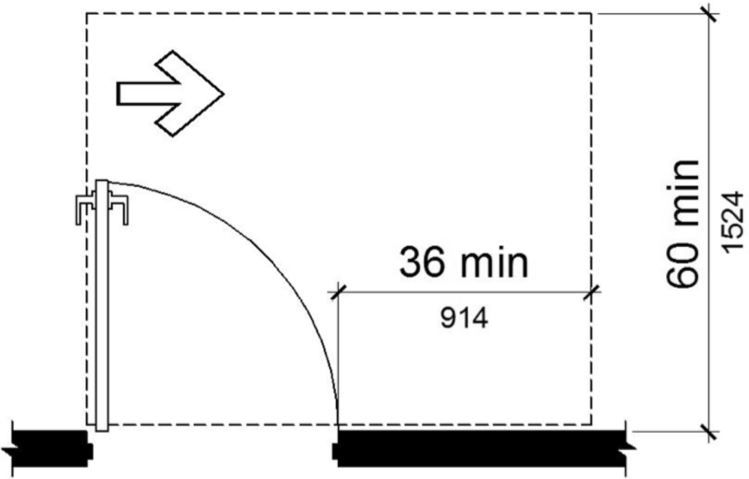
(d) hinge approach, pull side
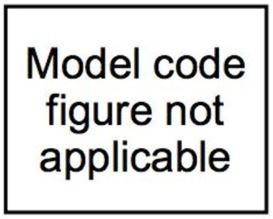
(e) reserved
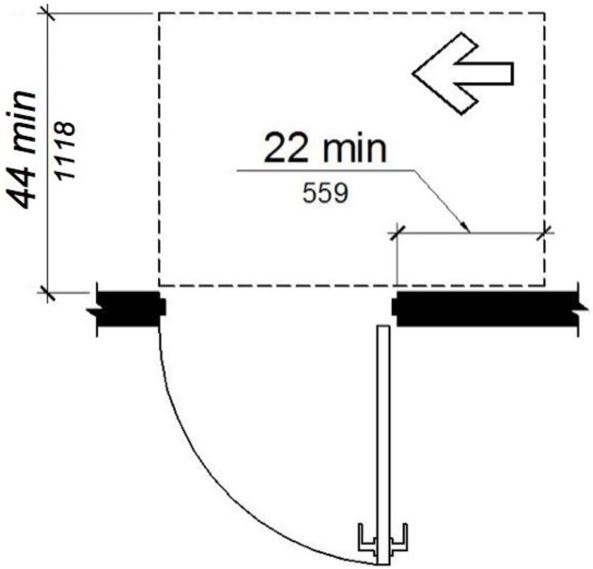
f) hinge approach, push side
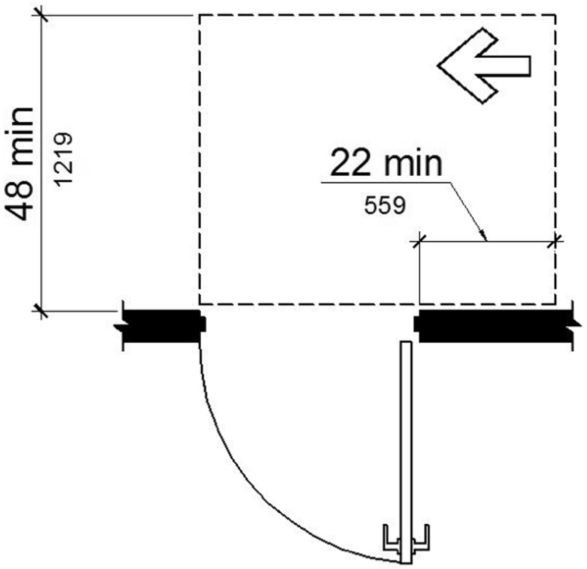
(g) hinge approach, push side, door provided with both closer and latch
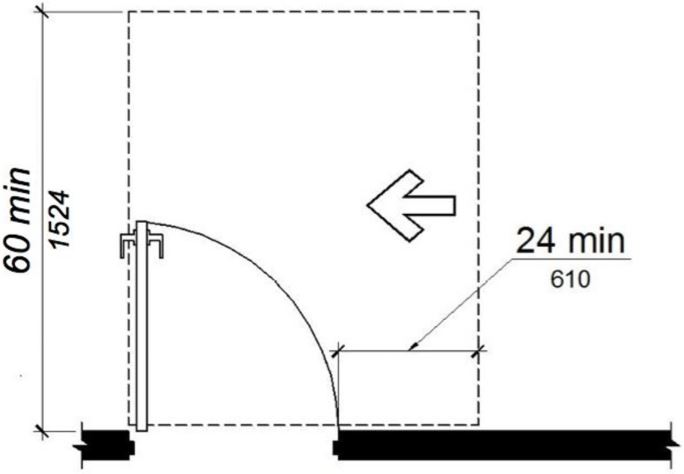
(h) latch approach, pull side
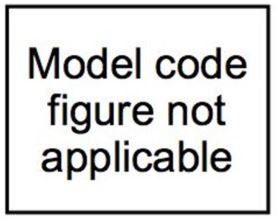
(i) reserved
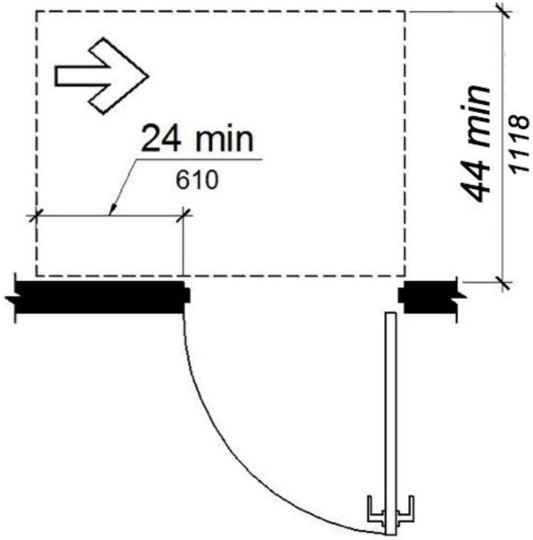
(j) latch approach, push side
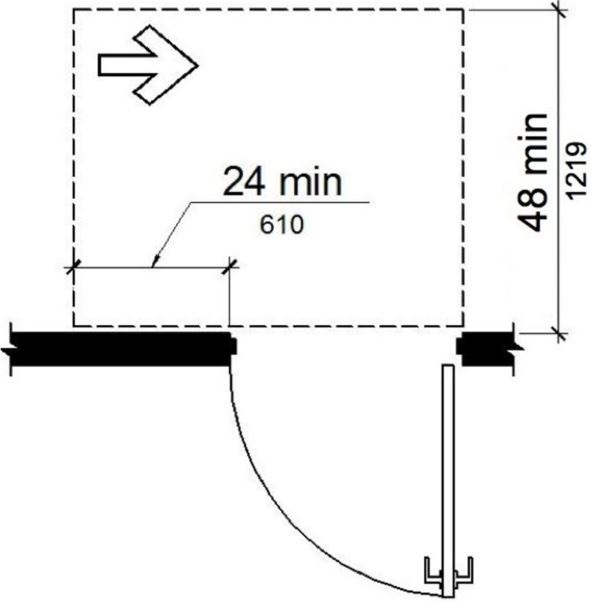
(k) latch approach, push side, door provided with closer
FIGURE 11B-404.2.4.1 MANEUVERING CLEARANCES AT MANUAL SWINGING DOORS AND GATES ‡‡
11B-404.2.4.2 Doorways without doors or gates, sliding doors, and folding doors.
Doorways less than 36 inches (914 mm) wide without doors or gates, sliding doors, or folding doors shall have maneuvering clearances complying with Table 11B-404.2.4.2.
TABLE 11B-404.2.4.2 MANEUVERING CLEARANCES AT DOORWAYS WITHOUT DOORS OR GATES, MANUAL SLIDING DOORS, AND MANUAL FOLDING DOORS
|
MINIMUM MANEUVERING CLEARANCE |
||
|---|---|---|
|
Approach direction |
Perpendicular to doorway |
Parallel to doorway (beyond stop/latch side unless noted) |
|
From Front |
48 inches (1219 mm) |
0 inches (0 mm) |
|
From side1 |
42 inches (1067 mm) |
0 inches (0 mm) |
|
From pocket/hinge side |
42 inches (1067 mm) |
22 inches (559 mm)2 |
|
From stop/latch side |
42 inches (1067 mm) |
24 inches (610 mm) |
1. Doorway with no door only.
2. Beyond pocket/hinge side.
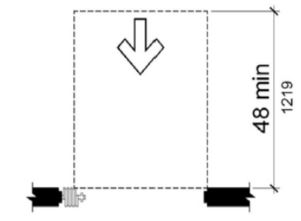
(a) front approach
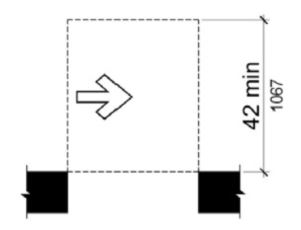
(b) side approach
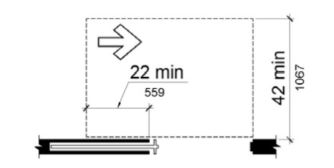
(c) pocket or hinge approach
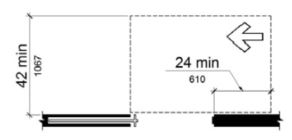
(d) stop or latch approach
FIGURE 11B-404.2.4.2 MANEUVERING CLEARANCES AT DOORWAYS WITHOUT DOORS, SLIDING DOORS, GATES, AND FOLDING DOORS
11B-404.2.4.3 Recessed doors and gates.
Maneuvering clearances for forward approach shall be provided when any obstruction within 18 inches (457 mm) of the latch side at an interior doorway, or within 24 inches (610 mm) of the latch side of an exterior doorway, projects more than 8 inches (203 mm) beyond the face of the door, measured perpendicular to the face of the door or gate.
[2010 ADA Standards] 404.2.4.3 Recessed Doors and Gates. Maneuvering clearances for forward approach shall be provided when any obstruction within 18 inches (455 mm) of the latch side of a doorway projects more than 8 inches (205 mm) beyond the face of the door, measured perpendicular to the face of the door or gate.

ETA Editor's Note
CBC latch side clearance at exterior doors is more stringent than the 2010 ADA Standards.
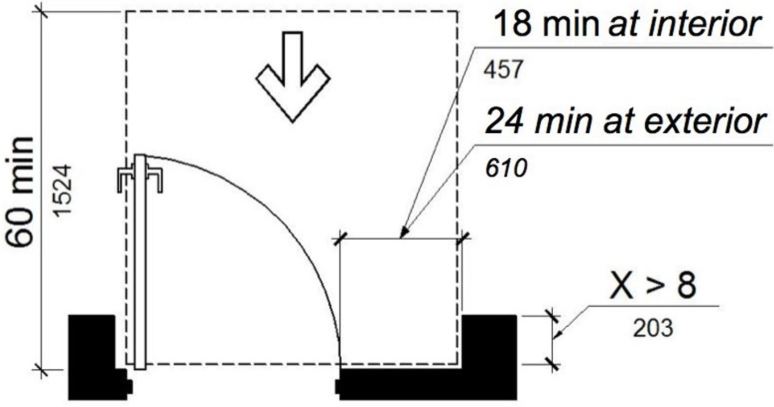
(a) pull side
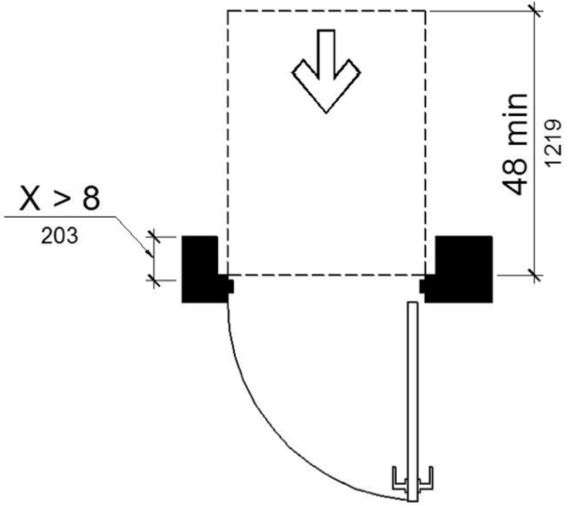
(b) push side
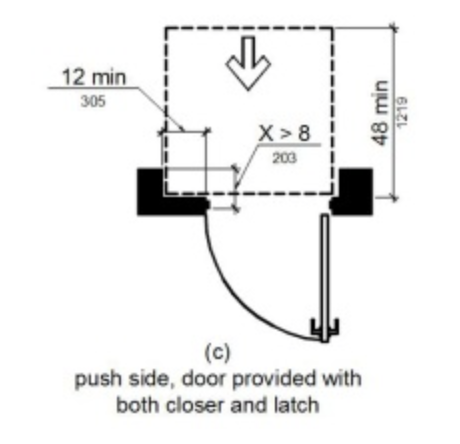
FIGURE 11B-404.2.4.3 MANEUVERING CLEARANCES AT RECESSED DOORS AND GATES ‡‡
11B-404.2.4.4 Floor or ground surface.
Floor or ground surface within required maneuvering clearances shall comply with Section 11B-302. Changes in level, slopes exceeding 1:48, and detectable warnings shall not be permitted.
Exceptions:
11B-404.2.5 Thresholds.
Thresholds, if provided at doorways, shall be ½ inch (12.7 mm) high maximum. Raised thresholds and changes in level at doorways shall comply with Sections 11B-302 and 11B-303.
Exception: Reserved.
[2010 ADA Standards] EXCEPTION: Existing or altered thresholds ¾ inch (19 mm) high maximum that have a beveled edge on each side with a slope not steeper than 1:2 shall not be required to comply with 404.2.5.
11B-404.2.6 Doors in series and gates in series.
The distance between two hinged or pivoted doors in series and gates in series shall be 48 inches (1219 mm) minimum plus the width of doors or gates swinging into the space.
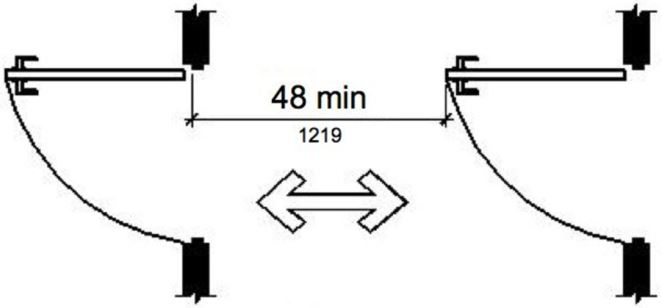
(a)
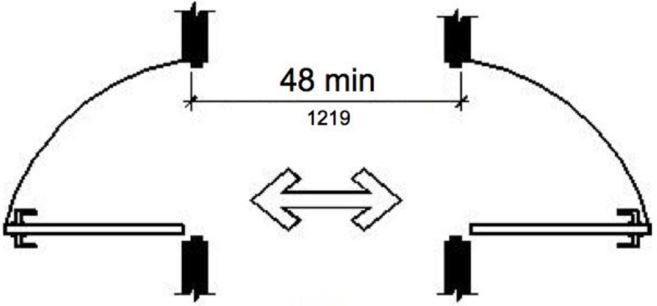
(b)
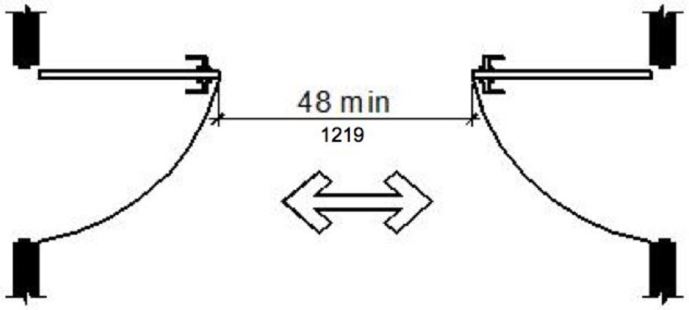
(c)
FIGURE 11B-404.2.6 DOORS IN SERIES AND GATES IN SERIES
11B-404.2.7 Door and gate hardware.
Handles, pulls, latches, locks, and other operable parts on doors and gates shall comply with Section 11B-309.4. Operable parts of such hardware shall be 34 inches (864 mm) minimum and 44 inches (1118 mm) maximum above the finish floor or ground. Where sliding doors are in the fully open position, operating hardware shall be exposed and usable from both sides.
Exceptions:
- Existing locks shall be permitted in any location at existing glazed doors without stiles, existing overhead rolling doors or grilles, and similar existing doors or grilles that are designed with locks that are activated only at the top or bottom rail.
- Access gates in barrier walls and fences protecting pools, spas, and hot tubs shall be permitted to have operable parts of the release of latch on self-latching devices at 54 inches (1372 mm) maximum above the finish floor or ground provided the self-latching devices are not also self-locking devices and operated by means of a key, electronic opener, or integral combination lock.


[2010 ADA Standards] 404.2.7 Door and Gate Hardware. Handles, pulls, latches, locks, and other operable parts on doors and gates shall comply with 309.4. Operable parts of such hardware shall be 34 inches (865 mm) minimum and 48 inches (1220 mm) maximum above the finish floor or ground. Where sliding doors are in the fully open position, operating hardware shall be exposed and usable from both sides.
EXCEPTIONS: 1. Existing locks shall be permitted in any location at existing glazed doors without stiles, existing overhead rolling doors or grilles, and similar existing doors or grilles that are designed with locks that are activated only at the top or bottom rail.
2. Access gates in barrier walls and fences protecting pools, spas, and hot tubs shall be permitted to have operable parts of the release of latch on self-latching devices at 54 inches (1370 mm) maximum above the finish floor or ground provided the self-latching devices are not also self-locking devices and operated by means of a key, electronic opener, or integral combination lock.
11B-404.2.8 Closing speed.
Door and gate closing speed shall comply with Section 11B-404.2.8.
11B-404.2.8.1 Door closers and gate closers.
Door closers and gate closers shall be adjusted so that from an open position of 90 degrees, the time required to move the door to a position of 12 degrees from the latch is 5 seconds minimum.
Door and gate spring hinges shall be adjusted so that from the open position of 70 degrees, the door or gate shall move to the closed position in 1.5 seconds minimum.
11B-404.2.9 Door and gate opening force.
The force for pushing or pulling open a door or gate shall be as follows:
[2010 ADA Standards] 404.2.9 Door and Gate Opening Force. Fire doors shall have a minimum opening force allowable by the appropriate Administrative Authority. The force for pushing or pulling open a door or gate other than fire doors shall be as follows:
- Interior hinged doors and gates: 5 pounds (22.2 N) maximum.
- Sliding or folding doors: 5 pounds (22 N) maximum.
- Required fire doors: the minimum opening force allowable by the appropriate administrative authority, not to exceed 15 pounds (66.7 N).
- Exterior hinged doors: 5 pounds (22.2 N) maximum.
ETA Editor's Note
The CBC limitation for opening force at non-rated exterior doors is more stringent than the 2010 ADA Standards, and can be difficult to meet without a powered device at exterior doors exposed to wind, or leading from spaces that operate at negative pressure with respect to the exterior environment. That is the principal reason for the preceding Exception to 11B-404.2.9 that does not appear in the 2010 ADA Standards.
These forces do not apply to the force required to retract latch bolts or disengage other devices that hold the door or gate in a closed position.

Exception: When, at a single location, one of every eight exterior door leafs, or fraction of eight, is a powered door, other exterior doors at the same location, serving the same interior space, may have a maximum opening force of 8.5 pounds (37.8 N). The powered leaf(s) shall be located closest to the accessible route.
a. Powered doors shall comply with Section 11B-404.3. Powered doors shall be fully automatic doors complying with Builders Hardware Manufacturers’ Association (BHMA) A156.10 or low energy operated doors complying with BHMA A156.19.
b. Powered doors serving a building or facility with an occupancy of 150 or more shall be provided with a back-up battery or back-up generator. The back-up power source shall be able to cycle the door a minimum of 100 cycles.
c. Powered doors shall be controlled on both the interior and exterior sides of the doors by sensing devices, push plates, vertical actuation bars or other similar operating devices complying with Section 11B-309.
At each location where push plates are provided there shall be two push plates; the centerline of one push plate shall be 7 inches (178 mm) minimum and 8 inches (203 mm) maximum above the floor or ground surface and the centerline of the second push plate shall be 30 inches (762 mm) minimum and 44 inches (1118 mm) maximum above the floor or ground surface. Each push plate shall be a minimum of 4 inches (102 mm) diameter or a minimum of 4 inches by 4 inches (102 mm by 102 mm) square and shall display the International Symbol of Accessibility complying with Section 11B-703.7.
At each location where vertical actuation bars are provided the operable portion shall be located so the bottom is 5 inches (127 mm) maximum above the floor or ground surface and the top is 35 inches (889 mm) minimum above the floor or ground surface. The operable portion of each vertical actuation bar shall be a minimum of 2 inches (51 mm) wide and shall display the International Symbol of Accessibility complying with Section 11B-703.7.
Where push plates, vertical actuation bars or other similar operating devices are provided, they shall be placed in a conspicuous location. A level and clear floor or ground space for forward or parallel approach complying with Section 11B-305 shall be provided, centered on the operating device. Doors shall not swing into the required clear floor or ground space.
d. Signs identifying the accessible entrance required by Section 11B-216.6 shall be placed on, or immediately adjacent to, each powered door. Signs shall be provided in compliance with BHMA A156.10 or BHMA 156.19, as applicable.
e. In addition to the requirements of Item d, where a powered door is provided in buildings or facilities containing assembly occupancies of 300 or more, a sign displaying the International Symbol of Accessibility measuring 6 inches by 6 inches (152 mm by 152 mm), complying with Section 11B-703.7, shall be provided above the door on both the interior and exterior sides of each powered door.
11B-404.2.10 Door and gate surfaces.
Swinging door and gate surfaces within 10 inches (254 mm) of the finish floor or ground measured vertically shall have a smooth surface on the push side extending the full width of the door or gate. Parts creating horizontal or vertical joints in these surfaces shall be within 1/16 inch (1.6 mm) of the same plane as the other and be free of sharp or abrasive edges. Cavities created by added kick plates shall be capped.
Exceptions:
- Sliding doors shall not be required to comply with Section 11B-404.2.10.
- Tempered glass doors without stiles and having a bottom rail or shoe with the top leading edge tapered at 60 degrees minimum from the horizontal shall not be required to meet the 10 inch (254 mm) bottom smooth surface height requirement.
- Doors and gates that do not extend to within 10 inches (254 mm) of the finish floor or ground shall not be required to comply with Section 11B-404.2.10.
- Reserved.
[2010 ADA Standards] 4. Existing doors and gates without smooth surfaces within 10 inches (255 mm) of the finish floor or ground shall not be required to provide smooth surfaces complying with 404.2.10 provided that if added kick plates are installed, cavities created by such kick plates are capped.
ETA Editor's Note
Lacking Exception 4 at 11B-404.2.10, CBC is more stringent at existing doors than 2010 ADA Standards.
11B-404.2.11 Vision lights.
Doors, gates, and side lights adjacent to doors or gates, containing one or more glazing panels that permit viewing through the panels shall have the bottom of at least one glazed panel located 43 inches (1092 mm) maximum above the finish floor.
Exception: Glazing panels with the lowest part more than 66 inches (1676 mm) from the finish floor or ground shall not be required to comply with Section 11B-404.2.11.
ETA Editor's Note
The vision light requirement of CBC 11B-404.2.11 is derived from the 2010 ADA Standards 404.2.11. Under ADA, an existing door with a noncompliant vision light is a Safe Harbored element for path of travel and barrier removal purposes but will have to comply when the door is replaced, and may not be relocated elsewhere on an accessible route. Under CBC, an existing primary entrance door with a noncompliant vision light is not Safe Harbored, unless the Exception at 11B-404.2.11 applies, and must be mitigated under path of travel obligations.
11B-404.3 Automatic and power-assisted doors and gates.
Automatic doors and automatic gates shall comply with Section 11B-404.3. Full-powered automatic doors shall comply with ANSI/BHMA A156.10. Low-energy and power-assisted doors shall comply with ANSI/BHMA A156.19.

11B-404.3.1 Clear width.
Doorways shall provide a clear opening of 32 inches (813 mm) minimum in power-on and power-off mode. The minimum clear width for automatic door systems in a doorway shall provide a clear, unobstructed opening of 32 inches (813 mm) with one leaf positioned at an angle of 90 degrees from its closed position.
[2010 ADA Standards] 404.3.1 Clear Width. Doorways shall provide a clear opening of 32 inches (815 mm) minimum in power-on and power-off mode. The minimum clear width for automatic door systems in a doorway shall be based on the clear opening provided by all leaves in the open position.
ETA Editor's Note
CBC clear width requirement is more stringent at multi-leaf automatic and power-assisted doors than 2010 ADA Standards, since it must be provided by one door leaf.
11B-404.3.2 Maneuvering clearance.
Clearances at power-assisted doors and gates shall comply with Section 11B-404.2.4. Clearances at automatic doors and gates without standby power and serving an accessible means of egress shall comply with Section 11B-404.2.4.
Exception: Where automatic doors and gates remain open in the power-off condition, compliance with Section 11B-404.2.4 shall not be required.
ETA Editor's Note
The implication of 11B-404.3.2 is that power-assist devices (ANSI/BHMA A156.19) cannot substitute for required door maneuvering clearances, even if standby power is provided. Automatic door operators (ANSI/BHMA A156.10) can substitute for required door maneuvering clearances under one of the following conditions: a) standby power is provided; or, b) the door or gate remains open during power failure or cessation. See also DSA Advisory 11B-404.3.
11B-404.3.3 Thresholds.
Thresholds and changes in level at doorways shall comply with Section 11B-404.2.5.
11B-404.3.4 Doors in series and gates in series.
Doors in series and gates in series shall comply with Section 11B-404.2.6.
11B-404.3.5 Controls.
Manually operated controls shall comply with Section 11B-309. The clear floor space adjacent to the control shall be located beyond the arc of the door swing.

11B-404.3.6 Break out opening.
Where doors and gates without standby power are a part of a means of egress, the clear break out opening at swinging or sliding doors and gates shall be 32 inches (813 mm) minimum when operated in emergency mode.
Exception: Where manual swinging doors and gates comply with Section 11B-404.2 and serve the same means of egress compliance with Section 11B-404.3.6 shall not be required.
11B-404.3.7 Revolving doors, revolving gates, and turnstiles.
Revolving doors, revolving gates, and turnstiles shall not be part of an accessible route.
11B-405.1 General.
Ramps on accessible routes shall comply with Section 11B-405.
Exception: In assembly areas, aisle ramps adjacent to seating and not serving elements required to be on an accessible route shall not be required to comply with Section 11B-405.
11B-405.2 Slope.
Ramp runs shall have a running slope not steeper than 1:12.
Exception: Reserved.
[2010 ADA Standards] EXCEPTION: In existing sites, buildings, and facilities, ramps shall be permitted to have running slopes steeper than 1:12 complying with Table 405.2 where such slopes are necessary due to space limitations.
Table 405.2 Maximum Ramp Slope and Rise for Existing Sites, Buildings, and Facilities
|
Slope1 |
Maximum Rise |
|---|---|
|
Steeper than 1:10 but |
3 inches (75 mm) |
|
Steeper than 1:12 but |
6 inches (150 mm) |
1. A slope steeper than 1:8 is prohibited.

ETA Editor's Note
Lacking the Exception at 11B-405.2, CBC is more stringent at existing ramps than 2010 ADA Standards.
11B-405.3 Cross slope.
Cross slope of ramp runs shall not be steeper than 1:48.


11B-405.4 Floor or ground surfaces.
Floor or ground surfaces of ramp runs shall comply with Section 11B-302. Changes in level other than the running slope and cross slope are not permitted on ramp runs.
11B-405.5 Clear width.
The clear width of a ramp run shall be 48 inches (1219 mm) minimum.
Exceptions:
- Within employee work areas, the required clear width of ramps that are a part of common use circulation paths shall be permitted to be decreased by work area equipment provided that the decrease is essential to the function of the work being performed.
- Handrails may project into the required clear width of the ramp at each side 3½ inches (89 mm) maximum at the handrail height.
- The clear width of ramps in residential uses serving an occupant load of fifty or less shall be 36 inches (914 mm) minimum between handrails.
[2010 ADA Standards] 405.5 Clear Width. The clear width of a ramp run and, where handrails are provided, the clear width between handrails shall be 36 inches (915 mm) minimum.
EXCEPTION: Within employee work areas, the required clear width of ramps that are a part of common use circulation paths shall be permitted to be decreased by work area equipment provided that the decrease is essential to the function of the work being performed.
ETA Editor's Note
CBC is more stringent regarding ramp width than 2010 ADA Standards.
11B-405.6 Rise.
The rise for any ramp run shall be 30 inches (762 mm) maximum.
11B-405.7 Landings.
Ramps shall have landings at the top and the bottom of each ramp run. Landings shall comply with Section 11B-405.7.

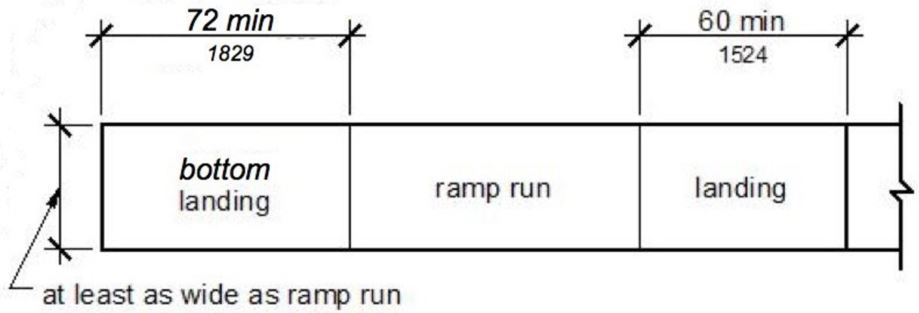
(a) straight
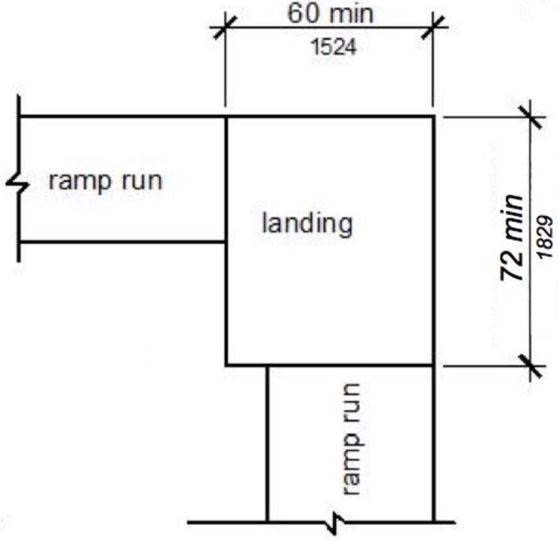
(b) change in direction
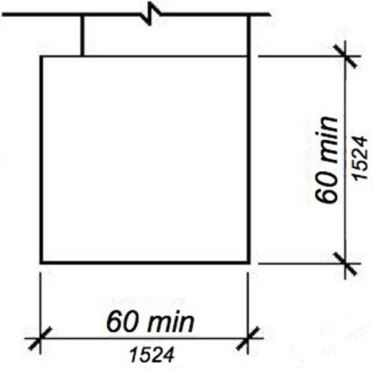
(c) top landing
FIGURE 11B-405.7 RAMP LANDINGS ‡‡
11B-405.7.1 Slope.
Landings shall comply with Section 11B-302. Changes in level, slopes exceeding 1:48, and detectable warnings shall not be permitted.
Exception: Reserved.
11B-405.7.2 Width.
The landing clear width shall be at least as wide as the widest ramp run leading to the landing.
Top landings shall be 60 inches (1524 mm) wide minimum.

11B-405.7.3 Length.
The landing clear length shall be 60 inches (1524 mm) long minimum.
11B-405.7.4 Change in direction.
Ramps that change direction between runs at landings shall have a clear landing 60 inches (1525 mm) minimum by 72 inches (1829 mm) minimum in the direction of downward travel from the upper ramp run.
[2010 ADA Standards] 405.7.4 Change in Direction. Ramps that change direction between runs at landings shall have a clear landing 60 inches (1525 mm) minimum by 60 inches (1525 mm) minimum.
11B-405.7.5 Doorways.
Where doorways are located adjacent to a ramp landing, maneuvering clearances required by Sections 11B-404.2.4 and 11B-404.3.2 shall be permitted to overlap the required landing area. Doors, when fully open, shall not reduce the required ramp landing width by more than 3 inches (76 mm). Doors, in any position, shall not reduce the minimum dimension of the ramp landing to less than 42 inches (1067 mm).
[2010 ADA Standards] 405.7.5 Doorways. Where doorways are located adjacent to a ramp landing, maneuvering clearances required by 404.2.4 and 404.3.2 shall be permitted to overlap the required landing area.

ETA Editor's Note
Since the 2010 ADA Standards makes no distinction between top, bottom, and intermediate landings, CBC is more stringent regarding ramp landings. Also, CBC allows less encroachment of doors onto ramp landings.
11B-405.8 Handrails.
Ramp runs shall have handrails complying with Section 11B-505.
[2010 ADA Standards] 405.8 Handrails. Ramp runs with a rise greater than 6 inches (150 mm) shall have handrails complying with 505.
Exceptions:
- Reserved.
- Reserved.
- Curb ramps do not require handrails.
- At door landings, handrails are not required on ramp runs less than 6 inches (152 mm) in rise or 72 inches (1829 mm) in length.
[2010 ADA Standards] EXCEPTION: Within employee work areas, handrails shall not be required where ramps that are part of common use circulation paths are designed to permit the installation of handrails complying with 505. Ramps not subject to the exception to 405.5 shall be designed to maintain a 36 inch (915 mm) minimum clear width when handrails are installed.
ETA Editor's Note
Since CBC lacks the Exception at employee work areas, and since it requires handrails at short ramps that are not curb ramps, CBC is more stringent regarding ramp handrails than 2010 ADA Standards.
11B-405.9 Edge protection.
Edge protection complying with Section 11B-405.9.2 shall be provided on each side of ramp runs and at each side of ramp landings.
[2010 ADA Standards] 405.9 Edge Protection. Edge protection complying with 405.9.1 or 405.9.2 shall be provided on each side of ramp runs and at each side of ramp landings.
Exceptions:
- Edge protection shall not be required on ramps that are not required to have handrails and have sides complying with Section 11B-406.2.2.
- Edge protection shall not be required on the sides of ramp landings serving an adjoining ramp run or stairway.
- Edge protection shall not be required on the sides of ramp landings having a vertical drop-off of ½ inch (12.7 mm) maximum within 10 inches (254 mm) horizontally of the minimum landing area specified in Section 11B-405.7.
11B-405.9.1 Reserved.
[2010 ADA Standards] 405.9.1 Extended Floor or Ground Surface. The floor or ground surface of the ramp run or landing shall extend 12 inches (305 mm) minimum beyond the inside face of a handrail complying with 505.
[2010 ADA Standards] Advisory 405.9.1 Extended Floor or Ground Surface. The extended surface prevents wheelchair casters and crutch tips from slipping off the ramp surface.
11B-405.9.2 Curb or barrier.
A curb or barrier shall be provided that prevents the passage of a 4-inch (102 mm) diameter sphere, where any portion of the sphere is within 4 inches (102 mm) of the finish floor or ground surface. To prevent wheel entrapment, the curb or barrier shall provide a continuous and uninterrupted barrier along the length of the ramp. [Safe Harbor 11B-405.9.2]
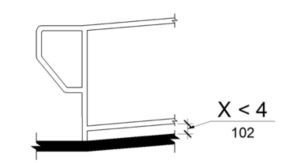
CURB OR BARRIER EDGE PROTECTION
ETA Editor's Note
CBC requires either a curb or a barrier for edge protection at ramps, and does not recognize the extended floor or ground surface also permitted by 2010 ADA Standards.
11B-405.10 Wet conditions.
Landings subject to wet conditions shall be designed to prevent the accumulation of water.
11B-406 Curb ramps, blended transitions and islands
[2010 ADA Standards] 406 Curb Ramps
ETA Editor's Note
11B-406.1 General.
Curb ramps, blended transitions and islands on accessible routes shall comply with Section 11B-406. Curb ramps may be perpendicular, parallel, or a combination of perpendicular and parallel.
[2010 ADA Standards] 406.1 General. Curb ramps on accessible routes shall comply with 406, 405.2 through 405.5, and 405.10.
11B-406.2 Perpendicular curb ramps.
Perpendicular curb ramps shall comply with Sections 11B-406.2 and 11B-406.5.
11B-406.2.1 Slope.
Ramp runs shall have a running slope not steeper than 1:12.
11B-406.2.2 Sides of curb ramps.
Where provided, curb ramp flares shall not be steeper than 1:10.
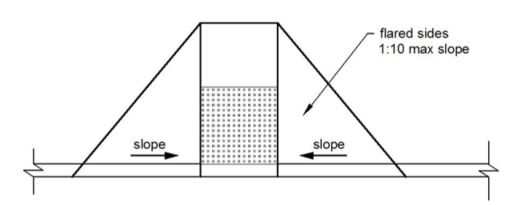
FIGURE 11B-406.2.2 SIDES OF CURB RAMPS ‡‡
11B-406.3 Parallel curb ramps.
Parallel curb ramps shall comply with Sections 11B-406.3 and 11B-406.5. A parallel curb ramp may be provided with one sloping segment or two opposing sloping segments.
11B-406.3.1 Slope.
The running slope of the curb ramp segments shall be in-line with the direction of sidewalk travel. Ramp runs shall have a running slope not steeper than 1:12.
11B-406.3.2 Turning space.
A turning space 48 inches (1219 mm) minimum by 48 inches (1219 mm) minimum shall be provided at the bottom of the curb ramp. The slope of the turning space in all directions shall be 1:48 maximum.
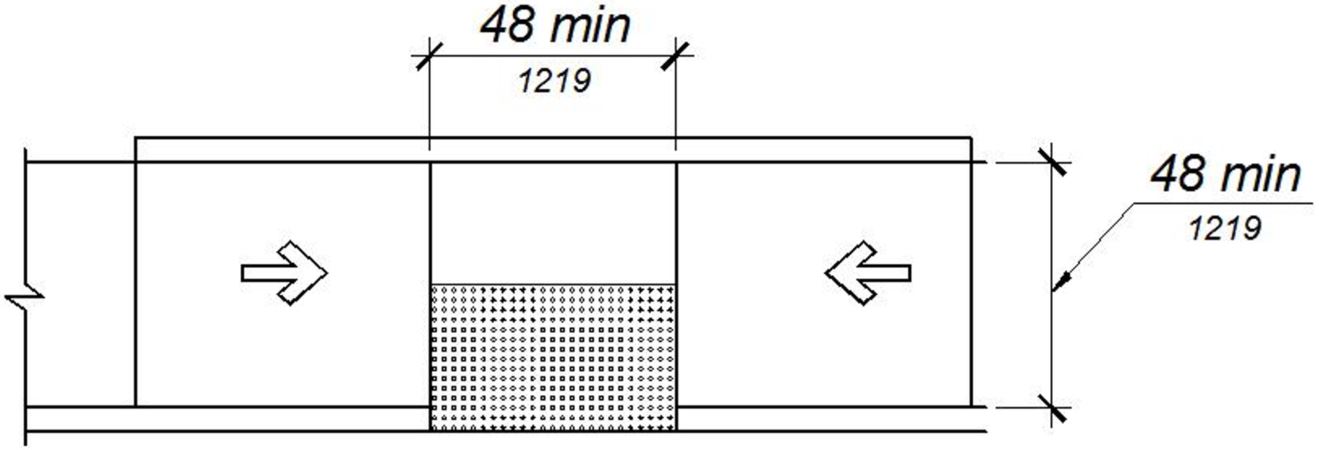
FIGURE 11B-406.3.2 PARALLEL CURB RAMPS ‡‡
11B-406.4 Blended transitions.
Blended transitions shall comply with Sections 11B-406.4 and 11B-406.5.
11B-406.4.1 Slope.
Blended transitions shall have a running slope not steeper than 1:20.
11B-406.5 Common requirements.
Curb ramps and blended transitions shall comply with Section 11B-406.5.
11B-406.5.1 Location.
Curb ramps and the flared sides of curb ramps shall be located so that they do not project into vehicular traffic lanes, parking spaces, or parking access aisles. Curb ramps at marked crossings shall be wholly contained within the markings, excluding any flared sides.
Exception: Diagonal curb ramps shall comply with Section 11B-406.5.9.
11B-406.5.2 Width.
The clear width of curb ramp runs (excluding any flared sides), blended transitions, and turning spaces shall be 48 inches (1219 mm) minimum.
11B-406.5.3 Landings.
Landings shall be provided at the tops of curb ramps and blended transitions. The landing clear length shall be 48 inches (1219 mm) minimum. The landing clear width shall be at least as wide as the curb ramp, excluding any flared sides, or the blended transition leading to the landing. The slope of the landing in all directions shall be 1:48 maximum.
[2010 ADA Standards] 406.4 Landings. Landings shall be provided at the tops of curb ramps. The landing clear length shall be 36 inches (915 mm) minimum. The landing clear width shall be at least as wide as the curb ramp, excluding flared sides, leading to the landing.
Exception: Parallel curb ramps shall not be required to comply with Section 11B-406.5.3.
[2010 ADA Standards] EXCEPTION: In alterations, where there is no landing at the top of curb ramps, curb ramp flares shall be provided and shall not be steeper than 1:12.

Some designs have been proposed that reduce or omit the level top landing by providing a curb ramp with flared sides of 1:12 or less. This design is not compliant with the building code and may result in a condition where a wheelchair user cannot safely turn and proceed along the intersecting walk. Section 11B-403.5.1.1, requires walks and sidewalks to be 48” wide minimum; Section 11B-403.3 requires walks and sidewalks to have a cross-slope of 1:48 or less. In this example, reducing or omitting the top landing of the curb ramp may result in a substandard walk width and/or a walk with a cross-slope in excess of 1:48. ◼
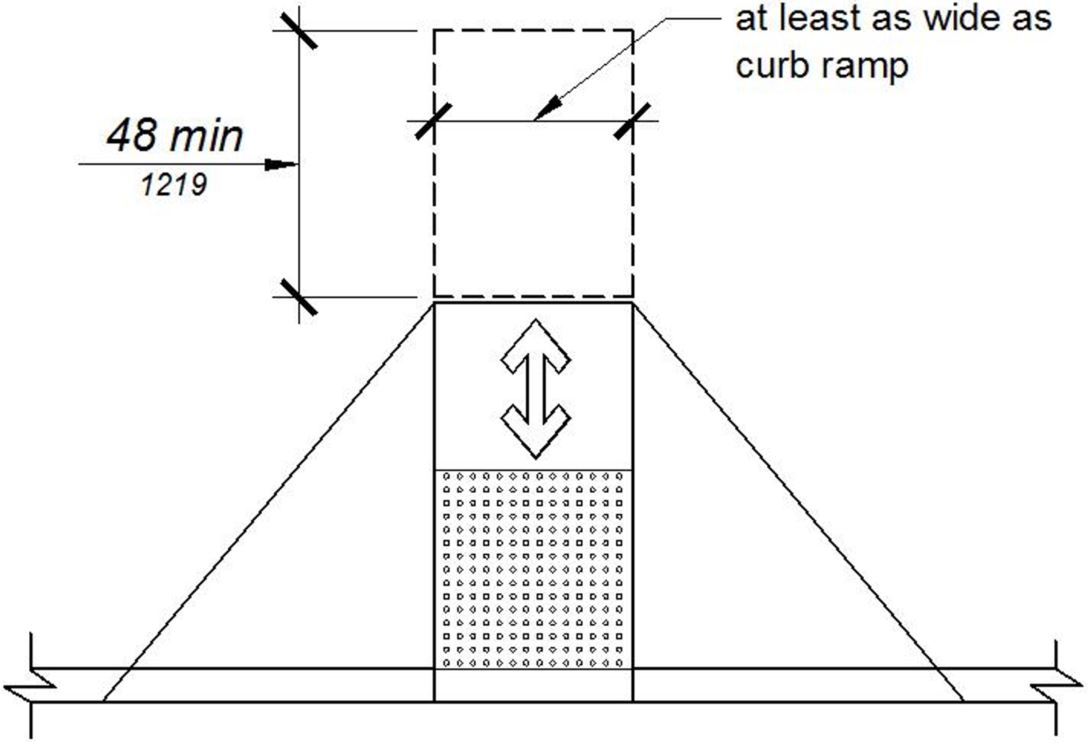
FIGURE 11B-406.5.3 LANDINGS AT THE TOP OF CURB RAMPS ‡‡
11B-406.5.4 Floor or ground surfaces.
Floor or ground surfaces of curb ramps and blended transitions shall comply with Section 11B-405.4.
11B-406.5.5 Wet conditions.
Curb ramps and blended transitions shall comply with Section 11B-405.10.
11B-406.5.6 Grade breaks.
Grade breaks at the top and bottom of curb ramp runs shall be perpendicular to the direction of the ramp run. Grade breaks shall not be permitted on the surface of ramp runs and turning spaces. Surface slopes that meet at grade breaks shall be flush.
11B-406.5.7 Cross slope.
The cross slope of curb ramps and blended transitions shall be 1:48 maximum.
11B-406.5.8 Counter slope.
Counter slopes of adjoining gutters and road surfaces immediately adjacent to and within 24 inches (610 mm) of the curb ramp shall not be steeper than 1:20. The adjacent surfaces at transitions at curb ramps to walks, gutters, and streets shall be at the same level.
[2010 ADA Standards] 406.2 Counter Slope. Counter slopes of adjoining gutters and road surfaces immediately adjacent to the curb ramp shall not be steeper than 1:20. The adjacent surfaces at transitions at curb ramps to walks, gutters, and streets shall be at the same level.

FIGURE 11B-406.5.8 COUNTER SLOPE OF SURFACES ADJACENT TO CURB RAMPS
11B-406.5.9 Clear space at diagonal curb ramps.
The bottom of diagonal curb ramps shall have a clear space 48 inches (1219 mm) minimum outside active traffic lanes of the roadway. Diagonal curb ramps provided at marked crossings shall provide the 48 inches (1219 mm) minimum clear space within the markings.
11B-406.5.10 Diagonal curb ramps.
Diagonal or corner type curb ramps are perpendicular or parallel curb ramps that are oriented diagonally at an intersection. Diagonal or corner type curb ramps with returned curbs or other well-defined edges shall have the edges parallel to the direction of pedestrian flow. Diagonal curb ramps with flared sides shall have a segment of curb 24 inches (610 mm) long minimum located on each side of the curb ramp and within the marked crossing.
[2010 ADA Standards] 406.6 Diagonal Curb Ramps. Diagonal or corner type curb ramps with returned curbs or other well-defined edges shall have the edges parallel to the direction of pedestrian flow. The bottom of diagonal curb ramps shall have a clear space 48 inches (1220 mm) minimum outside active traffic lanes of the roadway. Diagonal curb ramps provided at marked crossings shall provide the 48 inches (1220 mm) minimum clear space within the markings. Diagonal curb ramps with flared sides shall have a segment of curb 24 inches (610 mm) long minimum located on each side of the curb ramp and within the marked crossing.
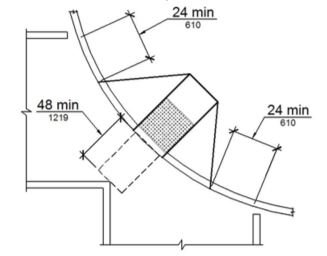
FIGURE 11B-406.5.10 DIAGONAL OR CORNER TYPE CURB RAMPS ‡‡
11B-406.5.12 Detectable warnings
Curb ramps and blended transitions shall have detectable warnings complying with Section 11B-705.
U.S. Access Board's Note to Reader:
The Department of Transportation's ADA Standards require detectable warnings on curb ramps:
[ADA Title II - Public Transportation] 406.8 Detectable Warnings. A curb ramp shall have a detectable warning complying with 705. The detectable warning shall extend the full width of the curb ramp (exclusive of flared sides) and shall extend either the full depth of the curb ramp or 24 inches (610 mm) deep minimum measured from the back of the curb on the ramp surface.
11B-406.6 Islands.
Raised islands in crossings shall be cut through level with the street or have curb ramps at both sides. The clear width of the accessible route at islands shall be 60 inches (1524 mm) wide minimum. Where curb ramps are provided, they shall comply with Section 11B-406. Landings complying with Section 11B-406.5.3 and the accessible route shall be permitted to overlap. Islands shall have detectable warnings complying with Section 11B-705.
[2010 ADA Standards] 406.7 Islands. Raised islands in crossings shall be cut through level with the street or have curb ramps at both sides. Each curb ramp shall have a level area 48 inches (1220 mm) long minimum by 36 inches (915 mm) wide minimum at the top of the curb ramp in the part of the island intersected by the crossings. Each 48 inch (1220 mm) minimum by 36 inch (915 mm) minimum area shall be oriented so that the 48 inch (1220 mm) minimum length is in the direction of the running slope of the curb ramp it serves. The 48 inch (1220 mm) minimum by 36 inch (915 mm) minimum areas and the accessible route shall be permitted to overlap.
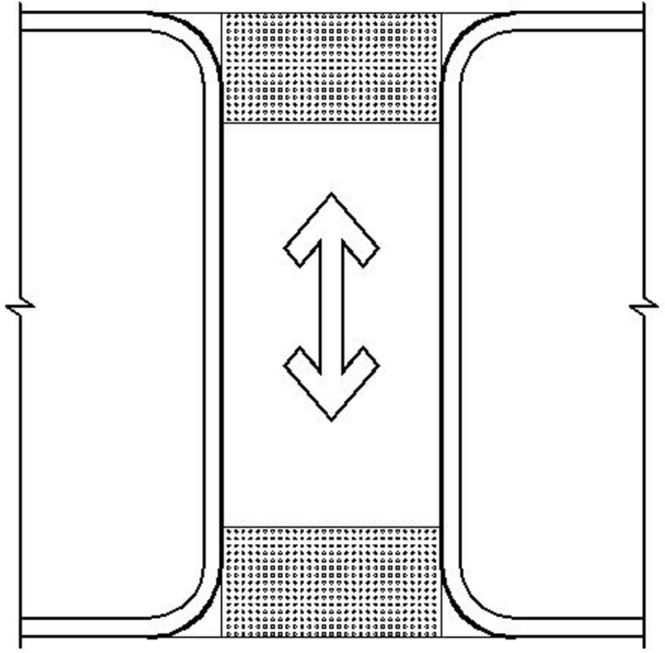
(a) cut through at island
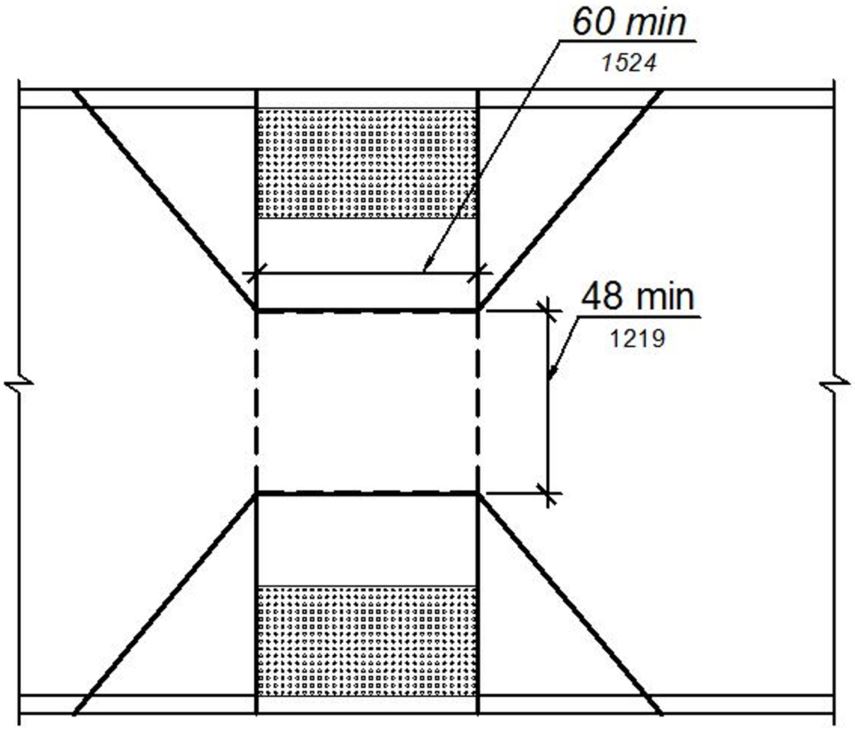
(b) curb ramp at island
FIGURE 11B-406.6 ISLANDS IN CROSSINGS ‡‡
11B-407.1 General.
Elevators shall comply with Section 11B-407 and with ASME A17.1. They shall be passenger elevators as classified by ASME A17.1. Elevator operation shall be automatic.


DSA regulates the usability of elevators and platform (wheelchair) lifts for persons with disabilities. Accessibility scoping requirements for elevators and lifts are located in Sections 11B-206.6 and 11B-206.7; technical requirements are located in Sections 11B-407, 11B-408, 11B-409 and 11B-410. ◼
11B-407.1.1 Combined passenger and freight elevators.
When the only elevators provided for use by the public and employees are combination passenger and freight elevators, they shall comply with Section 11B-407 and with ASME A17.1.
11B-407.2.1 Call controls.
Where elevator call buttons or keypads are provided, they shall comply with Sections 11B-407.2.1 and 11B-309.4.
[2010 ADA Standards] 407.2.1 Call Controls. Where elevator call buttons or keypads are provided, they shall comply with 407.2.1 and 309.4. Call buttons shall be raised or flush.
Exception: Reserved.
[2010 ADA Standards] EXCEPTION: Existing elevators shall be permitted to have recessed call buttons.
Call buttons and keypads shall be located within one of the reach ranges specified in Section 11B-308, measured to the centerline of the highest operable part.
Exception: Reserved.
[2010 ADA Standards] EXCEPTION: Existing call buttons and existing keypads shall be permitted to be located at 54 inches (1370 mm) maximum above the finish floor, measured to the centerline of the highest operable part.
Call buttons shall have square shoulders, be ¾ inch (19.1 mm) minimum in the smallest dimension and shall be raised 1/8 inch (3.2 mm) plus or minus 1/32 inch (0.8 mm) above the surrounding surface. The buttons shall be activated by a mechanical motion that is detectable.
[2010 ADA Standards] 407.2.1.2 Size. Call buttons shall be ¾ inch (19 mm) minimum in the smallest dimension.
Exception: Reserved.
[2010 ADA Standards] EXCEPTION: Existing elevator call buttons shall not be required to comply with 407.2.1.2.
11B-407.2.1.3 Clear floor or ground space.
A clear floor or ground space complying with Section 11B-305 shall be provided at call controls.

The call button that designates the up direction shall be located above the call button that designates the down direction.
Exception: Reserved.
[2010 ADA Standards] 407.2.1.4 Location. Destination-oriented elevators shall not be required to comply with 407.2.1.4.

Call buttons shall have visible signals that will activate when each call is registered and will extinguish when each call is answered. Call buttons shall be internally illuminated with a white light over the entire surface of the button.
[2010 ADA Standards] 407.2.1.5 Signals. Call buttons shall have visible signals to indicate when each call is registered and when each call is answered.
Exceptions:
- Reserved.
- Reserved.
[2010 ADA Standards] 2. Existing elevators shall not be required to comply with 407.2.1.5.
Where keypads are provided, keypads shall be in a standard telephone keypad arrangement and shall comply with Section 11B-407.4.7.2.
ETA Editor's Note
Lacking certain Exceptions allowed by 2010 ADA Standards, and imposing additional requirements regarding call buttons, the preceding CBC requirements pertaining to elevator call controls are more stringent than 2010 ADA Standards.
11B-407.2.2 Hall signals.
Hall signals, including in-car signals, shall comply with Section 11B-407.2.2.
11B-407.2.2.1 Visible and audible signals.
A visible and audible signal shall be provided at each hoistway entrance to indicate which car is answering a call and the car’s direction of travel. Where in-car signals are provided, they shall be visible from the floor area adjacent to the hall call buttons.
Exceptions:
- Reserved.
- Reserved.
[2010 ADA Standards] 2. In existing elevators, a signal indicating the direction of car travel shall not be required.
11B-407.2.2.2 Visible signals.
Visible signal fixtures shall be centered at 72 inches (1829 mm) minimum above the finish floor or ground. The visible signal elements shall be a minimum 2½ inches (64 mm) high by 2½ inches (64 mm) wide. Signals shall be visible from the floor area adjacent to the hall call button.
Exceptions:
- Reserved.
- Reserved.
[2010 ADA Standards] 2. Existing elevators shall not be required to comply with 407.2.2.2.
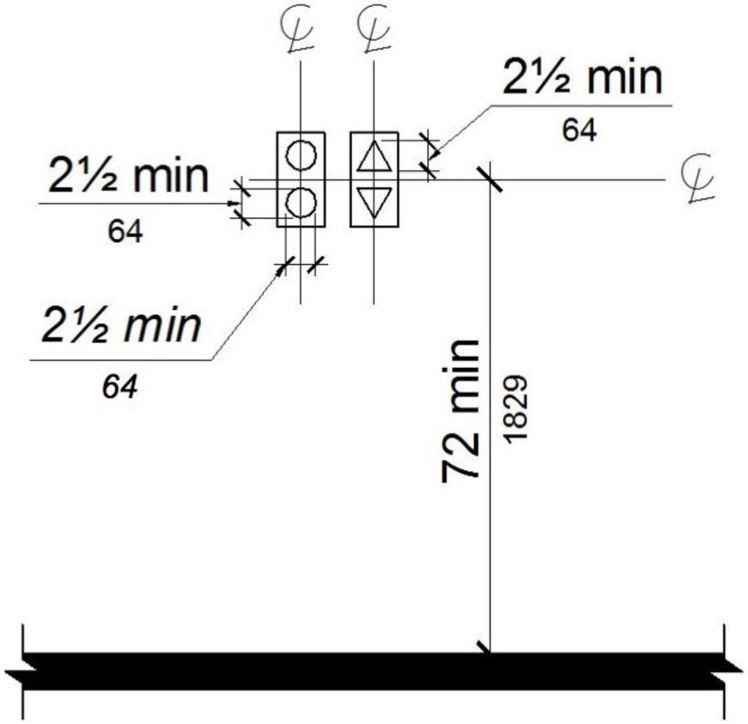
FIGURE 11B-407.2.2.2 VISIBLE HALL SIGNALS ‡‡
11B-407.2.2.3 Audible signals.
Audible signals shall sound once for the up direction and twice for the down direction, or shall have verbal annunciators that indicate the direction of elevator car travel. Audible signals shall have a frequency of 1500 Hz maximum. Verbal annunciators shall have a frequency of 300 Hz minimum and 3000 Hz maximum. The audible signal and verbal annunciator shall be 10 dB minimum above ambient, but shall not exceed 80 dB, measured at the hall call button.
Exceptions:
- Reserved.
- Reserved.
[2010 ADA Standards] 2. Existing elevators shall not be required to comply with the requirements for frequency and dB range of audible signals.
ETA Editor's Note
Lacking certain Exceptions allowed by 2010 ADA Standards, and imposing additional requirements regarding visible signals, the preceding CBC requirements pertaining to elevator hall signals are more stringent than 2010 ADA Standards.
11B-407.2.3 Hoistway signs.
Signs at elevator hoistways shall comply with Section 11B-407.2.3.
11B-407.2.3.1 Floor designation.
Floor designations complying with Sections 11B-703.2 and 11B-703.4.1 shall be provided on both jambs of elevator hoistway entrances. Floor designations shall be provided in both raised characters and Braille. Raised characters shall be 2 inches (51 mm) high. A raised star, placed to the left of the floor designation, shall be provided on both jambs at the main entry level. The outside diameter of the star shall be 2 inches (51 mm) and all points shall be of equal length. Raised characters, including the star, shall be white on a black background. Braille complying with Section 11B-703.3 shall be placed below the corresponding raised characters and the star. The Braille translation for the star shall be “MAIN”. Applied plates are acceptable if they are permanently fixed to the jamb.
[2010 ADA Standards] 407.2.3.1 Floor Designation. Floor designations complying with 703.2 and 703.4.1 shall be provided on both jambs of elevator hoistway entrances. Floor designations shall be provided in both tactile characters and braille. Tactile characters shall be 2 inches (51 mm) high minimum. A tactile star shall be provided on both jambs at the main entry level.
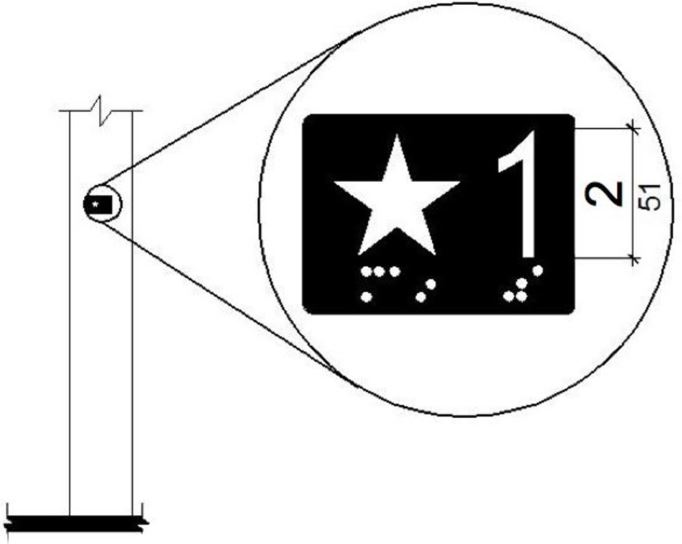
FIGURE 11B-407.2.3.1 FLOOR DESIGNATIONS ON JAMBS OF ELEVATOR HOISTWAY ENTRANCES ‡‡
ETA Editor's Note
Imposing additional requirements regarding characters and colors, the preceding CBC requirements pertaining to elevator hoistway signs are more stringent than 2010 ADA Standards.
11B-407.3 Elevator door requirements.
Hoistway and car doors shall comply with Section 11B-407.3.
11B-407.3.1 Type.
Elevator doors shall be the horizontal sliding type. Car gates shall be prohibited.
11B-407.3.2 Operation.
Elevator hoistway and car doors shall open and close automatically.
Exception: Existing manually operated hoistway swing doors shall be permitted provided that they comply with Sections 11B-404.2.3 and 11B-404.2.9. Car door closing shall not be initiated until the hoistway door is closed.
11B-407.3.3 Reopening device.
Elevator doors shall be provided with a reopening device complying with Section 11B-407.3.3 that shall stop and reopen a car door and hoistway door automatically if the door becomes obstructed by an object or person.
Exception: Existing elevators with manually operated doors shall not be required to comply with Section 11B-407.3.3.
The device shall be activated by sensing an obstruction passing through the opening at 5 inches (127 mm) nominal and 29 inches (737 mm) nominal above the finish floor.
The device shall not require physical contact to be activated, although contact is permitted to occur before the door reverses.
Door reopening devices shall remain effective for 20 seconds minimum.
11B-407.3.4 Door and signal timing.
The minimum acceptable time from notification that a car is answering a call until the doors of that car start to close shall be calculated from the following equation:
T = D/(1.5 ft/s) or T = D/(457 mm/s) = 5 seconds minimum where T equals the total time in seconds and D equals the distance (in feet or millimeters) from the point in the lobby or corridor 60 inches (1524 mm) directly in front of the farthest call button controlling that car to the centerline of its hoistway door.
Exceptions:
- For cars with in-car lanterns, T shall be permitted to begin when the signal is visible from the point 60 inches (1524 mm) directly in front of the farthest hall call button and the audible signal is sounded.
- Reserved.
[2010 ADA Standards] 2. Destination-oriented elevators shall not be required to comply with 407.3.4.
11B-407.3.5 Door delay.
Elevator doors shall remain fully open in response to a car call for 5 seconds minimum.
[2010 ADA Standards] 407.3.5 Door Delay. Elevator doors shall remain fully open in response to a car call for 3 seconds minimum.
11B-407.3.6 Width.
The width of elevator doors shall comply with Table 11B-407.4.1.
Exception: In existing elevators, a power-operated car door complying with Section 11B-404.2.3 shall be permitted.
11B-407.4.1 Car dimensions.
Inside dimensions of elevator cars and clear width of elevator doors shall comply with Table 11B-407.4.1.
Exception: In existing buildings, where existing shaft configuration prohibits strict compliance with Section 11B-407.4.1, existing elevator car configurations that provide a clear floor area of 18 square feet (1.67 m2) minimum and also provide an inside clear depth 54 inches (1372 mm) minimum and a clear width 48 inches (1219 mm) minimum shall be permitted.
[2010 ADA Standards] EXCEPTION: Existing elevator car configurations that provide a clear floor area of 16 square feet (1.5 m2) minimum and also provide an inside clear depth 54 inches (1370 mm) minimum and a clear width 36 inches (915 mm) minimum shall be permitted.
ETA Editor's Note
The CBC Exception at 11B-407.4.1 is more stringent than that of 2010 ADA Standards regarding minimum car dimensions for existing elevators.
TABLE 11B-407.4.1 ELEVATOR CAR DIMENSIONS
|
MINIMUM DIMENSIONS |
||||
|---|---|---|---|---|
|
Door Location |
Door clear width | Inside car, side to side | Inside car, back wall to front return |
Inside car, back wall to inside face of door |
|
Centered |
42 inches (1067 mm) |
80 inches (2032 mm) |
51 inches (1295 mm) |
54 inches (1372 mm) |
|
Side (off-centered) |
36 inches (914 mm)1 |
68 inches (1727 mm) |
51 inches (1295 mm) |
54 inches (1372 mm) |
|
Any |
36 inches (914 mm)1 |
54 inches (1372 mm) |
80 inches (2032 mm) |
80 inches (2032 mm) |
|
Any |
36 inches (914 mm)2 |
60 inches (1524 mm)2 |
60 inches (1524 mm)2 |
60 inches (1524 mm)2 |
|
1. A tolerance of minus 5/8 inch (15.9 mm) is permitted. 2. Other car configurations that provide a turning space complying with Section 11B-304 with the door closed shall be permitted. |
||||
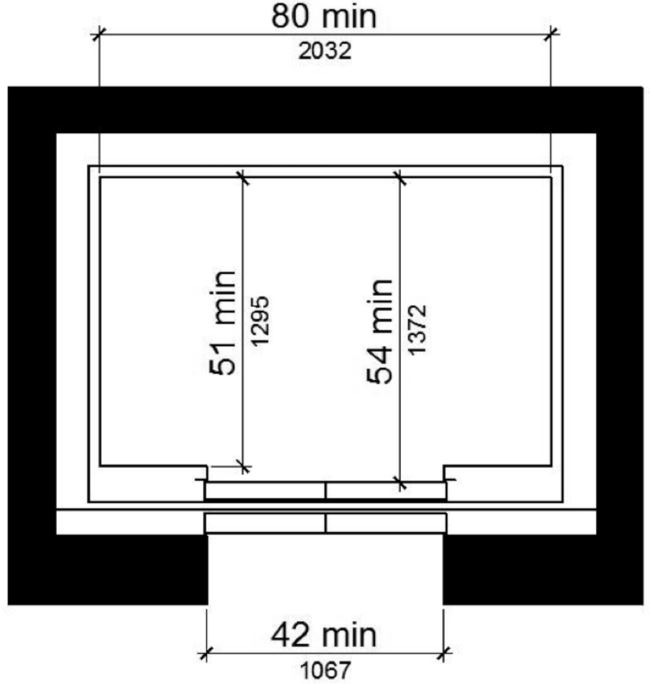
(a) centered door
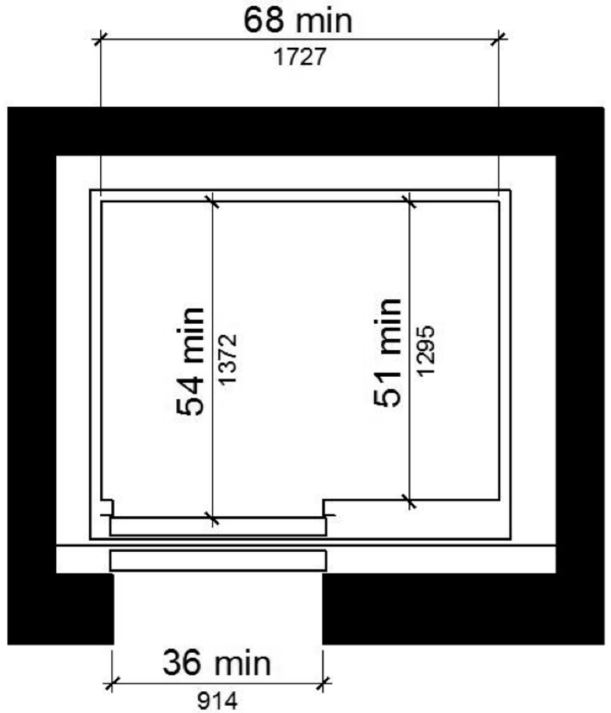
(b) side (off-centered) door
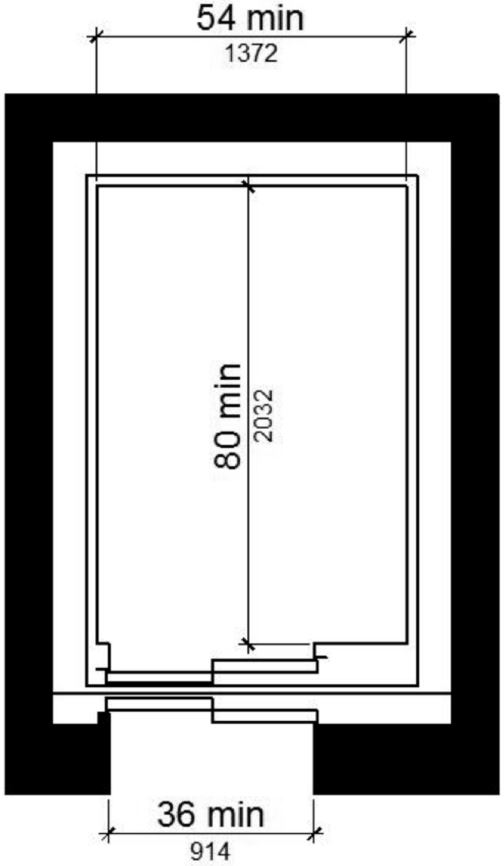
(c) any door location
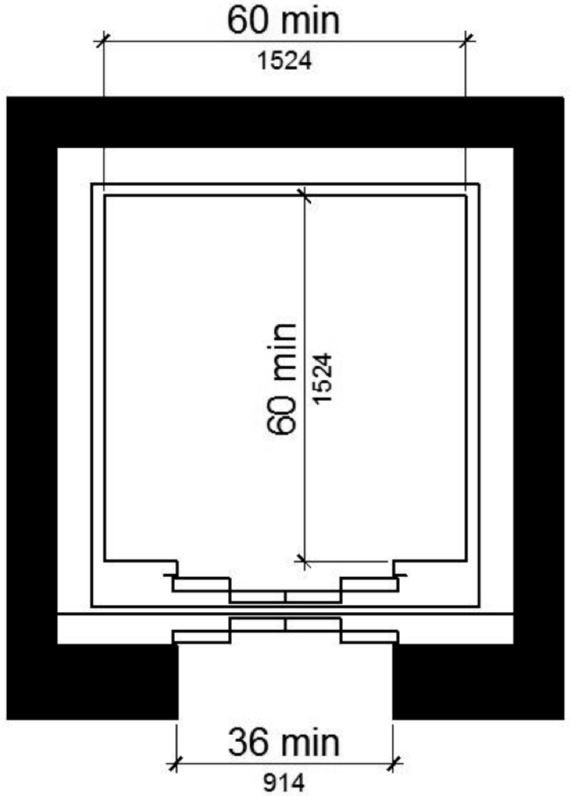
(d) any door location
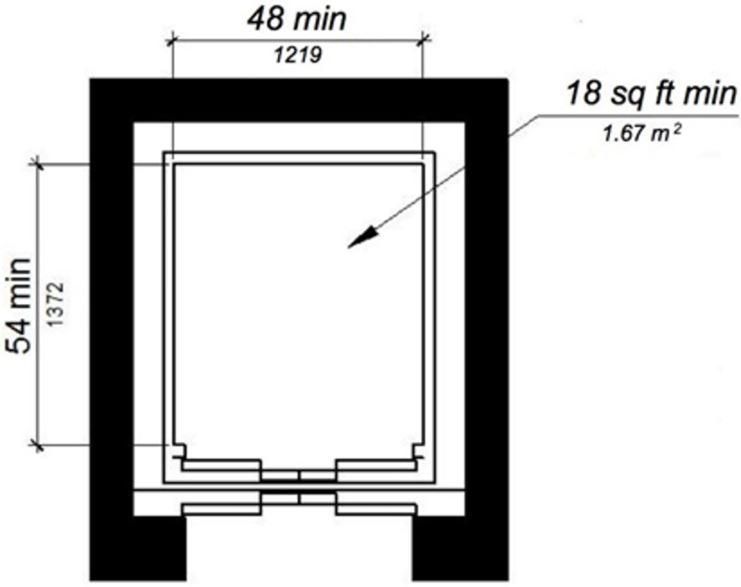
(e) Exception existing elevator car configuration
FIGURE 11B-407.4.1 ELEVATOR CAR DIMENSIONS ‡‡
11B-407.4.2 Floor surfaces.
Floor surfaces in elevator cars shall comply with Section 11B-302 and 11B-303.
11B-407.4.3 Platform to hoistway clearance.
The clearance between the car platform sill and the edge of any hoistway landing shall be 1¼ inch (32 mm) maximum.
11B-407.4.4 Leveling.
Each car shall be equipped with a self-leveling feature that will automatically bring and maintain the car at floor landings within a tolerance of ½ inch (12.7 mm) under rated loading to zero loading conditions.
11B-407.4.5 Illumination.
The level of illumination at the car controls, platform, car threshold and car landing sill shall be 5 foot candles (54 lux) minimum.
11B-407.4.6 Elevator car controls.
Where provided, elevator car controls shall comply with Sections 11B-407.4.6 and 11B-309.4.
Exception: In existing elevators, where a new car operating panel complying with Section 11B-407.4.6 is provided, existing car operating panels may remain operational and shall not be required to comply with Section 11B-407.4.6.
Controls shall be located within one of the reach ranges specified in Section 11B-308.
Exceptions:
- Where the elevator panel serves more than 16 openings and a parallel approach is provided, buttons with floor designations shall be permitted to be 54 inches (1372 mm) maximum above the finish floor.
- In existing elevators, car control buttons with floor designations shall be permitted to be located 54 inches (1372 mm) maximum above the finish floor when a parallel approach is provided.
Car control buttons with floor designations shall comply with Section 11B-407.4.6.2.
Exception: Reserved.
[2010 ADA Standards] EXCEPTION: In existing elevators, buttons shall be permitted to be recessed.
11B-407.4.6.2.1 Size and shape. Buttons shall have square shoulders, be ¾ inch (19.1 mm) minimum in their smallest dimension and be raised 1/8 inch (3.2 mm) plus or minus 1/32 inch (0.8 mm) above the surrounding surface.
[2010 ADA Standards] 407.4.6.2.1 Size. Buttons shall be ¾ inch (19 mm) minimum in their smallest dimension.
Buttons shall be arranged with numbers in ascending order. When two or more columns of buttons are provided they shall read from left to right.
Car control buttons shall be illuminated.
Car control buttons shall be activated by a mechanical motion that is detectable.
Car control keypads shall be in a standard telephone keypad arrangement and shall comply with Section 11B-407.4.7.2.
11B-407.4.6.4 Emergency controls.
Emergency controls shall comply with Section 11B-407.4.6.4.
Emergency control buttons shall have their centerlines 35 inches (889 mm) minimum above the finish floor.
Emergency controls, including the emergency alarm, shall be grouped at the bottom of the panel.
11B-407.4.7 Designations and indicators of car controls.
Designations and indicators of car controls shall comply with Section 11B-407.4.7.
Exception: In existing elevators, where a new car operating panel complying with Section 11B-407.4.7 is provided, existing car operating panels may remain operational and shall not be required to comply with Section 11B-407.4.7.
Car control buttons shall comply with Section 11B-407.4.7.1.
Control buttons shall be identified by raised characters or symbols, white on a black background, complying with Section 11B-703.2 and Braille complying with Section 11B-703.3.
[2010 ADA Standards] 407.4.7.1.1 Type. Control buttons shall be identified by tactile Characters complying with 703.2.
Raised characters or symbols and Braille designations shall be placed immediately to the left of the control button to which the designations apply.
Exception: Reserved.
[2010 ADA Standards] EXCEPTION: Where space on an existing car operating panel precludes tactile markings to the left of the controls, markings shall be placed as near to the control as possible.
The control button for the emergency stop, alarm, door open, door close, main entry floor, and phone, shall be identified with raised symbols and Braille as shown in Table 11B-407.4.7.1.3.
TABLE 11B-407.4.7.1.3 ELEVATOR CONTROL BUTTON IDENTIFICATION
|
Control Button |
Tactile Symbol |
Braille Message |
|
Emergency Stop |
 |
 "ST"OP Three cells |
|
Alarm |
 |
 AL"AR"M Four cells |
|
Door Open |
 |
 OP"EN" Three cells |
|
Door Close |
 |
 CLOSE Five cells |
|
Main Entry Floor |
 |
 MA"IN" Three cells |
|
Phone |
 |
 PH"ONE" Four cells |
11B-407.4.7.1.4 Visible indicators.
Buttons with floor designations shall be provided with visible indicators to show that a call has been registered. The visible indication shall extinguish when the car arrives at the designated floor.
11B-407.4.7.1.5 Button spacing.
A minimum clear space of 3/8 inch (9.5 mm) or other suitable means of separation shall be provided between rows of control buttons.
Keypads shall be identified by characters complying with Section 11B-703.5 and shall be centered on the corresponding keypad button. The number five key shall have a single raised dot. The dot shall be 0.118 inch (3 mm) to 0.120 inch (3.05 mm) base diameter and in other aspects comply with Table 11B-703.3.1.
ETA Editor's Note
The preceding CBC requirements for elevator controls at 11B-407.4.6 and 11B-407.4.7 are more stringent than those of 2010 ADA Standards.
11B-407.4.8 Car position indicators.
Audible and visible car position indicators shall be provided in elevator cars.
11B-407.4.8.1 Visible indicators.
Visible indicators shall comply with Section 11B-407.4.8.1.
Characters shall be ½ inch (12.7 mm) high minimum.
Indicators shall be located above the car control panel or above the door.
11B-407.4.8.1.3 Floor arrival.
As the car passes a floor and when a car stops at a floor served by the elevator, the corresponding character shall illuminate.
Exception: Reserved.
[2010 ADA Standards] EXCEPTION: Destination-oriented elevators shall not be required to comply with 407.4.8.1.3 provided that the visible indicators extinguish when the call has been answered.
[2010 ADA Standards] 407.4.8.1.4 Destination Indicator. In destination-oriented elevators, a display shall be provided in the car with visible indicators to show car destinations.
11B-407.4.8.2 Audible indicators.
Audible indicators shall comply with Section 11B-407.4.8.2.
The signal shall be an automatic verbal annunciator which announces the floor at which the car is about to stop.
Exception: For elevators that have a rated speed of 200 feet per minute (1 m/s) or less, a non-verbal audible signal with a frequency of 1500 Hz maximum which sounds as the car passes or is about to stop at a floor served by the elevator shall be permitted.
The verbal annunciator shall be 10 dB minimum above ambient, but shall not exceed 80 dB, measured at the annunciator.
The verbal annunciator shall have a frequency of 300 Hz minimum to 3000 Hz maximum.
11B-407.4.9 Emergency communication.
Emergency two-way communication systems shall comply with Section 11B-308. Raised symbols or characters, white on a black background, and Braille shall be provided adjacent to the device and shall comply with Sections 11B-703.2 and 11B-703.3. Emergency two-way communication systems between the elevator and a point outside the hoistway shall comply with ASME A17.1.
[2010 ADA Standards] 407.4.9 Emergency Communication. Emergency two-way communication systems shall comply with 308. Tactile symbols and Characters shall be provided adjacent to the device and shall comply with 703.2.
11B-407.4.10 Support rail.
Support rails shall be provided on at least one wall of the car.

There is no requirement for support rails inside elevator cars in 2010 ADA Standards.
Clearance between support rails and adjacent surfaces shall be 1½ inches (38 mm) minimum. Top of support rails shall be 31 inches (787 mm) minimum to 33 inches (838 mm) maximum above the floor of the car. The ends of the support rail shall be 6 inches (152 mm) maximum from adjacent walls.
Support rails shall be smooth and any surface adjacent to them shall be free of sharp or abrasive elements.
11B-407.4.10.3 Structural strength.
Allowable stresses shall not be exceeded for materials used when a vertical or horizontal force of 250 pounds (1112 N) is applied at any point on the support rail, fastener, mounting device, or supporting structure.
11B-408.1 General.
Limited-use/limited-application elevators shall comply with Section 11B-408 and with ASME A17.1. They shall be passenger elevators as classified by ASME A17.1. Elevator operation shall be automatic.

DSA regulates the usability of elevators and platform (wheelchair) lifts for persons with disabilities. Accessibility scoping requirements for elevators and lifts are located in Sections 11B-206.6 and 11B-207.6 [sic]; technical requirements are located in Sections 11B-407, 11B-408, 11B-409 and 11B-410. ◼
11B-408.2 Elevator landings.
Landings serving limited-use/limited-application elevators shall comply with Section 11B-408.2.
11B-408.2.1 Call buttons.
Elevator call buttons and keypads shall comply with Section 11B-407.2.1.
11B-408.2.2 Hall signals.
Hall signals shall comply with Section 11B-407.2.2.
11B-408.3 Elevator doors.
Elevator hoistway doors shall comply with Section 11B-408.3.
11B-408.3.1 Sliding doors.
Sliding hoistway and car doors shall comply with Sections 11B-407.3.1 through 11B-407.3.3 and 11B-408.4.1.
11B-408.3.2 Swinging doors.
Swinging hoistway doors shall open and close automatically and shall comply with Sections 11B-404, 11B-407.3.2 and 11B-408.3.2.
11B-408.3.2.1 Power operation.
Swinging doors shall be power-operated and shall comply with ANSI/BHMA A156.19.
Power-operated swinging doors shall remain open for 20 seconds minimum when activated.
11B-408.4.1 Car dimensions and doors.
Elevator cars shall provide a clear width 42 inches (1067 mm) minimum and a clear depth 54 inches (1372 mm) minimum. Car doors shall be positioned at the narrow ends of cars and shall provide 32 inches (813 mm) minimum clear width.
Exceptions:
- Cars that provide a clear width 51 inches (1295 mm) minimum shall be permitted to provide a clear depth 51 inches (1295 mm) minimum provided that car doors provide a clear opening 36 inches (914 mm) wide minimum.
- Reserved.
[2010 ADA Standards] 2. Existing elevator cars shall be permitted to provide a clear width 36 inches (915 mm) minimum, clear depth 54 inches (1370 mm) minimum, and a net clear platform area 15 square feet minimum.
ETA Editor's Note
Lacking Exception 2 above allowed by 2010 ADA Standards, the CBC requirements pertaining to car dimensions at existing limited-use/limited-application elevators are more stringent.
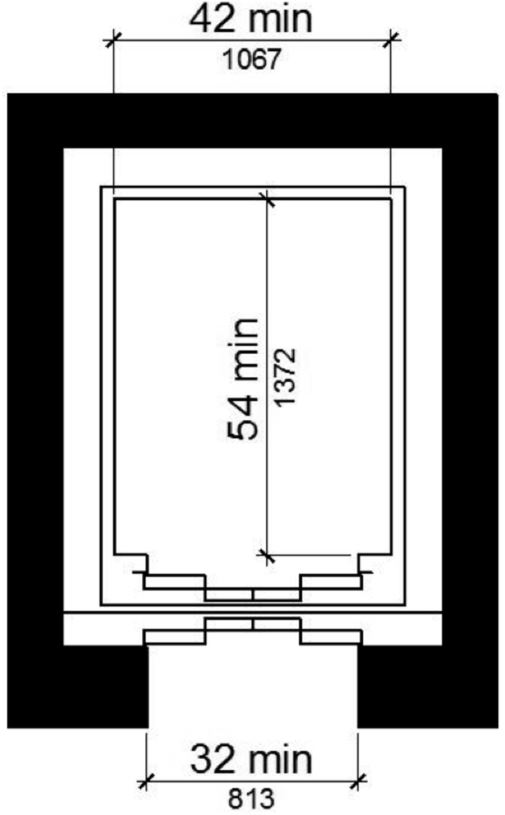
(a) new construction
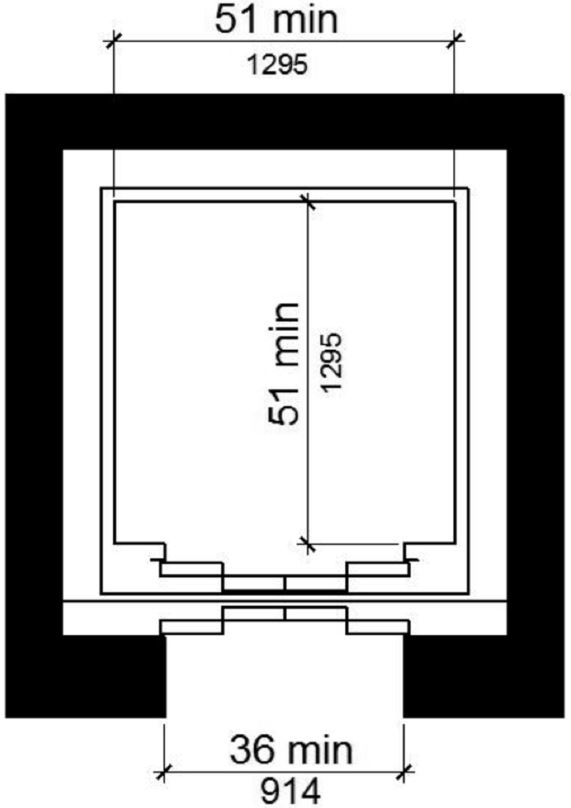
(b) Exception 1
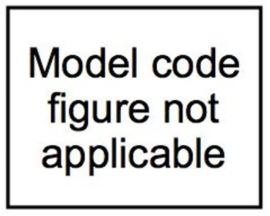
(c) reserved
FIGURE 11B-408.4.1 LIMITED-USE/LIMITED-APPLICATION (LULA) ELEVATOR CAR DIMENSIONS ‡‡
11B-408.4.2 Floor surfaces.
Floor surfaces in elevator cars shall comply with Sections 11B-302 and 11B-303.
11B-408.4.3 Platform to hoistway clearance.
The platform to hoistway clearance shall comply with Section 11B-407.4.3.
11B-408.4.4 Leveling.
Elevator car leveling shall comply with Section 11B-407.4.4.
11B-408.4.5 Illumination.
Elevator car illumination shall comply with Section 11B-407.4.5.
11B-408.4.6 Car controls.
Elevator car controls shall comply with Section 11B-407.4.6. Control panels shall be centered on a side wall.
11B-408.4.7 Designations and indicators of car controls.
Designations and indicators of car controls shall comply with Section 11B-407.4.7.
11B-408.4.8 Emergency communications.
Car emergency signaling devices complying with Section 11B-407.4.9 shall be provided.
11B-409.1 General.
Private residence elevators that are provided within a residential dwelling unit required to provide mobility features complying with Sections 11B-809.2 through 11B-809.4 shall comply with Section 11B-409 and with ASME A17.1. They shall be passenger elevators as classified by ASME A17.1. Elevator operation shall be automatic.

DSA regulates the usability of elevators and platform (wheelchair) lifts for persons with disabilities. Accessibility scoping requirements for elevators and lifts are located in Sections 11B-206.6 and 11B-207.6 [sic]; technical requirements are located in Sections 11B-407, 11B-408, 11B-409 and 11B-410. ◼
11B-409.2 Call buttons.
Call buttons shall be ¾ inch (19.1 mm) minimum in the smallest dimension and shall comply with Section 11B-309.
11B-409.3 Elevator doors.
Hoistway doors, car doors, and car gates shall comply with Sections 11B-409.3 and 11B-404.
Exception: Doors shall not be required to comply with the maneuvering clearance requirements in Section 11B-404.2.4.1 for approaches to the push side of swinging doors.
11B-409.3.1 Power operation.
Elevator car and hoistway doors and gates shall be power operated and shall comply with ANSI/BHMA A156.19. Power operated doors and gates shall remain open for 20 seconds minimum when activated.
Exception: In elevator cars with more than one opening, hoistway doors and gates shall be permitted to be of the manual-open, self-close type.
11B-409.3.2 Location.
Elevator car doors or gates shall be positioned at the narrow end of the clear floor spaces required by Section 11B-409.4.1.
11B-409.4 Elevator cars.
Private residence elevator cars shall comply with Section 11B-409.4.
11B-409.4.1 Inside dimensions of elevator cars.
Elevator cars shall provide a clear floor space of 36 inches (914 mm) minimum by 48 inches (1219 mm) minimum and shall comply with Section 11B-305.
11B-409.4.2 Floor surfaces.
Floor surfaces in elevator cars shall comply with Sections 11B-302 and 11B-303.
11B-409.4.3 Platform to hoistway clearance.
The clearance between the car platform and the edge of any landing sill shall be 1½ inch (38 mm) maximum.
11B-409.4.4 Leveling.
Each car shall automatically stop at a floor landing within a tolerance of ½ inch (12.7 mm) under rated loading to zero loading conditions.
11B-409.4.5 Illumination levels.
Elevator car illumination shall comply with Section 11B-407.4.5.
11B-409.4.6 Car controls.
Elevator car control buttons shall comply with Sections 11B-409.4.6, 11B-309.3, 11B-309.4, and shall be raised or flush.
Control buttons shall be ¾ inch (19.1 mm) minimum in their smallest dimension.
Control panels shall be on a side wall, 12 inches (305 mm) minimum from any adjacent wall.
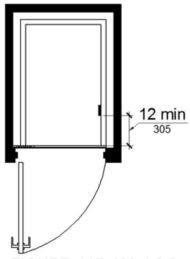
FIGURE 11B-409.4.6.2 LOCATION OF PRIVATE RESIDENCE ELEVATOR CONTROL PANEL
11B-409.4.7 Emergency communications.
Emergency two-way communication systems shall comply with Section 11B-409.4.7.
A telephone and emergency signal device shall be provided in the car.
The telephone and emergency signaling device shall comply with Sections 11B-309.3 and 11B-309.4.
If the telephone or device is in a closed compartment, the compartment door hardware shall comply with Section 11B-309.
The telephone cord shall be 29 inches (737 mm) long minimum.
11B-410.1 General.
Platform lifts shall comply with ASME A18.1. Platform lifts shall not be attendant-operated and shall provide unassisted entry and exit from the lift.

The ADA and other Federal civil rights laws require that accessible features be maintained in working order so that they are accessible to and usable by those people they are intended to benefit. Building owners are reminded that the ASME A18 Safety Standard for Platform Lifts and Stairway Chairlifts requires routine maintenance and inspections. Isolated or temporary interruptions in service due to maintenance or repairs may be unavoidable; however, failure to take prompt action to effect repairs could constitute a violation of Federal laws and these requirements. ◼

DSA regulates the usability of elevators and platform (wheelchair) lifts for persons with disabilities. Accessibility scoping requirements for elevators and lifts are located in Sections 11B-206.6 and 11B-206.7; technical requirements are located in Sections 11B-407, 11B-408, 11B-409 and 11B-410. ◼
11B-410.2 Floor surfaces.
Floor surfaces in platform lifts shall comply with Sections 11B-302 and 11B-303.
11B-410.4 Platform to runway clearance.
The clearance between the platform sill and the edge of any runway landing shall be 1¼ inch (32 mm) maximum.
11B-410.5 Operable parts.
Controls for platform lifts shall comply with Section 11B-309.
11B-410.6 Doors and gates.
Platform lifts shall have low-energy power-operated doors or gates complying with Section 11B-404.3. Doors shall remain open for 20 seconds minimum. End doors and gates shall provide a clear width 32 inches (813 mm) minimum. Side doors and gates shall provide a clear width 42 inches (1067 mm) minimum.
Exception: Platform lifts serving two landings maximum and having doors or gates on opposite sides shall be permitted to have self-closing manual doors or gates.
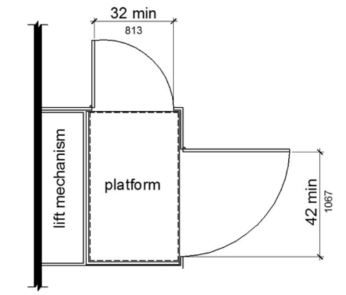
FIGURE 11B-410.6 PLATFORM LIFT DOORS AND GATES
11B-410.7 Landing size.
The minimum size of landings at platform lifts shall be 60 inches by 60 inches (1524 mm by 1524 mm).
ETA Editor's Note
There are no requirements for landing size in 2010 ADA Standards, although the door maneuvering clearance requirements at 404.2.4 should be applicable outside the platform.
11B-410.8 Restriction sign.
A sign complying with Section 11B-703.5 shall be posted in a conspicuous place at each landing and within the platform, enclosure stating “No Freight” and include the International Symbol of Accessibility complying with Section 11B-703.7.2.1.

CCR, Title 8, Section 3094 provides safety regulations for Vertical Platform (Wheelchair) Lifts. This section includes requirements which address platform size and gate configurations for lifts with 90-degree egress, and additionally requires signs posted at the landings as follows:
- International Symbol of Accessibility,
- lift capacity,
- the telephone number to call in case of emergency, and
- the lift shall not be used to transport materials or equipment. ◼

In addition to the accessibility requirements of the building code, Vertical Platform (Wheelchair) Lifts are required to comply with the applicable provisions of the Elevator Code, CCR, Title 8, Section 3142.1, which provides safety regulations for lifts. This section incorporates ASME A18.1-2003, sections 2 and 5 by reference, and requires compliance with CCR, Title 8, Sections 3094.2(d), 3094.2(e), 2094.2(g), and 3094.2(p).
These regulations address technical requirements for lifts, including platform size, gate configurations for lifts with 90-degree egress, and required signage as follows:
- lift capacity, and
- “No Freight” prohibiting the transport of materials or equipment. ◼
11B-411.1 General.
Destination-oriented elevators shall comply with Section 11B-411 and with ASME A17.1. They shall be passenger elevators as classified by ASME A17.1. Elevator operation shall be automatic.
11B-411.1.1 Floor designations.
In facilities served by destination-oriented elevator systems, floor designations shall be numeric characters only. Floor designations shall be "one" (1) or "zero" (0) at the main entry level and shall increase by one for each successive higher story or level. The initial floor below the main entry level shall be designated “minus one” (-1) and the designation for each successive lower story or level shall decrease by one. Stories or levels shall not be designated by alphabetic characters.
Exceptions:
- In existing facilities where new elevators are installed or existing elevators are altered into a destination-oriented elevator system, levels within stories, such as mezzanines located above or below the main entry level shall be permitted to be designated with an alpha-numeric character such as "M2", indicating "mezzanine" and the "story number", respectively, in which it is located, provided there is no duplication with alphanumeric designations of elevator cars in the facility.
- Non-successive floor numbering shall be permitted where a specific floor number is omitted or where a floor is frequented only by service personnel for maintenance, repair or occasional monitoring of equipment.
11B-411.1.2 Car designations.
Elevator cars shall be designated with a single alphabetic character. For elevators programmed to the same hall call console or group of hall call consoles, each elevator car shall be designated with a different single alphabetic character.
Exception: Elevator systems with more than 26 elevators shall be permitted to use alpha-numeric designations such as “A1”.
11B-411.2.1 Hall call consoles.
Hall call consoles shall comply with Sections 11B-411.2.1 and 11B-309.
Hall call consoles shall be wall-mounted. On floors with a building entry, including parking and transfer levels, each hoistway entrance shall be adjacent to a hall call console. On other floors, a minimum of one hoistway entrance shall be adjacent to a hall call console.
Exception: Hall call consoles beyond those required by Section 11B-411.2.1.1 shall be permitted to be provided outside the elevator landing and to be wall-mounted, pedestal-mounted, or mounted on a kiosk or security turnstile.
11B-411.2.1.2 Required features.
Hall call consoles shall include a touch screen or keypad with display screen, an accessibility function button, and audio output loudspeaker.
Keypads shall be in a 12-key ascending telephone keypad layout. Characters and symbols shall be centered on the corresponding button. The number five key shall have a single raised dot. The dot shall have a base diameter of 0.118 inch (3 mm) minimum and 0.120 inch (3.05 mm) maximum and a height of 0.025 inch (0.6 mm) minimum and 0.037 inch (0.9 mm) maximum. Keypads shall have a star («) on the lower left button and a minus sign (-) on the lower right button. From any level above and below the main egress level, when the star button is pressed an elevator shall be dispatched to the main egress level.
Touch screen display shall comply with Section 11B-411.2.1.2.4.
11B-411.2.1.2.3 Accessibility function button.
The accessibility function button shall be identified by the International Symbol of Accessibility and a raised indication. The International Symbol of Accessibility shall comply with Section 11B-703.7.2.1, and shall be 5/8 inch (15.9 mm) minimum in height. The indication shall be three raised dots. Each dot shall have a base diameter of 0.059 inch (1.5 mm) minimum and 0.063 inch (1.6 mm) maximum and a height of 0.025 inch (0.6 mm) minimum and 0.037 inch (0.9 mm) maximum. The dots shall be spaced ¼ inch (6.4 mm), measured center to center, in the form of an equilateral triangle with a vertex pointing up. The accessibility function button shall not be provided with a key repeat function.
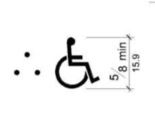
Visual and Raised Information
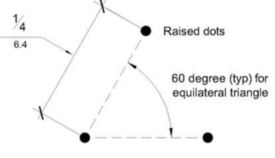
Visual and Raised Information
FIGURE 11B-411.2.1.2.3 DESTINATION-ORIENTED ELEVATOR ACCESSIBILITY FUNCTION BUTTON INDICATION
11B-411.2.1.2.4 Display screen.
Upon activation of the accessibility function button, the display screen shall display information including but not limited to, operating instructions, user input confirmation, elevator assignment characters, direction to the assigned elevator, and error messages. The display screen shall comply with Section 11B-411.2.1.2.4.
Display screens shall provide contrast with light characters and symbols on a dark background or dark characters and symbols on a light background. The background shall be solid and static.
Elevator assignment characters shall be 1 inch high (25 mm) minimum.
Elevator assignment characters shall be displayed for a minimum of 5 seconds.
Upon activation of the accessibility function button, the audio output shall provide verbal announcements, including but not limited to, operating instructions, user input confirmation, announcement of the elevator assignment characters, direction to the assigned elevator, and error messages. Audio output shall be recorded or digitized human speech, and shall be delivered through a loudspeaker. Auditory volume shall be at least 10 dB above ambient sound level, but shall not exceed 80 dB, measured 36 inches (914 mm) in front of the console. At hall call console locations where the ambient sound level varies, auditory volume shall be maintained at the required volume by an automatic gain control or shall be set at not less than 75 dB.
Hall call console arrangement of required features shall comply with Section 11B-411.2.1.3.
11B-411.2.1.3.1 Keypad call console arrangement.
Where keypad call consoles are provided, the display screen shall be located directly above the keypad. The accessibility function button shall be located directly below the keypad at a height of 36 inches (914 mm) to 42 inches (1067 mm) above the finish floor.
11B-411.2.1.3.2 Touch screen call console arrangement.
Where touch screen call consoles are provided, the touch screen shall be located directly above the accessibility function button. The accessibility function button shall be located at a height of 36 inches (914 mm) to 42 inches (1067 mm) above the finish floor.
11B-411.2.1.3.3 Proximity of required elements.
Required features shall be provided on a hall call console assembly or as individual elements grouped in close proximity.
Display screens and touch screens shall be positioned so glare is reduced on the screen. Keypads or buttons shall slope away from the user at 15 to 25 degrees from the vertical plane. Touch screens shall be sloped away from the user at 7 to 25 degrees from the vertical plane.
11B-411.2.1.4 Additional features.
Hall call console additional features, if provided, shall comply with Sections 11B-309 and 11B-411.2.1.4.
11B-411.2.1.4.1 Hall call console additional buttons.
Hall call console buttons provided in addition to the accessibility function button and keypad buttons shall comply with Section 11B-411.2.1.4.1. Buttons in addition to the accessibility function button are not permitted on hall call consoles using a touch screen.
11B-411.2.1.4.1.1 Arrangement.
Buttons shall be arranged in columns to the right of the keypad with a minimum horizontal spacing of 1.5 times the horizontal spacing between the numeric keys and with the same vertical spacing as the numeric keys.
11B-411.2.1.4.1.2 Identification.
Buttons shall be identified by raised characters and symbols, white on a black background, complying with Section 11B-703.2 and Braille complying with Section 11B-703.3. Identification shall be placed immediately to the left of the control button to which the designation applies.
11B-411.2.1.4.2 Security or access controls.
Security or access control system card readers associated with elevator operation shall be in close proximity to each hall call console in a consistent manner throughout the facility.
11B-411.2.1.5 Button requirements.
Keypad buttons, the accessibility function button, and additional hall call console buttons shall comply with Section 11B-411.2.1.5.
Buttons shall have square shoulders, be 3/4 inch (19.1 mm) minimum in the smallest dimension and shall be raised 1/8 inch (3.2 mm) plus or minus 1/32 inch (0.8 mm) above the surrounding surface. The buttons shall be activated by a mechanical motion that is detectable.
Characters and symbols on buttons, where provided, shall be white on a black background.
11B-411.2.1.6 Identification of floors served.
In buildings with two or more elevator banks, each serving a different group of specific floors, hall call consoles located on floors with a building entry, including parking and transfer levels, shall be provided with signs complying with Sections 11B-703.2, 11B-703.3, and 11B-703.5 on the surface of or above the hall call console stating “FLOORS n1 – n2”, where n1 - n2 represents the range of floors served. Characters shall be white on a black background. When the accessibility function button is pressed, the audio output shall provide a verbal announcement of the floors served by the elevator group.
11B-411.2.1.7 Elevator car assignment.
When the accessibility function button is pressed, elevator car assignment shall comply with Section 11B-411.2.1.7.
11B-411.2.1.7.1 Assignment by keypad hall call console.
The audio output shall provide verbal instruction for the user to enter a destination floor. The selected destination floor shall be confirmed by verbal announcement and on the display screen. Verbal and visible indication of an invalid input shall be provided. The display screen shall indicate the elevator assignment characters and a verbal announcement shall be made of the assigned elevator responding to the call. Visual and verbal direction to the assigned elevator shall be provided.
11B-411.2.1.7.2 Assignment by touch screen hall call console.
The audio output shall provide verbal instruction for the user to press the accessibility function button as a response to verbal direction in order to select the destination floor. The selected destination floor shall be confirmed by verbal announcement and on the display screen. Verbal and visible indication of an invalid input shall be provided. The display screen shall indicate the elevator assignment characters and a verbal announcement shall be made of the assigned elevator responding to the call. Visual and verbal direction to the assigned elevator shall be provided.
Exception: In addition to assignment by Section 11B-411.2.1.7.2, a verbal announcement providing the user with an option to select an alternative mode of operation shall be permitted. Alternative operation shall be by one of the following options:
-
Virtual keypad. The size of the keypad shall be a nominal 4 inches (102 mm) wide by 5 inches (127 mm) high in a 12-key ascending telephone keypad layout centered in the console. Characters and symbols shall be centered on the corresponding button. Keypads shall have a star («) on the lower left button and a minus sign (-) on the lower right button. Operation shall be by contact with the touch screen with a press on the key. The audio output shall provide user input confirmation after each key is pressed. Keys shall not be provided with a key repeat function. From any level above and below the main egress level, when the star button is pressed an elevator shall be dispatched to the main egress level.
-
Gesture-based mode of operation. Operation shall be by contact with the touch screen, without specific contact with an icon, and using established non-proprietary gestures for selection and input, including but not limited to tapping, sliding, and tap-hold contact-release to select. The audio output shall provide verbal direction on use of the touch screen, and indication of floor selection options until assignment to the elevator is given.
11B-411.2.1.7.3 Assignment by security credential.
If a security system or other form of access control system is provided, the audio output shall provide a verbal announcement and direction to the location of the access control activation sensor, such as “present security credential at the sensor immediately to the left”. Upon presentation of security credential, the destination floor shall be confirmed by verbal announcement and on the display screen. The display screen shall indicate the elevator assignment characters and a verbal announcement shall be made of the assigned elevator responding to the call. Visual and verbal direction to the assigned elevator shall be provided.
11B-411.2.1.7.4 Adjacency assignment.
The system shall assign an elevator car immediately to the left or right of the hall call console.
Exception: The most adjacent elevator serving the selected floor shall be assigned by hall call consoles located outside the elevator landing.
11B-411.2.2 Elevator car identification at elevator landings.
Elevator car identification shall comply with Section 11B-411.2.2.
11B-411.2.2.1 Visible identification.
Above or adjacent to each elevator car entrance there shall be a visible identification fixture with a car designation character. The identification fixture shall be 80 inches (2032 mm) minimum above the finish floor or ground to the bottom of the fixture. The characters on the fixture shall be upper case with a height of 4 inches (102 mm) minimum complying with Sections 11B-703.5.1, 11B-703.5.3, 11B-703.5.4, 11B-703.5.7 and 11B-703.5.8.
Exception: Existing buildings shall be permitted to have a visible identification fixture with a car designation character adjacent to each elevator car entrance centered at 72 inches (1829 mm) above the finish floor or ground. The character on the fixture shall be upper case with a height of 2 1/2 inches (64 mm) minimum complying with Sections 11B-703.5.1, 11B-703.5.3, 11B-703.5.4, 11B-703.5.7 and 11B-703.5.8.
11B-411.2.2.2 Verbal identification.
When the accessibility function button is pressed, verbal announcement of the car designation shall be provided at the elevator car entrance upon arrival. Audio output shall be recorded or digitized human speech, and shall be delivered through a loudspeaker. The verbal annunciator shall have a frequency of 300 Hz minimum and 3000 Hz maximum. Auditory volume shall be at least 10 dB above ambient sound level, but shall not exceed 80 dB, measured 36 inches (914 mm) in front of the elevator entrance and at 48 inches (1219 mm) above the floor. At elevator entrances where the ambient sound level varies, auditory volume shall be maintained at the required volume by an automatic gain control or shall be set at not less than 75 dB.
11B-411.2.3 Signs on jambs of elevator hoistway entrances.
Signs on jambs of elevator hoistway entrances shall comply with Section 11B-411.2.3.
11B-411.2.3.1 Floor designation signs.
Floor designation signs complying with Sections 11B-703.2 and 11B-703.4.1 shall be provided on both jambs of elevator hoistway entrances. Signs shall be provided in both raised characters and Braille. Raised characters shall be 2 inches (51 mm) high. A raised star placed to the left of the floor designation, shall be provided on both jambs at the main entry level. The outside diameter of the star shall be 2 inches (51 mm) and all points shall be of equal length. Raised characters, including the star, shall be white on a black background. Braille complying with Section 11B-703.3 shall be placed below the corresponding raised characters and the star. The Braille translation for the star shall be “MAIN”. Applied plates are acceptable if they are permanently fixed to the jamb.
11B-411.2.3.2 Car designation signs.
Car designation signs complying with Sections 11B-703.2 and 11B-703.4.1 shall be provided on both jambs of the hoistway immediately below the floor designation. Signs shall be provided in both raised characters and Braille. Raised characters shall be 2 inches (51 mm) high. Raised characters shall be white on a black background. Braille complying with Section 11B-703.3 shall be placed below the corresponding raised characters. Applied plates are acceptable if they are permanently fixed to the jamb.
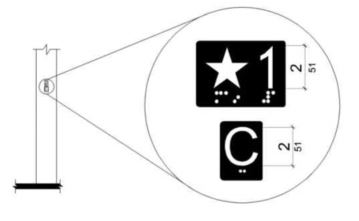
FIGURE 11B-411.2.3 FLOOR DESIGNATION AND CAR DESIGNATION SIGNS ON JAMBS OF DESTINATION-ORIENTED ELEVATOR HOISTWAY ENTRANCES
11B-411.3 Elevator door requirements.
Hoistway and car doors shall comply with Section 11B-411.3.
11B-411.3.1 Type.
Elevator door type shall comply with Section 11B-407.3.1.
11B-411.3.2 Operation.
Elevator hoistway and car doors shall open and close automatically.
11B-411.3.3 Reopening device.
Elevator doors shall be provided with a reopening device complying with Section 11B-411.3.3 that shall stop and reopen a car door and hoistway door automatically if the door becomes obstructed by an object or person.
The height of the reopening device shall comply with Section 11B-407.3.3.1.
The device contact shall comply with Section 11B-407.3.3.2.
The door reopening device duration shall comply with Section 11B-407.3.3.3.
11B-411.3.4 Door delay.
Door delay shall comply with Section 11B-407.3.5.
11B-411.3.5 Width.
The width of elevator doors shall comply with Table 11B-407.4.1.
11B-411.4.1 Car dimensions.
Inside dimensions of elevator cars and clear width of elevator doors shall comply with Section 11B-407.4.1.
11B-411.4.2 Floor surfaces.
Floor surfaces in elevator cars shall comply with Section 11B-407.4.2.
11B-411.4.3 Platform to hoistway clearance.
Platform to hoistway clearance shall comply with Section 11B-407.4.3.
11B-411.4.4 Leveling.
Elevator car leveling shall comply with Section 11B-407.4.4.
11B-411.4.5 Illumination.
The level of illumination at the car controls shall comply with Section 11B-407.4.5.
11B-411.4.6 Elevator car controls.
Where provided, elevator car controls shall comply with Sections 11B-411.4.6 and 11B-309.4.
Controls shall be located within one of the reach ranges specified in Section 11B-308.
Car control buttons shall comply with Sections 11B-407.4.6.2.1 and 11B-407.4.6.2.4. The car shall not have non-functional, exposed floor buttons.
11B-411.4.6.3 Emergency controls.
Emergency controls shall comply with Section 11B-407.4.6.4.
11B-411.4.7 Designations and indicators of car control buttons.
Designations and indicators of car control buttons shall comply with Section 11B-411.4.7.
Control button type shall comply with Section 11B-407.4.7.1.1.
Raised characters or symbols and Braille designations shall comply with Section 11B-407.4.7.1.2.
The control button for the emergency stop, alarm, door open, door close, and phone, shall be identified with raised symbols and Braille as shown in Table 11B-407.4.7.1.3.
Button spacing shall comply with Section 11B-407.4.7.1.5.
11B-411.4.8 Car position indicators.
Audible and visible car position indicators shall be provided in elevator cars.
11B-411.4.8.1 Visible indicators.
Visible indicators shall comply with Section 11B-411.4.8.1.
Location of indicators shall comply with Section 11B-407.4.8.1.2.
11B-411.4.8.2 Audible indicators.
Audible indicators shall comply with Section 11B-411.4.8.2.
The signal shall be an automatic verbal annunciator which announces the floor at which the car is about to stop.
The verbal annunciator signal level shall comply with Section 11B-407.4.8.2.2.
The verbal annunciator frequency shall comply with Section 11B-407.4.8.2.3.
11B-411.4.9 Emergency communication.
Emergency communication shall comply with Section 11B-407.4.9.
11B-411.4.10 Support rail.
Support rails complying with Section 11B-407.4.10 shall be provided on at least one wall of the car.
11B-411.4.11 Floor destination indicators.
There shall be on each elevator car door jamb a visual display indicating floor destinations.
Floor destination characters shall be 1 inch (25 mm) high minimum complying with Section 11B-703.5.3.
Visual display shall provide contrast with light characters on a dark background or dark characters on a light background. The background shall be solid and static.
Floor destination characters shall be displayed upon elevator car arrival at the input floor and shall not extinguish until the elevator car arrives at the destination floor.
11B-501.1 Scope.
The provisions of Division 5 shall apply where required by Division 2 or where referenced by a requirement in this chapter.
11B-502.1 General.
Car and van parking spaces shall comply with Section 11B-502. Where parking spaces are marked with lines, width measurements of parking spaces and access aisles shall be made from the centerline of the markings.
Exception: Where parking spaces or access aisles are not adjacent to another parking space or access aisle, measurements shall be permitted to include the full width of the line defining the parking space or access aisle.
11B-502.2 Vehicle spaces.
Car and van parking spaces shall be 216 inches (5486 mm) long minimum. Car parking spaces shall be 108 inches (2743 mm) wide minimum and van parking spaces shall be 144 inches (3658 mm) wide minimum, shall be marked to define the width, and shall have an adjacent access aisle complying with Section 11B-502.3.
[2010 ADA Standards] 502.2 Vehicle Spaces. Car parking spaces shall be 96 inches (2440 mm) wide minimum and van parking spaces shall be 132 inches wide minimum, shall be marked to define the width, and shall have an adjacent access aisle complying with 502.3.
Exception: Van parking spaces shall be permitted to be 108 inches (2743 mm) wide minimum where the access aisle is 96 inches (2438 mm) wide minimum.
[2010 ADA Standards] EXCEPTION: Van parking spaces shall be permitted to be 96 inches (2440 mm) wide minimum where the access aisle is 96 inches (2440 mm) wide minimum.
ETA Editor's Note
The CBC dimensional requirements for accessible parking spaces and van accessible parking spaces are larger than those in 2010 ADA Standards.
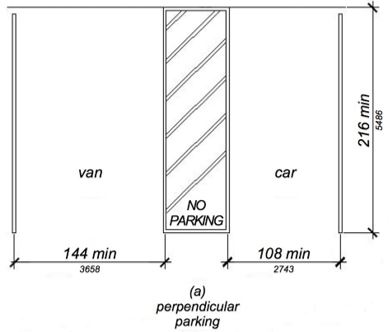
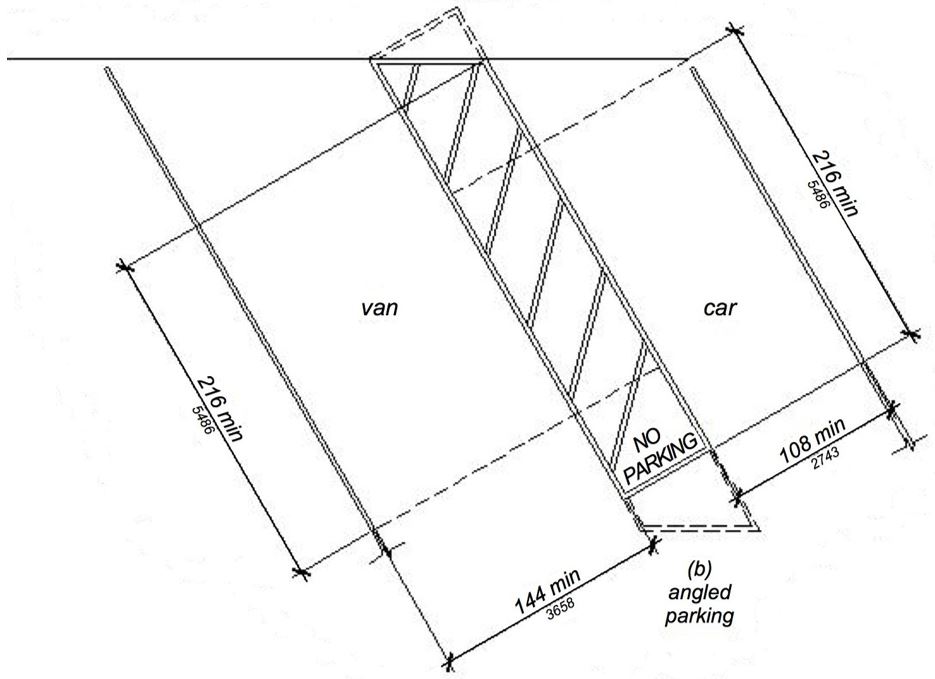
FIGURE 11B-502.2 VEHICLE PARKING SPACES ‡‡
11B-502.3 Access aisle.
Access aisles serving parking spaces shall comply with Section 11B-502.3. Access aisles shall adjoin an accessible route. Two parking spaces or one parking space and one electric vehicle charging space shall be permitted to share a common access aisle.

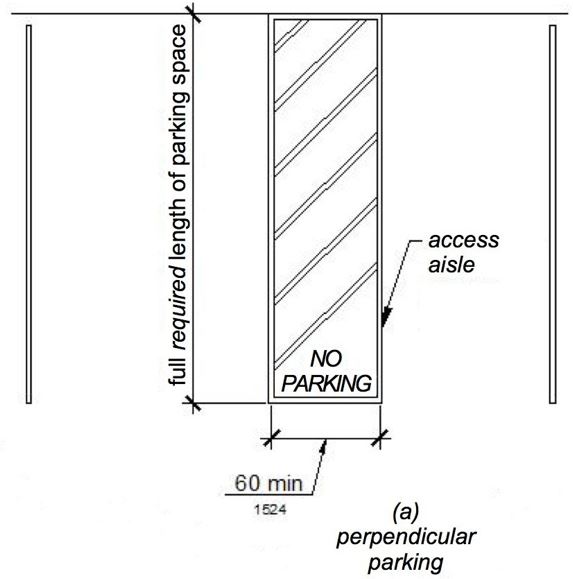
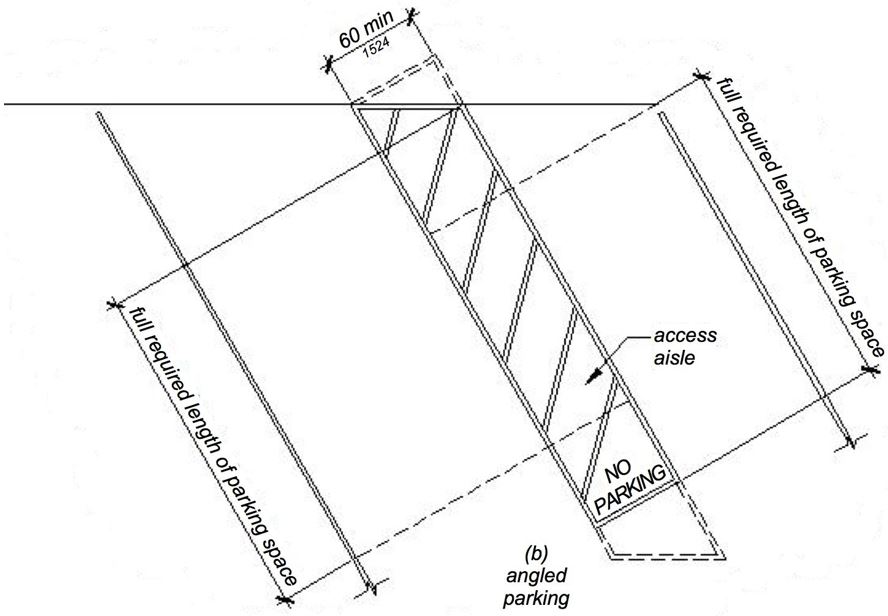
FIGURE 11B-502.3 PARKING SPACE ACCESS AISLE ‡‡
11B-502.3.1 Width.
Access aisles serving car and van parking spaces shall be 60 inches (1524 mm) wide minimum.
11B-502.3.2 Length.
Access aisles shall extend the full required length of the parking spaces they serve.
11B-502.3.3 Marking.
Access aisles shall be marked with a blue painted borderline around their perimeter. The area within the blue borderlines shall be marked with hatched lines a maximum of 36 inches (914 mm) on center in a color contrasting with that of the aisle surface, preferably blue or white. The words "NO PARKING" shall be painted on the surface within each access aisle in white letters a minimum of 12 inches (305 mm) in height and located to be visible from the adjacent vehicular way. Access aisle markings may extend beyond the minimum required length.
[2010 ADA Standards] 502.3.3 Marking. Access aisles shall be marked so as to discourage parking in them.
Asphalt is often the parking surface material used at accessible parking spaces. Asphalt is generally considered to be fairly dark in appearance. In order to provide a suitable contrasting color at the hatched area of the loading and unloading access aisle, a light color hatching should be used at locations where asphalt is the parking surface material. Although white paint is preferred (and traditionally the color most often used), its use is not mandatory under the California Building Code (CBC).
In order to provide a suitable contrast at the hatched area of the loading and unloading access aisle in locations where light concrete is used as the parking surface material (such as at concrete parking garages), a dark color hatching should be used. Although blue paint is preferred, its use is not mandatory under the California Building Code (CBC). ◼
[2010 ADA Standards] Advisory 502.3.3 Marking. The method and color of marking are not specified by these requirements but may be addressed by State or local laws or regulations. Because these requirements permit the van access aisle to be as wide as a parking space, it is important that the aisle be clearly marked.
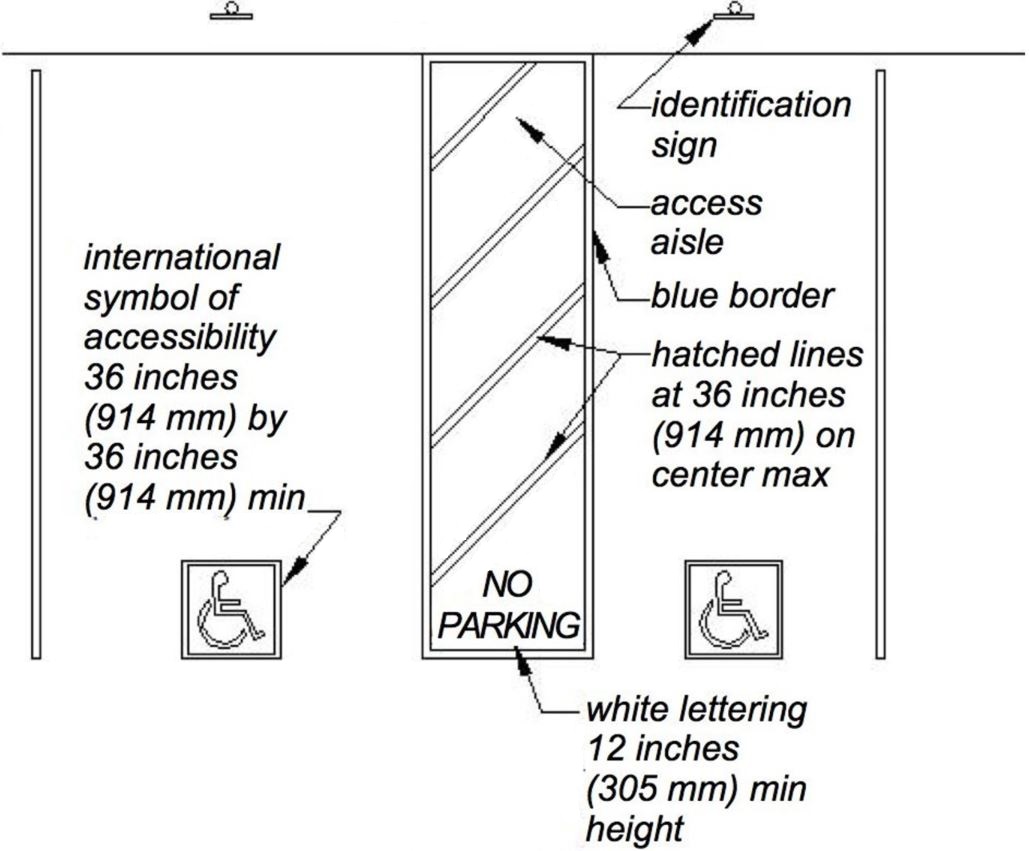
(a) perpendicular parking
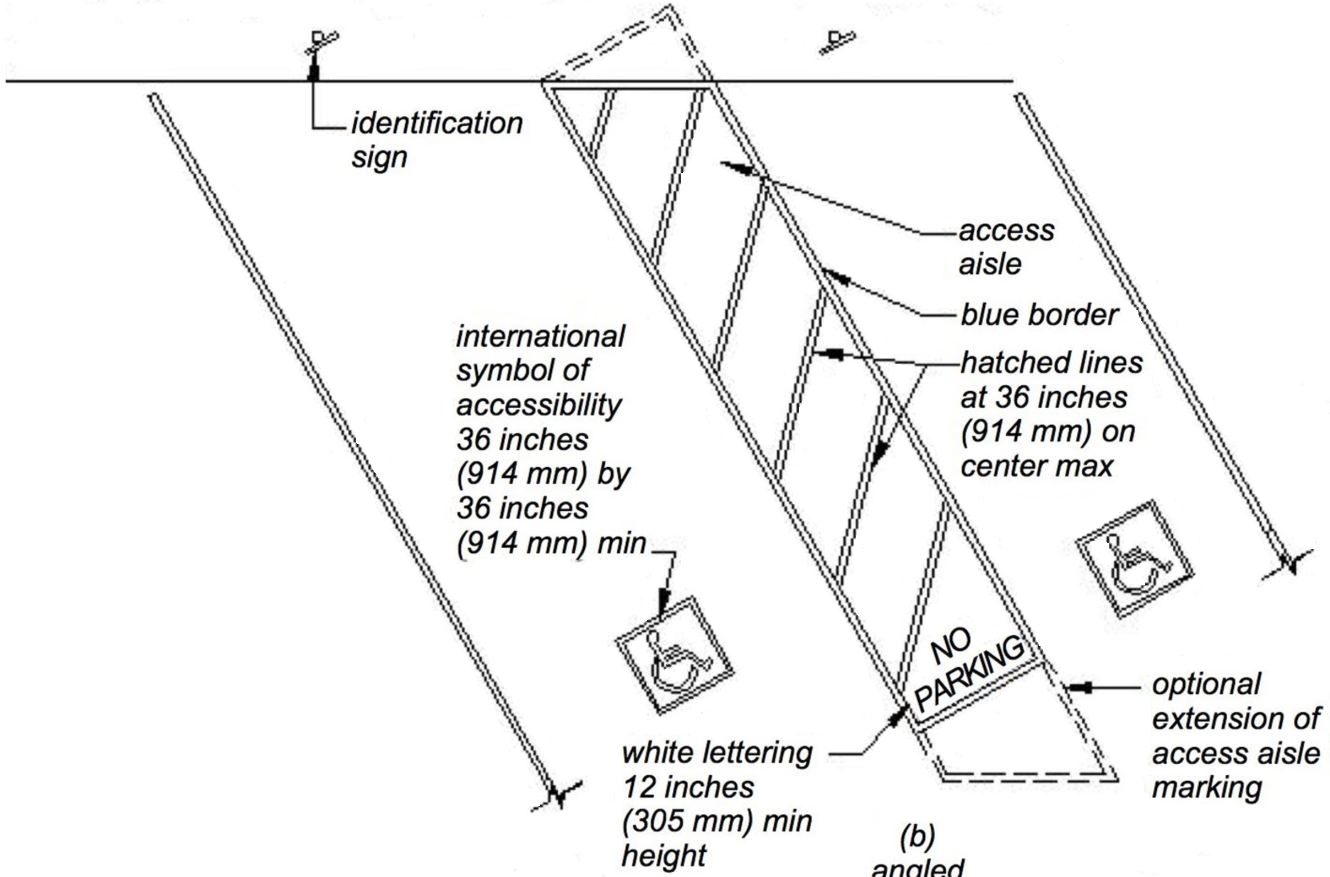
(b) angled parking
FIGURE 11B-502.3.3 ANGLED AND PERPENDICULAR PARKING IDENTIFICATION ‡‡
11B-502.3.4 Location.
Access aisles shall not overlap the vehicular way. Access aisles shall be permitted to be placed on either side of the parking space except for van parking spaces which shall have access aisles located on the passenger side of the parking spaces.
[2010 ADA Standards] 502.3.4 Location. Access aisles shall not overlap the vehicular way. Access aisles shall be permitted to be placed on either side of the parking space except for angled van parking spaces which shall have access aisles located on the passenger side of the parking spaces.

11B-502.4 Floor or ground surfaces.
Parking spaces and access aisles serving them shall comply with Section 11B-302. Access aisles shall be at the same level as the parking spaces they serve. Changes in level, slopes exceeding 1:48, and detectable warnings shall not be permitted.
Exception: Reserved.


11B-502.5 Vertical clearance.
Parking spaces, access aisles and vehicular routes serving them shall provide a vertical clearance of 98 inches (2489 mm) minimum.
[2010 ADA Standards] 502.5 Vertical Clearance. Parking spaces for vans and access aisles and vehicular routes serving them shall provide a vertical clearance of 98 inches (2490 mm) minimum.
Exception: In existing multistory parking facilities, car parking spaces, access aisles and vehicular routes serving them shall provide a vertical clearance of 80 inches (2032 mm) minimum. Existing vertical clearance in excess of 80 inches (2032 mm) and less than 98 inches (2489 mm) shall be maintained. This exception shall not apply to van parking spaces, access aisles, or vehicular routes serving them.

CBC requires 98 inches minimum vertical clearance at all accessible parking spaces, not solely van accessible parking spaces. This is more stringent than 2010 ADA Standards.
11B-502.6 Identification.
Parking space identification signs shall include the International Symbol of Accessibility complying with Section 11B-703.7.2.1 in white on a blue background. Signs identifying van parking spaces shall contain additional language or an additional sign with the designation “van accessible.” Signs shall be 60 inches (1524 mm) minimum above the finish floor or ground surface measured to the bottom of the sign.
[2010 ADA Standards] 502.6 Identification. Parking space identification signs shall include the International Symbol of Accessibility complying with 703.7.2.1. Signs identifying van parking spaces shall contain the designation "van accessible." Signs shall be 60 inches (1525 mm) minimum above the finish floor or ground surface measured to the bottom of the sign.


Exception: Signs located within a circulation path shall be a minimum of 80 inches (2032 mm) above the finish floor or ground surface measured to the bottom of the sign.
11B-502.6.1 Finish and size.
Parking identification signs shall be reflectorized with a minimum area of 70 square inches (45,161 mm2).
11B-502.6.2 Minimum fine.
Additional language or an additional sign below the International Symbol of Accessibility shall state “Minimum Fine $250.”
11B-502.6.3 Location.
A parking space identification sign shall be visible from each parking space. Signs shall be permanently posted either immediately adjacent to the parking space or within the projected parking space width at the head end of the parking space. Signs may also be permanently posted on a wall at the interior end of the parking space.
11B-502.6.4 Marking.
Each accessible car and van space shall have surface identification complying with either Section 11B-502.6.4.1 or 11B-502.6.4.2.
The parking space shall be marked with an International Symbol of Accessibility complying with Section 11B-703.7.2.1 in white on a blue background a minimum 36 inches wide by 36 inches high (914 mm by 914 mm). The centerline of the International Symbol of Accessibility shall be a maximum of 6 inches (152 mm) from the centerline of the parking space, its sides parallel to the length of the parking space and its lower corner at, or lower side aligned with, the end of the parking space length.
The parking space shall be outlined in blue or painted blue and shall be marked with an International Symbol of Accessibility complying with Section 11B-703.7.2.1 a minimum 36 inches wide by 36 inches high (914 mm by 914 mm) in white or a suitable contrasting color. The centerline of the International Symbol of Accessibility shall be a maximum of 6 inches (152 mm) from the centerline of the parking space, its sides parallel to the length of the parking space and its lower corner at, or lower side aligned with, the end of the parking space.
ETA Editor's Note
The CBC identification requirements for accessible parking spaces and van accessible parking spaces are more extensive than those in 2010 ADA Standards.
11B-502.7 Relationship to accessible routes.
Parking spaces and access aisles shall be designed so that cars and vans, when parked, cannot obstruct the required clear width of adjacent accessible routes.

11B-502.7.1 Arrangement.
Parking spaces and access aisles shall be designed so that persons using them are not required to travel behind parking spaces other than to pass behind the parking space in which they parked.

While 2010 ADA Standards Advisory 502.3 discourages configuring access aisles to require travel behind other parked vehicles, CBC 11B-502.7.1 prohibits this.
11B-502.7.2 Wheel stops.
A curb or wheel stop shall be provided if required to prevent encroachment of vehicles over the required clear width of adjacent accessible routes.
11B-502.8 Additional signs.
An additional sign shall be posted either; 1) in a conspicuous place at each entrance to an off-street parking facility or 2) immediately adjacent to on-site accessible parking and visible from each parking space.
11B-502.8.1 Size.
The additional sign shall not be less than 17 inches (432 mm) wide by 22 inches (559 mm) high.
11B-502.8.2 Lettering.
The additional sign shall clearly state in letters with a minimum height of 1 inch (25 mm) the following:
"Unauthorized vehicles parked in designated accessible spaces not displaying distinguishing placards or special license plates issued for persons with disabilities will be towed away at the owner’s expense. Towed vehicles may be reclaimed at _________________________ or by telephoning _______________________."
Blank spaces shall be filled in with appropriate information as a permanent part of the sign.
11B-503 Passenger drop-off and loading zones
[2010 ADA Standards] 503 Passenger Loading Zones
11B-503.1 General.
Passenger drop-off and loading zones shall comply with Section 11B-503.
11B-503.2 Vehicle pull-up space.
Passenger drop-off and loading zones shall provide a vehicular pull-up space 96 inches (2438 mm) wide minimum and 20 feet (6096 mm) long minimum.
11B-503.3 Access aisle.
Passenger drop-off and loading zones shall provide access aisles complying with Section 11B-503 adjacent and parallel to the vehicle pull-up space. Access aisles shall adjoin an accessible route and shall not overlap the vehicular way.
11B-503.3.1 Width.
Access aisles serving vehicle pull-up spaces shall be 60 inches (1524 mm) wide minimum.
11B-503.3.2 Length.
Access aisles shall extend the full length of the vehicle pull-up spaces they serve.
11B-503.3.3 Marking.
Access aisles shall be marked with a painted borderline around their perimeter. The area within the borderlines shall be marked with hatched lines a maximum of 36 inches (914 mm) on center in a color contrasting with that of the aisle surface.
[2010 ADA Standards] 503.3.3 Marking. Access aisles shall be marked so as to discourage parking in them.
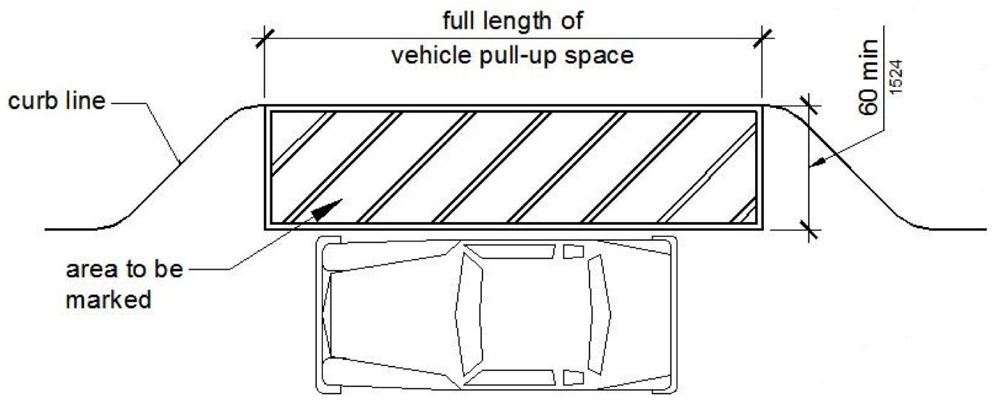
FIGURE 11B-503.3 PASSENGER DROP-OFF AND LOADING ZONE ACCESS AISLE ‡‡
11B-503.4 Floor and ground surfaces.
Vehicle pull-up spaces and access aisles serving them shall comply with Section 11B-302. Access aisles shall be at the same level as the vehicle pull-up space they serve. Changes in level, slopes exceeding 1:48, and detectable warnings shall not be permitted.
Exception: Reserved.
11B-503.5 Vertical clearance.
Vehicle pull-up spaces, access aisles serving them, and a vehicular route from an entrance to the passenger loading zone and from the passenger loading zone to a vehicular exit shall provide a vertical clearance of 114 inches (2896 mm) minimum.

11B-504.2 Treads and risers.
All steps on a flight of stairs shall have uniform riser heights and uniform tread depths. Risers shall be 4 inches (102 mm) high minimum and 7 inches (178 mm) high maximum. Treads shall be 11 inches (279 mm) deep minimum.
Exception: Curved stairways with winder treads are permitted at stairs which are not part of a required means of egress.
11B-504.4 Tread surface.
Stair treads shall comply with Section 11B-302. Changes in level, slopes exceeding 1:48, and detectable warnings shall not be permitted.
Exception: Reserved.
11B-504.4.1 Contrasting stripe.
Interior stairs shall have the upper approach and lower tread marked by a stripe providing clear visual contrast. Exterior stairs shall have the upper approach and all treads marked by a stripe providing clear visual contrast.
The stripe shall be a minimum of 2 inches (51 mm) wide to a maximum of 4 inches (102 mm) wide placed parallel to, and not more than 1 inch (25 mm) from, the nose of the step or upper approach. The stripe shall extend the full width of the step or upper approach and shall be of material that is at least as slip resistant as the other treads of the stair. A painted stripe shall be acceptable. Grooves shall not be used to satisfy this requirement.

The CBC 11B-504.4.1 requirement for contrasting stripes is not included in 2010 ADA Standards. It should be noted that CBC Chapter 10 has a different requirement for contrasting stripes at stepped aisles in Assembly occupancies (not adopted by DSA-AC, as this is a life safety requirement, not an accessibility requirement), as follows:
1029.13.2.3 Tread contrasting marking stripe. A contrasting marking stripe shall be provided on each tread at the nosing or leading edge such that the location of each tread is readily apparent when viewed in descent. Such stripe shall be not less than 1 inch (25 mm), and not more than 2 inches (51 mm) wide.
Exception: The contrasting marking stripe is permitted to be omitted where tread surfaces are such that the location of each tread is readily apparent when viewed in descent.
Where differing requirements apply, it is compulsory to comply with both, if possible. Where CBC Subsection 1029.13.2.3 applies, it is possible to comply with it and Subsection 11B-504.4.1 by providing contrasting stripes at each tread that are exactly 2 inches wide, located not more than 1 inch from the nosing. Where the Exception at Subsection 1029.13.2.3 applies, contrasting striping at the upper approach and bottom tread are still required to comply with Subsection 11B-504.4.1 at interior stepped aisles, and at the upper approach and all treads at exterior stepped aisles (see scoping requirement at 11B-210.1, Exception 3.
11B-504.5 Nosings.
The radius of curvature at the leading edge of the tread shall be ½ inch (12.7 mm) maximum. Nosings that project beyond risers shall have the underside of the leading edge curved or beveled. Risers shall be permitted to slope under the tread at an angle of 30 degrees maximum from vertical. The permitted projection of the nosing shall extend 1¼ inches (32 mm) maximum over the tread below.
Exception: In existing buildings there is no requirement to retroactively alter existing nosing projections of 1½ inches (38 mm) which were constructed in compliance with the building code in effect at the time of original construction.
Additionally, because it is possible to catch the top of one’s shoe on the underside of stair nosings, access compliance regulations require the underside of nosings to be free of abrupt changes – a beveled slope or non-square underside. ◼
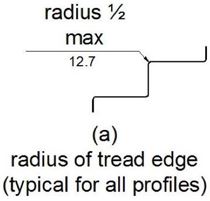
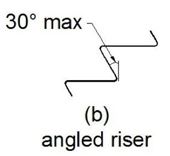
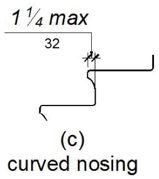
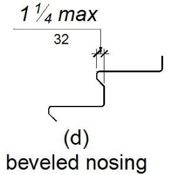
FIGURE 11B-504.5 STAIR NOSINGS ‡‡
11B-504.7 Wet conditions.
Stair treads and landings subject to wet conditions shall be designed to prevent the accumulation of water.
11B-504.8 Floor identification.
Floor identification signs required by Chapter 10, Section 1023.9 complying with Sections 11B-703.1, 11B-703.2, 11B-703.3 and 11B-703.5 shall be located at the landing of each floor level, placed adjacent to the door on the latch side, in all enclosed stairways in buildings two or more stories in height to identify the floor level. At the exit discharge level, the sign shall include a raised five pointed star located to the left of the identifying floor level. The outside diameter of the star shall be the same as the height of the raised characters.
ETA Editor's Note
Stairway signage is among the most frequently-observed barriers in California, because of the prevalent misunderstanding of the requirements. The "Floor Identification Signs" referenced in CBC 11B-504.8 and in the second paragraph (only) of 1023.9 should not be confused with the "Stairway Identification Signs" (hereinafter termed the "Fire Department Signs," to assist in clarifying) referenced in the first paragraph of 1023.9, and in 1023.9.1.
"Floor Identification Signs" are for routine wayfinding use by vision-impaired persons and others who use the stairs, and these are required at all enclosed stairways of multi-story buildings. They must be tactile, and located at the latch side of the door inside the stairway as prescribed by CBC Section 11B-703.4.
"Fire Department Signs" are for use by emergency responders, to enable efficient navigation through tall buildings in emergency situations without having to backtrack, losing valuable time. They are required at enclosed stairs in buildings with more than 3 stories above or below the level of exit discharge. They are not required to be, and should not be tactile. They are not required to be, and should not be located adjacent to the latch side of the door. Making them tactile and placing them at the latch side of the door does not benefit emergency responders, and distracts routine vision-impaired stair users by providing information that is of little wayfinding use (e.g., whether the stair connects to the roof level).
It is not possible to meet the requirements for both the "Floor Identification Signs" and the "Fire Department Signs" with a single sign at each stair level, although this is frequently observed. Architects, Signage Consultants and Manufacturers having standard details showing one sign for both purposes are encouraged to change them permanently, indicating two separate and distinct signs. The requirements of 11B-504.8 do not apply to the "Fire Department Signs."
Neither the "Floor Identification Signs" nor the "Fire Department Signs" are required by 2010 ADA Standards. Note also that neither of these signs is required at open stairways.
11B-505.1 General.
Handrails provided along walking surfaces complying with Section 11B-403, required at ramps complying with Section 11B-405, and required at stairs complying with Section 11B-504 shall comply with Section 11B-505.

11B-505.2 Where required.
Handrails shall be provided on both sides of stairs and ramps.
Exceptions:
- In assembly areas, handrails shall not be required on both sides of aisle ramps where a handrail is provided at either side or within the aisle width.
- Curb ramps do not require handrails.
- At door landings, handrails are not required when the ramp run is less than 6 inches (152 mm) in rise or 72 inches (1829 mm) in length.
11B-505.2.1 Orientation.
The orientation of at least one handrail shall be in the direction of the stair run, perpendicular to the direction of the stair nosing, and shall not reduce the minimum required width of the stair.
11B-505.3 Continuity.
Handrails shall be continuous within the full length of each stair flight or ramp run. Inside handrails on switchback or dogleg stairs and ramps shall be continuous between flights or runs.
Exception: In assembly areas, ramp handrails adjacent to seating or within the aisle width shall not be required to be continuous in aisles serving seating.
[2010 ADA Standards] EXCEPTION: In assembly areas, handrails on ramps shall not be required to be continuous in aisles serving seating.
11B-505.4 Height.
Top of gripping surfaces of handrails shall be 34 inches (864 mm) minimum and 38 inches (965 mm) maximum vertically above walking surfaces, stair nosings, and ramp surfaces. Handrails shall be at a consistent height above walking surfaces, stair nosings, and ramp surfaces.

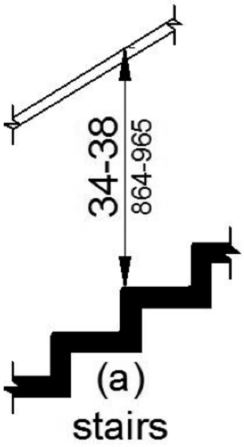
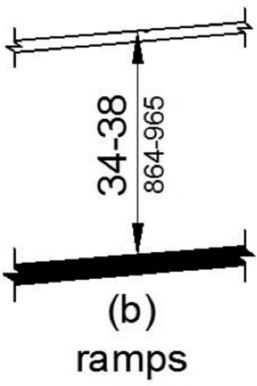
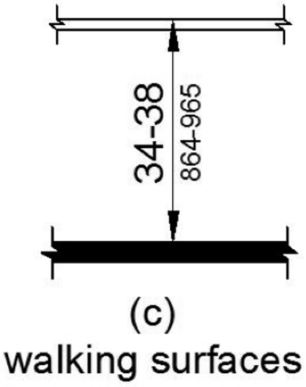
FIGURE 11B-505.4 HANDRAIL HEIGHT
11B-505.5 Clearance.
Clearance between handrail gripping surfaces and adjacent surfaces shall be 1½ inches (38 mm) minimum. Handrails may be located in a recess if the recess is 3 inches (76 mm) maximum deep and 18 inches (457 mm) minimum clear above the top of the handrail.
[2010 ADA Standards] 505.5 Clearance. Clearance between handrail gripping surfaces and adjacent surfaces shall be 1½ inches (38 mm) minimum.
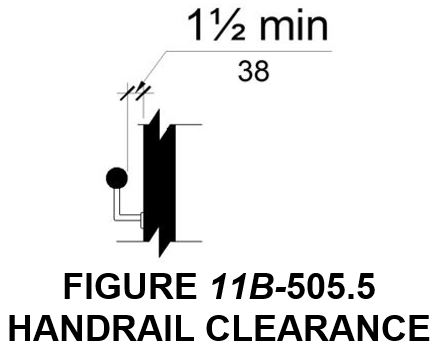
11B-505.6 Gripping surface.
Handrail gripping surfaces shall be continuous along their length and shall not be obstructed along their tops or sides. The bottoms of handrail gripping surfaces shall not be obstructed for more than 20 percent of their length. Where provided, horizontal projections shall occur 1½ inches (38 mm) minimum below the bottom of the handrail gripping surface.
Exceptions:
- Where handrails are provided along walking surfaces with slopes not steeper than 1:20, the bottoms of handrail gripping surfaces shall be permitted to be obstructed along their entire length where they are integral to crash rails or bumper guards.
- The distance between horizontal projections and the bottom of the gripping surface shall be permitted to be reduced by 1/8 inch (3.2 mm) for each ½ inch (12.7 mm) of additional handrail perimeter dimension that exceeds 4 inches (102 mm).

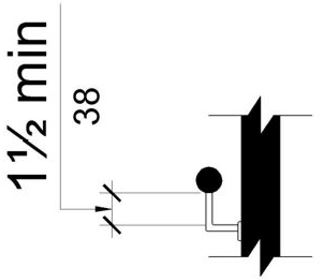
FIGURE 11B-505.6 HORIZONTAL PROJECTIONS BELOW GRIPPING SURFACE
11B-505.7 Cross section.
Handrail gripping surfaces shall have a cross section complying with Section 11B-505.7.1 or 11B-505.7.2.
11B-505.7.1 Circular cross section.
Handrail gripping surfaces with a circular cross section shall have an outside diameter of 1¼ inches (32 mm) minimum and 2 inches (51 mm) maximum.
11B-505.7.2 Non-circular cross sections.
Handrail gripping surfaces with a non-circular cross section shall have a perimeter dimension of 4 inches (102 mm) minimum and 6¼ inches (159 mm) maximum, and a cross-section dimension of 2¼ inches (57 mm) maximum.
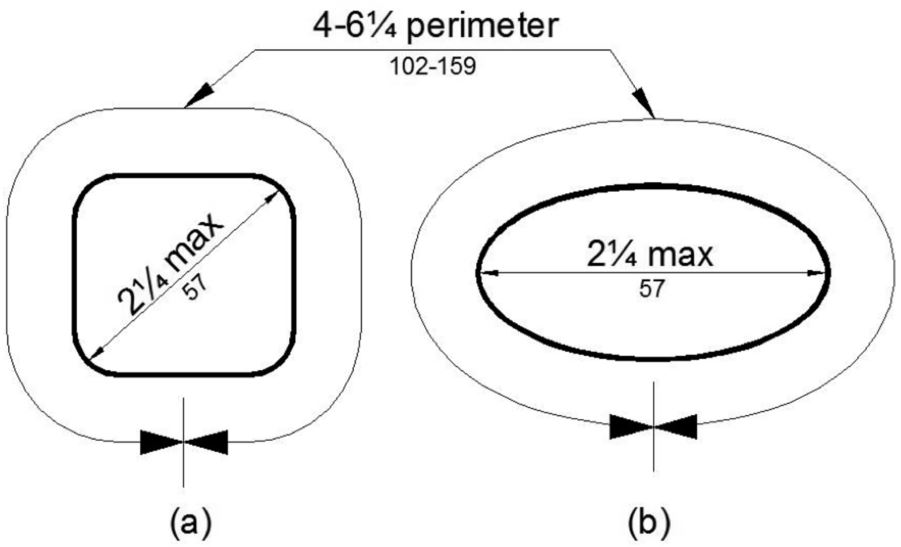
FIGURE 11B-505.7.2 HANDRAIL NON-CIRCULAR CROSS SECTION
11B-505.8 Surfaces.
Handrail gripping surfaces and any surfaces adjacent to them shall be free of sharp or abrasive elements and shall have rounded edges.
11B-505.10 Handrail extensions.
Handrail gripping surfaces shall extend beyond and in the same direction of stair flights and ramp runs in accordance with Section 11B-505.10.
Exceptions:
- Extensions shall not be required for continuous handrails at the inside turn of switchback or dogleg stairs and ramps.
- In assembly areas, extensions shall not be required for ramp handrails in aisles serving seating where the handrails are discontinuous to provide access to seating and to permit crossovers within aisles.
- In alterations, where the extension of the handrail in the direction of stair flight or ramp run would create a hazard, the extension of the handrail may be turned 90 degrees from the direction of stair flight or ramp run.
[2010 ADA Standards] 3. In alterations, full extensions of handrails shall not be required where such extensions would be hazardous due to plan configuration.
ETA Editor's Note
CBC 11B-505.10 Exception 3 is more stringent than 2010 ADA Standards, which allows the handrail extensions to be eliminated in alterations where they would be hazardous. Handrail extensions are never permitted to turn 90 degrees at new stairs or new ramps, either by CBC or ADA Standards, except at continuous inside handrails (per Exception 1).
11B-505.10.1 Top and bottom extension at ramps.
Ramp handrails shall extend horizontally above the landing for 12 inches (305 mm) minimum beyond the top and bottom of ramp runs. Extensions shall return to a wall, guard, or the landing surface, or shall be continuous to the handrail of an adjacent ramp run.
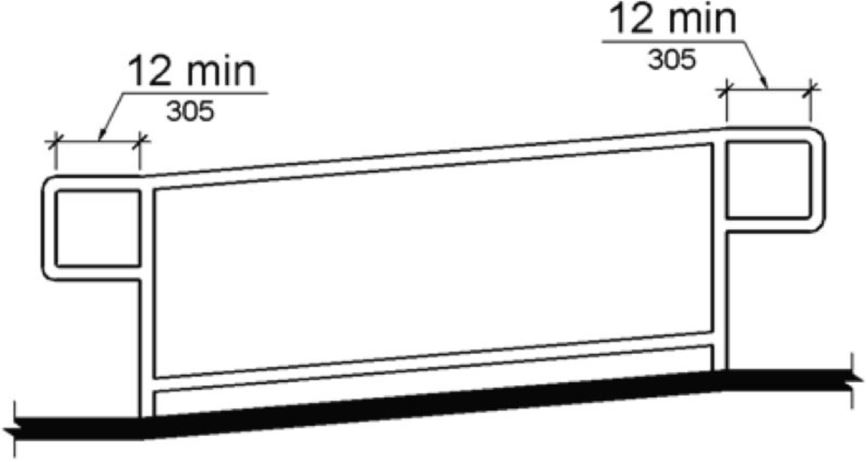
FIGURE 11B-505.10.1 TOP AND BOTTOM HANDRAIL EXTENSION AT RAMPS
11B-505.10.2 Top extension at stairs.
At the top of a stair flight, handrails shall extend horizontally above the landing for 12 inches (305 mm) minimum beginning directly above the first riser nosing. Extensions shall return to a wall, guard, or the landing surface, or shall be continuous to the handrail of an adjacent stair flight.
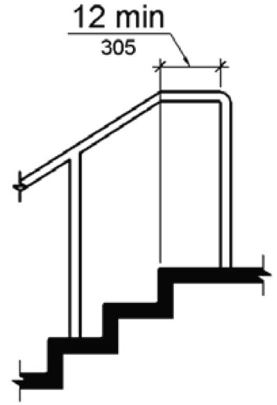
FIGURE 11B-505.10.2 TOP HANDRAIL EXTENSION AT STAIRS
11B-505.10.3 Bottom extension at stairs.
At the bottom of a stair flight, handrails shall extend at the slope of the stair flight for a horizontal distance equal to one tread depth beyond the last riser nosing. The horizontal extension of a handrail shall be 12 inches (305 mm) long minimum and a height equal to that of the sloping portion of the handrail as measured above the stair nosings. Extension shall return to a wall, guard, or the landing surface, or shall be continuous to the handrail of an adjacent stair flight.
[2010 ADA Standards] 505.10.3 Bottom Extension at Stairs. At the bottom of a stair flight, handrails shall extend at the slope of the stair flight for a horizontal distance at least equal to one tread depth beyond the last riser nosing. Extension shall return to a wall, guard, or the landing surface, or shall be continuous to the handrail of an adjacent stair flight.
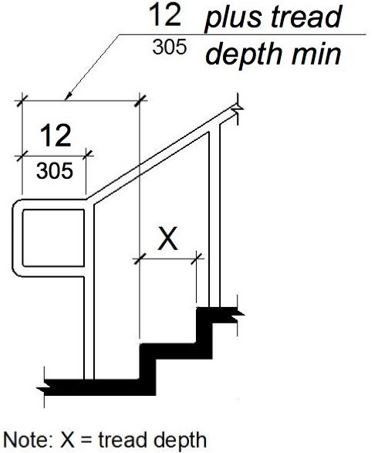
FIGURE 11B-505.10.3 BOTTOM HANDRAIL EXTENSION AT STAIRS ‡‡
ETA Editor's Note
The CBC 11B-505.10.3 requirement for bottom handrail extension at stairs is more stringent than 2010 ADA Standards, which was revised from 1991 ADAAG.
11B-601.1 Scope.
The provisions of Division 6 shall apply where required by Division 2 or where referenced by a requirement in this chapter.
11B-602 Drinking fountains and bottle filling stations
11B-602.1 General.
Drinking fountains shall comply with Sections 11B-307 and 11B-602.
11B-602.2 Clear floor space.
Units shall have a clear floor or ground space complying with Section 11B-305 positioned for a forward approach and centered on the unit. Knee and toe clearance complying with Section 11B-306 shall be provided.
Exception: A parallel approach complying with Section 11B-305 shall be permitted at units for children's use where the spout is 30 inches (762 mm) maximum above the finish floor or ground and is 3½ inches (89 mm) maximum from the front edge of the unit, including bumpers.
11B-602.3 Operable parts.
Operable parts shall comply with Section 11B-309. The flow of water shall be activated by a manually operated system that is front mounted or side mounted and located within 6 inches (152 mm) of the front edge of the fountain or an automatic electronically controlled device.
[2010 ADA Standards] 602.3 Operable Parts. Operable parts shall comply with 309.
11B-602.4 Spout height.
Spout outlets shall be 36 inches (914 mm) maximum above the finish floor or ground.
11B-602.5 Spout location.
The spout shall be located 15 inches (381 mm) minimum from the vertical support and 5 inches (127 mm) maximum from the front edge of the unit, including bumpers.
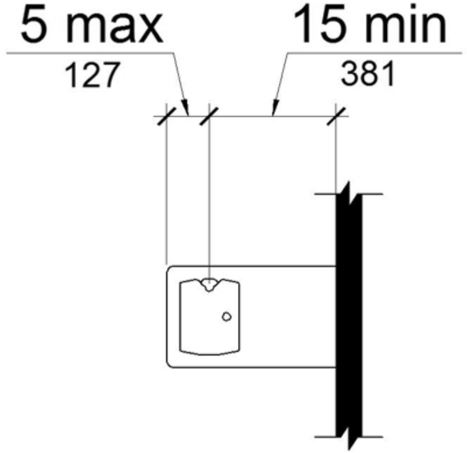
FIGURE 11B-602.5 DRINKING FOUNTAIN SPOUT LOCATION
11B-602.6 Water flow.
The spout shall provide a flow of water 4 inches (102 mm) high minimum and shall be located 5 inches (127 mm) maximum from the front of the unit. The angle of the water stream shall be measured horizontally relative to the front face of the unit. Where spouts are located less than 3 inches (76 mm) of the front of the unit, the angle of the water stream shall be 30 degrees maximum. Where spouts are located between 3 inches (76 mm) and 5 inches (127 mm) maximum from the front of the unit, the angle of the water stream shall be 15 degrees maximum.

11B-602.7 Drinking fountains for standing persons.
Spout outlets of drinking fountains for standing persons shall be 38 inches (965 mm) minimum and 43 inches (1092 mm) maximum above the finish floor or ground.
11B-602.8 Depth.
Wall- and post-mounted cantilevered drinking fountains shall be 18 inches (457 mm) minimum and 19 inches (483 mm) maximum in depth.
11B-602.9 Pedestrian protection.
All drinking fountains shall either be located completely within alcoves, positioned completely between wing walls, or otherwise positioned so as not to encroach into pedestrian ways. The protected area within which a drinking fountain is located shall be 32 inches (813 mm) wide minimum and 18 inches (457 mm) deep minimum, and shall comply with Section 11B-305.7. When used, wing walls or barriers shall project horizontally at least as far as the drinking fountain and to within 6 inches (152 mm) vertically from the floor or ground surface.
11B-602.10 Bottle filling stations.
Bottle filling stations shall comply with Sections 11B-307 and 11B-309.
Exception: Where bottle filling stations are provided at a drinking fountain for standing persons, the bottle filling station is not required to comply with this section provided a bottle filling station is located at the drinking fountain complying with Sections 11B-602.2 through 11B-602.6.
11B-603.1 General.
Toilet and bathing rooms shall comply with Section 11B-603.
11B-603.2 Clearances.
Clearances shall comply with Section 11B-603.2.
11B-603.2.1 Turning space.
Turning space complying with Section 11B-304 shall be provided within the room.
11B-603.2.2 Overlap.
Required clear floor spaces, clearance at fixtures, and turning space shall be permitted to overlap.
11B-603.2.3 Door swing.
Doors shall not swing into the clear floor space or clearance required for any fixture. Doors to accessible water closet compartments shall be permitted to encroach into the turning space without limitation. Other than doors to accessible water closet compartments, a door in any position, shall be permitted to encroach into the turning space by 12 inches (305 mm) maximum.
[2010 ADA Standards] 603.2.3 Door Swing. Doors shall not swing into the clear floor space or clearance required for any fixture. Doors shall be permitted to swing into the required turning space.
Exceptions:
-
Reserved.
[2010 ADA Standards] 1. Doors to a toilet room or bathing room for a single occupant accessed only through a private office and not for common use or public use shall be permitted to swing into the clear floor space or clearance provided the swing of the door can be reversed to comply with 603.2.3.
-
Where the toilet room or bathing room is for individual use and a clear floor space complying with Section 11B-305.3 is provided within the room beyond the arc of the door swing, doors shall be permitted to swing into the clear floor space or clearance required for any fixture.
-
In residential dwelling units complying with Section 11B-233.3.1.1, doors shall be permitted to swing over the turning space without limitation.

Limiting the encroachment of door swings into the wheelchair turning space, and lacking Exception 1 above allowed by 2010 ADA Standards, the CBC requirements pertaining to toilet or bathing room clearances are more stringent.
11B-603.3 Mirrors.
Mirrors located above lavatories or countertops shall be installed with the bottom edge of the reflecting surface 40 inches (1016 mm) maximum above the finish floor or ground. Mirrors not located above lavatories or countertops shall be installed with the bottom edge of the reflecting surface 35 inches (889 mm) maximum above the finish floor or ground.

11B-603.4 Coat hooks, shelves and medicine cabinets.
Coat hooks shall be located within one of the reach ranges specified in Section 11B-308. Shelves shall be located 40 inches (1016 mm) minimum and 48 inches (1219 mm) maximum above the finish floor. Medicine cabinets shall be located with a usable shelf no higher than 44 inches (1118 mm) maximum above the finish floor.
[2010 ADA Standards] 603.4 Coat Hooks and Shelves. Coat hooks shall be located within one of the reach ranges specified in 308. Shelves shall be located 40 inches (1015 mm) minimum and 48 inches (1220 mm) maximum above the finish floor.
11B-603.5 Accessories.
Where towel or sanitary napkin dispensers, waste receptacles, or other accessories are provided in toilet facilities, at least one of each type shall be located on an accessible route. All operable parts, including coin slots, shall be 40 inches (1016 mm) maximum above the finish floor.
Exception: Baby diaper changing stations are not required to comply with Section 11B-603.5.
ETA Editor's Note
11B-603.6 Guest room toilet and bathing rooms.
Toilet and bathing rooms within guest rooms that are not required to provide mobility features complying with Section 11B-806.2 shall provide all toilet and bathing fixtures in a location that allows a person using a wheelchair measuring 30 inches by 48 inches (762 mm by 1219 mm) to touch the wheelchair to any lavatory, urinal, water closet, tub, sauna, shower stall and any other similar sanitary installation, if provided.
11B-604.1 General.
Water closets and toilet compartments shall comply with Sections 11B-604.2 through 11B-604.8.
Exception: Water closets and toilet compartments for children's use shall be permitted to comply with Section 11B-604.9.
11B-604.2 Location.
The water closet shall be positioned with a wall or partition to the rear and to one side. The centerline of the water closet shall be 17 inches (432 mm) minimum to 18 inches (457 mm) maximum from the side wall or partition, except that the water closet shall be 17 inches (432 mm) minimum and 19 inches (483 mm) maximum from the side wall or partition in the ambulatory accessible toilet compartment specified in Section 11B-604.8.2. Water closets shall be arranged for a left-hand or right-hand approach.
[2010 ADA Standards] 604.2 Location. The water closet shall be positioned with a wall or partition to the rear and to one side. The centerline of the water closet shall be 16 inches (405 mm) minimum to 18 inches (455 mm) maximum from the side wall or partition, except that the water closet shall be 17 inches (430 mm) minimum and 19 inches (485 mm) maximum from the side wall or partition in the ambulatory accessible toilet compartment specified in 604.8.2. Water closets shall be arranged for a left-hand or right-hand approach.
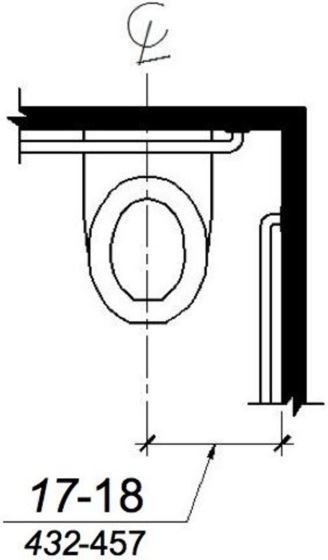
(a) wheelchair accessible water closets
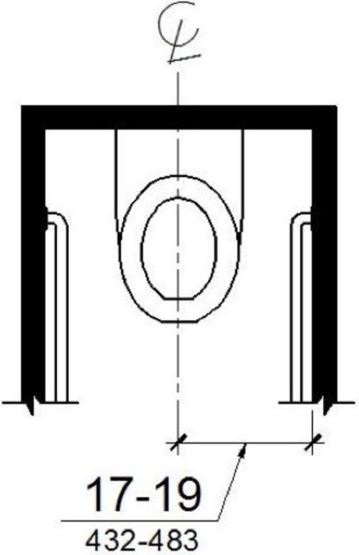
(b) ambulatory accessible water closets
FIGURE 11B-604.2 WATER CLOSET LOCATION ‡‡
11B-604.3 Clearance.
Clearances around water closets and in toilet compartments shall comply with Section 11B-604.3.
11B-604.3.1 Size.
Clearance around a water closet shall be 60 inches (1524 mm) minimum measured perpendicular from the side wall and 56 inches (1422 mm) minimum measured perpendicular from the rear wall. A minimum 60 inches (1524 mm) wide and 48 inches (1219 mm) deep maneuvering space shall be provided in front of the water closet.
Exception: In residential dwelling units complying with Section 11B-233.3.1.1, maneuvering space in front of the water closet shall be a minimum 60 inches (1524 mm) wide and 36 inches (914 mm) deep.
[2010 ADA Standards] 604.3.1 Size. Clearance around a water closet shall be 60 inches (1525 mm) minimum measured perpendicular from the side wall and 56 inches (1420 mm) minimum measured perpendicular from the rear wall.
ETA Editor's Note
The CBC 11B-604.3.1 requirement for maneuvering space in front of accessible water closets exceeds the 2010 ADA Standards requirement for water closet clear floor space, but a door may swing into the added clearance.
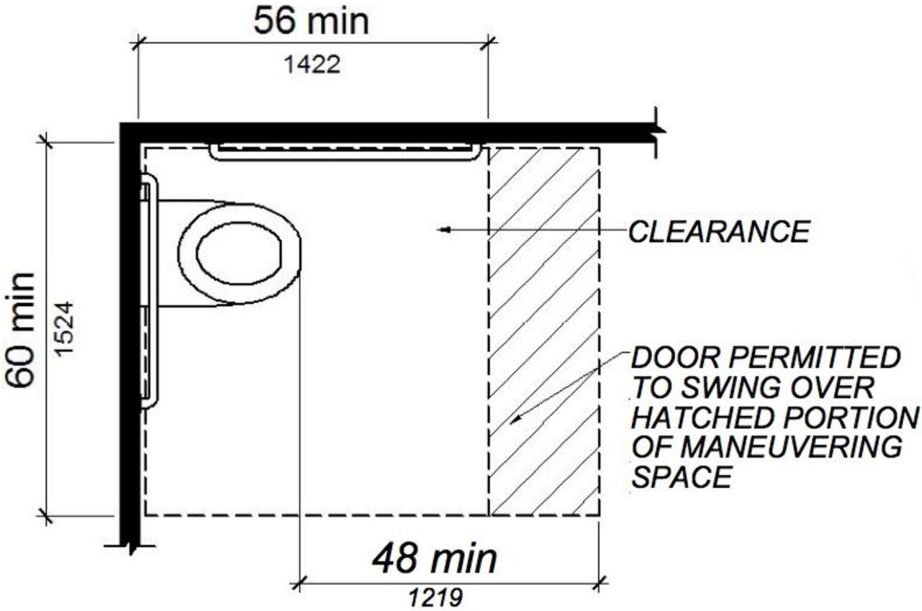
FIGURE 11B-604.3.1 SIZE OF CLEARANCE AT WATER CLOSETS ‡‡
11B-604.3.2 Overlap.
The required clearance around the water closet shall be permitted to overlap the water closet, associated grab bars, dispensers, sanitary napkin disposal units, coat hooks, shelves, accessible routes, clear floor space and clearances required at other fixtures, and the turning space. No other fixtures or obstructions shall be located within the required water closet clearance.
ETA Editor's Note
The Office of Statewide Health Planning and Development (OSHPD), which has jurisdiction over hospitals and long-term care facilities in California, issued Code Application Notice CAN 2-11B, dated 9/9/14, which includes the following interpretation of Subsection 11B-604.3.2:
Showers are fixtures including a 30 inch x 60 inch clear receptor with a minimum/maximum slope of ¼ inch per foot to a drain (refer to CPC Section 408.5 and CBC Section 11B-608.9), and a threshold, between the shower receptor and the fixture clearance provided outside the shower (CBC Section 11B-608.2.2.1) with a maximum height of ½ inch (CBC Section 11B-608.7). The required clearance around a water closet may overlap the clearance required outside the shower but not overlap the shower fixture threshold or receptor.
As of the initial publication of this Guide, OSHPD has not updated CAN 2-11B for applicability to 2019 CBC. Since there is no change to the wording of Subsection 11B-604.3.2 from 2013 CBC to 2019 CBC, there is no reason to expect that OSHPD will change its interpretation.
Exception: In residential dwelling units, a lavatory complying with Section 11B-606 shall be permitted on the rear wall 26 inches (660 mm) minimum from the water closet centerline to allow for the installation of a grab bar where the clearance at the water closet is 66 inches (1676 mm) minimum measured perpendicular from the rear wall.

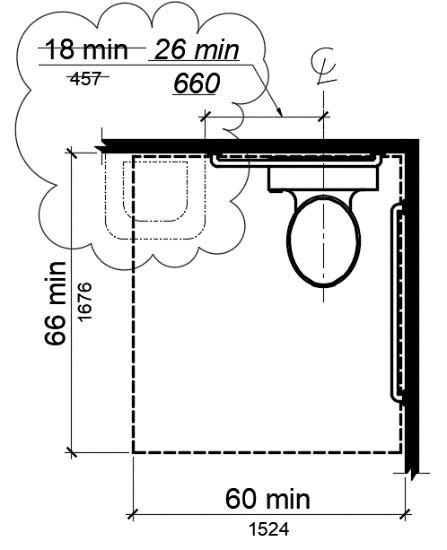
Figure 11B-604.3.2 (Exception)
OVERLAP OF WATER CLOSET CLEARANCE IN RESIDENTIAL DWELLING UNITS
11B-604.4 Seats.
The seat height of a water closet above the finish floor shall be 17 inches (432 mm) minimum and 19 inches (483 mm) maximum measured to the top of the seat. Seats shall not be sprung to return to a lifted position. Seats shall be 2 inches (51 mm) high maximum.
[2010 ADA Standards] 604.4 Seats. The seat height of a water closet above the finish floor shall be 17 inches (430 mm) minimum and 19 inches (485 mm) maximum measured to the top of the seat. Seats shall not be sprung to return to a lifted position.
Exceptions:
1. Reserved.
[2010 ADA Standards] 1. A water closet in a toilet room for a single occupant accessed only through a private office and not for common use or public use shall not be required to comply with 604.4.
2. In residential dwelling units, the height of water closets shall be permitted to be 15 inches (381 mm) minimum and 19 inches (483 mm) maximum above the finish floor measured to the top of the seat.
3. A 3-inch (76 mm) high seat shall be permitted only in alterations where the existing fixture is less than 15 inches (381 mm) high.
11B-604.5 Grab bars.
Grab bars for water closets shall comply with Section 11B-609. Grab bars shall be provided on the side wall closest to the water closet and on the rear wall. Where separate grab bars are required on adjacent walls at a common mounting height, an L-shaped grab bar meeting the dimensional requirements of Sections 11B-604.5.1 and 11B-604.5.2 shall be permitted.
[2010 ADA Standards] 604.5 Grab Bars. Grab bars for water closets shall comply with 609. Grab bars shall be provided on the side wall closest to the water closet and on the rear wall.
Exceptions:
1. Reserved.
[2010 ADA Standards] 1. Grab bars shall not be required to be installed in a toilet room for a single occupant accessed only through a private office and not for common use or public use provided that reinforcement has been installed in walls and located so as to permit the installation of grab bars complying with 604.5.
2. In residential dwelling units, grab bars shall not be required to be installed in toilet or bathrooms provided that reinforcement has been installed in walls and located so as to permit the installation of grab bars complying with Section 11B-604.5.

3. In detention or correction facilities, grab bars shall not be required to be installed in housing or holding cells that are specially designed without protrusions for purposes of suicide prevention.
11B-604.5.1 Side wall.
The side wall grab bar shall be 42 inches (1067 mm) long minimum, located 12 inches (305 mm) maximum from the rear wall and extending 54 inches (1372 mm) minimum from the rear wall with the front end positioned 24 inches (610 mm) minimum in front of the water closet.
[2010 ADA Standards] 604.5.1 Side Wall. The side wall grab bar shall be 42 inches (1065 mm) long minimum, located 12 inches (305 mm) maximum from the rear wall and extending 54 inches (1370 mm) minimum from the rear wall.
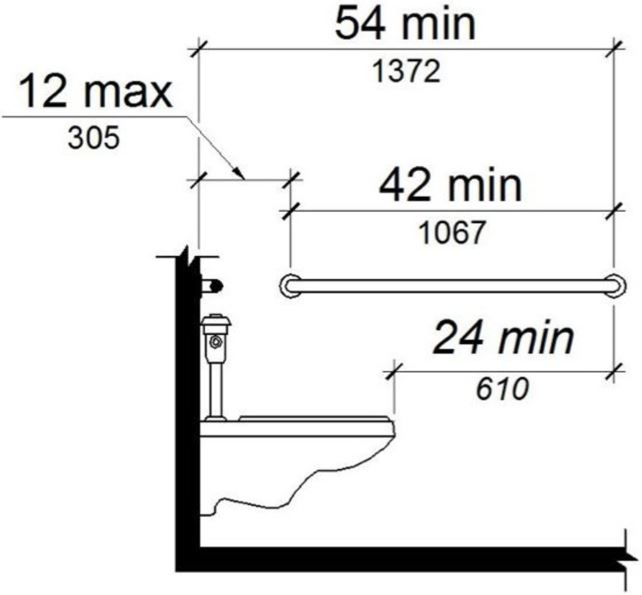
FIGURE 11B-604.5.1 SIDE WALL GRAB BAR AT WATER CLOSETS ‡‡
11B-604.5.2 Rear wall.
The rear wall grab bar shall be 36 inches (914 mm) long minimum and extend from the centerline of the water closet 12 inches (305 mm) minimum on one side and 24 inches (610 mm) minimum on the other side.
Exceptions:
- The rear grab bar shall be permitted to be 24 inches (610 mm) long minimum, centered on the water closet, where wall space does not permit a length of 36 inches (914 mm) minimum due to the location of a recessed fixture adjacent to the water closet.
- Where an administrative authority requires flush controls for flush valves to be located in a position that conflicts with the location of the rear grab bar, then the rear grab bar shall be permitted to be split or shifted to the open side of the toilet area.
ETA Editor's Note
The Office of Statewide Health Planning and Development (OSHPD), which has jurisdiction over hospitals and long-term care facilities in California, issued Code Application Notice CAN 2-11B, dated 9/9/14, which includes the following interpretation of Subsection 11B-604.5.2:
CBC Section 1224.14.2.7 requires the provision of a flushing-rim clinical sink in the soiled utility room of a nursing unit. There is an allowance to eliminate the clinical sink if facilities for cleaning bedpans are provided elsewhere. CPC Table 4-2 Footnote 14 allows the clinical sink to be deleted if all bedrooms in the nursing unit are provided with adjoining toilets with bedpan flushing devices.
Patient toilet rooms with bedpan flushing devices are an allowance, not a requirement. If this approach is pursued, the bedpan flushing device shall not be a unit that results in the need to split or offset the rear grab bar. Section 11B-604.5.2 is not available to accommodate bedpan flushing devices. The gripping surface of the grab bar must be available for the entire 36-inch length without interruption.
Bedpan washing devices that are manufactured as part of a flush valve assembly project above the rear grab bar, obstructing it. OSHPD's interpretation disallows those at the water closets in accessible Patient Toilets. There are wall-mounted bedpan washing devices that could be used instead, taking care not to obstruct either the side or the rear grab bars, or the required clear floor space.
As of the initial publication of this Guide, OSHPD has not updated CAN 2-11B for applicability to 2019 CBC. Since there is no change to the wording of Subsection 11B-604.5.2 Exception 2 from 2013 CBC to 2019 CBC, there is no reason to expect that OSHPD will change its interpretation.
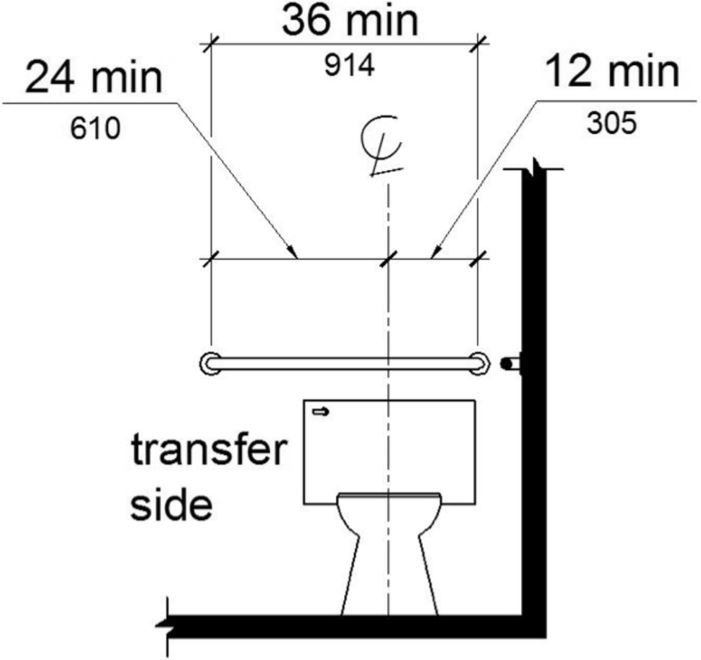
FIGURE 11B-604.5.2 REAR WALL GRAB BAR AT WATER CLOSETS
11B-604.6 Flush controls.
Flush controls shall be hand operated or automatic. Hand operated flush controls shall comply with Section 11B-309 except they shall be located 44 inches (1118 mm) maximum above the floor. Flush controls shall be located on the open side of the water closet except in ambulatory accessible compartments complying with Section 11B-604.8.2.
[2010 ADA Standards] 604.6 Flush Controls. Flush controls shall be hand operated or automatic. Hand operated flush controls shall comply with 309. Flush controls shall be located on the open side of the water closet except in ambulatory accessible compartments complying with 604.8.2.

11B-604.7 Dispensers and disposal units.
Toilet paper dispensers and sanitary napkin disposal units shall comply with Section 11B-604.7. Combination accessory units are not permitted to encroach into the space required by Section 11B-609.3.
[2010 ADA Standards] 604.7 Dispensers. Toilet paper dispensers shall comply with 309.4 and shall be 7 inches (180 mm) minimum and 9 inches (230 mm) maximum in front of the water closet measured to the centerline of the dispenser. The outlet of the dispenser shall be 15 inches (380 mm) minimum and 48 inches (1220 mm) maximum above the finish floor and shall not be located behind grab bars. Dispensers shall not be of a type that controls delivery or that does not allow continuous paper flow.
11B-604.7.1 Dispensers.
Toilet paper dispensers shall comply with Section 11B-309.4 and shall be 7 inches (178 mm) minimum and 9 inches (229 mm) maximum in front of the water closet measured to the centerline of the dispenser. The outlet of the dispenser shall be below the grab bar, 19 inches (483 mm) minimum above the finish floor and shall not be located behind grab bars. Dispensers shall not be of a type that controls delivery or that does not allow continuous paper flow.
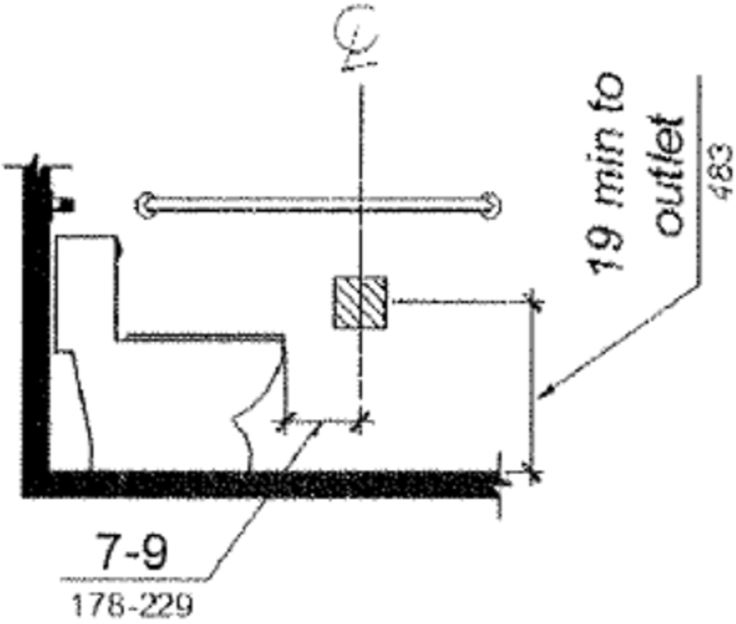
FIGURE 11B-604.7.1 DISPENSER OUTLET LOCATION ‡‡
11B-604.7.2 Disposal units.
Sanitary napkin disposal units, if provided, shall comply with Section 11B-309.4 and shall be wall mounted and located on the sidewall between the rear wall of the toilet and the toilet paper dispenser, adjacent to the toilet paper dispenser. The disposal unit shall be located below the grab bar with the opening of the disposal unit 19 inches minimum (483 mm) above the finish floor.
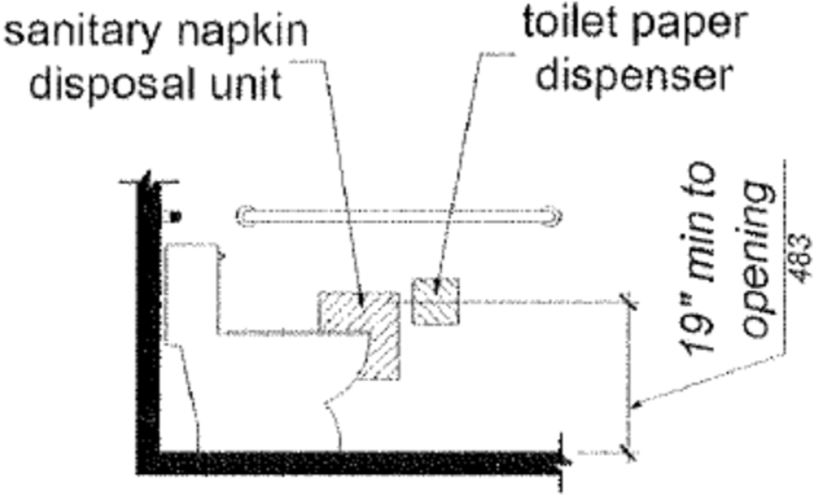
FIGURE 11B-604.7.2 DISPOSAL UNIT LOCATION
11B-604.8 Toilet compartments.
Wheelchair accessible toilet compartments shall meet the requirements of Sections 11B-604.8.1 and 11B-604.8.3. Compartments containing more than one plumbing fixture shall comply with Section 11B-603. Ambulatory accessible compartments shall comply with Sections 11B-604.8.2 and 11B-604.8.3.
11B-604.8.1 Wheelchair accessible compartments.
Wheelchair accessible compartments shall comply with Section 11B-604.8.1.
Wheelchair accessible compartments shall be 60 inches (1524 mm) wide minimum measured perpendicular to the side wall, and 56 inches (1422 mm) deep minimum for wall hung water closets and 59 inches (1499 mm) deep minimum for floor mounted water closets measured perpendicular to the rear wall. Wheelchair accessible compartments shall additionally provide maneuvering space complying with Section 11B-604.8.1.1.1, 11B-604.8.1.1.2, or 11B-604.8.1.1.3, as applicable. Wheelchair accessible compartments for children’s use shall be 60 inches (1524 mm) wide minimum measured perpendicular to the side wall, and 59 inches (1499 mm) deep minimum for wall hung and floor mounted water closets measured perpendicular to the rear wall.


11B-604.8.1.1.1 Maneuvering space with in-swinging door.
In a wheelchair accessible compartment with an in-swinging door, a minimum 60 inches (1524 mm) wide by 36 inches (914 mm) deep maneuvering space shall be provided in front of the clearance required in Section 11B-604.8.1.1. See Figures 11B-604.8.1.1.2(b) and 11B-604.8.1.1.3(b).
11B-604.8.1.1.2 Maneuvering space with side-opening door.
In a wheelchair accessible compartment with a door located in the side wall or partition, either in-swinging or out-swinging, a minimum 60 inches (1524 mm) wide and 60 inches (1524 mm) deep maneuvering space shall be provided in front of the water closet. See Figure 11B-604.8.1.1.2.
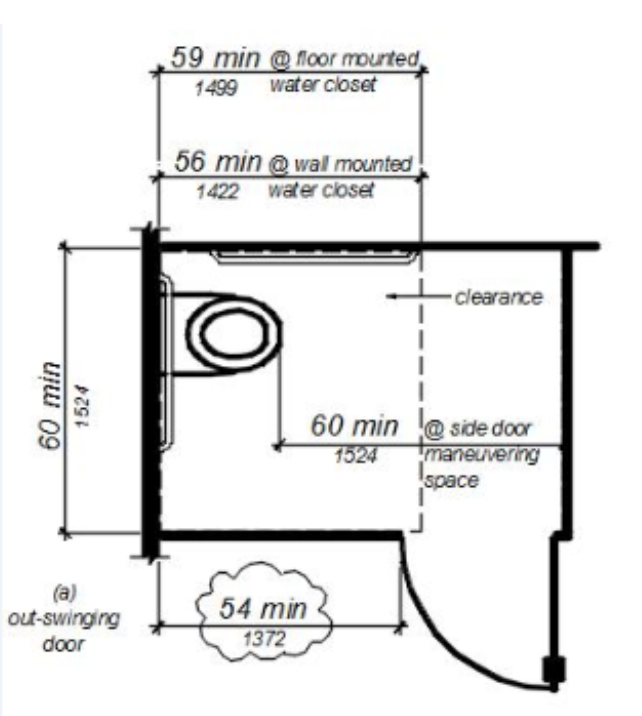
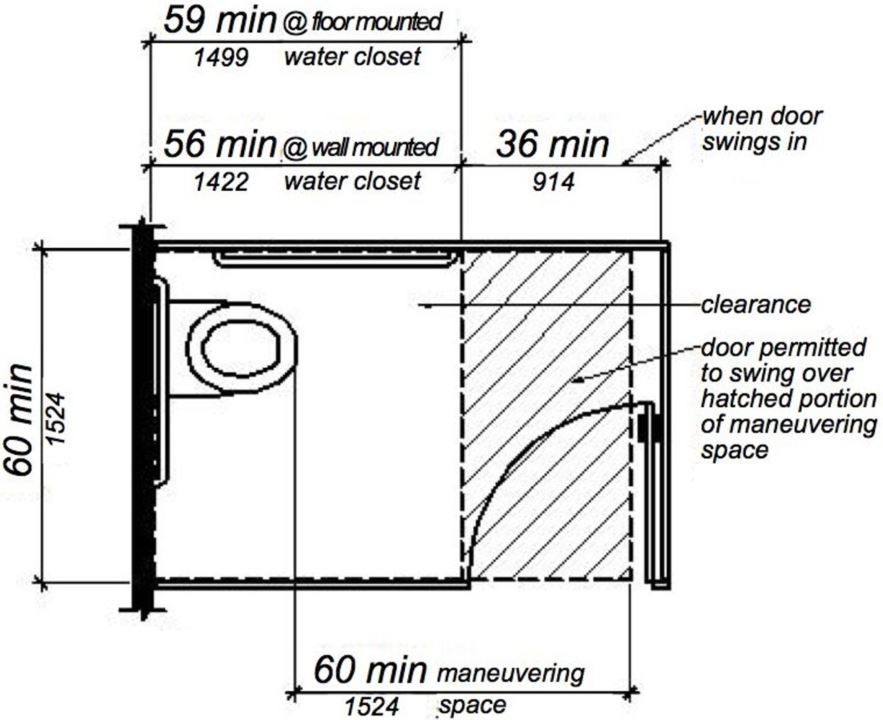
(b) in-swinging door
FIGURE 11B-604.8.1.1.2 MANEUVERING SPACE WITH SIDE-OPENING DOOR ‡‡
11B-604.8.1.1.3 Maneuvering space with end-opening door.
In a wheelchair accessible compartment with a door located in the front wall or partition (facing the water closet), either in-swinging or out-swinging, a minimum 60 inches (1524 mm) wide and 48 inches (1219 mm) deep maneuvering space shall be provided in front of the water closet. See Figure 11B-604.8.1.1.3.
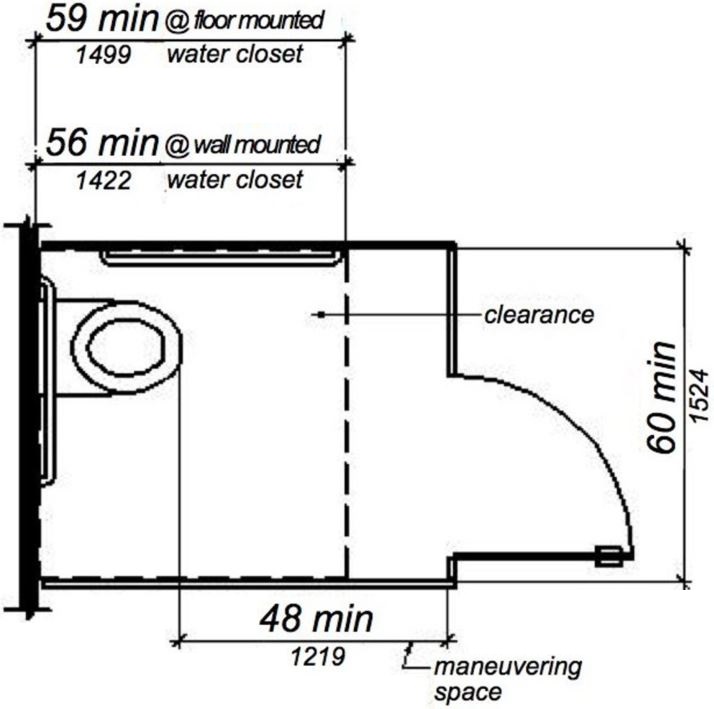
(a) out-swinging door
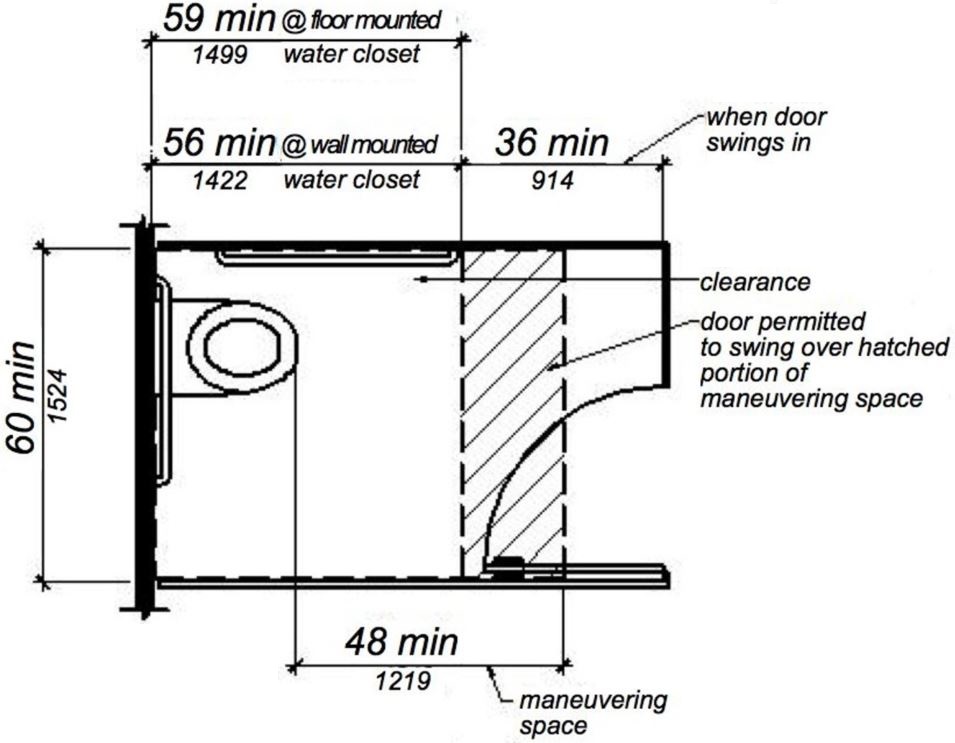
(b) in-swinging door
FIGURE 11B-604.8.1.1.3 MANEUVERING SPACE WITH END-OPENING DOOR ‡‡
Toilet compartment doors, including door hardware, shall comply with Section 11B-404 except that if the approach is from the push side of the compartment door, clearance between the door side of the compartment and any obstruction shall be 48 inches (1219 mm) minimum measured perpendicular to the compartment door in its closed position. Doors shall be located in the front partition or in the side wall or partition farthest from the water closet. Where located in the front partition, the door opening shall be 4 inches (102 mm) maximum from the side wall or partition farthest from the water closet. Where located in the side wall or partition, the door opening shall be farthest from the water closet and shall be 54 inches (1372 mm) minimum from the rear wall. Where located in the side wall or partition, the door opening shall be 4 inches (102 mm) maximum from the front partition. The door shall be self-closing. A door pull complying with Section 11B-404.2.7 shall be placed on both sides of the door near the latch. Doors shall not swing into the clear floor space or clearance required for any fixture. Doors may swing into that portion of maneuvering space which does not overlap the clearance required at a water closet.
[2010 ADA Standards] 604.8.1.2 Doors. Toilet compartment doors, including door hardware, shall comply with 404 except that if the approach is to the latch side of the compartment door, clearance between the door side of the compartment and any obstruction shall be 42 inches (1065 mm) minimum. Doors shall be located in the front partition or in the side wall or partition farthest from the water closet. Where located in the front partition, the door opening shall be 4 inches (100 mm) maximum from the side wall or partition farthest from the water closet. Where located in the side wall or partition, the door opening shall be 4 inches (100 mm) maximum from the front partition. The door shall be self-closing. A door pull complying with 404.2.7 shall be placed on both sides of the door near the latch. Toilet compartment doors shall not swing into the minimum required compartment area.
Exception: When located at the side of a toilet compartment, the toilet compartment door opening shall provide a clear width of 34 inches (864 mm) minimum.

The door is required to have a latch which is flip-over style, sliding or which otherwise does not require the user to grasp or twist. This is to facilitate latching the door by people with limited hand or finger dexterity.
The last part of this item addresses the required maneuvering space at the compartment door. This space is required to comply with requirements for door maneuvering space in Section 11B-404.2.4, except the space in front of the door shall be no less than 48 inches deep, measured perpendicular to the closed door. Where Figure 11B-404.2.4.1 (f) and (j), specifically allow a 44” minimum maneuvering space perpendicular to doors in general in the closed position, a minimum of 48” must be provided in order to comply with Section 11B-604.8.1.2.
Note that in Figure 11B-404.2.4.1 (c) the front approach requires 12 inches of strike-side clearance on the push side where a door has both a latch and a closer. However, the US Department of Justice has indicated that a self-closing compartment door with a gravity hinge is not considered to be a door with a closer; hence the 12-inch clearance would not be required in this type of design. ◼
ETA Editor's Note
For wheelchair accessible compartments with in-swinging doors, the compartment size required by CBC is nominally the same as required by 2010 ADA Standards. For compartments with out-swinging doors, 2019 CBC requires larger compartments than 2010 ADA Standards due to the 48” minimum maneuvering space required in front of the water closet by 11B-604.8.1.1.3.
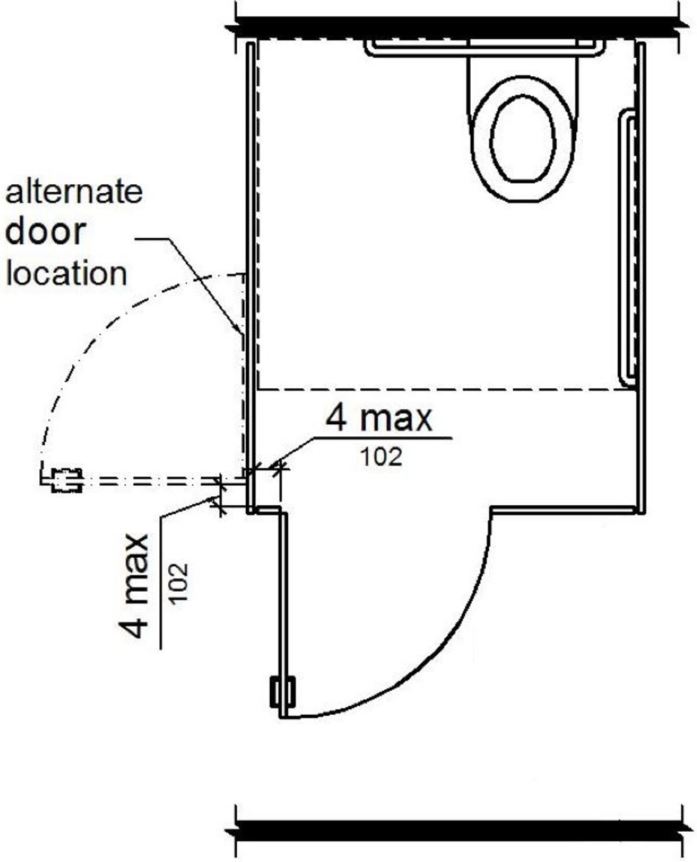
FIGURE 11B-604.8.1.2 WHEELCHAIR ACCESSIBLE TOILET COMPARTMENT DOORS ‡‡
Compartments shall be arranged for left-hand or right-hand approach to the water closet.
At least one side partition shall provide a toe clearance of 9 inches (229 mm) minimum above the finish floor and 6 inches (152 mm) deep minimum beyond the compartment-side face of the partition, exclusive of partition support members. Partition components at toe clearances shall be smooth without sharp edges or abrasive surfaces. Compartments for children’s use shall provide a toe clearance of 12 inches (305 mm) minimum above the finish floor.
[2010 ADA Standards] 604.8.1.4 Toe Clearance. The front partition and at least one side partition shall provide a toe clearance of 9 inches (230 mm) minimum above the finish floor and 6 inches (150 mm) deep minimum beyond the compartment-side face of the partition, exclusive of partition support members. Compartments for children’s use shall provide a toe clearance of 12 inches (305 mm) minimum above the finish floor.
Exception: Toe clearance at the side partition is not required in a compartment greater than 66 inches (1676 mm) wide.
[2010 ADA Standards] EXCEPTION: Toe clearance at the front partition is not required in a compartment greater than 62 inches deep with a wall-hung water closet or 65 inches deep with a floor-mounted water closet. Toe clearance at the side partition is not required in a compartment greater than 66 inches (1675 mm) wide. Toe clearance at the front partition is not required in a compartment for children’s use that is greater than 65 inches deep.
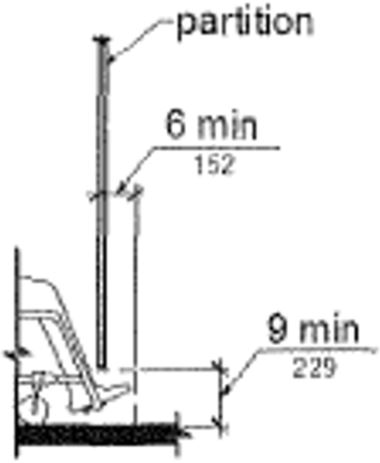
(a) elevation adult
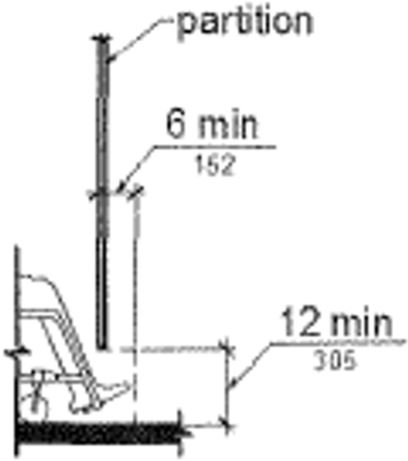
(b) elevation children
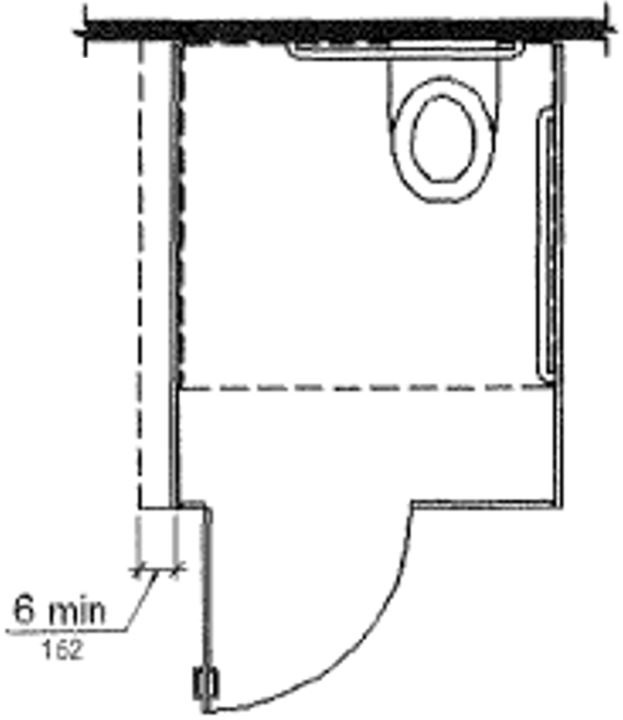
(c) plan
FIGURE 11B-604.8.1.4 WHEELCHAIR ACCESSIBLE TOILET COMPARTMENT TOE CLEARANCE ‡‡
Grab bars shall comply with Section 11B-609. A side-wall grab bar complying with Section 11B-604.5.1 shall be provided and shall be located on the wall closest to the water closet. In addition, a rear-wall grab bar complying with Section 11B-604.5.2 shall be provided. Where separate grab bars are required on adjacent walls at a common mounting height, an L-shaped grab bar meeting the dimensional requirements of Sections 11B-604.5.1 and 11B-604.5.2 shall be permitted.
[2010 ADA Standards] 604.8.1.5 Grab Bars. Grab bars shall comply with 609. A side-wall grab bar complying with 604.5.1 shall be provided and shall be located on the wall closest to the water closet. In addition, a rear-wall grab bar complying with 604.5.2 shall be provided.
11B-604.8.2 Ambulatory accessible compartments.
Ambulatory accessible compartments shall comply with Section 11B-604.8.2.
Ambulatory accessible compartments shall have a depth of 60 inches (1524 mm) minimum and a width of 35 inches (889 mm) minimum and 37 inches (940 mm) maximum.
Toilet compartment doors, including door hardware, shall comply with Section 11B-404, except that if the approach is to the latch side of the compartment door, clearance between the door side of the compartment and any obstruction shall be 44 inches (1118 mm) minimum. The door shall be self-closing. A door pull complying with Section 11B-404.2.7 shall be placed on both sides of the door near the latch. Toilet compartment doors shall not swing into the minimum required compartment area.
[2010 ADA Standards] 604.8.2.2 Doors. Toilet compartment doors, including door hardware, shall comply with 404, except that if the approach is to the latch side of the compartment door, clearance between the door side of the compartment and any obstruction shall be 42 inches (1065 mm) minimum. The door shall be self-closing. A door pull complying with 404.2.7 shall be placed on both sides of the door near the latch. Toilet compartment doors shall not swing into the minimum required compartment area.
Grab bars shall comply with Section 11B-609. A side-wall grab bar complying with Section 11B-604.5.1 shall be provided on both sides of the compartment.
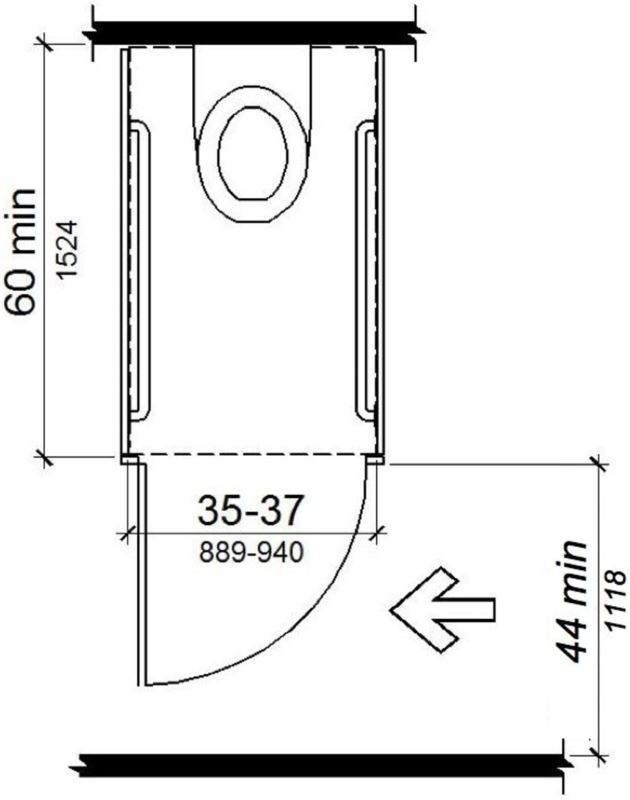
FIGURE 11B-604.8.2 AMBULATORY ACCESSIBLE TOILET COMPARTMENT ‡‡
11B-604.8.3 Coat hooks and shelves.
Coat hooks shall be located within one of the reach ranges specified in Section 11B-308. Shelves shall be located 40 inches (1016 mm) minimum and 48 inches (1219 mm) maximum above the finish floor.
11B-604.9 Water closets and toilet compartments for children's use.
Water closets and toilet compartments for children's use shall comply with Section 11B-604.9. When the exception in Section 11B-604.1 is used, the suggested dimensions of Table 11B-604.9 for a single age group shall be applied consistently to the installation of a water closet and all associated components.

TABLE 11B-604.9 SUGGESTED DIMENSIONS FOR CHILDREN’S USE
|
Suggested Dimensions For Water Closets Serving Children Ages 3 Through 12 |
|||
|---|---|---|---|
| Ages 3 and 4 | Ages 5 through 8 |
Ages 9 through 12 |
|
|
Water Closet Centerline |
12 inches (305 mm) |
12 to 15 inches (305 to 381 mm) |
15 to 18 inches (381 to 457 mm) |
|
Toilet Seat Height |
11 to 12 inches (279 to 305 mm) | 12 to 15 inches (305 to 381 mm) |
15 to 17 inches (381 to 432 mm) |
|
Grab Bar Height |
18 to 20 inches (457 to 508 mm) | 20 to 25 inches (508 to 635 mm) |
25 to 27 inches (635 to 686 mm) |
|
Dispenser Height |
14 inches (356 mm) | 14 to 17 inches (356 to 432 mm) |
17 to 19 inches (432 to 483 mm) |
11B-604.9.1 Location.
The water closet shall be located with a wall or partition to the rear and to one side. The centerline of the water closet shall be 12 inches (305 mm) minimum and 18 inches (457 mm) maximum from the side wall or partition, except that the water closet shall be 17 inches (432 mm) minimum and 19 inches (483 mm) maximum from the side wall or partition in the ambulatory accessible toilet compartment specified in Section 11B-604.8.2. Compartments shall be arranged for left-hand or right-hand approach to the water closet.
11B-604.9.2 Clearance.
Clearance around a water closet shall comply with Section 11B-604.3.
11B-604.9.3 Height.
The height of water closets shall be 11 inches (279 mm) minimum and 17 inches (432 mm) maximum measured to the top of the seat. Seats shall not be sprung to return to a lifted position.
11B-604.9.4 Grab bars.
Grab bars for water closets shall comply with Section 11B-604.5.
11B-604.9.5 Flush controls.
Flush controls shall be hand operated or automatic. Hand operated flush controls shall comply with Sections 11B-309.2 and 11B-309.4 and shall be installed 36 inches (914 mm) maximum above the finish floor. Flush controls shall be located on the open side of the water closet except in ambulatory accessible compartments complying with Section 11B-604.8.2.
11B-604.9.6 Dispensers.
Toilet paper dispensers shall comply with Section 11B-309.4 and shall be 7 inches (178 mm) minimum and 9 inches (229 mm) maximum in front of the water closet measured to the centerline of the dispenser. The outlet of the dispenser shall be 14 inches (356 mm) minimum and 19 inches (483 mm) maximum above the finish floor. There shall be a clearance of 1½ inches (38 mm) minimum below the grab bar. Dispensers shall not be of a type that controls delivery or that does not allow continuous paper flow.
11B-604.9.7 Toilet Compartments.
Toilet compartments shall comply with Section 11B-604.8.
11B-605.1 General.
Urinals shall comply with Section 11B-605.

11B-605.2 Height and depth.
Urinals shall be the stall-type or the wall-hung type with the rim 17 inches (432 mm) maximum above the finish floor or ground. Urinals shall be 13½ inches (343 mm) deep minimum measured from the outer face of the urinal rim to the back of the fixture.
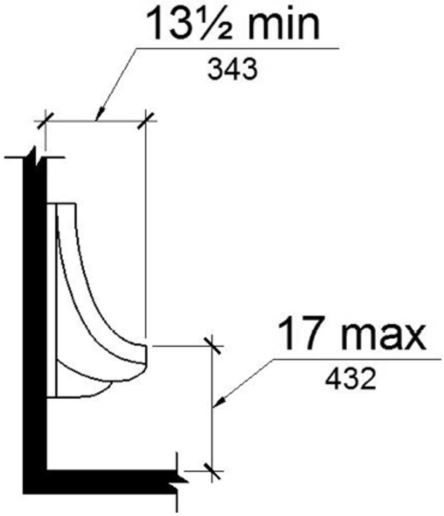
(a) wall hung type
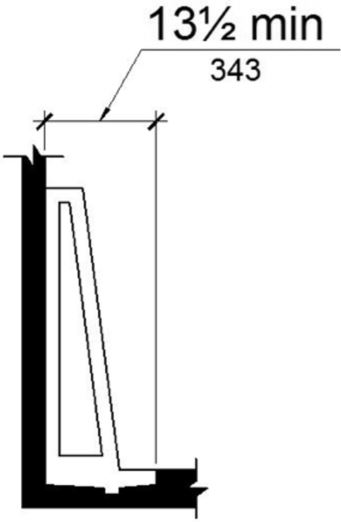
(b) stall type
FIGURE 11B-605.2 HEIGHT AND DEPTH OF URINALS
11B-605.3 Clear floor space.
A clear floor or ground space complying with Section 11B-305 positioned for forward approach shall be provided.
11B-605.4 Flush controls.
Flush controls shall be hand operated or automatic. Hand operated flush controls shall comply with Section 11B-309 except that the flush control shall be mounted at a maximum height of 44 inches (1118 mm) above the finish floor.
[2010 ADA Standards] 605.4 Flush Controls. Flush controls shall be hand operated or automatic. Hand operated flush controls shall comply with 309.
11B-606.1 General.
Lavatories and sinks shall comply with Section 11B-606.

11B-606.2 Clear floor space.
A clear floor space complying with Section 11B-305, positioned for a forward approach, and knee and toe clearance complying with Section 11B-306 shall be provided.
Exceptions:
1. A parallel approach complying with Section 11B-305 shall be permitted to a kitchen sink in a space where a cook top or conventional range is not provided and to wet bars.
2. Reserved.
[2010 ADA Standards] 2. A lavatory in a toilet room or bathing facility for a single occupant accessed only through a private office and not for common use or public use shall not be required to provide knee and toe clearance complying with 306.
3. In residential dwelling units, cabinetry shall be permitted under lavatories and kitchen sinks provided that all of the following conditions are met:
(a) the cabinetry can be removed without removal or replacement of the fixture;
(b) the finish floor extends under the cabinetry; and
(c) the walls behind and surrounding the cabinetry are finished.
4. A knee clearance of 24 inches (610 mm) minimum above the finish floor or ground shall be permitted at lavatories and sinks used primarily by children 6 through 12 years where the rim or counter surface is 31 inches (787 mm) maximum above the finish floor or ground.
5. A parallel approach complying with Section 11B-305 shall be permitted to lavatories and sinks used primarily by children 5 years and younger.
6. The dip of the overflow shall not be considered in determining knee and toe clearances.
7. No more than one bowl of a multi-bowl sink shall be required to provide knee and toe clearance complying with Section 11B-306.
11B-606.3 Height.
Lavatories and sinks shall be installed with the front of the higher of the rim or counter surface 34 inches (864 mm) maximum above the finish floor or ground.
ETA Editor's Note
Top-mounted sinks installed in counters having the top surface 34 inches above the floor will exceed the maximum rim height allowed, regardless of how thin the flange may be.
Exceptions:
1. Reserved.
[2010 ADA Standards] 1. A lavatory in a toilet or bathing facility for a single occupant accessed only through a private office and not for common use or public use shall not be required to comply with 606.3.
2. In residential dwelling unit kitchens, sinks that are adjustable to variable heights, 29 inches (737 mm) minimum and 36 inches (914 mm) maximum, shall be permitted where rough-in plumbing permits connections of supply and drain pipes for sinks mounted at the height of 29 inches (737 mm).
11B-606.4 Faucets.
Controls for faucets shall comply with Section 11B-309. Hand-operated metering faucets shall remain open for 10 seconds minimum.
11B-606.5 Exposed pipes and surfaces.
Water supply and drain pipes under lavatories and sinks shall be insulated or otherwise configured to protect against contact. There shall be no sharp or abrasive surfaces under lavatories and sinks.
11B-606.6 Adjacent side wall or partition.
Lavatories, when located adjacent to a side wall or partition, shall be a minimum of 18 inches (457 mm) to the centerline of the fixture.
ETA Editor's Note
The positioning requirement prescribed by CBC 11B-606.6 applies to lavatories, not to sinks. However, some Local Building Officials or other Authorities Having Jurisdiction may apply it to both. See the foregoing ETA Editor's Note at 11B-212.3 regarding the difficulties of distinguishing fixture types and the applicable technical requirements.
11B-606.7 Sink depth.
Where a forward approach is required at a sink, knee and toe clearance shall be provided in compliance with Section 11B-306.
11B-607.1 General.
Bathtubs shall comply with Section 11B-607.
11B-607.2 Clearance.
Clearance in front of bathtubs shall extend the length of the bathtub and shall be 48 inches (1219 mm) wide minimum for forward approach and 30 inches (762 mm) wide minimum for parallel approach. A lavatory complying with Section 11B-606 shall be permitted at the control end of the clearance. Where a permanent seat is provided at the head end of the bathtub, the clearance shall extend 12 inches (305 mm) minimum beyond the wall at the head end of the bathtub.
[2010 ADA Standards] 607.2 Clearance. Clearance in front of bathtubs shall extend the length of the bathtub and shall be 30 inches (760 mm) wide minimum. A lavatory complying with 606 shall be permitted at the control end of the clearance. Where a permanent seat is provided at the head end of the bathtub, the clearance shall extend 12 inches (305 mm) minimum beyond the wall at the head end of the bathtub.
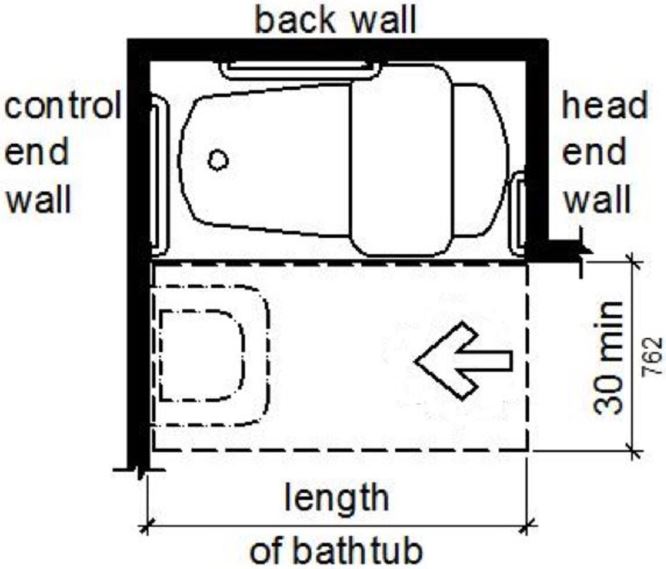
(a) removable in-tub seat
parallel approach
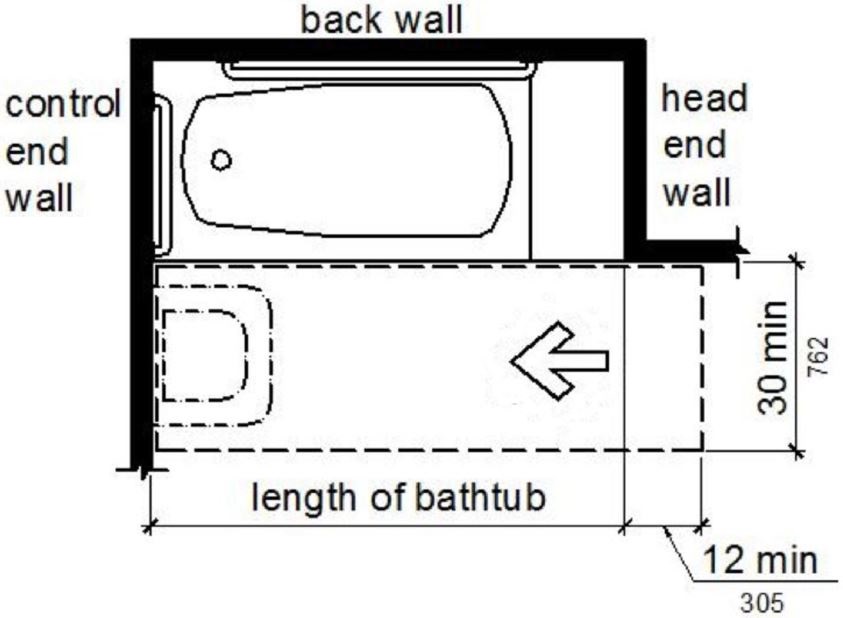
(b) permanent seat
parallel approach
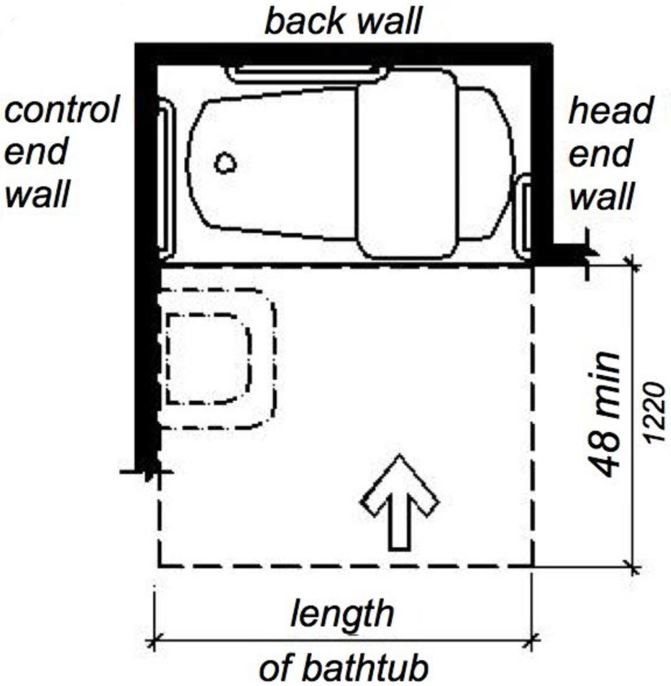
(c) removable in-tub seat
forward approach
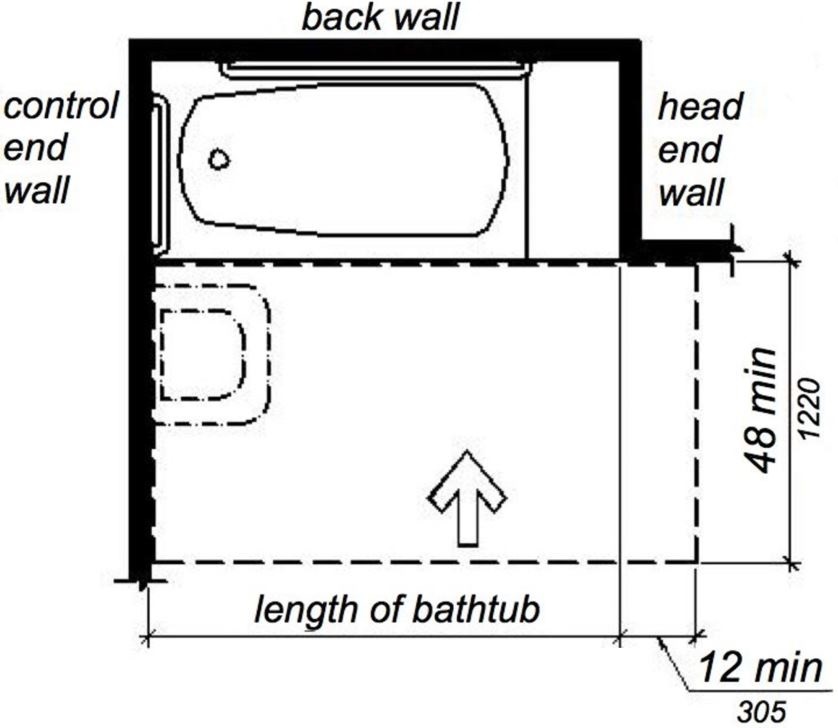
(d) permanent seat
forward approach
FIGURE 11B-607.2 CLEARANCE FOR BATHTUBS ‡‡
11B-607.3 Seat.
A permanent seat at the head end of the bathtub or a removable in-tub seat shall be provided. Seats shall comply with Section 11B-610.
11B-607.4 Grab bars.
Grab bars for bathtubs shall comply with Section 11B-609 and shall be provided in accordance with Section 11B-607.4.1 or 11B-607.4.2. Where separate grab bars are required on adjacent walls at a common mounting height, an L-shaped or U-shaped grab bar meeting the dimensional requirements of Section 11B-607.4.1 or 11B-607.4.2 shall be permitted.
[2010 ADA Standards] 607.4 Grab Bars. Grab bars for bathtubs shall comply with 609 and shall be provided in accordance with 607.4.1 or 607.4.2.
Exceptions:
1. Reserved.
[2010 ADA Standards] 1. Grab bars shall not be required to be installed in a bathtub located in a bathing facility for a single occupant accessed only through a private office and not for common use or public use provided that reinforcement has been installed in walls and located so as to permit the installation of grab bars complying with 607.4.
2. In residential dwelling units, grab bars shall not be required to be installed in bathtubs located in bathing facilities provided that reinforcement has been installed in walls and located so as to permit the installation of grab bars complying with Section 11B-607.4.
11B-607.4.1 Bathtubs with permanent seats.
For bathtubs with permanent seats, grab bars shall be provided in accordance with Section 11B-607.4.1.
Two grab bars shall be installed on the back wall, one located in accordance with Section 11B-609.4 and the other located 8 inches (203 mm) minimum and 10 inches (254 mm) maximum above the rim of the bathtub. Each grab bar shall be installed 15 inches (381 mm) maximum from the head end wall and 12 inches (305 mm) maximum from the control end wall.
11B-607.4.1.2 Control end wall.
A grab bar 24 inches (610 mm) long minimum shall be installed on the control end wall at the front edge of the bathtub.
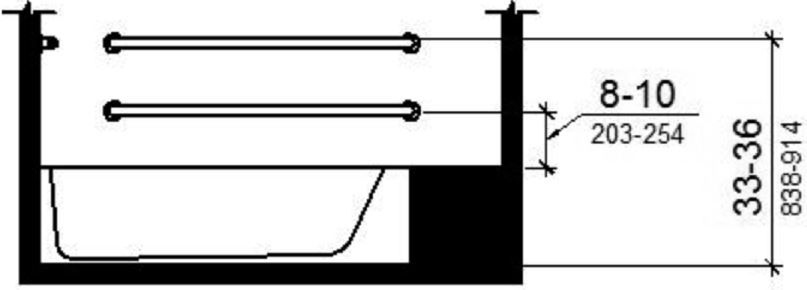
(a) elevation
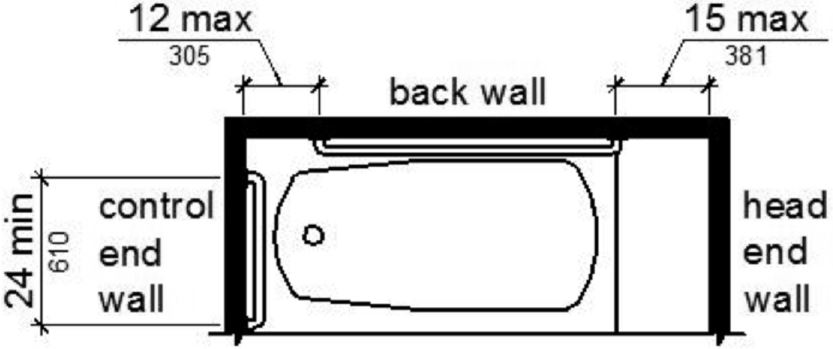
(b) plan
FIGURE 11B-607.4.1 GRAB BARS FOR BATHTUBS WITH PERMANENT SEATS
11B-607.4.2 Bathtubs without permanent seats.
For bathtubs without permanent seats, grab bars shall comply with Section 11B-607.4.2.
Two grab bars shall be installed on the back wall, one located in accordance with Section 11B-609.4 and the other located 8 inches (203 mm) minimum and 10 inches (254 mm) maximum above the rim of the bathtub. Each grab bar shall be 24 inches (610 mm) long minimum and shall be installed 24 inches (610 mm) maximum from the head end wall and 12 inches (305 mm) maximum from the control end wall.
11B-607.4.2.2 Control end wall.
A grab bar 24 inches (610 mm) long minimum shall be installed on the control end wall at the front edge of the bathtub.
A grab bar 12 inches (305 mm) long minimum shall be installed on the head end wall at the front edge of the bathtub.
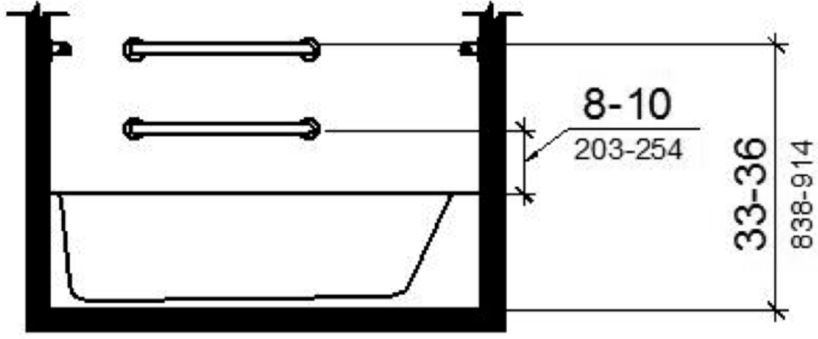
(a) elevation
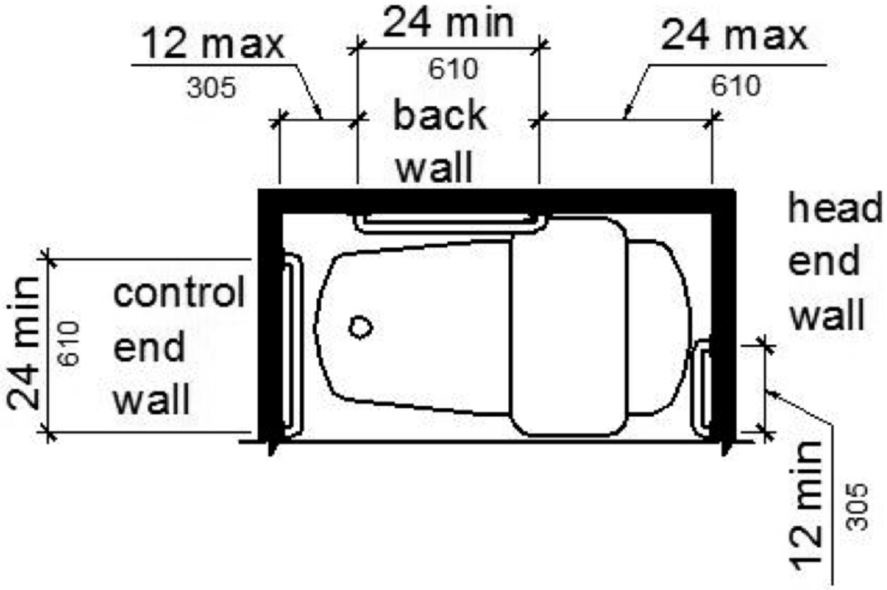
(b) plan
FIGURE 11B-607.4.2 GRAB BARS FOR BATHTUBS WITH REMOVABLE IN-TUB SEATS
11B-607.5 Controls.
Controls, other than drain stoppers, shall be located on an end wall. Controls shall be between the bathtub rim and grab bar, and between the open side of the bathtub and the centerline of the width of the bathtub. Controls shall comply with Section 11B-309.4.
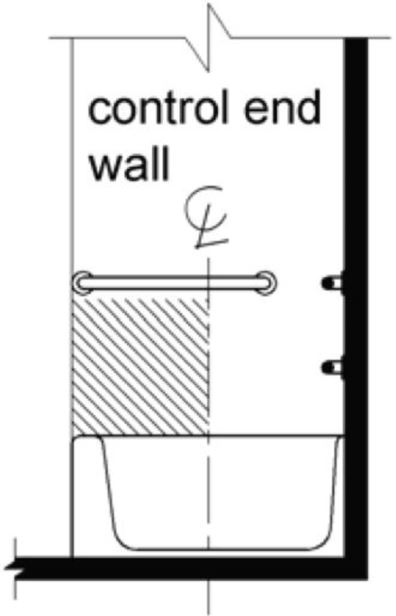
FIGURE 11B-607.5 BATHTUB CONTROL LOCATION
11B-607.6 Shower spray unit and water.
A shower spray unit with a hose 59 inches (1499 mm) long minimum that can be used both as a fixed-position shower head and as a hand-held shower shall be provided. The shower spray unit shall have an on/off control with a non-positive shut-off. If an adjustable-height shower head on a vertical bar is used, the bar shall be installed so as not to obstruct the use of grab bars. Bathtub shower spray units shall deliver water that is 120°F (49°C) maximum.

11B-607.7 Bathtub enclosures.
Enclosures for bathtubs shall not obstruct controls, faucets, shower and spray units or obstruct transfer from wheelchairs onto bathtub seats or into bathtubs. Enclosures on bathtubs shall not have tracks installed on the rim of the open face of the bathtub.
11B-608.1 General.
Shower compartments shall comply with Section 11B-608.

11B-608.2 Size and clearances for shower compartments.
Shower compartments shall have sizes and clearances complying with Section 11B-608.2.
11B-608.2.1 Transfer type shower compartments.
Transfer type shower compartments shall be 36 inches (914 mm) by 36 inches (914 mm) clear inside dimensions measured at the center points of opposing sides and shall have a 36 inch (914 mm) wide minimum entry on the face of the shower compartment. Clearance of 36 inches (914 mm) wide minimum by 48 inches (1219 mm) long minimum measured from the control wall shall be provided. Transfer type shower compartments shall be permitted in transient lodging guest rooms, multibedroom housing units in undergraduate student housing and residential dwelling units; and shall not be permitted at other locations to meet the requirements of Section 11B-213.3.6.
[2010 ADA Standards] 608.2.1 Transfer Type Shower Compartments. Transfer type shower compartments shall be 36 inches (915 mm) by 36 inches (915 mm) clear inside dimensions measured at the center points of opposing sides and shall have a 36 inch (915 mm) wide minimum entry on the face of the shower compartment. Clearance of 36 inches (915 mm) wide minimum by 48 inches (1220 mm) long minimum measured from the control wall shall be provided.
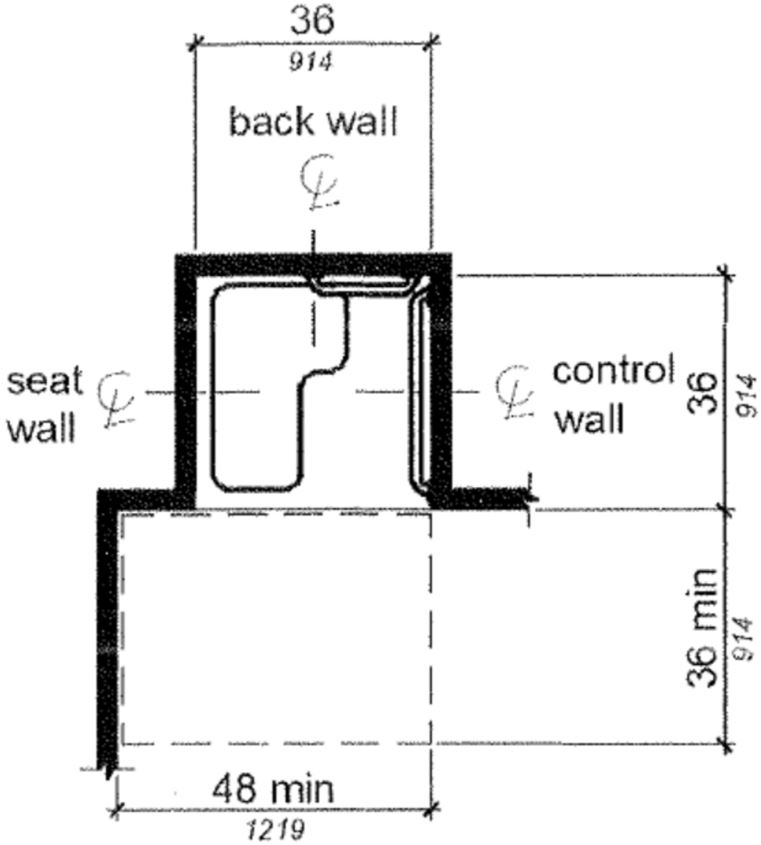
FIGURE 11B-608.2.1 TRANSFER TYPE SHOWER COMPARTMENT SIZE AND CLEARANCE
11B-608.2.2 Standard roll-in type shower compartments.
Standard roll-in type shower compartments shall be 30 inches (762 mm) wide minimum by 60 inches (1524 mm) deep minimum clear inside dimensions measured at center points of opposing sides with a full opening width on the long side.
[2010 ADA Standards] 608.2.2 Standard Roll-In Type Shower Compartments. Standard roll-in type shower compartments shall be 30 inches (760 mm) wide minimum by 60 inches (1525 mm) deep minimum clear inside dimensions measured at center points of opposing sides and shall have a 60 inches (1525 mm) wide minimum entry on the face of the shower compartment.
A 36 inch (914 mm) wide minimum by 60 inch (1524 mm) long minimum clearance shall be provided adjacent to the open face of the shower compartment.
[2010 ADA Standards] 608.2.2.1 Clearance. A 30 inch (760 mm) wide minimum by 60 inch (1525 mm) long minimum clearance shall be provided adjacent to the open face of the shower compartment.
Exception: Reserved.
[2010 ADA Standards] EXCEPTION: A lavatory complying with 606 shall be permitted on one 30 inch (760 mm) wide minimum side of the clearance provided that it is not on the side of the clearance adjacent to the controls or, where provided, not on the side of the clearance adjacent to the shower seat.
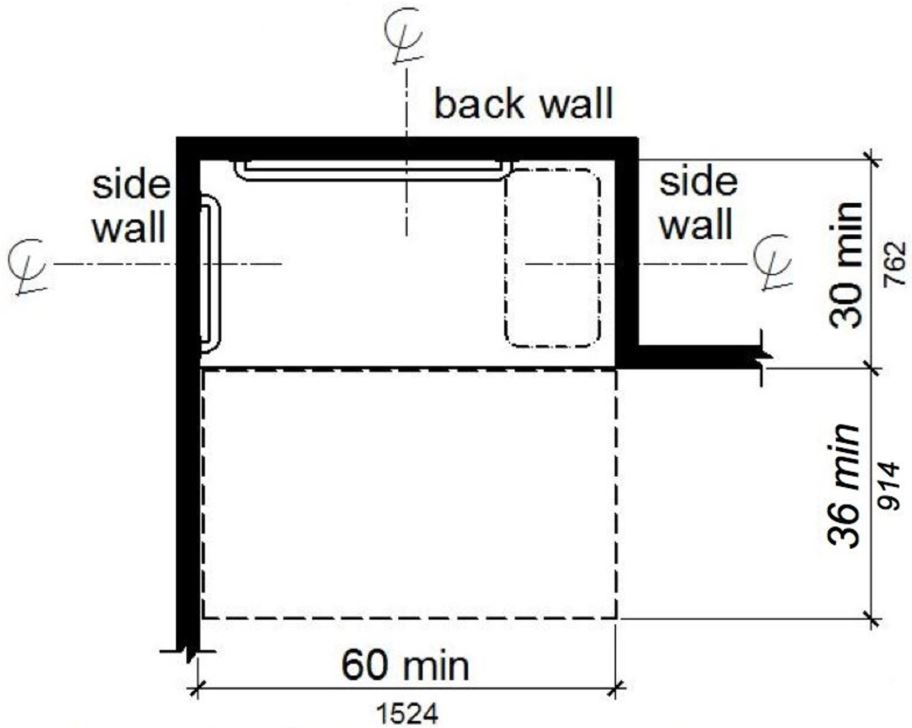
Note: inside finished dimensions measured at the center points of opposing sides.
FIGURE 11B-608.2.2 STANDARD ROLL-IN TYPE SHOWER COMPARTMENT SIZE AND CLEARANCE ‡‡
11B-608.2.3 Alternate roll-in type shower compartments.
Alternate roll-in type shower compartments shall be 36 inches (914 mm) wide and 60 inches (1524 mm) deep minimum clear inside dimensions measured at center points of opposing sides. A 36 inch (914 mm) wide minimum entry shall be provided at one end of the long side of the compartment.
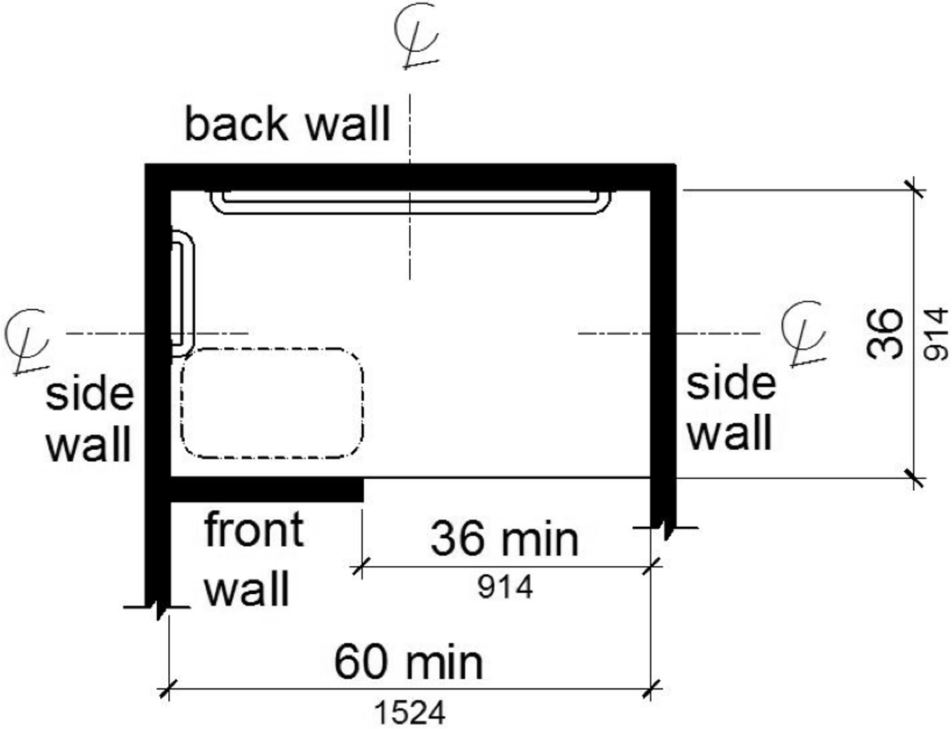
Note: inside finished dimensions measured at the center points of opposing sides.
FIGURE 11B-608.2.3 ALTERNATE ROLL-IN TYPE SHOWER COMPARTMENT SIZE AND CLEARANCE
11B-608.3 Grab bars.
Grab bars shall comply with Section 11B-609 and shall be provided in accordance with Section 11B-608.3. Where multiple grab bars are used, required horizontal grab bars shall be installed at the same height above the finish floor. Where separate grab bars are required on adjacent walls at a common mounting height, an L-shaped or U-shaped grab bar meeting the dimensional requirements of Section 11B-608.3.2 or 11B-608.3.3 shall be permitted.
[2010 ADA Standards] 608.3 Grab Bars. Grab bars shall comply with 609 and shall be provided in accordance with 608.3. Where multiple grab bars are used, required horizontal grab bars shall be installed at the same height above the finish floor.
Exceptions:
1. Reserved.
[2010 ADA Standards] 1. Grab bars shall not be required to be installed in a shower located in a bathing facility for a single occupant accessed only through a private office, and not for common use or public use provided that reinforcement has been installed in walls and located so as to permit the installation of grab bars complying with 608.3.
2. In residential dwelling units, grab bars shall not be required to be installed in showers located in bathing facilities provided that reinforcement has been installed in walls and located so as to permit the installation of grab bars complying with Section 11B-608.3.
11B-608.3.1 Transfer type shower compartments.
In transfer type compartments, grab bars shall be provided across the control wall and back wall to a point 18 inches (457 mm) from the control wall.
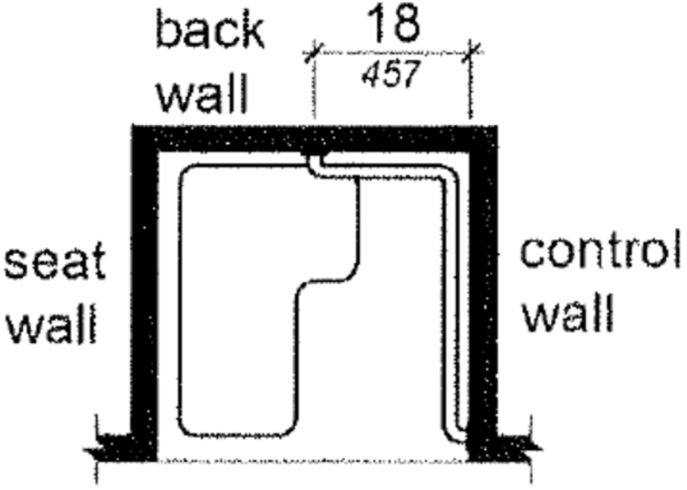
FIGURE 11B-608.3.1 GRAB BARS FOR TRANSFER TYPE SHOWERS
11B-608.3.2 Standard roll-in type shower compartments.
Grab bars shall be provided on the back wall and the side wall opposite the seat. Grab bars shall not be provided above the seat. Grab bars shall be installed 6 inches (152 mm) maximum from adjacent walls.
[2010 ADA Standards] 608.3.2 Standard Roll-In Type Shower Compartments. Where a seat is provided in standard roll-in type shower compartments, grab bars shall be provided on the back wall and the side wall opposite the seat. Grab bars shall not be provided above the seat. Where a seat is not provided in standard roll-in type shower compartments, grab bars shall be provided on three walls. Grab bars shall be installed 6 inches (150 mm) maximum from adjacent walls.
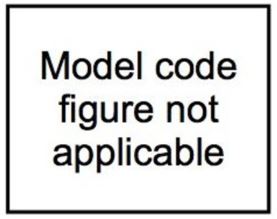
(a) reserved
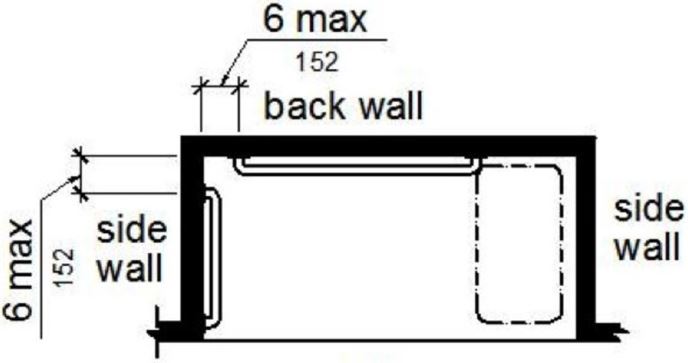
(b) with seat
FIGURE 11B-608.3.2 GRAB BARS FOR STANDARD ROLL-IN TYPE SHOWER ‡‡
11B-608.3.3 Alternate roll-in type shower compartments.
In alternate roll-in type shower compartments, grab bars shall be provided on the back wall and the side wall farthest from the compartment entry. Grab bars shall not be provided above the seat. Grab bars shall be installed 6 inches (152 mm) maximum from adjacent walls.
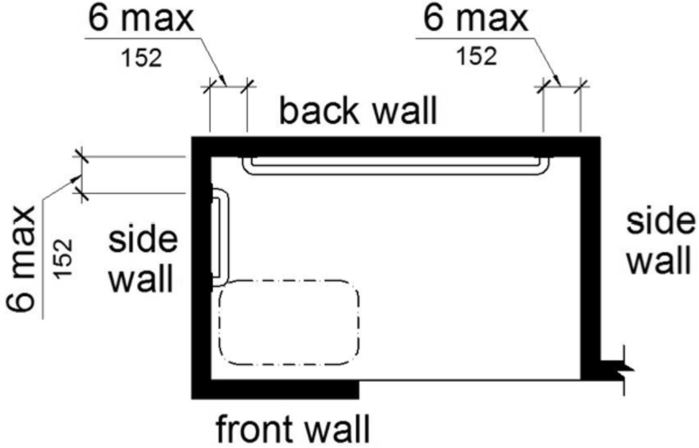
FIGURE 11B-608.3.3 GRAB BARS FOR ALTERNATE ROLL-IN TYPE SHOWERS
11B-608.4 Seats.
A folding seat shall be provided in roll-in type showers and transfer type shower compartments. Seats shall comply with Section 11B-610.
[2010 ADA Standards] 608.4 Seats. A folding or non-folding seat shall be provided in transfer type shower compartments. A folding seat shall be provided in roll-in type showers required in transient lodging guest rooms with mobility features complying with 806.2. Seats shall comply with 610.
Exception: In residential dwelling units, seats shall not be required in shower compartments provided that reinforcement has been installed in walls so as to permit the installation of seats complying with Section 11B-608.4.
ETA Editor's Note
Unlike 2010 ADA Standards, CBC requires a folding seat at all accessible showers, unless the Exception above is applicable.
11B-608.5 Controls.
Controls, faucets, and shower spray units shall comply with Section 11B-309.4. Controls and faucets shall allow the user to close and open the water supply.
[2010 ADA Standards] 608.5 Controls. Controls, faucets, and shower spray units shall comply with 309.4.
11B-608.5.1 Transfer type shower compartments.
In transfer type shower compartments, the controls, faucets, and shower spray unit shall be installed on the side wall opposite the seat 38 inches (965 mm) minimum and 48 inches (1219 mm) maximum above the shower floor and shall be located on the control wall 15 inches (380 mm) maximum from the centerline of the seat toward the shower opening.
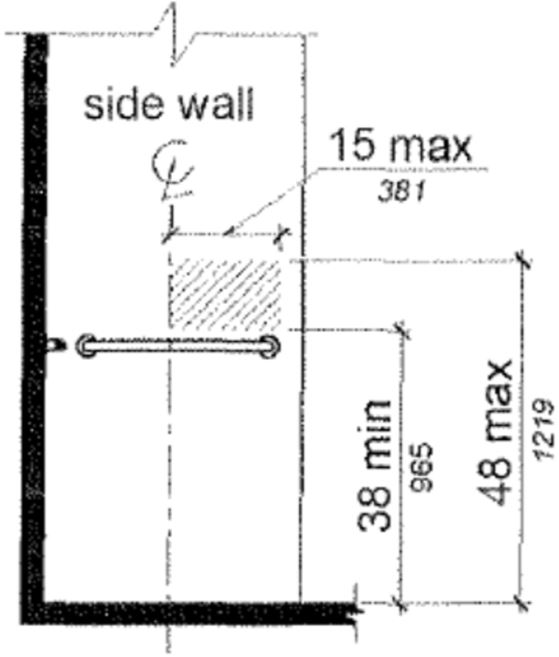
FIGURE 11B-608.5.1 TRANSFER TYPE SHOWER COMPARTMENT CONTROL LOCATION
11B-608.5.2 Standard roll-in type shower compartments.
In standard roll-in type shower compartments, the controls, faucets, and the shower spray unit shall be located on the back wall of the compartment adjacent to the seat 16 inches (406 mm) minimum and 27 inches (686 mm) maximum from the seat wall; and shall be located above the grab bar, but no higher than 48 inches (1219 mm) above the shower floor.
[2010 ADA Standards] 608.5.2 Standard Roll-In Type Shower Compartments. In standard roll-in type shower compartments, the controls, faucets, and shower spray unit shall be located above the grab bar, but no higher than 48 inches (1220 mm) above the shower floor. Where a seat is provided, the controls, faucets, and shower spray unit shall be installed on the back wall adjacent to the seat wall and shall be located 27 inches (685 mm) maximum from the seat wall.
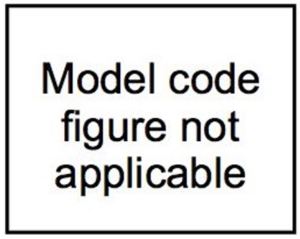
(a) reserved
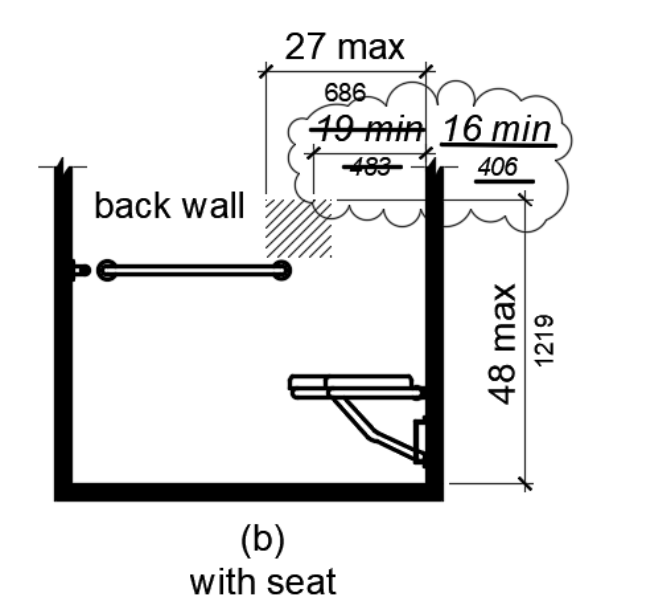
(b) with seat
FIGURE 11B-608.5.2
STANDARD ROLL-IN TYPE SHOWER COMPARTMENT CONTROL LOCATION
ETA Editor's Note
The CBC requirements for positioning controls in standard roll-in shower compartments are more restrictive than 2010 ADA Standards.
11B-608.5.3 Alternate roll-in type shower compartments.
In alternate roll-in type shower compartments, the controls, faucets, and shower spray unit shall be located on the side wall of the compartment adjacent to the 16 inches (406 mm) minimum and 27 inches (686 mm) maximum from the seat wall or shall be located on the back wall opposite the seat 15 inches (381 mm) maximum, left or right of the centerline of the seat. The controls, faucets, and shower spray units shall be located above the grab bar, but no higher than 48 inches (1219 mm) above the shower floor.
[2010 ADA Standards] 608.5.3 Alternate Roll-In Type Shower Compartments. In alternate roll-in type shower compartments, the controls, faucets, and shower spray unit shall be located above the grab bar, but no higher than 48 inches (1220 mm) above the shower floor. Where a seat is provided, the controls, faucets, and shower spray unit shall be located on the side wall adjacent to the seat 27 inches (685 mm) maximum from the side wall behind the seat or shall be located on the back wall opposite the seat 15 inches (380 mm) maximum, left or right, of the centerline of the seat. Where a seat is not provided, the controls, faucets, and shower spray unit shall be installed on the side wall farthest from the compartment entry.
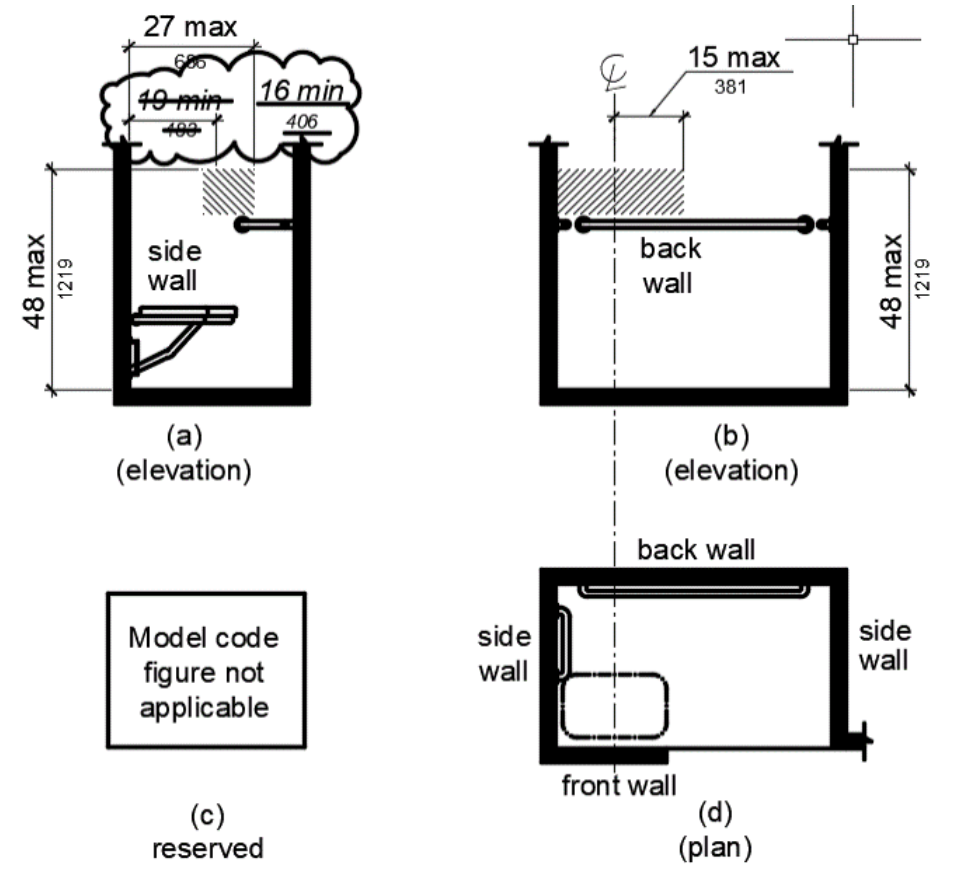
FIGURE 11B-608.5.3
ALTERNATE ROLL-IN TYPE SHOWER COMPARTMENT CONTROL LOCATION
ETA Editor's Note
The CBC requirements for positioning controls in alternate roll-in shower compartments are more restrictive than 2010 ADA Standards.
11B-608.6 Shower spray unit and water.
A shower spray unit with a hose 59 inches (1499 mm) long minimum that can be used both as a fixed-position shower head and as a hand-held shower shall be provided. The shower spray unit shall have an on/off control with a non-positive shut-off. If an adjustable-height shower head on a vertical bar is used, the bar shall be installed so as not to obstruct the use of grab bars. Shower spray units shall deliver water that is 120°F (49°C) maximum.
Exception: Where subject to excessive vandalism, two fixed shower heads shall be permitted instead of a hand-held spray unit in facilities that are not medical care facilities, long-term care facilities, transient lodging guest rooms, or residential dwelling units. Each shower head shall be installed so it can be operated independently of the other and shall have swivel angle adjustments, both vertically and horizontally. One shower head shall be located at a height of 48 inches (1219 mm) maximum above the shower finish floor.
[2010 ADA Standards] EXCEPTION: A fixed shower head located at 48 inches (1220 mm) maximum above the shower finish floor shall be permitted instead of a hand-held spray unit in facilities that are not medical care facilities, long-term care facilities, transient lodging guest rooms, or residential dwelling units.

The 2010 ADA Standards Exception at 608.6 does not require the consideration of excessive vandalism or the installation of two shower heads where fixed ones are provided. Therefore, the CBC requirements are more stringent.
11B-608.7 Thresholds.
Thresholds in roll-in type shower compartments shall be ½ inch (12.7 mm) high maximum in accordance with Section 11B-303. In transfer type shower compartments, thresholds ½ inch (12.7 mm) high maximum shall be beveled, rounded, or vertical.
Exception: A threshold 2 inches (51 mm) high maximum shall be permitted in transfer type shower compartments in existing facilities where provision of a ½ inch (12.7 mm) high threshold would disturb the structural reinforcement of the floor slab.
11B-608.8 Shower enclosures.
Enclosures for shower compartments shall not obstruct controls, faucets, and shower spray units or obstruct transfer from wheelchairs onto shower seats.
11B-608.9 Shower floor or ground surface.
Floor or ground surfaces of showers shall comply with Section 11B-302.1 and shall be sloped 1:48 maximum in any direction. Where drains are provided, grate openings shall be ¼ inch (6.4 mm) maximum and flush with the floor surface.
11B-608.10 Soap dish.
Where a soap dish is provided, it shall be located on the control wall at 40 inches (1016 mm) maximum above the shower floor, and within the reach limits from the seat.
11B-609.1 General.
Grab bars in toilet facilities and bathing facilities shall comply with Section 11B-609.
11B-609.2 Cross section.
Grab bars shall have a cross section complying with Section 11B-609.2.1 or 11B-609.2.2.
11B-609.2.1 Circular cross section.
Grab bars with circular cross sections shall have an outside diameter of 1¼ inches (32 mm) minimum and 2 inches (51 mm) maximum.
11B-609.2.2 Non-circular cross section.
Grab bars with non-circular cross sections shall have a cross-section dimension of 2 inches (51 mm) maximum and a perimeter dimension of 4 inches (102 mm) minimum and 4.8 inches (122 mm) maximum.
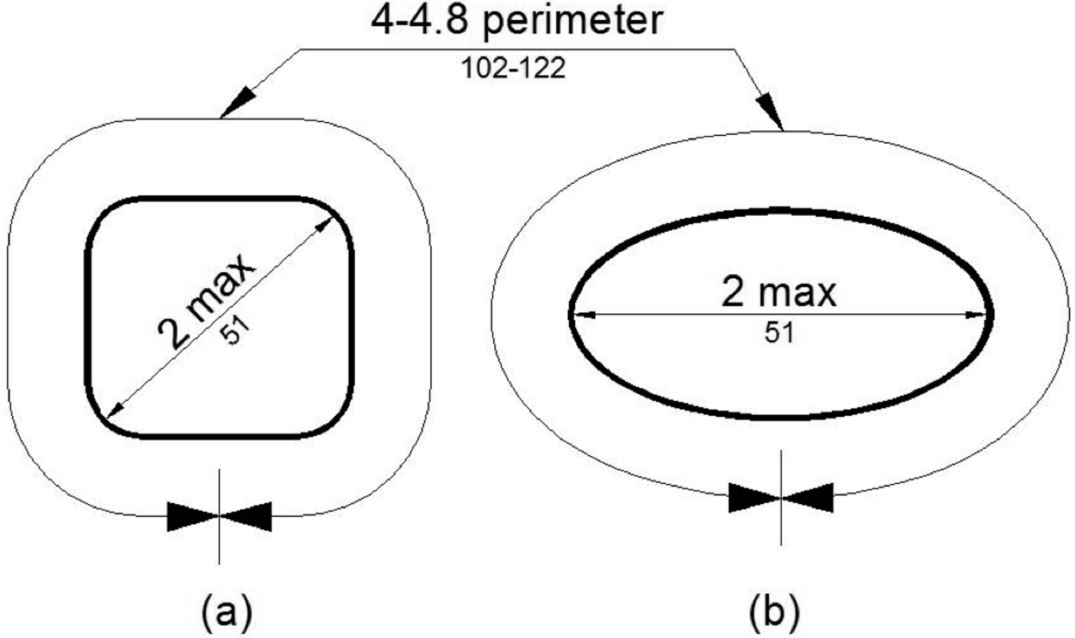
FIGURE 11B-609.2.2 GRAB BAR NON-CIRCULAR CROSS SECTION
11B-609.3 Spacing.
The space between the wall and the grab bar shall be 1½ inches (38 mm). The space between the grab bar and projecting objects below and at the ends shall be 1½ inches (38 mm) minimum. The space between the grab bar and projecting objects above shall be 12 inches (305 mm) minimum.
Exceptions:
- The space between the grab bars and shower controls, shower fittings, and other grab bars above shall be permitted to be 1½ inches (38 mm) minimum.
- For L-shaped or U-shaped grab bars complying with Section 11B-609.9 the space between the walls and the grab bar shall be 1½ inches (38 mm) minimum for a distance of 6 inches on either side of the inside corner between two adjacent wall surfaces.

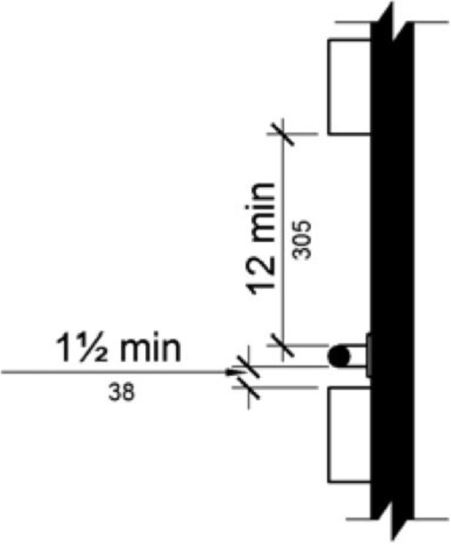
(a) projecting objects
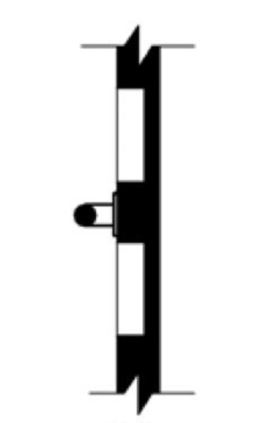
(b) recessed objects
FIGURE 11B-609.3 SPACING OF GRAB BARS
11B-609.4 Position of grab bars.
Grab bars shall be installed in a horizontal position, 33 inches (838 mm) minimum and 36 inches (914 mm) maximum above the finish floor measured to the top of the gripping surface, except that at water closets for children's use complying with Section 11B-604.9, grab bars shall be installed in a horizontal position 18 inches (457 mm) minimum and 27 inches (686 mm) maximum above the finish floor measured to the top of the gripping surface. The height of the lower grab bar on the back wall of a bathtub shall comply with Section 11B-607.4.1.1 or 11B-607.4.2.1.
11B-609.5 Surface hazards.
Grab bars and any wall or other surfaces adjacent to grab bars shall be free of sharp or abrasive elements and shall have rounded edges.
11B-609.7 Installation.
Grab bars shall be installed in any manner that provides a gripping surface at the specified locations and that does not obstruct the required clear floor space.
11B-609.8 Structural strength.
Allowable stresses shall not be exceeded for materials used when a vertical or horizontal force of 250 pounds (1112 N) is applied at any point on the grab bar, fastener, mounting device, or supporting structure.
11B-610.1 General.
Seats in bathtubs and shower compartments shall comply with Section 11B-610.
11B-610.2 Bathtub seats.
The top of bathtub seats shall be 17 inches (432 mm) minimum and 19 inches (483 mm) maximum above the bathroom finish floor. The depth of a removable in-tub seat shall be 15 inches (381 mm) minimum and 16 inches (406 mm) maximum. The seat shall be capable of secure placement. Permanent seats at the head end of the bathtub shall be 15 inches (381 mm) deep minimum and shall extend from the back wall to or beyond the outer edge of the bathtub.
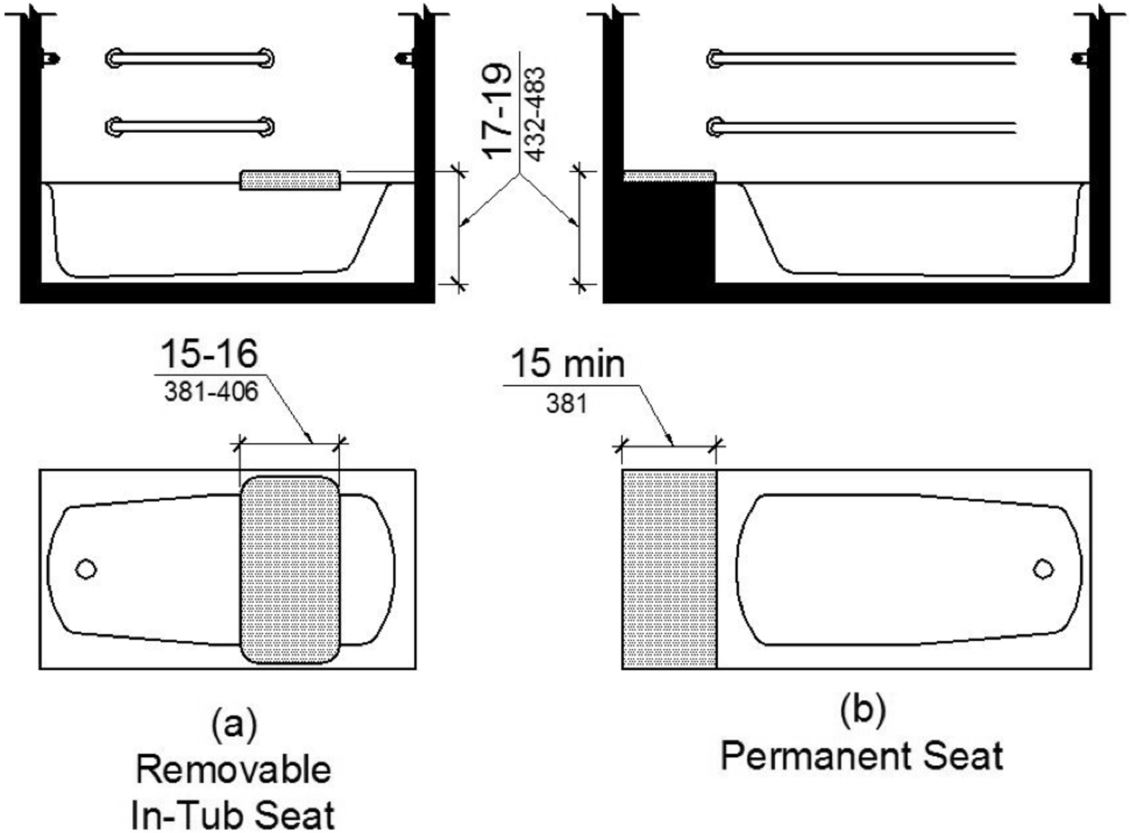
FIGURE 11B-610.2 BATHTUB SEATS
11B-610.3 Shower compartment seats.
A seat in a standard roll-in shower compartment shall be a folding type, shall be installed on the side wall adjacent to the controls, and shall extend from the back wall to a point within 3 inches (76 mm) of the compartment entry. A seat in an alternate roll-in type shower compartment shall be a folding type, shall be installed on the front wall opposite the back wall, and shall extend from the adjacent side wall to a point within 3 inches (76 mm) of the compartment entry. In transfer-type showers, the seat shall extend from the back wall to a point within 3 inches (76 mm) of the compartment entry. The top of the seat shall be 17 inches (432 mm) minimum and 19 inches (483 mm) maximum above the bathroom finish floor. When folded, the seat shall extend 6 inches (152 mm) maximum from the mounting wall. Seats shall comply with Section 11B-610.3.1 or 11B-610.3.2.
[2010 ADA Standards] 610.3 Shower Compartment Seats. Where a seat is provided in a standard roll-in shower compartment, it shall be a folding type, shall be installed on the side wall adjacent to the controls, and shall extend from the back wall to a point within 3 inches (75 mm) of the compartment entry. Where a seat is provided in an alternate roll-in type shower compartment, it shall be a folding type, shall be installed on the front wall opposite the back wall, and shall extend from the adjacent side wall to a point within 3 inches (75 mm) of the compartment entry. In transfer-type showers, the seat shall extend from the back wall to a point within 3 inches (75 mm) of the compartment entry. The top of the seat shall be 17 inches (430 mm) minimum and 19 inches (485 mm) maximum above the bathroom finish floor. Seats shall comply with 610.3.1 or 610.3.2.
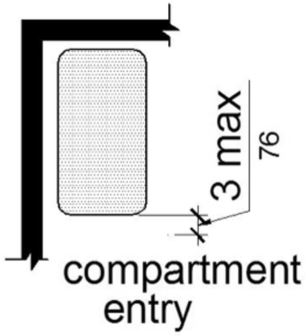
(a) rectangular
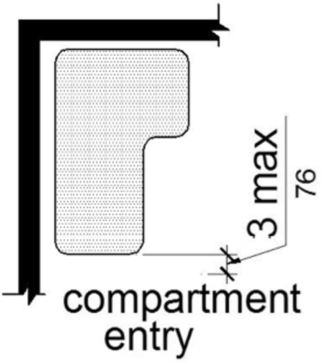
(b) L-shaped
FIGURE 11B-610.3 EXTENT OF SEAT
11B-610.3.1 Rectangular seats.
The rear edge of a rectangular seat shall be 2½ inches (64 mm) maximum and the front edge 15 inches (381 mm) minimum and 16 inches (406 mm) maximum from the seat wall. The side edge of the seat shall be 1½ inches (38 mm) maximum from the adjacent wall.
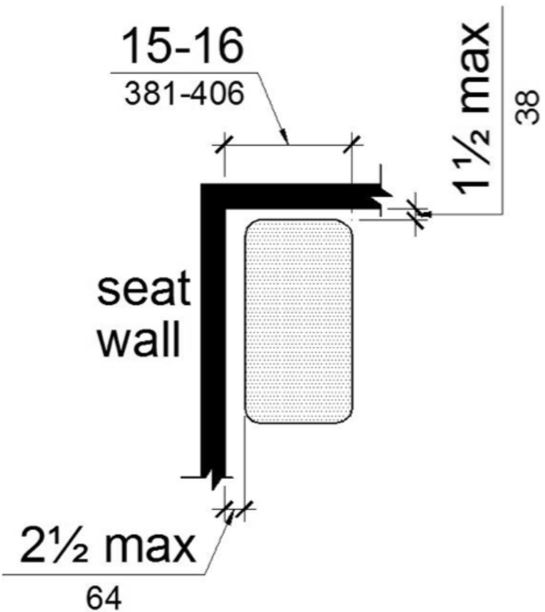
FIGURE 11B-610.3.1 RECTANGULAR SHOWER SEAT
11B-610.3.2 L-shaped seats.
The rear edge of an L-shaped seat shall be 2½ inches (64 mm) maximum and the front edge 15 inches (381 mm) minimum and 16 inches (406 mm) maximum from the seat wall. The rear edge of the “L” portion of the seat shall be 1½ inches (38 mm) maximum from the wall and the front edge shall be 14 inches (356 mm) minimum and 15 inches (381 mm) maximum from the wall. The end of the “L” shall be 22 inches (559 mm) minimum and 23 inches (584 mm) maximum from the main seat wall.
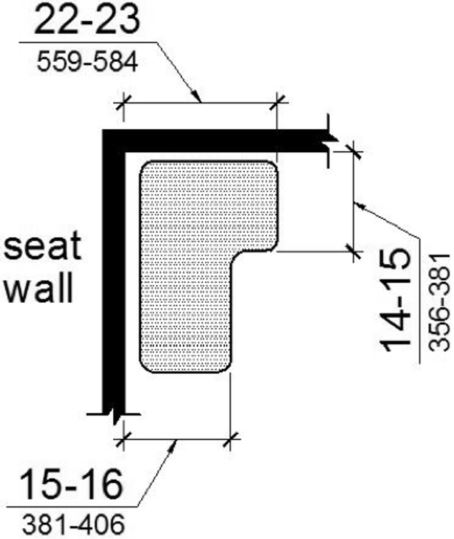
(a) size
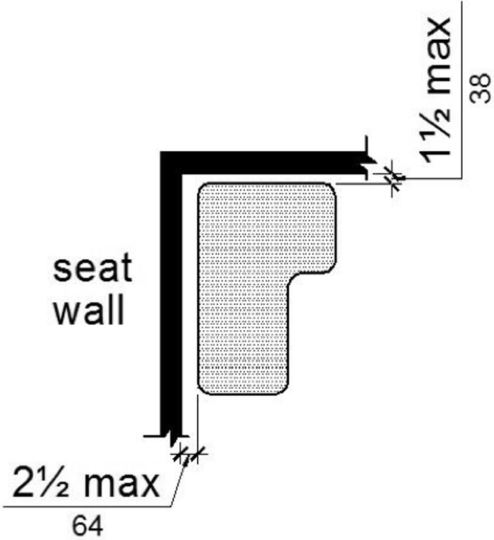
(b) distance from wall
FIGURE 11B-610.3.2 L-SHAPED SHOWER SEAT
11B-610.4 Structural strength.
Allowable stresses shall not be exceeded for materials used when a vertical or horizontal force of 250 pounds (1112 N) is applied at any point on the seat, fastener, mounting device, or supporting structure.
11B-611.1 General.
Washing machines and clothes dryers shall comply with Section 11B-611.
11B-611.2 Clear Floor Space.
A clear floor or ground space complying with Section 11B-305 positioned for parallel approach shall be provided. The clear floor or ground space shall be centered on the appliance.
11B-611.3 Operable parts.
Operable parts, including doors, lint screens, and detergent and bleach compartments shall comply with Section 11B-309.
11B-611.4 Height.
Top loading machines shall have the door to the laundry compartment located 36 inches (914 mm) maximum above the finish floor. Front loading machines shall have the bottom of the opening to the laundry compartment located 15 inches (381 mm) minimum and 36 inches (914 mm) maximum above the finish floor.
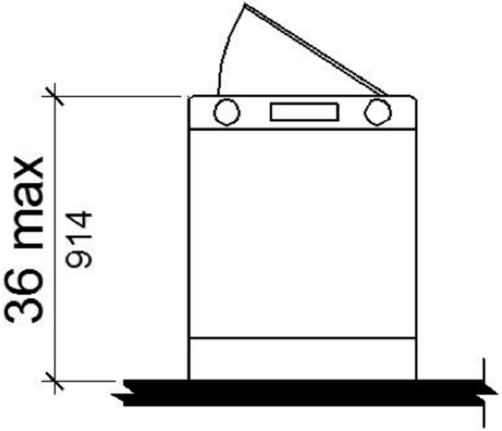
(a) top loading
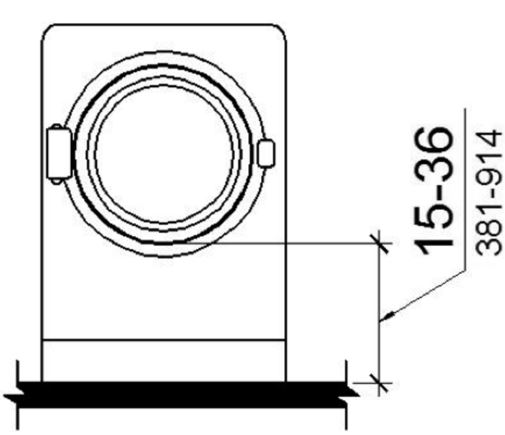
(b) front loading
FIGURE 11B-611.4 HEIGHT OF LAUNDRY COMPARTMENT OPENING
11B-612.1 General.
Saunas and steam rooms shall comply with Section 11B-612.
11B-612.2 Bench.
Where seating is provided in saunas and steam rooms, at least one bench shall comply with Section 11B-903. Doors shall not swing into the clear floor space required by Section 11B-903.2.
Exception: A readily removable bench shall be permitted to obstruct the turning space required by Section 11B-612.3 and the clear floor or ground space required by Section 11B-903.2.
11B-612.3 Turning space.
A turning space complying with Section 11B-304 shall be provided within saunas and steam rooms.
11B-701.1 Scope.
The provisions of Division 7 shall apply where required by Division 2 or where referenced by a requirement in this chapter.
11B-702.1 General.
Fire alarm systems shall have permanently installed audible and visible alarms complying with NFPA 72 and Chapter 9, Sections 907.5.2.1 and 907.5.2.3.
[2010 ADA Standards] 702.1 General. Fire alarm systems shall have permanently installed audible and visible alarms complying with NFPA 72 (1999 or 2002 edition) (incorporated by reference, see "Referenced Standards" in Chapter 1), except that the maximum allowable sound level of audible notification appliances complying with section 4-3.2.1 of NFPA 72 (1999 edition) shall have a sound level no more than 110 dB at the minimum hearing distance from the audible appliance. In addition, alarms in guest rooms required to provide communication features shall comply with sections 4-3 and 4-4 of NFPA 72 (1999 edition) or sections 7.4 and 7.5 of NFPA 72 (2002 edition).
Exception: Reserved.
[2010 ADA Standards] EXCEPTION: Fire alarm systems in medical care facilities shall be permitted to be provided in accordance with industry practice.
ETA Editor's Note
The 110 dB limit for audible alarms required at 2010 ADA Standards 702.1 is included at CBC 907.5.2.
The non-specific variance allowed for medical care facilities by the 2010 ADA Standards 702.1 Exception is addressed in greater detail at CBC Chapter 9, Section 907 - Fire Alarm and Detection Systems (full contents are not included in this Guide, only sections adopted by DSA-AC).
11B-703.1 General.
Signs shall comply with Section 11B-703. Where both visual and tactile characters are required, either one sign with both visual and tactile characters, or two separate signs, one with visual, and one with tactile characters, shall be provided.
11B-703.1.1 Plan review and inspection.
Signs as specified in Section 11B-703, or in other sections of this code, when included in the construction of new buildings or facilities, or when included, altered or replaced due to additions, alterations or renovations to existing buildings or facilities, and when a permit is required, shall comply with Sections 11B-703.1.1.1 and 11B-703.1.1.2.
Plans, specifications or other information indicating compliance with these regulations shall be submitted to the enforcing agency for review and approval.
Signs and identification devices shall be field inspected after installation and approved by the enforcing agency prior to the issuance of a final certificate of occupancy per Chapter 1, Division II, Section 111, or final approval where no certificate of occupancy is issued. The inspection shall include, but not be limited to, verification that Braille dots and cells are properly spaced and the size, proportion and type of raised characters are in compliance with these regulations.
11B-703.2 Raised characters.
Raised characters shall comply with Section 11B-703.2 and shall be duplicated in Braille complying with Section 11B-703.3. Raised characters shall be installed in accordance with Section 11B-703.4.

11B-703.2.1 Depth.
Raised characters shall be 1/32 inch (0.8 mm) minimum above their background.
11B-703.2.2 Case.
Characters shall be uppercase.
11B-703.2.3 Style.
Characters shall be sans serif. Characters shall not be italic, oblique, script, highly decorative, or of other unusual forms.
11B-703.2.4 Character proportions.
Characters shall be selected from fonts where the width of the uppercase letter “O” is 60 percent minimum and 110 percent maximum of the height of the uppercase letter “I”.
[2010 ADA Standards] 703.2.4 Character Proportions. Characters shall be selected from fonts where the width of the uppercase letter "O" is 55 percent minimum and 110 percent maximum of the height of the uppercase letter "I".
11B-703.2.5 Character height.
Character height measured vertically from the baseline of the character shall be 5/8 inch (15.9 mm) minimum and 2 inches (51 mm) maximum based on the height of the uppercase letter “I”.
Exception: Reserved.
[2010 ADA Standards] EXCEPTION: Where separate raised and visual characters with the same information are provided, raised character height shall be permitted to be ½ inch (13 mm) minimum.
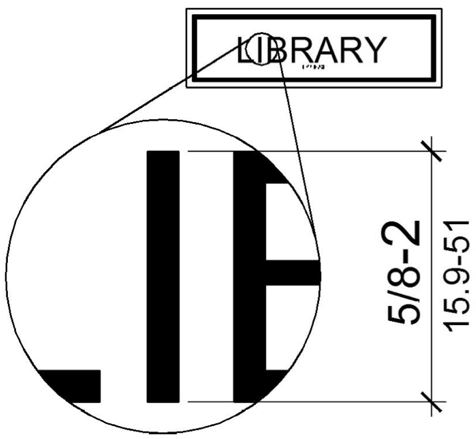
FIGURE 11B-703.2.5 HEIGHT OF RAISED CHARACTERS
11B-703.2.6 Stroke thickness.
Stroke thickness of the uppercase letter “I” shall be 15 percent maximum of the height of the character.
11B-703.2.7 Character spacing.
Character spacing shall be measured between the two closest points of adjacent raised characters within a message, excluding word spaces. Where characters have rectangular cross sections, spacing between individual raised characters shall be 1/8 inch (3.2 mm) minimum and 4 times the raised character stroke width maximum. Where characters have other cross sections, spacing between individual raised characters shall be 1/16 inch (1.6 mm) minimum and 4 times the raised character stroke width maximum at the base of the cross sections, and 1/8 inch (3.2 mm) minimum and 4 times the raised character stroke width maximum at the top of the cross sections. Characters shall be separated from raised borders and decorative elements 3/8 inch (9.5 mm) minimum.
11B-703.2.8 Line spacing.
Spacing between the baselines of separate lines of raised characters within a message shall be 135 percent minimum and 170 percent maximum of the raised character height.
11B-703.2.9 Format.
Text shall be in a horizontal format.
11B-703.3 Braille.
Braille shall be contracted (Grade 2) and shall comply with Sections 11B-703.3 and 11B-703.4.

11B-703.3.1 Dimensions and capitalization.
Braille dots shall have a domed or rounded shape and shall comply with Table 11B-703.3.1. The indication of an uppercase letter or letters shall only be used before the first word of sentences, proper nouns and names, individual letters of the alphabet, initials, and acronyms.
TABLE 11B-703.3.1 BRAILLE DIMENSIONS
|
MEASUREMENT RANGE |
MINIMUM IN INCHES |
||||||||||||||||||||||||||||||||||||||
|---|---|---|---|---|---|---|---|---|---|---|---|---|---|---|---|---|---|---|---|---|---|---|---|---|---|---|---|---|---|---|---|---|---|---|---|---|---|---|---|
|
Dot base diameter |
0.059 (1.5 mm) to 0.063 (1.6 mm) |
||||||||||||||||||||||||||||||||||||||
|
Distance between two dots in the same cell1 |
0.100 (2.5 mm) |
||||||||||||||||||||||||||||||||||||||
|
Distance between corresponding dots in adjacent cells1 |
0.300 (7.6 mm) |
||||||||||||||||||||||||||||||||||||||
|
Dot height |
0.025 (0.6 mm) to 0.037 (0.9 mm) |
||||||||||||||||||||||||||||||||||||||
|
Distance between corresponding dots from one cell directly below1 |
0.395 (10 mm) to 0.400 (10.2 mm) |
1. Measured center to center.
ETA Editor's Note
Table 11B-703.3.1 in CBC is the same as Table 703.3.1 in 2010 ADA Standards, except for distance between dots in the same cell or adjacent cells. 2010 ADA Standards allows a range, while CBC prescribes the maximum spacing allowed by 2010 ADA Standards, with no deviation allowed. When dealing with sign manufacturers or elevator companies whose scope of operations extends outside California, extra diligence is necessary to ensure that CBC braille specifications are followed.
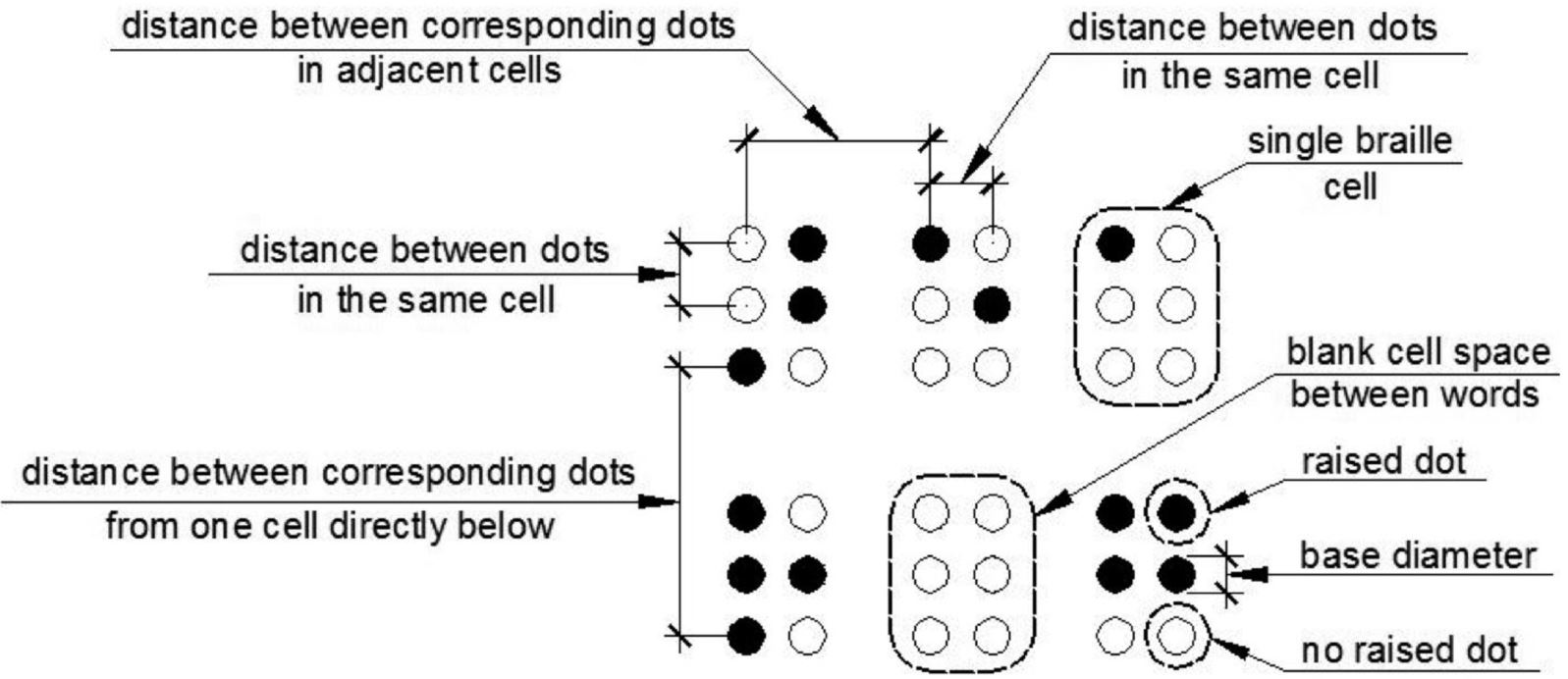
FIGURE 11B-703.3.1 BRAILLE MEASUREMENT ‡‡
11B-703.3.2 Position.
Braille shall be positioned below the corresponding text in a horizontal format, flush left or centered. If text is multi-lined, Braille shall be placed below the entire text. Braille shall be separated 3/8 inch (9.5 mm) minimum and ½ inch (12.7 mm) maximum from any other tactile characters and 3/8 inch (9.5 mm) minimum from raised borders and decorative elements.
[2010 ADA Standards] 703.3.2 Position. Braille shall be positioned below the corresponding text. If text is multi-lined, braille shall be placed below the entire text. Braille shall be separated 3/8 inch (9.5 mm) minimum from any other tactile characters and 3/8 inch (9.5 mm) minimum from raised borders and decorative elements.
Exception: Braille provided on elevator car controls shall be separated 3/16 inch (4.8 mm) minimum and shall be located directly below the corresponding raised characters or symbols.
[2010 ADA Standards] EXCEPTION: Braille provided on elevator car controls shall be separated 3/16 inch (4.8 mm) minimum and shall be located either directly below or adjacent to the corresponding raised characters or symbols.
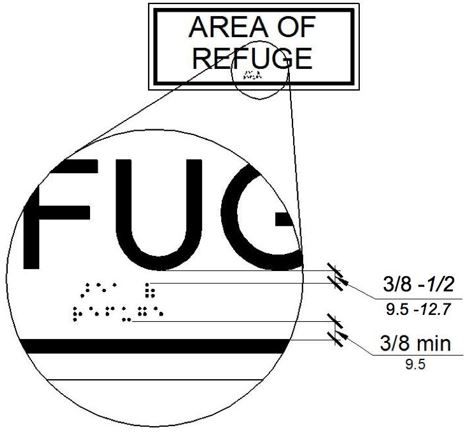
FIGURE 11B-703.3.2 POSITION OF BRAILLE ‡‡
ETA Editor's Note
CBC Figure 11B-703.3.2 is not intended to suggest that braille must be multi-lined when the related text is multi-lined, only to illustrate the required position and spacing from other sign elements.
11B-703.4 Installation height and location.
Signs with tactile characters shall comply with Section 11B-703.4.
11B-703.4.1 Height above finish floor or ground.
Tactile characters on signs shall be located 48 inches (1219 mm) minimum above the finish floor or ground surface, measured from the baseline of the lowest Braille cells and 60 inches (1524 mm) maximum above the finish floor or ground surface, measured from the baseline of the highest line of raised characters.
[2010 ADA Standards] 703.4.1 Height Above Finish Floor or Ground. Tactile characters on signs shall be located 48 inches (1220 mm) minimum above the finish floor or ground surface, measured from the baseline of the lowest tactile character and 60 inches (1525 mm) maximum above the finish floor or ground surface, measured from the baseline of the highest tactile character.
Exception: Tactile characters for elevator car controls shall not be required to comply with Section 11B-703.4.1.
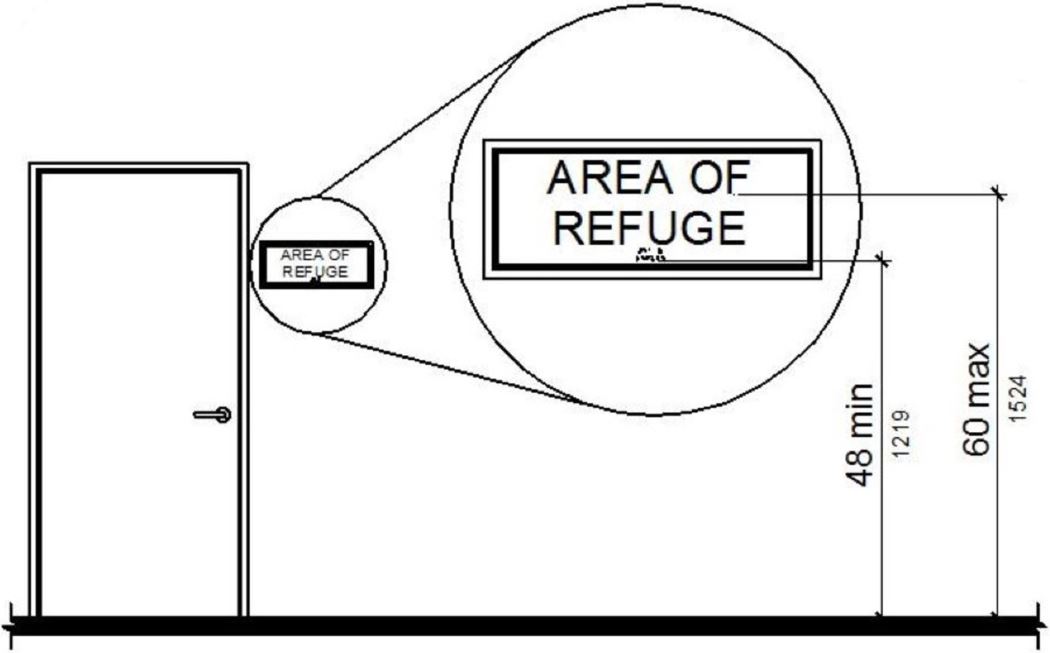
FIGURE 11B-703.4.1 HEIGHT OF TACTILE CHARACTERS ABOVE FINISH FLOOR OR GROUND ‡‡
11B-703.4.2 Location.
Where a tactile sign is provided at a door, the sign shall be located alongside the door at the latch side. Where a tactile sign is provided at double doors with one active leaf, the sign shall be located on the inactive leaf. Where a tactile sign is provided at double doors with two active leafs, the sign shall be located to the right of the right hand door. Where there is no wall space at the latch side of a single door or at the right side of double doors, signs shall be located on the nearest adjacent wall. Signs containing tactile characters shall be located so that a clear floor space of 18 inches (457 mm) minimum by 18 inches (457 mm) minimum, centered on the tactile characters, is provided beyond the arc of any door swing between the closed position and 45 degree open position. Where provided, signs identifying permanent rooms and spaces shall be located at the entrance to, and outside of the room or space. Where provided, signs identifying exits shall be located at the exit door when approached in the direction of egress travel.
[2010 ADA Standards] 703.4.2 Location. Where a tactile sign is provided at a door, the sign shall be located alongside the door at the latch side. Where a tactile sign is provided at double doors with one active leaf, the sign shall be located on the inactive leaf. Where a tactile sign is provided at double doors with two active leafs, the sign shall be located to the right of the right hand door. Where there is no wall space at the latch side of a single door or at the right side of double doors, signs shall be located on the nearest adjacent wall. Signs containing tactile Characters shall be located so that a clear floor space of 18 inches (455 mm) minimum by 18 inches (455 mm) minimum, centered on the tactile characters, is provided beyond the arc of any door swing between the closed position and 45 degree open position.
Exception: In alterations where sign installation locations identified in Section 11B-703.4.2 are obstructed or otherwise unavailable for sign installation, signs with tactile characters shall be permitted on the push side of doors with closers and without hold-open devices.
[2010 ADA Standards] EXCEPTION: Signs with tactile characters shall be permitted on the push side of doors with closers and without hold-open devices.
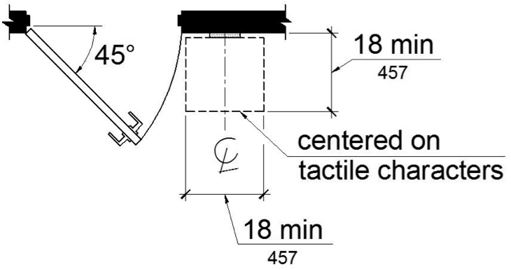
FIGURE 11B-703.4.2 LOCATION OF TACTILE SIGNS AT DOORS

11B-703.5 Visual characters.
Visual characters shall comply with Section 11B-703.5.
Exception: Where visual characters comply with Section 11B-703.2 and are accompanied by Braille complying with Section 11B-703.3, they shall not be required to comply with Sections 11B-703.5.2 through 11B-703.5.6, 11B-703.5.8 and 11B-703.5.9.
[2010 ADA Standards] EXCEPTION: Where visual characters comply with 703.2 and are accompanied by braille complying with 703.3, they shall not be required to comply with 703.5.2 through 703.5.9.
11B-703.5.1 Finish and contrast.
Characters and their background shall have a non-glare finish. Characters shall contrast with their background with either light characters on a dark background or dark characters on a light background.

11B-703.5.2 Case.
Characters shall be uppercase or lowercase or a combination of both.
11B-703.5.3 Style.
Characters shall be conventional in form. Characters shall not be italic, oblique, script, highly decorative, or of other unusual forms.
11B-703.5.4 Character proportions.
Characters shall be selected from fonts where the width of the uppercase letter “O” is 60 percent minimum and 110 percent maximum of the height of the uppercase letter “I”.
[2010 ADA Standards] 703.5.4 Character Proportions. Characters shall be selected from fonts where the width of the uppercase letter "O" is 55 percent minimum and 110 percent maximum of the height of the uppercase letter "I".
11B-703.5.5 Character height.
Minimum character height shall comply with Table 11B-703.5.5. Viewing distance shall be measured as the horizontal distance between the character and an obstruction preventing further approach towards the sign. Character height shall be based on the uppercase letter “I”.
Exception: Where provided, floor plans providing emergency procedures information in accordance with Title 19 shall not be required to comply with Section 11B-703.5.5.
TABLE 11B-703.5.5 VISUAL CHARACTER HEIGHT
| Height To Finish Floor Or Ground From Baseline Of Character | Horizontal Viewing Distance | Minimum Character Height |
| 40 inches (1016 mm) to less than or equal to 70 inches (1778 mm) | less than 72 inches (1829 mm) | 5/8 inch (15.9 mm) |
| 72 inches (1829 mm) and greater | 5/8 inch (15.9 mm), plus 1/8 inch (3.2 mm) per foot (305 mm) of viewing distance above 72 inches (1829 mm) | |
| Greater than 70 inches (1778 mm) to less than or equal to 120 inches (3048 mm) | less than 180 inches (4572 mm) | 2 inches (51 mm) |
| 180 inches (4572 mm) and greater | 2 inches (51 mm) , plus 1/8 inch (3.2 mm) per foot (305 mm) of viewing distance above 180 inches (4572 mm) | |
| Greater than 120 inches (3048 mm) | less than 21 feet (6401 mm) | 3 inches (76 mm) |
| 21 feet (6401 mm) and greater | 3 inches (76 mm) , plus 1/8 inch (3.2 mm) per foot (305 mm) of viewing distance above 21 feet (6401 mm) |
11B-703.5.6 Height from finish floor or ground.
Visual characters shall be 40 inches (1016 mm) minimum above the finish floor or ground.
Exceptions:
- Visual characters indicating elevator car controls shall not be required to comply with Section 11B-703.5.6.
- Floor-level exit signs complying with Chapter 10, Section 1013.7 shall not be required to comply with Section 11B-703.5.6.
- Where provided, floor plans providing emergency procedures information in accordance with Title 19 shall not be required to comply with Section 11B-703.5.6.
11B-703.5.7 Stroke thickness.
Stroke thickness of the uppercase letter “I” shall be 10 percent minimum and 20 percent maximum of the height of the character.
[2010 ADA Standards] 703.5.7 Stroke Thickness. Stroke thickness of the uppercase letter "I" shall be 10 percent minimum and 30 percent maximum of the height of the character.
11B-703.5.8 Character spacing.
Character spacing shall be measured between the two closest points of adjacent characters, excluding word spaces. Spacing between individual characters shall be 10 percent minimum and 35 percent maximum of character height.
11B-703.5.9 Line spacing.
Spacing between the baselines of separate lines of characters within a message shall be 135 percent minimum and 170 percent maximum of the character height.
11B-703.5.10 Format.
Text shall be in a horizontal format.
11B-703.6 Pictograms.
Pictograms shall comply with Section 11B-703.6.

11B-703.6.1 Pictogram field.
Pictograms shall have a field height of 6 inches (152 mm) minimum. Characters and Braille shall not be located in the pictogram field.

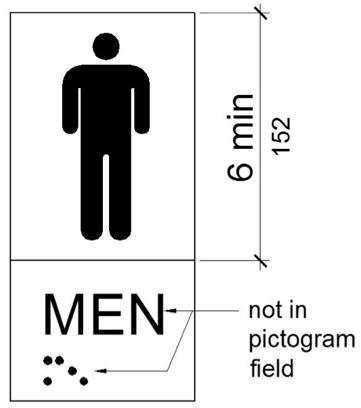
FIGURE 11B-703.6.1 PICTOGRAM FIELD
11B-703.6.2 Finish and contrast.
Pictograms and their field shall have a non-glare finish. Pictograms shall contrast with their field with either a light pictogram on a dark field or a dark pictogram on a light field.

11B-703.6.3 Text descriptors.
Pictograms shall have text descriptors located directly below the pictogram field. Text descriptors shall comply with Sections 11B-703.2, 11B-703.3 and 11B-703.4.
11B-703.7 Symbols of accessibility.
Symbols of accessibility shall comply with Section 11B-703.7.

11B-703.7.1 Finish and contrast.
Symbols of accessibility and their background shall have a non-glare finish. Symbols of accessibility shall contrast with their background with either a light symbol on a dark background or a dark symbol on a light background.

11B-703.7.2.1 International Symbol of Accessibility.
The International Symbol of Accessibility shall comply with Figure 11B-703.7.2.1. The symbol shall consist of a white figure on a blue background. The color blue shall approximate FS 15090 in Federal Standard 595C. A border may be provided inside or outside of the minimum required International Symbol of Accessibility dimension.
[2010 ADA Standards] 703.7.2.1 International Symbol of Accessibility. The International Symbol of Accessibility shall comply with Figure 703.7.2.1.
Exceptions:
- The appropriate enforcement agency may approve other colors provided the symbol contrast is light on dark or dark on light.
- On the accessibility function button on hall call consoles in a destination-oriented elevator system the International Symbol of Accessibility shall be a white symbol on a black background.
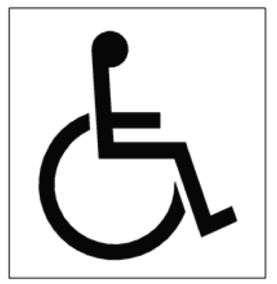
FIGURE 11B-703.7.2.1 INTERNATIONAL SYMBOL OF ACCESSIBILITY

11B-703.7.2.2 International Symbol of TTY.
The International Symbol of TTY shall comply with Figure 11B-703.7.2.2.
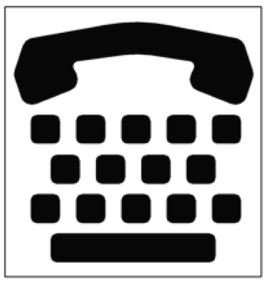
FIGURE 11B-703.7.2.2 INTERNATIONAL SYMBOL OF TTY
11B-703.7.2.3 Volume control telephones.
Telephones with a volume control shall be identified by a pictogram of a telephone handset with radiating sound waves on a square field such as shown in Figure 11B-703.7.2.3.
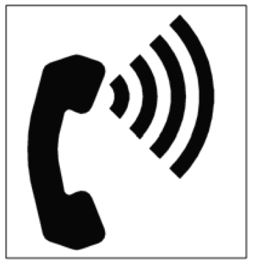
FIGURE 11B-703.7.2.3 VOLUME CONTROL TELEPHONE
11B-703.7.2.4 Assistive listening systems.
Assistive listening systems shall be identified by the International Symbol of Access for Hearing Loss complying with Figure 11B-703.7.2.4.
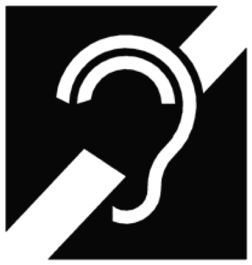
FIGURE 11B-703.7.2.4 INTERNATIONAL SYMBOL OF ACCESS FOR HEARING LOSS
11B-703.7.2.6 Toilet and bathing facilities geometric symbols.
Geometric symbols at entrances to toilet and bathing rooms shall be mounted at 58 inches (1473 mm) minimum and 60 inches (1524 mm) maximum above the finish floor or ground surface measured from the centerline of the symbol. Where a door is provided the symbol shall be mounted within 1 inch (25 mm) of the vertical centerline of the door.

When toilet and bathing facilities have doorway openings instead of doors, such as at airports or stadiums, the geometric identification symbol should be located at the proper height adjacent to the opening or incorporated into the required tactile identification sign. For example, the geometric symbol may be used as the sign background with raised characters and Braille per Sections 11B-703.2 and 11B-703.3. ◼
11B-703.7.2.6.1 Men’s toilet and bathing facilities.
An equilateral triangle, ¼ inch (6.4 mm) thick with edges 12 inches (305 mm) long and a vertex pointing upward, shall be located at entrances to men’s toilet and bathing facilities. The triangle symbol shall contrast with the door, either light on a dark background or dark on a light background.
Exception: Within secure perimeter of detention and correctional facilities, geometric symbols shall not be required to be ¼ inch (6.4 mm) thick.
11B-703.7.2.6.2 Women’s toilet and bathing facilities.
A circle, ¼ inch (6.4 mm) thick and 12 inches (305 mm) in diameter, shall be located at entrances to women’s toilet and bathing facilities. The circle symbol shall contrast with the door, either light on a dark background or dark on a light background.
Exception: Within secure perimeter of detention and correctional facilities, geometric symbols shall not be required to be ¼ inch (6.4 mm) thick.
11B-703.7.2.6.3 Unisex toilet and bathing facilities.
A circle, ¼ inch (6.4 mm) thick and 12 inches (305 mm) in diameter with a ¼ inch (6.4 mm) thick triangle with a vertex pointing upward, superimposed on and geometrically inscribed within the circle and within the 12-inch diameter, shall be provided at entrances to unisex toilet and bathing facilities. The vertices of the triangle shall be located ¼ inch (6.4 mm) maximum from the edge of the circle. The triangle symbol shall contrast with the circle symbol, either light on a dark background or dark on a light background. The circle symbol shall contrast with the door, either light on a dark background or dark on a light background.
Exception: Within secure perimeter of detention and correctional facilities, geometric symbols shall not be required to be ¼ inch (6.4 mm) thick.
11B-703.7.2.6.4 Edges and vertices on geometric symbols.
Edges shall be eased or rounded at 1/16 inch (1.59 mm) minimum, or chamfered at 1/8 inch (3.2 mm) maximum. Vertices shall be radiused between 1/8 inch (3.2 mm) minimum and ¼ inch (6.4 mm) maximum.

FIGURE 11B-703.7.2.6.4 EDGES AND VERTICES ON GEOMETRIC SYMBOLS
11B-703.7.2.7 Pedestrian traffic-control buttons.
Pole-supported pedestrian traffic-control buttons shall be identified with color coding consisting of a textured horizontal yellow band 2 inches (51 mm) in width encircling the pole, and a 1-inch-wide (25 mm) dark border band above and below this yellow band. Color coding shall be placed immediately above the control button. Control buttons shall be located no higher than 48 inches (1219 mm) above the ground surface adjacent to the pole.
11B-703.8.1 General.
High resolution variable message sign (VMS) characters shall comply with Sections 11B-703.5 and 11B-703.8.12 through 11B-703.8.14. Low resolution variable message sign (VMS) characters shall comply with 11B-703.8.
11B-703.8.2 Case.
Low resolution VMS characters shall be uppercase.
11B-703.8.3 Style.
Low resolution VMS characters shall be conventional in form, shall be san serif, and shall not be italic, oblique, script, highly decorative, or of other unusual forms.
11B-703.8.4 Character height.
The uppercase letter “I” shall be used to determine the allowable height of all low resolution VMS characters of a font. Viewing distance shall be measured as the horizontal distance between the character and an obstruction preventing further approach towards the sign. The uppercase letter “I” of the font shall have a minimum height complying with Table 11B-703.8.4.
Exception: In assembly seating where the maximum viewing distance is 100 feet (30.5 m) or greater, the height of the uppercase “I” of low resolution VMS fonts shall be permitted to be 1 inch (25 mm) for every 30 feet (9144 mm) of viewing distance, provided the character height is 8 inches (203 mm) minimum. Viewing distance shall be measured as the horizontal distance between the character and where someone is expected to view the sign.
TABLE 11B-703.8.4 LOW RESOLUTION VMS CHARACTER HEIGHT
| HEIGHT ABOVE FLOOR TO BASELINE OF CHARACTER | HORIZONTAL VIEWING DISTANCE | MINIMUM CHARACTER HEIGHT |
| 40 inches (1016 mm) to less than or equal to 70 inches (1778 mm) | Less than 10 feet (3048 mm) | 2 inches (51 mm) |
| 10 feet (3048 mm) and greater | 2 inches (51 mm), plus 1/5 inch (5.1 mm) per foot (305 mm) of viewing distance above 10 feet (3048 mm) | |
| Greater than 70 inches (1778 mm) to less than or equal to 120 inches (3048 mm) | Less than 15 feet (4572 mm) | 3 inches (76 mm) |
| 15 feet (4572 mm) and greater | 3 inches (76 mm), plus 1/5 inch (5.1 mm) per foot (305 mm) of viewing distance above 15 feet (4572 mm) | |
| Greater than 120 inches (3048 mm) | Less than 20 feet (6096 mm) | 4 inches (102 mm) |
| 20 feet (6096 mm) and greater | 4 inches (102 mm), plus 1/5 inch (5.1 mm) per foot (305 mm) of viewing distance above 20 feet (6096 mm) |
11B-703.8.5 Character width.
The uppercase letter “O” shall be used to determine the allowable width of all low resolution VMS characters of a font. Low resolution VMS characters shall comply with the pixel count for character width in Table 11B-703.8.5.
TABLE 11B-703.8.5 PIXEL COUNT FOR LOW RESOLUTION VMS
|
CHARACTER HEIGHT |
CHARACTER WIDTH RANGE | STROKE WIDTH RANGE |
CHARACTER SPACING RANGE |
|---|---|---|---|
| 7 | 5-6 | 1 | 2 |
| 8 | 6-7 | 1-2 | 2-3 |
| 9 | 6-8 | 1-2 | 2-3 |
| 10 | 7-9 | 2 | 2-4 |
| 11 | 8-10 | 2 | 2-4 |
| 12 | 8-11 | 2 | 3-4 |
| 13 | 9-12 | 2-3 | 3-5 |
| 14 | 10-13 | 2-3 | 3-5 |
| 15 | 11-14 | 2-3 | 3-5 |
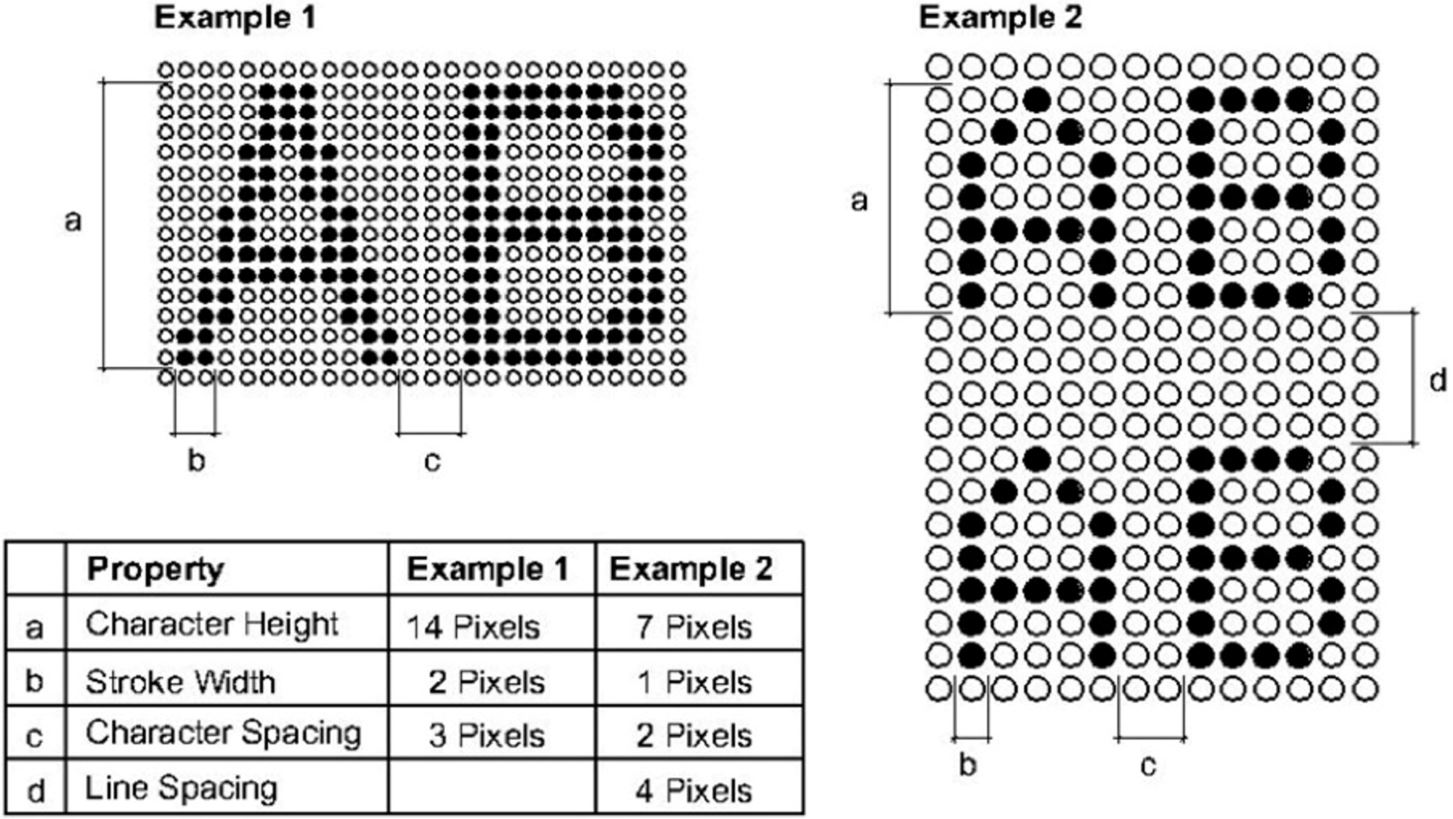
FIGURE 11B-703.8.5 LOW RESOLUTION VMS CHARACTERS
11B-703.8.6 Stroke width.
The uppercase letter “I” shall be used to determine the allowable stroke width of all low resolution VMS characters of a font. Low resolution VMS characters shall comply with the pixel count for stroke width in Table 11B-703.8.5.
11B-703.8.7 Character spacing.
Spacing shall be measured between the two closest points of adjacent low resolution VMS characters within a message, excluding word spaces. Low resolution VMS character spacing shall comply with the pixel count for character spacing in Table 11B-703.8.5.
11B-703.8.8 Line spacing.
Low resolution VMS characters shall comply with Section 11B-703.5.9.
11B-703.8.9 Height above floor.
Low resolution VMS characters shall be 40 inches (1016 mm) minimum above the floor of the viewing position, measured to the baseline of the character. Heights of low resolution variable message sign characters shall comply with Table 11B-703.8.4, based on the size of the characters on the sign.
11B-703.8.10 Finish.
The background of low resolution VMS characters shall have a non-glare finish.
11B-703.8.11 Contrast.
Low resolution VMS characters shall be light characters on a dark background.
11B-703.8.12 Protective covering.
Where a protective layer is placed over VMS characters through which the VMS characters must be viewed, the protective covering shall have a non-glare finish.
11B-703.8.13 Brightness.
The brightness of variable message signs in exterior locations shall automatically adjust in response to change in ambient light levels.
11B-703.8.14 Rate of change.
Where a VMS message can be displayed in its entirety on a single screen, it shall be displayed on a single screen and shall remain motionless on the screen for a minimum 3 seconds or one second minimum for every 7 characters of the message including spaces, whichever is longer.
11B-704.1 General.
Public telephones shall comply with Section 11B-704.
11B-704.2 Wheelchair accessible telephones.
Wheelchair accessible telephones shall comply with Section 11B-704.2.
11B-704.2.1 Clear floor or ground space.
A clear floor or ground space complying with Section 11B-305 shall be provided. The clear floor or ground space shall not be obstructed by bases, enclosures, or seats.

11B-704.2.1.1 Parallel approach.
Where a parallel approach is provided, the distance from the edge of the telephone enclosure to the face of the telephone unit shall be 10 inches (254 mm) maximum.
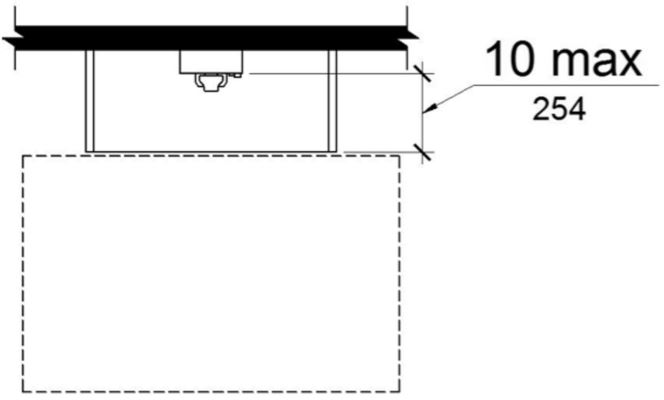
FIGURE 11B-704.2.1.1 PARALLEL APPROACH TO TELEPHONE
11B-704.2.1.2 Forward approach.
Where a forward approach is provided at a telephone within an enclosure, the counter may extend beyond the face of the telephone 20 inches (508 mm) into the required clear floor or ground space and the enclosure may extend beyond the face of the telephone 24 inches (610 mm). If an additional 6 inches (152 mm) in width of clear floor space is provided, creating a clear floor space of 36 inches by 48 inches (914 mm by 1219 mm), the enclosure may extend more than 24 inches (610 mm) beyond the face of the telephone.
[2010 ADA Standards] 704.2.1.2 Forward Approach. Where a forward approach is provided, the distance from the front edge of a counter within the telephone enclosure to the face of the telephone unit shall be 20 inches (510 mm) maximum.
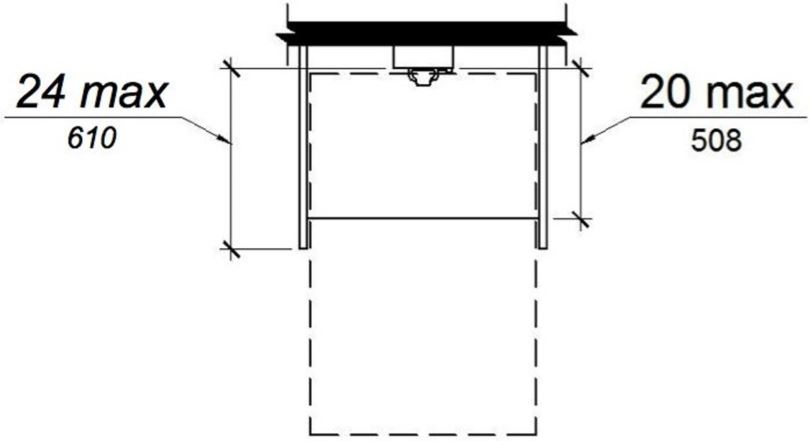
FIGURE 11B-704.2.1.2 FORWARD APPROACH TO TELEPHONE ‡‡
11B-704.2.2 Operable parts.
Operable parts shall comply with Section 11B-309. Telephones shall have push-button controls where such service is available.
11B-704.2.3 Telephone directories.
Telephone directories, where provided, shall be located in accordance with Section 11B-309.
11B-704.2.4 Cord length.
The cord from the telephone to the handset shall be 29 inches (737 mm) long minimum.
11B-704.3 Volume control telephones.
Public telephones required to have volume controls shall be equipped with a receive volume control that provides a gain adjustable up to 20 dB minimum. For incremental volume control, provide at least one intermediate step of 12 dB of gain minimum. An automatic reset shall be provided. Volume control telephones shall be equipped with a receiver that generates a magnetic field in the area of the receiver cap. Public telephones with volume control shall be hearing aid compatible.
[2010 ADA Standards] 704.3 Volume Control Telephones. Public telephones required to have volume controls shall be equipped with a receive volume control that provides a gain adjustable up to 20 dB minimum. For incremental volume control, provide at least one intermediate step of 12 dB of gain minimum. An automatic reset shall be provided.

11B-704.4 TTYs.
TTYs provided at a public pay telephone shall be permanently affixed within, or adjacent to, the telephone enclosure. Where an acoustic coupler is used, the telephone cord shall be sufficiently long to allow connection of the TTY and the telephone receiver.
[2010 ADA Standards] 704.4 TTYs. TTYs required at a public pay telephone shall be permanently affixed within, or adjacent to, the telephone enclosure. Where an acoustic coupler is used, the telephone cord shall be sufficiently long to allow connection of the TTY and the telephone receiver.

11B-704.4.1 Height.
When in use, the touch surface of TTY keypads shall be 34 inches (864 mm) minimum above the finish floor.
Exception: Where seats are provided, TTYs shall not be required to comply with Section 11B-704.4.1.


11B-704.5 TTY shelf.
Public pay telephones required to accommodate portable TTYs shall be equipped with a shelf and an electrical outlet within or adjacent to the telephone enclosure. The telephone handset shall be capable of being placed flush on the surface of the shelf. The shelf shall be capable of accommodating a TTY and shall have 6 inches (152 mm) minimum vertical clearance above the area where the TTY is to be placed.
11B-705 Detectable warnings and detectable directional texture
[2010 ADA Standards] 705 Detectable Warnings
11B-705.1.1 General.
Detectable warnings shall consist of a surface of truncated domes and shall comply with Section 11B-705.
Truncated domes in a detectable warning surface shall have a base diameter of 0.9 inch (22.9 mm) minimum and 0.92 inch (23.4 mm) maximum, a top diameter of 0.45 inch (11.4 mm) minimum and 0.47 inch (11.9 mm) maximum, and a height of 0.2 inch (5.1 mm).
[2010 ADA Standards] 705.1.1 Dome Size. Truncated domes in a detectable warning surface shall have a base diameter of 0.9 inch (23 mm) minimum and 1.4 inches (36 mm) maximum, a top diameter of 50 percent of the base diameter minimum to 65 percent of the base diameter maximum, and a height of 0.2 inch (5.1 mm).
Truncated domes in a detectable warning surface shall have a center-to-center spacing of 2.3 inches (58 mm) minimum and 2.4 inches (61 mm) maximum, and a base-to-base spacing of 0.65 inch (16.5 mm) minimum, measured between the most adjacent domes on a square grid.
[2010 ADA Standards] 705.1.2 Dome Spacing. Truncated domes in a detectable warning surface shall have a center-to-center spacing of 1.6 inches (41 mm) minimum and 2.4 inches (61 mm) maximum, and a base-to-base spacing of 0.65 inch (17 mm) minimum, measured between the most adjacent domes on a square grid.
Exception: Where installed in a radial pattern, truncated domes shall have a center-to-center spacing of 1.6 inches (41 mm) minimum to 2.4 inches (61 mm) maximum.

(a) elevation (enlarged)
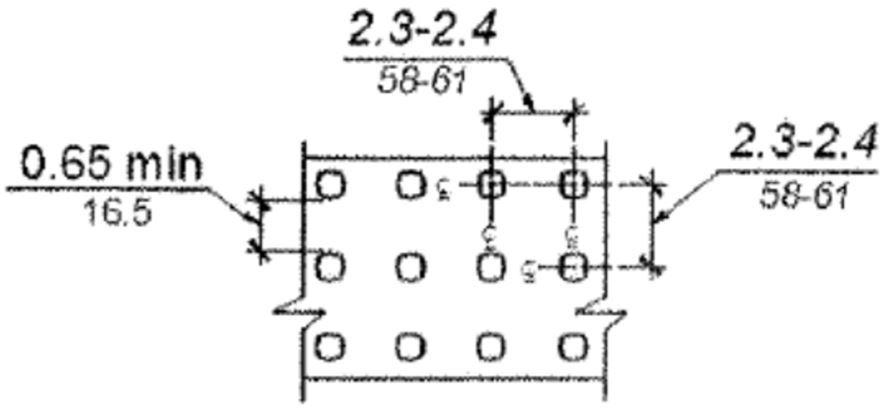
(b) plan
FIGURE 11B-705.1 SIZE AND SPACING OF TRUNCATED DOMES ‡‡
11B-705.1.1.3 Color and contrast. Detectable warning surfaces shall comply with Section 11B-705.1.1.3.1. The material used to comply with this section shall be an integral part of the detectable warning surface.
Exceptions:
1. Replacement of less than 20 percent of existing detectable warnings at a single contiguous location shall be permitted to be in-kind at existing curb ramps, islands, or cut-through medians with detectable warnings in compliance with the code requirements in effect at the time of installation.
2. Existing installed detectable warnings at curb ramps, islands, or cut-through medians may comply with Section 11B-705.1.1.3.2 in lieu of Section 11B-705.1.1.3.1.
Detectable warning surfaces shall be yellow and approximate 33538 of SAE AMS-STD-595A.
Detectable warning surfaces shall provide a 70 percent minimum visual contrast with adjacent walking surfaces. Contrast in percent shall be determined by:
Contrast percent = [(B1-B2)/B1] x 100 percent where
B1 = light reflectance value (LRV) of the lighter area and
B2 = light reflectance value (LRV) of the darker area.
[2010 ADA Standards] 705.1.3 Contrast. Detectable warning surfaces shall contrast visually with adjacent walking surfaces either light-on-dark, or dark-on-light.
Exception: Where the detectable warning surface does not provide a 70 percent minimum contrast with adjacent walking surfaces, a 1 inch (25 mm) wide minimum visually contrasting surface shall separate the detectable warning from adjacent walking surfaces. The visually contrasting surface shall contrast with both the detectable warning and adjacent walking surfaces either light-on-dark, or dark-on-light.
Detectable warning surfaces shall differ from adjoining surfaces in resiliency or sound-on-cane contact.
Exception: Detectable warning surfaces at curb ramps, islands or cut-through medians shall not be required to comply with Section 11B-705.1.1.4.
11B-705.1.2 Locations.
Detectable warnings at the following locations shall comply with Section 11B-705.1.
Detectable warning surfaces at platform boarding edges shall be 24 inches (610 mm) wide and shall extend the full length of the public use areas of the platform.
Detectable warnings at curb ramps shall comply with Section 11B-705.1.2.2.
11B-705.1.2.2.1 Perpendicular curb ramps.
Detectable warnings at perpendicular curb ramps shall extend 36 inches (914 mm) in the direction of travel. Detectable warnings shall extend the full width of the ramp run less 2 inches (51 mm) maximum on each side, excluding any flared sides. Detectable warnings shall be located so the edge nearest the curb is 6 inches (152 mm) minimum and 8 inches (203 mm) maximum from the demarcation line at the face of the curb between the curb and the gutter, street or highway.
11B-705.1.2.2.2 Parallel curb ramps.
Detectable warnings at parallel curb ramps shall be located so the edge nearest the curb is 6 inches (152 mm) minimum and 8 inches (203 mm) maximum from the demarcation line at the face of the curb between the curb and the gutter, street or highway. Detectable warnings shall extend the full width of the turning space at the demarcation between the street and the sidewalk less 2 inches (sic) (51 mm) maximum on each side.
11B-705.1.2.2.2.1 One entrance/exit point.
Where the turning space has one entrance/exit point other than the sloped ramp segments, detectable warnings shall be 36 inches (914 mm) deep, as measured perpendicular to the curb, and the turning space shall provide a minimum 36 inches (914 mm) wide portion without detectable warnings to allow pedestrian travel in the direction of the sidewalk without travelling over the detectable warnings.
Exceptions:
1. Where it is technically infeasible to provide a minimum 72 inches (1828 mm) wide turning space, as measured perpendicular to the curb, the depth of detectable warnings may be reduced to 24 inches (610 mm) minimum.
2. Existing parallel curb ramps with detectable warnings in compliance with the code requirements in effect at the time of installation shall not be required to provide a minimum 36 inches (914 mm) wide portion of the turning space without detectable warnings.
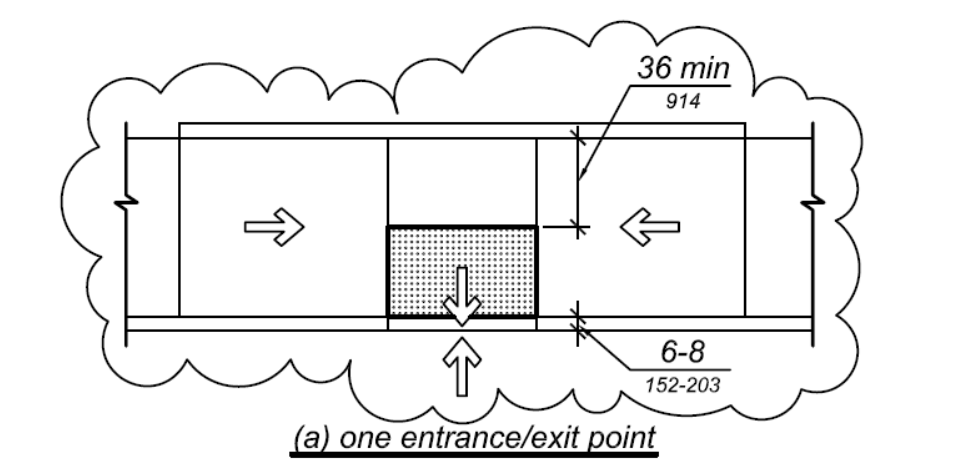
FIGURE 11B-705.1.2.2.2
PARALLEL CURB RAMPS
11B-705.1.2.2.2.2 Two entrance/exit points.
Where the turning space has two entrance/exit points other than the sloped ramp segments, detectable warnings shall be 36 inches (914 mm) deep at both entrance/ exit points, as measured perpendicular to the curb, and the turning space shall provide a minimum 36 inches (914 mm) wide portion without detectable warnings to allow pedestrian travel in the direction of the sidewalk without travelling over the detectable warnings.
Exceptions:
1. Where it is technically infeasible to provide a minimum 108 inches (2743 mm) wide turning space, as measured perpendicular to the curb, the depth of detectable warnings may be reduced to 24 inches (610 mm) minimum.
2. Existing parallel curb ramps with detectable warnings in compliance with the code requirements in effect at the time of installation shall not be required to provide a minimum 36 inches (914 mm) wide portion of the turning space without detectable warnings.
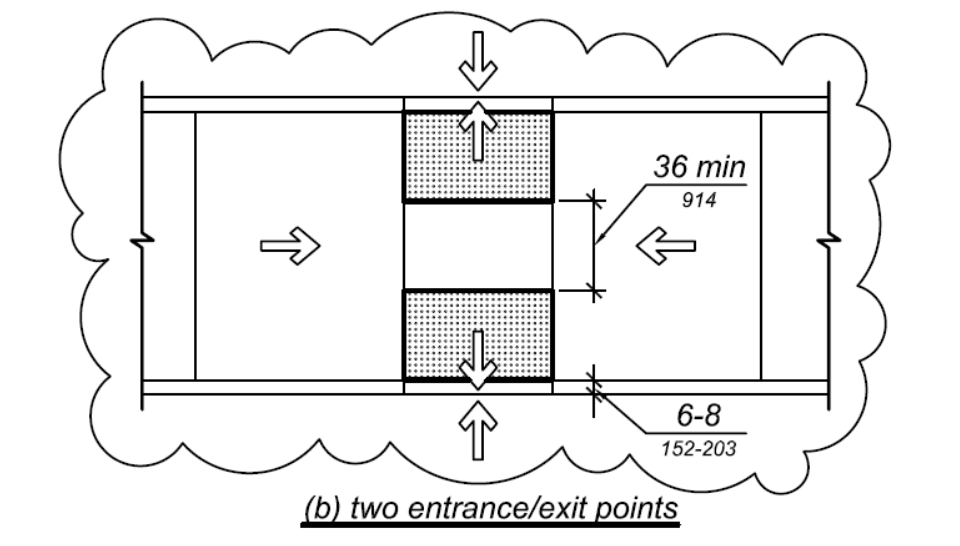
FIGURE 11B-705.1.2.2.2
PARALLEL CURB RAMPS
11B-705.1.2.3 Islands or cut-through medians.
Detectable warnings at pedestrian islands or cut-through medians shall be 36 inches (914 mm) minimum in depth extending the full width of the pedestrian path or cut-through less 2 inches (51 mm) maximum on each side, placed at the edges of the pedestrian island or cut-through median, and shall be separated by 24 inches (610 mm) minimum of walking surface without detectable warnings.
Exception: Detectable warnings shall be 24 inches (610 mm) minimum in depth at pedestrian islands or cut-through medians that are less than 96 inches (2438 mm) in length in the direction of pedestrian travel.
When detectable warnings are provided at bus stop boarding and alighting areas, the detectable warnings shall extend the full width of the boarding/alighting area and shall be 36 inches (914 mm) minimum in depth.
11B-705.1.2.5 Blended transitions. Detectable warnings at blended transitions shall be 36 inches (914 mm) in width.
11B-705.1.2.6 Reflecting pools.
When detectable warnings are provided at reflecting pools, it shall be 24 inches (610 mm) minimum and 36 inches (914 mm) maximum in width.
11B-705.1.2.7 Track crossings.
Detectable warnings at track crossings shall be 36 inches (914 mm) in the direction of pedestrian travel and extend the full width of the circulation path.
11B-705.2 Detectable directional texture.
Detectable directional texture at transit boarding platforms shall comply with Figure 11B-705.2 and shall be 0.1 inch (2.5 mm) in height that tapers off to 0.04 inch (1.0 mm), with bars raised 0.2 inch (5.1 mm) from the surface. The raised bars shall be 1.3 inches (33 mm) wide and 3 inches (76 mm) from center-to-center of each bar. This surface shall differ from adjoining walking surfaces in resiliency or sound-on-cane contact. The color shall be yellow and approximate FS 33538 of Federal Standard 595C. This surface will be placed directly behind the yellow detectable warning texture specified in Section 11B-705.1.2.1, aligning with all doors of the transit vehicles where passengers will embark. The width of the directional texture shall be equal to the width of the transit vehicle’s door opening. The depth of the texture shall not be less than 36 inches (914 mm).

(a) elevation (enlarged)
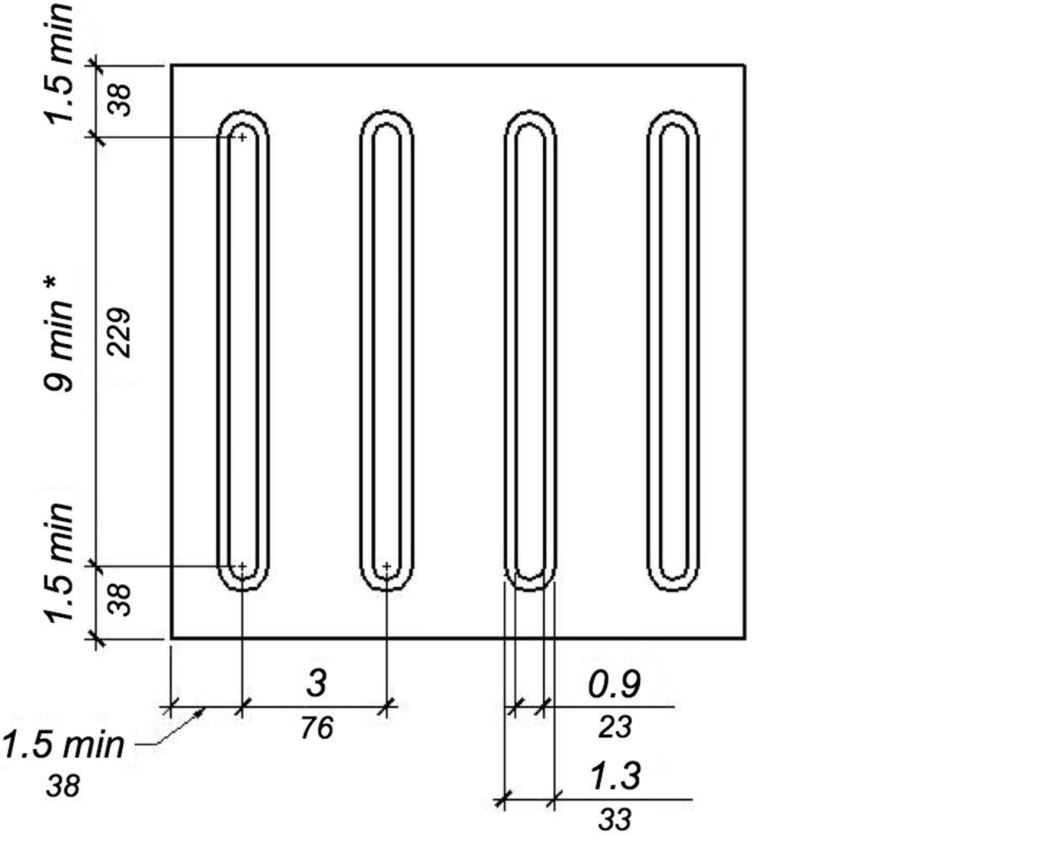
*industry standard for overall bar length is 11 1/4 - 11 1/2 (286 mm-292 mm)
(b) plan
FIGURE 11B-705.2 DETECTABLE DIRECTIONAL TEXTURE
11B-705.3 Product Approval.
Only approved DSA-AC detectable warning products and directional surfaces shall be installed as provided in the California Code of Regulations (CCR), Title 24, Part 1, Chapter 5, Articles 2, 3 and 4. Refer to CCR Title 24, Part 12, Chapter 11B, Section 12-11B.205 for building and facility access specifications for product approval for detectable warning products and directional surfaces.
11B-706.1 General.
Assistive listening systems required in assembly areas, conference and meeting rooms shall comply with Section 11B-706.
[2010 ADA Standards] 706.1 General. Assistive listening systems required in assembly areas shall comply with 706.

The technical standards for assistive listening systems describe minimum performance levels for volume, interference, and distortion. Sound pressure levels (SPL), expressed in decibels, measure output sound volume. Signal-to-noise ratio (SNR or S/N), also expressed in decibels, represents the relationship between the loudness of a desired sound (the signal) and the background noise in a space or piece of equipment. The higher the SNR, the more intelligible the signal. The peak clipping level limits the distortion in signal output produced when high-volume sound waves are manipulated to serve assistive listening devices.
Selecting or specifying an effective assistive listening system for a large or complex venue requires assistance from a professional sound engineer. The federal Access Board has published technical assistance on assistive listening devices and systems. ◼
11B-706.2 Receiver jacks.
Receivers required for use with an assistive listening system shall include a 1/8 inch (3.2 mm) standard mono jack.
11B-706.3 Receiver hearing-aid compatibility.
Receivers required to be hearing-aid compatible shall interface with telecoils in hearing aids through the provision of neckloops.

11B-706.4 Sound pressure level.
Assistive listening systems shall be capable of providing a sound pressure level of 110 dB minimum and 118 dB maximum with a dynamic range on the volume control of 50 dB.
11B-706.5 Signal-to-noise ratio.
The signal-to-noise ratio for internally generated noise in assistive listening systems shall be 18 dB minimum.
11B-706.6 Peak clipping level.
Peak clipping shall not exceed 18 dB of clipping relative to the peaks of speech.
11B-707 Automatic teller machines, fare machines and point-of-sale devices
[2010 ADA Standards] 707 Automatic Teller Machines and Fare Machines

11B-707.1 General.
Automatic teller machines, fare machines and point-of-sale devices shall comply with Section 11B-707.
[2010 ADA Standards] 707.1 General. Automatic teller machines and fare machines shall comply with 707.

11B-707.2 Clear floor or ground space.
A clear floor or ground space complying with Section 11B-305 shall be provided.
Exception: Clear floor or ground space shall not be required at drive-up only automatic teller machines and fare machines.
11B-707.3 Operable parts.
Operable parts shall comply with Section 11B-309. Unless a clear or correct key is provided, each operable part shall be able to be differentiated by sound or touch, without activation.
Exceptions:
- Drive-up only automatic teller machines and fare machines shall not be required to comply with Sections 11B-309.2 and 11B-309.3.
- Where automatic teller machines and fare machines do not require compliance with 11B-707.2, compliance with 11B-309.2 and 11B-309.3 shall not be required.
- Where point-of-sale devices do not require compliance with Section 11B-707.2, compliance with Sections 11B-309.2 and 11B-309.3 shall not be required.
11B-707.4 Privacy.
Automatic teller machines shall provide the opportunity for the same degree of privacy of input and output available to all individuals.

The Department of Justice considers the communication-related elements of ATMs to be auxiliary aids and services, rather than structural elements, to which the Safe Harbor allowance for elements built in compliance with the 1991 Standards does not apply. The Department believes that the limitations on the effective communication requirements, i.e., a covered entity does not have to take measures that would result in a fundamental alteration of its program or would cause undue burdens, provide adequate protection to operators of ATMs. [From Part 36 Nondiscrimination on the Basis of Disability in Public Accommodations and Commercial Facilities (as amended by the final rule published on September 15, 2010)].
11B-707.5 Speech output.
Machines shall be speech enabled. Operating instructions and orientation, visible transaction prompts, user input verification, error messages, and all displayed information for full use shall be accessible to and independently usable by individuals with vision impairments. Speech shall be delivered through a mechanism that is readily available to all users, including but not limited to, an industry standard connector or a telephone handset. Speech shall be recorded or digitized human, or synthesized.
Exceptions:
- Audible tones shall be permitted instead of speech for visible output that is not displayed for security purposes, including but not limited to, asterisks representing personal identification numbers.
- Advertisements and other similar information shall not be required to be audible unless they convey information that can be used in the transaction being conducted.
- Where speech synthesis cannot be supported, dynamic alphabetic output shall not be required to be audible.

11B-707.5.1 User control.
Speech shall be capable of being repeated or interrupted. Volume control shall be provided for the speech function.
Exception: Speech output for any single function shall be permitted to be automatically interrupted when a transaction is selected.
11B-707.5.2 Receipts.
Where receipts are provided, speech output devices shall provide audible balance inquiry information, error messages, and all other information on the printed receipt necessary to complete or verify the transaction.
Exceptions:
- Machine location, date and time of transaction, customer account number, and the machine identifier shall not be required to be audible.
- Information on printed receipts that duplicates information available on-screen shall not be required to be presented in the form of an audible receipt.
- Printed copies of bank statements and checks shall not be required to be audible.
11B-707.6 Input.
Input devices shall comply with Section 11B-707.6.
11B-707.6.1 Input controls.
At least one tactilely discernible input control shall be provided for each function. Where provided, key surfaces not on active areas of display screens, shall be raised above surrounding surfaces. Where membrane keys are the only method of input, each shall be tactilely discernible from surrounding surfaces and adjacent keys.
11B-707.6.2 Numeric keys.
Numeric keys shall be arranged in a 12-key ascending or descending telephone keypad layout. The number five key shall be tactilely distinct from the other keys.

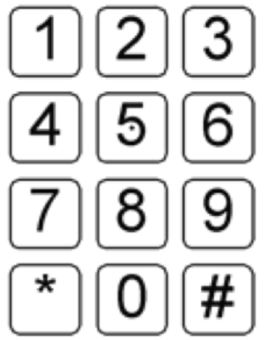
(a) 12-key
ascending
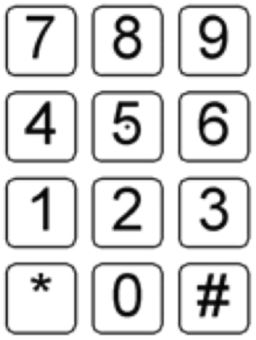
(b) 12-key
descending
FIGURE 11B-707.6.2 NUMERIC KEY LAYOUT
11B-707.6.3 Function keys.
Function keys shall comply with Section 11B-707.6.3.
Function keys shall contrast visually from background surfaces. Characters and symbols on key surfaces shall contrast visually from key surfaces. Visual contrast shall be either light-on-dark or dark-on-light.
Exception: Tactile symbols required by Section 11B-707.6.3.2 shall not be required to comply with Section 11B-707.6.3.1.
11B-707.6.3.2 Tactile symbols.
Function key surfaces shall have tactile symbols as follows: Enter or Proceed key: raised circle; Clear or Correct key: raised left arrow; Cancel key: raised letter ex; Add Value key: raised plus sign; Decrease Value key: raised minus sign.
11B-707.7 Display screen.
The display screen shall comply with Section 11B-707.7.
Exception: Drive-up only automatic teller machines and fare machines shall not be required to comply with Section 11B-707.7.1.
11B-707.7.1 Visibility.
The display screen shall be visible from a point located 40 inches (1016 mm) above the center of the clear floor space in front of the machine.
11B.707.7.1.1 Vertically mounted display screen.
Where display screens are mounted vertically or tipped away from the viewer less than 30 degrees, the center line of the display screen and other display devices shall be no more than 52 inches (1321 mm) above the floor or ground surface.
11B.707.7.1.2 Angle-mounted display screen.
Where display screens are mounted tipped away from the viewer 30 degrees to less than 60 degrees from vertical, the center line of the display screen and other display devices shall be no more than 44 inches (1118 mm) above the floor or ground surface.
11B.707.7.1.3 Horizontally mounted display screen.
Where display screens are mounted tipped away from the viewer 60 degrees to 90 degrees (horizontal) from vertical, the center line of the display screen and other display devices shall be no more than 34 inches (864 mm) above the floor or ground surface.
11B-707.7.2 Characters.
Characters displayed on the screen shall be in a sans serif font. Characters shall be 3/16 inch (4.8 mm) high minimum based on the uppercase letter "I". Characters shall contrast with their background with either light characters on a dark background or dark characters on a light background.
11B-707.8 Braille instructions.
Braille instructions for initiating the speech mode shall be provided. Braille shall comply with Section 11B-703.3.
11B-707.9.1 General.
Point-of-sale systems that include a video touch screen or any other non-tactile keypad shall be equipped with either of the following:
11B-707.9.1.1 Tactilely discernible numerical keypad.
A tactilely discernible numerical keypad similar to a telephone keypad containing a raised dot with a dot base diameter between 1.5 mm and 1.6 mm and a height between 0.6 mm and 0.9 mm on the number 5 key that enables a visually impaired person to enter his or her own personal identification number or any other personal information necessary to process the transaction in a manner that provides the opportunity for the same degree of privacy input and output available to all individuals.
11B-707.9.1.2 Other technology.
Other technology, such as a radio frequency identification device, fingerprint biometrics, or some other mechanism that enables a visually impaired person to access the video touch screen device with his or her personal identifier and to process his or her transaction in a manner that provides the opportunity for the same degree of privacy input and output available to all individuals. Where a video screen overlay is provided it shall be equipped with a tactilely discernible numerical keypad complying with Section 11B-707.9.1.1.
11B-708.1 General.
Two-way communication systems shall comply with Section 11B-708.

11B-708.2 Audible and visual indicators.
The system shall provide both audible and visual signals.

11B-708.3 Handsets.
Handset cords, if provided, shall be 29 inches (737 mm) long minimum.
11B-708.4 Residential dwelling unit communication systems.
Communications systems between a residential dwelling unit and a site, building, or floor entrance shall comply with Section 11B-708.4.
11B-708.4.1 Common use or public use system interface.
The common use or public use system interface shall include the capability of supporting voice and TTY communication with the residential dwelling unit interface.
11B-708.4.2 Residential dwelling unit interface.
The residential dwelling unit system interface shall include a telephone jack capable of supporting voice and TTY communication with the common use or public use system interface.
11B-801.1 Scope.
The provisions of Division 8 shall apply where required by Division 2 or where referenced by a requirement in this chapter.

11B-802 Wheelchair spaces, companion seats, and designated aisle seats and semi-ambulant seats
[2010 ADA Standards] 802 Wheelchair Spaces, Companion Seats, and Designated Aisle Seats
11B-802.1.1 Floor or ground surface.
The floor or ground surface of wheelchair spaces shall comply with Section 11B-302. Changes in level, slopes exceeding 1:48, and detectable warnings shall not be permitted.
Exception: Reserved.
11B-802.1.2 Width.
A single wheelchair space shall be 36 inches (914 mm) wide minimum. Where two adjacent wheelchair spaces are provided, each wheelchair space shall be 33 inches (838 mm) wide minimum.

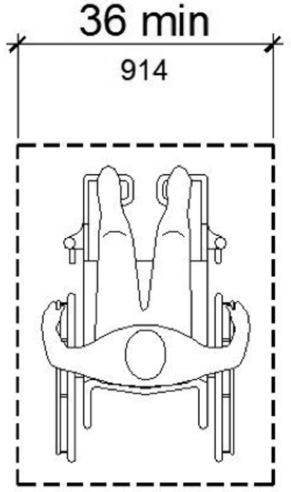
(a) single space
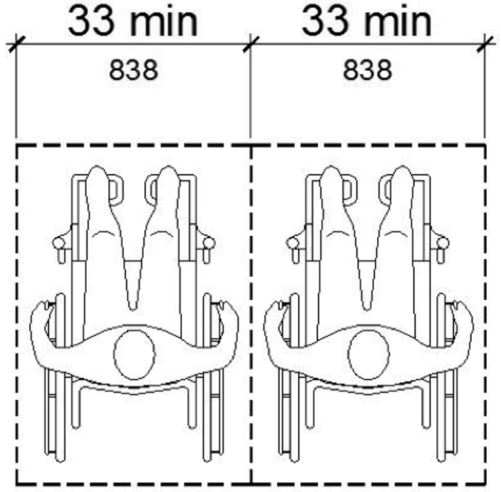
(b) two spaces
FIGURE 11B-802.1.2 WIDTH OF WHEELCHAIR SPACES
11B-802.1.3 Depth.
Where a wheelchair space can be entered from the front or rear, the wheelchair space shall be 48 inches (1219 mm) deep minimum. Where a wheelchair space can be entered only from the side, the wheelchair space shall be 60 inches (1524 mm) deep minimum.

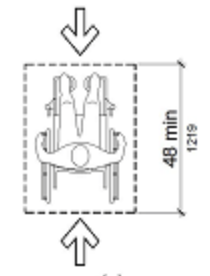
(a) front or rear entry
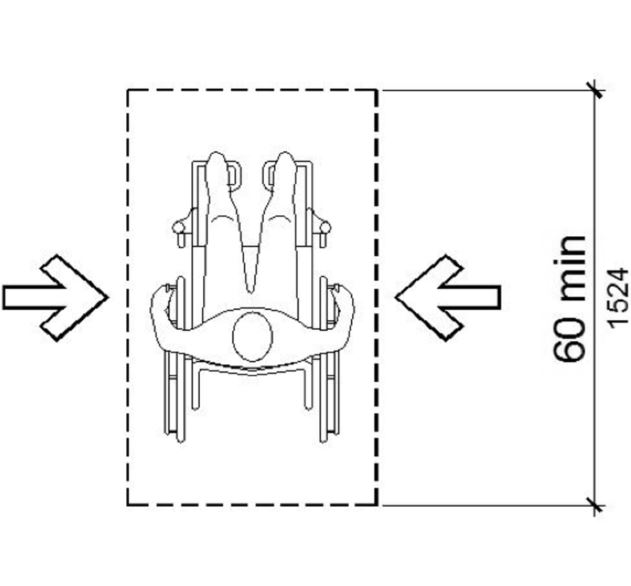
(b) side entry
FIGURE 11B-802.1.3 DEPTH OF WHEELCHAIR SPACES
11B-802.1.4 Approach.
Wheelchair spaces shall adjoin accessible routes. Accessible routes shall not overlap wheelchair spaces.

11B-802.1.5 Overlap.
Wheelchair spaces shall not overlap circulation paths.

11B-802.2 Lines of sight.
Lines of sight to the screen, performance area, or playing field for spectators in wheelchair spaces shall comply with Section 11B-802.2.
11B-802.2.1 Lines of sight over seated spectators.
Where spectators are expected to remain seated during events, spectators in wheelchair spaces shall be afforded lines of sight complying with Section 11B-802.2.1.
11B-802.2.1.1 Lines of sight over heads.
Where spectators are provided lines of sight over the heads of spectators seated in the first row in front of their seats, spectators seated in wheelchair spaces shall be afforded lines of sight over the heads of seated spectators in the first row in front of wheelchair spaces.
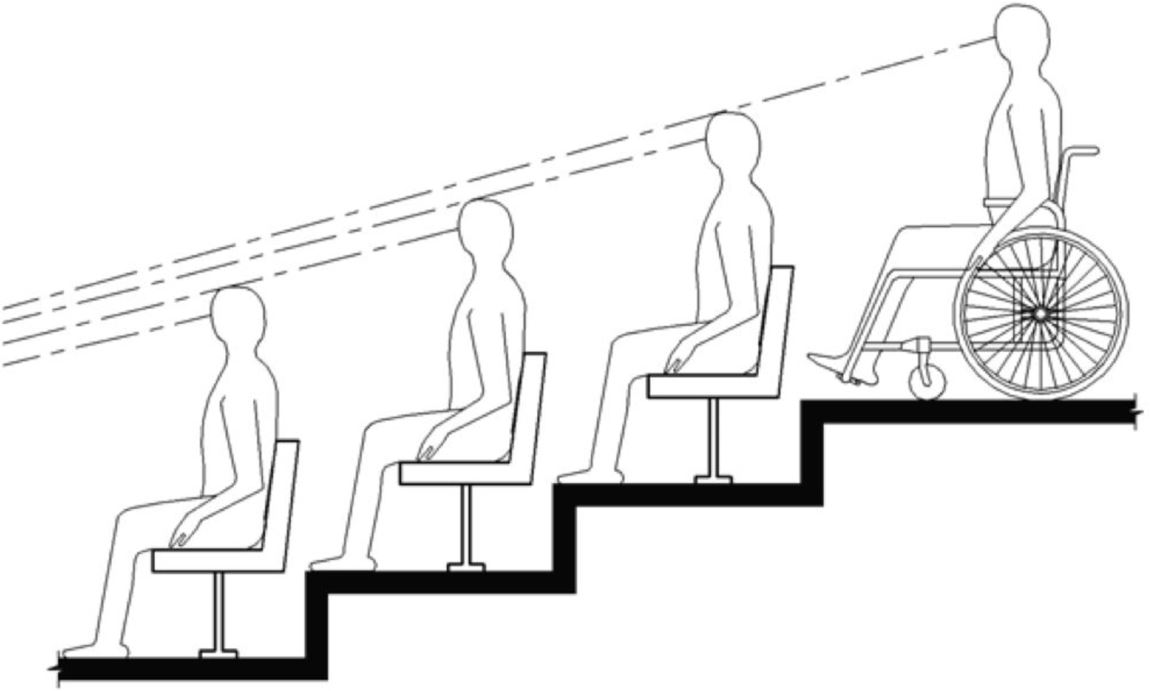
FIGURE 11B-802.2.1.1 LINES OF SIGHT OVER THE HEADS OF SEATED SPECTATORS
11B-802.2.1.2 Lines of sight between heads.
Where spectators are provided lines of sight over the shoulders and between the heads of spectators seated in the first row in front of their seats, spectators seated in wheelchair spaces shall be afforded lines of sight over the shoulders and between the heads of seated spectators in the first row in front of wheelchair spaces.
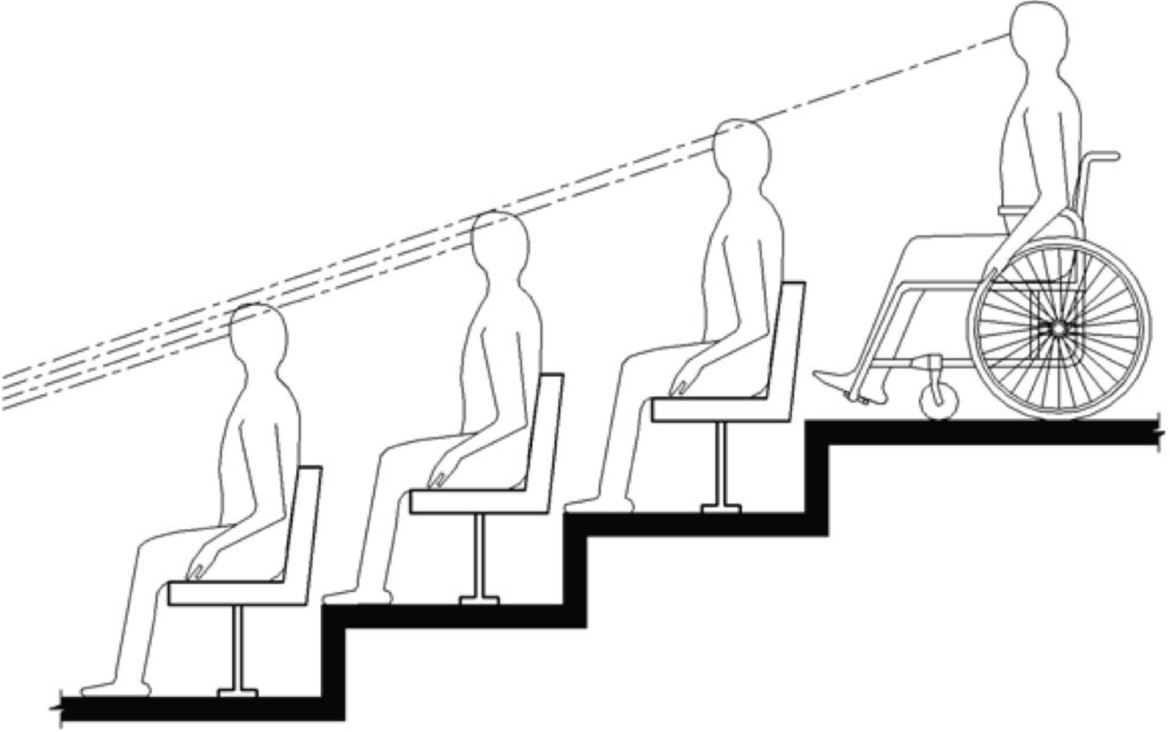
FIGURE 11B-802.2.1.2 LINES OF SIGHT BETWEEN THE HEADS OF SEATED SPECTATORS
11B-802.2.2 Lines of sight over standing spectators.
Where spectators are expected to stand during events, spectators in wheelchair spaces shall be afforded lines of sight complying with Section 11B-802.2.2.
11B-802.2.2.1 Lines of sight over heads.
Where standing spectators are provided lines of sight over the heads of spectators standing in the first row in front of their seats, spectators seated in wheelchair spaces shall be afforded lines of sight over the heads of standing spectators in the first row in front of wheelchair spaces.
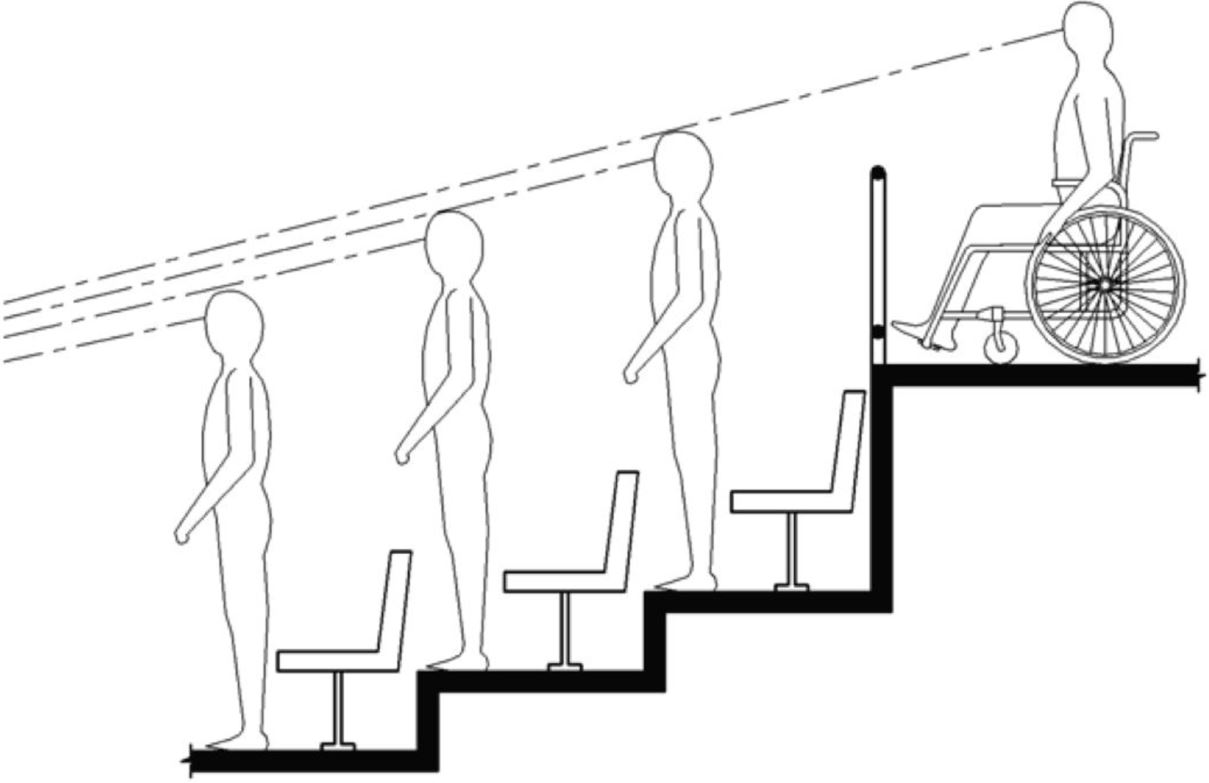
FIGURE 11B-802.2.2.1 LINES OF SIGHT OVER THE HEADS OF STANDING SPECTATORS
11B-802.2.2.2 Lines of sight between heads.
Where standing spectators are provided lines of sight over the shoulders and between the heads of spectators standing in the first row in front of their seats, spectators seated in wheelchair spaces shall be afforded lines of sight over the shoulders and between the heads of standing spectators in the first row in front of wheelchair spaces.
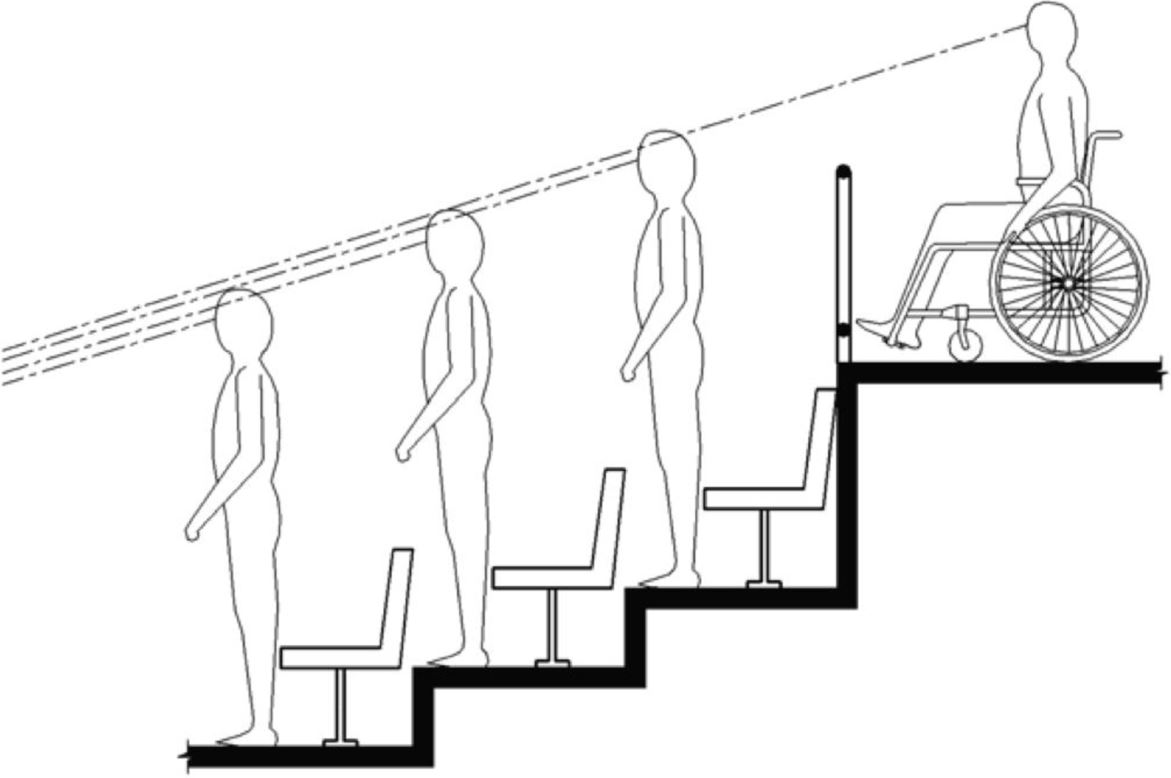
FIGURE 11B-802.2.2.2 LINES OF SIGHT BETWEEN THE HEADS OF STANDING SPECTATORS
11B-802.3 Companion seats.
Companion seats shall comply with Section 11B-802.3.
11B-802.3.1 Alignment.
In row seating, companion seats shall be located to provide shoulder alignment with adjacent wheelchair spaces. The shoulder alignment point of the wheelchair space shall be measured 36 inches (914 mm) from the front of the wheelchair space. The floor surface of the companion seat shall be at the same elevation as the floor surface of the wheelchair space.
11B-802.3.2 Type.
Companion seats shall be equivalent in size, quality, comfort, and amenities to the seating in the immediate area. Companion seats shall be permitted to be movable.
11B-802.4 Designated aisle seats.
Designated aisle seats shall comply with Section 11B-802.4.
11B-802.4.1 Armrests.
Where armrests are provided on the seating in the immediate area, folding or retractable armrests shall be provided on the aisle side of the seat.
11B-802.4.2 Identification.
Each designated aisle seat shall be identified by a sign or marker with the International Symbol of Accessibility complying with Section 11B-703.7.2.1. Signs complying with Section 11B-703.5, notifying patrons of the availability of such seats shall be posted at the ticket office.
[2010 ADA Standards] 802.4.2 Identification. Each designated aisle seat shall be identified by a sign or marker.


11B-802.5 Semi-ambulant seats.
Semi-ambulant seats shall provide at least 24 inches (610 mm) clear leg space between the front of the seat to the nearest obstruction or to the back of the seat immediately in front.
11B-803.1 General.
Dressing, fitting, and locker rooms shall comply with Section 11B-803.

11B-803.2 Turning space.
Turning space complying with Section 11B-304 shall be provided within the room.
11B-803.3 Door swing.
Doors shall not swing into the room unless a turning space complying with Section 11B-304.3 is provided beyond the arc of the door swing.
11B-803.4 Benches.
A bench complying with Section 11B-903 shall be provided within the room.
11B-803.5 Coat hooks and shelves.
Coat hooks provided within the room shall be located within one of the reach ranges specified in Section 11B-308. Shelves shall be 40 inches (1016 mm) minimum and 48 inches (1219 mm) maximum above the finish floor or ground. Coat hooks shall not be located above the bench or other seating in the room.
[2010 ADA Standards] 803.5 Coat Hooks and Shelves. Coat hooks provided within the room shall be located within one of the reach ranges specified in 308. Shelves shall be 40 inches (1015 mm) minimum and 48 inches (1220 mm) maximum above the finish floor or ground.
11B-803.6 Mirrors.
Mirrors shall be installed with the bottom edge of the reflecting surface 20 inches (508 mm) maximum above the finish floor or ground. Mirrors shall be full length with a reflective surface 18 inches (457 mm) wide minimum by 54 inches (1372 mm) high minimum and shall be mounted in a position affording a view to a person on the bench as well as to a person in a standing position.
11B-804.2 Clearance.
Where a pass through kitchen is provided, clearances shall comply with Section 11B-804.2.1. Where a U-shaped kitchen is provided, clearances shall comply with Section 11B-804.2.2.
Exception: Spaces that do not provide a cooktop or conventional range shall not be required to comply with Section 11B-804.2.

11B-804.2.1 Pass through kitchen.
In pass through kitchens where counters, appliances or cabinets are on two opposing sides, or where counters, appliances or cabinets are opposite a parallel wall, clearance between all opposing base cabinets, counter tops, appliances, or walls within kitchen work areas shall be 40 inches (1016 mm) minimum. Pass through kitchens shall have two entries.
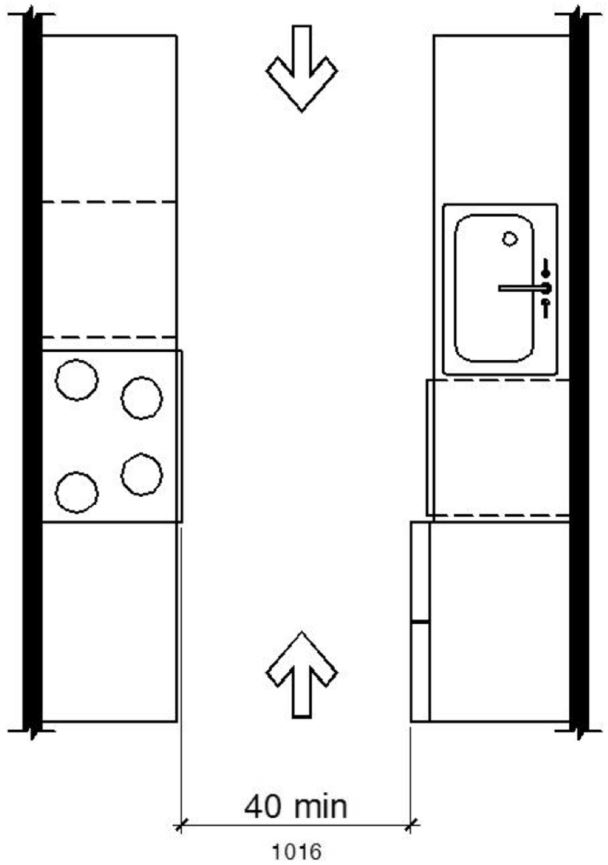
FIGURE 11B-804.2.1 PASS THROUGH KITCHENS
11B-804.2.2 U-Shaped.
In U-shaped kitchens enclosed on three contiguous sides, clearance between all opposing base cabinets, counter tops, appliances, or walls within kitchen work areas shall be 60 inches (1524 mm) minimum.
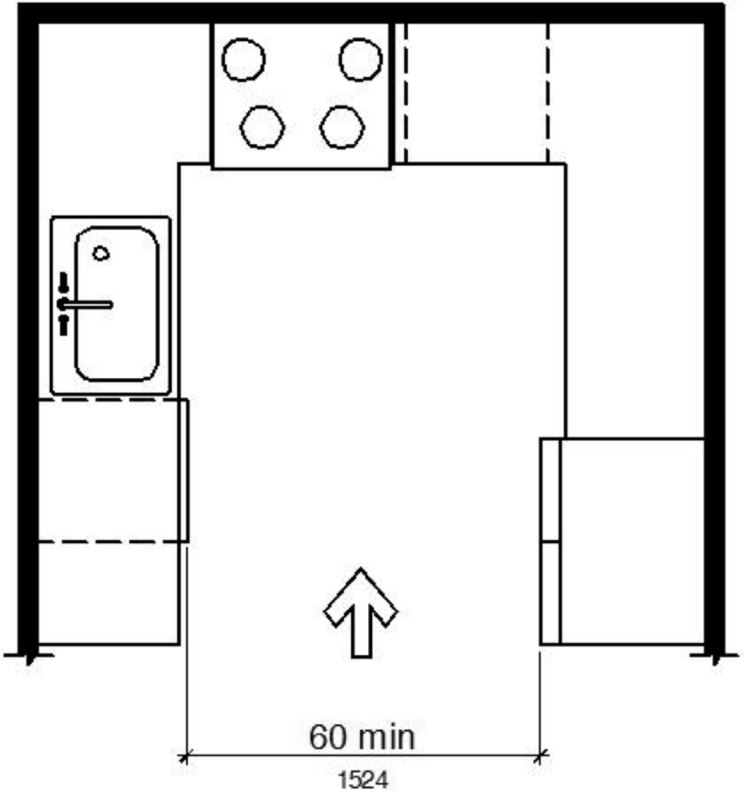
(a)
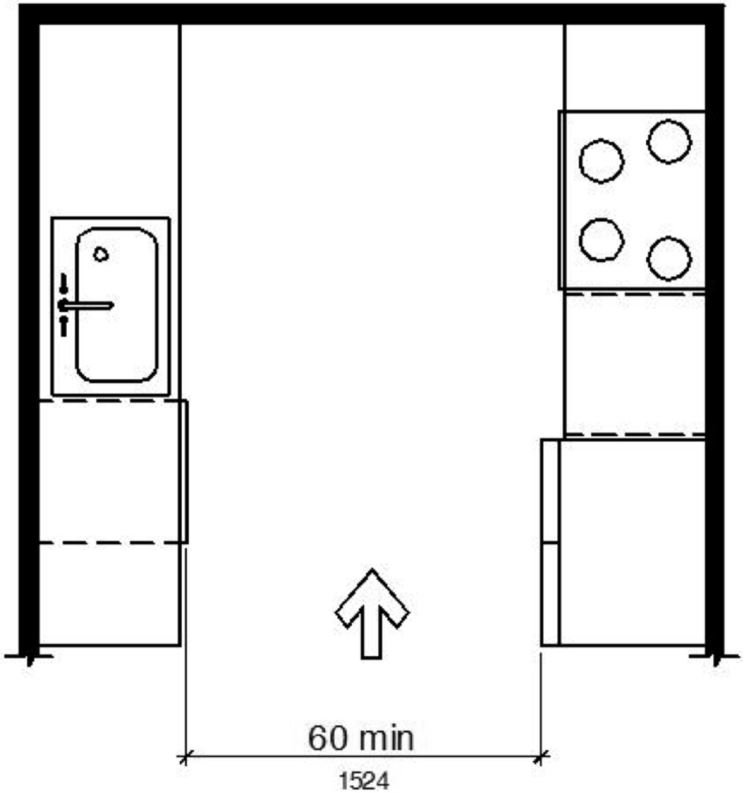
(b)
FIGURE 11B-804.2.2 U-SHAPED KITCHENS
11B-804.2.3 Turning space.
In kitchens within multi-bedroom housing units and on floors containing accessible sleeping rooms with adaptable features in undergraduate student housing, turning spaces complying with Section 11B-304 shall be provided.
11B-804.3 Kitchen work surface.
In residential dwelling units required to comply with Section 11B-809, at least one 30 inches (762 mm) wide minimum section of counter shall provide a kitchen work surface that complies with Section 11B-804.3. In kitchens within multi-bedroom housing units and on floors containing accessible sleeping rooms with adaptable features in undergraduate student housing, at least one 30 inches (762 mm) wide minimum section of counter shall provide a kitchen work surface that complies with Section 11B-804.3.
11B-804.3.1 Clear floor or ground space.
A clear floor space complying with Section 11B-305 positioned for a forward approach shall be provided. The clear floor or ground space shall be centered on the kitchen work surface and shall provide knee and toe clearance complying with Section 11B-306.
Exception: Cabinetry shall be permitted under the kitchen work surface provided that all of the following conditions are met:
(a) the cabinetry can be removed without removal or replacement of the kitchen work surface;
(b) the finish floor extends under the cabinetry; and
(c) the walls behind and surrounding the cabinetry are finished.
11B-804.3.2 Height.
The kitchen work surface shall be 34 inches (864 mm) maximum above the finish floor or ground.
Exception: A counter that is adjustable to provide a kitchen work surface at variable heights, 29 inches (737 mm) minimum and 36 inches (914 mm) maximum, shall be permitted.
11B-804.3.3 Exposed surfaces.
There shall be no sharp or abrasive surfaces under the work surface counters.
11B-804.5 Storage.
At least 50 percent of shelf space in storage facilities shall comply with Section 11B-811.
11B-804.6 Appliances.
Where provided, kitchen appliances shall comply with Section 11B-804.6.
11B-804.6.1 Clear floor or ground space.
A clear floor or ground space complying with Section 11B-305 shall be provided at each kitchen appliance. Clear floor or ground spaces shall be permitted to overlap.
11B-804.6.2 Operable parts.
All appliance controls shall comply with Section 11B-309.
Exceptions:
- Appliance doors and door latching devices shall not be required to comply with Section 11B-309.4.
- Bottom-hinged appliance doors, when in the open position, shall not be required to comply with Section 11B-309.3.
11B-804.6.3 Dishwasher.
Clear floor or ground space shall be positioned adjacent to the dishwasher door. The dishwasher door, in the open position, shall not obstruct the clear floor or ground space for the dishwasher or the sink.
11B-804.6.4 Range or cooktop.
Where a forward approach is provided, the clear floor or ground space shall provide knee and toe clearance complying with Section 11B-306. Where knee and toe space is provided, the underside of the range or cooktop shall be insulated or otherwise configured to prevent burns, abrasions, or electrical shock. The location of controls shall not require reaching across burners.
11B-804.6.5.1 Side-hinged door ovens.
Side-hinged door ovens shall have the work surface required by Section 11B-804.3 positioned adjacent to the latch side of the oven door.
11B-804.6.5.2 Bottom-hinged door ovens.
Bottom-hinged door ovens shall have the work surface required by Section 11B-804.3 positioned adjacent to one side of the door.
Ovens shall have controls on front panels.
11B-804.6.6 Refrigerator/freezer.
Combination refrigerators and freezers shall have at least 50 percent of the freezer space 54 inches (1372 mm) maximum above the finish floor or ground. The clear floor or ground space shall be positioned for a parallel approach to the space dedicated to a refrigerator/freezer with the centerline of the clear floor or ground space offset 24 inches (610 mm) maximum from the centerline of the dedicated space.
11B-805 Medical care and long-term care facilities
ETA Editor's Note
The numbering of subsections within Section 11B-805 is not aligned between CBC and 2010 ADA Standards. The CBC requirements are considerably more extensive, as indicated by the italicized requirements below.
11B-805.1 General.
Medical care facilities and long-term care facilities shall comply with Section 11B-805. All common use spaces and public use spaces in medical care facilities and long-term care facilities shall comply with this chapter.
[2010 ADA Standards] 805.1 General. Medical care facility and long-term care facility patient or resident sleeping rooms required to provide mobility features shall comply with 805.
11B-805.2 Patient bedrooms and resident sleeping rooms.
Patient bedrooms and resident sleeping rooms required to provide mobility features shall comply with Section 11B-805.2.
ETA Editor's Note
According to the Office of Statewide Health Planning and Development (OSHPD), "resident sleeping rooms," not defined in CBC Chapter 2, refers to the bedrooms of long-term care occupants. The scoping for accessibility of On-Call Rooms for physicians and other staff is addressed at Subsection 11B-223.2.3, and these are treated as Transient Lodging components.
11B-805.2.1 Hand washing fixtures.
Hand washing fixtures shall comply with Section 11B-606.
11B-805.2.2 Beds.
A 36 inch (914 mm) minimum wide clear space shall be provided along the full length of each side of the beds.
[2010 ADA Standards] 805.3 Clear Floor or Ground Space. A clear floor space complying with 305 shall be provided on each side of the bed. The clear floor space shall be positioned for parallel approach to the side of the bed.
11B-805.2.3 Turning space.
Turning space complying with Section 11B-304 shall be provided within the room.
11B-805.2.4 Toilet and bathing rooms.
Toilet and bathing rooms that are provided as part of patient bedrooms and resident sleeping rooms complying with Section 11B-223.2 or 11B-223.3 shall comply with Section 11B-603. Where provided, one water closet, one lavatory, and one bathtub or shower shall comply with the applicable requirements of Sections 11B-603 through 11B-610.
[2010 ADA Standards] 805.4 Toilet and Bathing Rooms. Toilet and bathing rooms that are provided as part of a patient or resident sleeping room shall comply with 603. Where provided, no fewer than one water closet, one lavatory, and one bathtub or shower shall comply with the applicable requirements of 603 through 610.
11B-805.3 Waiting rooms.
Waiting rooms shall comply with Section 11B-805.3.
11B-805.3.1 Wheelchair spaces.
Where seating is provided in waiting rooms, at least 5 percent of the seating shall be wheelchair spaces complying with Section 11B-802.1.
Exception: In waiting rooms serving facilities specializing in treating conditions that affect mobility, 10 percent of the seating shall be wheelchair spaces complying with Section 11B-802.1.
11B-805.4 Examination, diagnostic and treatment rooms.
Examination, diagnostic and treatment rooms shall comply with Section 11B-805.4.
ETA Editor's Note
The Office of Statewide Health Planning and Development (OSHPD), which has jurisdiction over hospitals and long-term care facilities in California, issued Code Application Notice CAN 2-11B, dated 9/9/14, which includes the following interpretation of Section 11B-805.4:
Examination, diagnostic and treatment rooms refer to all patient care areas and include but are not limited to: exam rooms, treatment rooms, imaging rooms, operating rooms, emergency rooms, post anesthesia recovery rooms/units, dialysis rooms/units, infusion rooms/units, labor/delivery/recovery rooms and observation rooms/units. All examination, diagnostic and treatment rooms shall be accessible. Toilet rooms that are accessed from an examination, diagnostic or treatment room shall also be accessible. Note that all patient toilet rooms, other than those specifically exempted (i.e. non-accessible patient rooms and ICU patient rooms), must comply with Section 11B-603.
This is a scoping requirement, apparently misplaced outside Chapter 11B, Division 2.
As of the initial publication of this Guide, OSHPD has not updated CAN 2-11B for applicability to 2019 CBC. Since there is no change to the wording of Subsection 11B-805.4 from 2013 CBC to 2019 CBC, there is no reason to expect that OSHPD will change its interpretation.
11B-805.4.1 Beds, exam tables, procedure tables, gurneys and lounge chairs.
A 36 inch (914 mm) minimum wide clear space shall be provided along the full length of each side of beds, exam tables, procedure tables, gurneys and lounge chairs.
Exception: General exam rooms in non-emergency settings may provide clear space on only one side of beds, gurneys and exam tables.
11B-805.4.2 Equipment.
Clear space complying with Section 11B-305.2 shall be provided as required for specific equipment.
11B-805.4.3 Turning space.
Turning space complying with Section 11B-304 shall be provided within the room.
ETA Editor's Note
The Office of Statewide Health Planning and Development (OSHPD), which has jurisdiction over hospitals and long-term care facilities in California, issued Code Application Notice CAN 2-11B, dated 9/9/14, which includes the following interpretation of Subsections 11B-805.4.1, 11B-805.4.2 and 11B-805.4.3:
All patient care areas must provide access to the area and to the bed, exam table, procedure table, gurney, lounge chair and/or equipment/apparatus associated with the delivery of care, exam, diagnosis or treatment performed in the space. Access includes compliance with Division 4 of Chapter 11B for travel to, and circulation within, the patient care area; and turning space in compliance with Section 11B-304. A minimum of a 36-inch wide access shall be provided to and along each side of the bed, exam table, procedure table, gurney, lounge chair and/or equipment/apparatus. "Each side" includes both sides and the foot, but does not include the head unless the provision of care requires it. Refer to the following examples:
Exam room - Exam rooms are required to provide a turning space, accessible handwashing fixture, and 36-inch wide access along the full length of each side and the foot of the exam table. The exception is in reference to general exam rooms only. These are restricted to those meeting the definition of exam room in CBC Section 1224.3. Specific exam rooms required to be larger than 80 square feet are not considered "general exam rooms" and are not eligible for the exception.
Treatment room - Treatment rooms are required to provide a turning space, accessible handwashing fixture, accessible counter and writing surface, and 36-inch wide access along the full length of each side and foot of the treatment table. If the treatment room is intended to accommodate procedures requiring access to the head (e.g. minor surgery, etc.), all four sides of the table require 36-inch wide access.
Equipment - Exam or treatment rooms with equipment such as imaging must provide a turning space, accessible handwashing fixture if required, and 36-inch wide access to both sides and the foot of the table. The head of the equipment does not require 36-inch access if only used for servicing.
CBC Chapter 12, Section 1224 applies to hospitals, and 1224.3, referenced above, includes the following definition: EXAM ROOM. A room with a bed, stretcher, or examination table and capability for periodic monitoring (e.g., measurement of blood pressure or pulse oximetry) in which procedures that do not require a specialized suite can be performed (e.g., pelvic examination, blood transfusion).
OSHPD has not yet made it clear which, if any, movable items are allowed within the required 36-inch wide access.
As of the initial publication of this Guide, OSHPD has not updated CAN 2-11B for applicability to 2019 CBC. Since there is no change to the wording of Subsections 11B-805.4.1, 11B-805.4.2 and 11B-805.4.3 from 2013 CBC to 2019 CBC, there is no reason to expect that OSHPD will change its interpretation.
11B-805.5 Patient change areas.
Areas where patients change or are prepared for a procedure shall comply with Section 11B-222.
11B-805.6 Hand washing fixtures, lavatories and sinks.
All hand washing fixtures, lavatories and sinks shall comply with Section 11B-606.
Exception: Scrub sinks, as defined in California Plumbing Code Section 221.0, shall not be required to comply with Section 11B-606.
ETA Editor's Note
The Office of Statewide Health Planning and Development (OSHPD), which has jurisdiction over hospitals and long-term care facilities in California, issued Code Application Notice CAN 2-11B, dated 9/9/14, which includes the following interpretation of Section 11B-805.6:
The requirements of Section 11B-606 apply to all lavatories, sinks, and handwashing fixtures for public use, patient use, and employee use, unless otherwise specifically exempted by the code. Lavatories, sinks, and handwashing fixtures are common use areas and therefore, require accessibility.
Exceptions:
- Scrub sinks (due to impracticality)
- Specific workstations (see Section 11B-203.9). This applies only where the sink is the actual workstation.
Example: A sink used exclusively for cleaning endoscopes. The sink is the actual area where work is performed as opposed to a place where the employee cleans up before and after performing work elsewhere in the room.
Knee clearance requirement - All accessibility requirements of Section 11B-606 apply to lavatories, sinks and handwashing fixtures required to be accessible. Lavatories are subject to Section 11B-306.3.3, Exception 1 which states: "At lavatories required to be accessible by Section 11B-213.3.4, the knee clearance shall be 27 inches (686 mm) high minimum above the finish floor or ground at a depth of 8 inches (203 mm) minimum increasing to 29 inches (737 mm) high minimum above the finish floor or ground at the front edge of a counter with a built-in lavatory or at the front edge of a wall-mounted lavatory fixture."
This requirement applies to all lavatories. "Handwashing fixtures" are special application "sinks" and not subject to the exception. Handwashing fixtures, as sinks, are subject to Section 11B-306.2.3, Exception 1 which states" "The toe clearance shall extend 19 inches minimum under sinks required to be accessible by Section 11B-212.3."
Consequently, handwashing fixtures must have a minimum depth of 19 inches in order to comply with the minimum toe clearance. They shall also have a minimum knee clearance of 27 inches at the depth and reduction described in Sections 11B-306.3.3 and 11B-306.3.4.
The implications of this interpretation are that a wall-mounted china fixture of the most common size, nominally 20 inches wide x 18 inch projection, cannot serve as a handwashing fixture. See also the ETA Editor's Note at 11B-212.3.
As of the initial publication of this Guide, OSHPD has not updated CAN 2-11B for applicability to 2019 CBC. Since there is no change to the wording of Section 11B-805.6 from 2013 CBC to 2019 CBC, there is no reason to expect that OSHPD will change its interpretation.
11B-805.7 Built-in cabinets and work surfaces.
Built-in cabinets, counters and work surfaces shall be accessible, including: patient wardrobes, nurse’s stations, administrative centers, reception desks, medicine preparation areas, laboratory work stations, equipment consoles, clean and soiled utility cabinets, and storage areas; and shall comply with Sections 11B-225 and 11B-902.
Exceptions:
- Built-in wardrobes in patient bedrooms and resident sleeping rooms not required to be accessible are not required to comply with the provisions of this chapter.
- Clinical laboratory work stations provided in a laboratory area that are in addition to the minimum number required to be accessible (5 percent of the work stations provided, but no fewer than one), are not required to comply with the provisions of Section 11B-902.
ETA Editor's Note
The Office of Statewide Health Planning and Development (OSHPD), which has jurisdiction over hospitals and long-term care facilities in California, issued Code Application Notice CAN 2-11B, dated 9/9/14, which includes the following interpretation of Section 11B-805.7:
Built-in equipment consoles include recessed or wall mounted Electronic Medical Record (EMR) systems. These units must also comply with US Access Board Section 508 Standards for Electronic and Information Technology. A 30-inch by 48-inch clear floor space, in compliance with Section 11B-305, shall be centered in front of the display screen. Wall-mounted units shall comply with protrusion limits prescribed in Section 11B-307.2. Touch screen units shall be allowed to be vertically mounted with the centerline of the display screen no more than 52 inches above the floor in compliance with Section 11B-707.7.1.1. These units will need the capability of an alternate input method such as a wireless keyboard made available to those who would need it.
As of the initial publication of this Guide, OSHPD has not updated CAN 2-11B for applicability to 2019 CBC. Since there is no change to the wording of Section 11B-805.7 from 2013 CBC to 2019 CBC, there is no reason to expect that OSHPD will change its interpretation.
11B-806.1 General.
Transient lodging guest rooms shall comply with Section 11B-806. Guest rooms required to provide mobility features shall comply with Section 11B-806.2. Guest rooms required to provide communication features shall comply with Section 11B-806.3.
11B-806.2 Guest rooms with mobility features.
Guest rooms required to provide mobility features shall comply with Section 11B-806.2.

11B-806.2.1 Living and dining areas.
Living and dining areas shall be accessible.
11B-806.2.2 Exterior spaces.
Exterior spaces, including patios, terraces and balconies that serve the guest room shall be accessible.
11B-806.2.3 Sleeping areas.
At least one sleeping area shall provide a 36 inch (914 mm) by 48 inch (1219 mm) minimum clear space on both sides of a bed. The clear space shall be positioned for parallel approach to the side of the bed.
[2010 ADA Standards] 806.2.3 Sleeping Areas. At least one sleeping area shall provide a clear floor space complying with 305 on both sides of a bed. The clear floor space shall be positioned for parallel approach to the side of the bed.
Exception: Where a single clear floor space complying with Section 11B-305 positioned for parallel approach is provided between two beds, a clear floor or ground space shall not be required on both sides of a bed.
11B-806.2.3.1 Personal lift device floor space.
There shall be a clear space under the bed for the use of a personal lift device. The clear space shall extend under the bed parallel to the long side and be adjacent to an accessible route. The clear space shall extend to points horizontally 30 inches (762 mm), vertically 7 inches (178 mm) and not more than 12 inches (305 mm) from the head and foot end of the bed.
ETA Editor's Note
The clearance prescribed for a personal lift device at CBC 11B-806.2.3.1 is not required by 2010 ADA Standards.
11B-806.2.4 Toilet and bathing facilities.
At least one bathroom that is provided as part of a guest room shall comply with Section 11B-603. No fewer than one water closet, one lavatory, and one bathtub or shower shall comply with applicable requirements of Sections 11B-603 through 11B-610. In addition, required roll-in shower compartments shall comply with Section 11B-608.2.2 or 11B- 608.2.3. Toilet and bathing fixtures required to comply with Sections 11B-603 through 11B-610 shall be permitted to be located in more than one toilet or bathing area, provided that travel between fixtures does not require travel between other parts of the guest room.
11B-806.2.4.1 Vanity counter top space.
If vanity counter top space is provided in non-accessible guest toilet or bathing rooms, comparable vanity counter top space, in terms of size and proximity to the lavatory, shall also be provided in accessible guest toilet or bathing rooms.

11B-806.2.5 Kitchens, kitchenettes and wet bars. Kitchens, kitchenettes and wet bars shall comply with Section 11B-804.
[2010 ADA Standards] 806.2.5 Kitchens and Kitchenettes. Kitchens and kitchenettes shall comply with 804.
11B-806.2.6 Turning space.
Turning space complying with Section 11B-304 shall be provided within the guest room.
11B-806.3 Guest rooms with communication features.
Guest rooms required to provide communication features shall comply with Section 11B-806.3.

11B-806.3.1 Alarms.
Where emergency warning systems are provided, fire alarms shall comply with Section 11B-702 and carbon monoxide alarms shall comply with Chapter 4.
[2010 ADA Standards] 806.3.1 Alarms. Where emergency warning systems are provided, alarms complying with 702 shall be provided.
11B-806.3.2 Notification devices.
Visible notification devices shall be provided to alert room occupants of incoming telephone calls and a door knock or bell. Notification devices shall not be connected to visible alarm signal appliances. Telephones shall have volume controls compatible with the telephone system and shall comply with Section 11B-704.3. Telephones shall be served by an electrical outlet complying with Section 11B-309 located within 48 inches (1219 mm) of the telephone to facilitate the use of a TTY.
11B-807.1 General.
Holding cells and housing cells shall comply with Section 11B-807.
11B-807.2 Cells with mobility features.
Cells required to provide mobility features shall comply with Section 11B-807.2.
11B-807.2.1 Turning space.
Turning space complying with Section 11B-304 shall be provided within the cell.
11B-807.2.2 Benches.
Where benches are provided, at least one bench shall comply with Section 11B-903.
11B-807.2.3 Beds.
Where beds are provided, clear floor space complying with Section 11B-305 shall be provided on at least one side of the bed. The clear floor space shall be positioned for parallel approach to the side of the bed.
11B-807.2.4 Toilet and bathing facilities.
Toilet facilities or bathing facilities that are provided as part of a cell shall comply with Section 11B-603. Where provided, no fewer than one water closet, one lavatory, and one bathtub or shower shall comply with the applicable requirements of Sections 11B-603 through 11B-610.

11B-807.3 Cells with communication features.
Cells required to provide communication features shall comply with Section 11B-807.3.
11B-807.3.1 Alarms.
Where audible emergency alarm systems are provided to serve the occupants of cells, visible alarms complying with Section 11B-702 shall be provided.
Exception: Visible alarms shall not be required where inmates or detainees are not allowed independent means of egress.
11B-807.3.2 Telephones.
Telephones, where provided within cells, shall have volume controls complying with Section 11B-704.3.
11B-808.1 General.
Courtrooms shall comply with Section 11B-808.
11B-808.2 Turning space.
Where provided, areas that are raised or depressed and accessed by ramps or platform lifts with entry ramps shall provide unobstructed turning space complying with Section 11B-304.
11B-808.3 Clear floor space.
Each jury box and witness stand shall have, within its defined area, clear floor space complying with Section 11B-305.
Exception: In alterations, wheelchair spaces are not required to be located within the defined area of raised jury boxes or witness stands and shall be permitted to be located outside these spaces where ramp or platform lift access poses a hazard by restricting or projecting into a means of egress required by the appropriate administrative authority.
11B-808.4 Judges' benches and courtroom stations.
Judges' benches, clerks' stations, bailiffs' stations, deputy clerks' stations, court reporters' stations and litigants' and counsel stations shall comply with Section 11B-902.
11B-809.1 General.
When located within public housing facilities, residential dwelling units shall comply with Section 11B-809. Residential dwelling units required to provide mobility features shall comply with Sections 11B-809.2 through 11B-809.4. Residential dwelling units required to provide communication features shall comply with Section 11B-809.5.
[2010 ADA Standards] 809.1 General. Residential dwelling units shall comply with 809. Residential dwelling units required to provide mobility features shall comply with 809.2 through 809.4. Residential dwelling units required to provide communication features shall comply with 809.5.
11B-809.2 Accessible routes.
Accessible routes complying with Division 4 shall be provided within residential dwelling units in accordance with Section 11B-809.2.
Exception: Accessible routes shall not be required to or within unfinished attics or unfinished basements.
11B-809.2.1 Location.
At least one accessible route shall connect all spaces and elements which are a part of the residential dwelling unit. Where only one accessible route is provided, it shall not pass through bathrooms, closets, or similar spaces.
11B-809.2.2 Turning space.
All rooms served by an accessible route shall provide a turning space complying with Section 11B-304.
Exception: Turning space shall not be required in exterior spaces 30 inches (762 mm) maximum in depth or width.

11B-809.3 Kitchen.
Where a kitchen is provided, it shall comply with Section 11B-804.
11B-809.4 Toilet facilities and bathing facilities.
At least one bathroom shall comply with Section 11B-603. No fewer than one of each type of fixture provided within the bathroom shall comply with applicable requirements of Sections 11B-603 through 11B-610. Toilet and bathing fixtures required to comply with Sections 11B-603 through 11B-610 shall be located in the same bathroom or toilet and bathing area, such that travel between fixtures does not require travel between other parts of the residential dwelling unit.

11B-809.4.1 Subsequent bathrooms.
In residential dwelling units with more than one bathroom, when a bathtub is installed in the first bathroom in compliance with Section 11B-809.4 and a shower compartment is provided in a subsequent bathroom, at least one shower compartment shall comply with Section 11B-608.
ETA Editor's Note
The requirement for an accessible shower at subsequent bathrooms prescribed by CBC 11B-809.4.1 is not required by 2010 ADA Standards.
11B-809.5 Residential dwelling units with communication features.
Residential dwelling units required to provide communication features shall comply with Section 11B-809.5.
11B-809.5.1 Building fire alarm system.
Where a building fire alarm system is provided, the system wiring shall be extended to a point within the residential dwelling unit in the vicinity of the residential dwelling unit smoke detection system.
11B-809.5.1.1 Alarm appliances.
Where alarm appliances are provided within a residential dwelling unit as part of the building fire alarm system, they shall comply with Chapter 9, Section 907.5.2.3.3.
[2010 ADA Standards] 809.5.1.1 Alarm Appliances. Where alarm appliances are provided within a residential dwelling unit as part of the building fire alarm system, they shall comply with 702.
All visible alarm appliances provided within the residential dwelling unit for building fire alarm notification shall be activated upon activation of the building fire alarm in the portion of the building containing the residential dwelling unit.
11B-809.5.2 Residential dwelling unit smoke detection system and carbon monoxide detection system. Residential dwelling unit smoke detection systems shall comply with Chapter 9, Section 907.2.11. Residential dwelling unit carbon monoxide detection systems shall comply with Chapter 9, Section 915.
ETA Editor's Note
The lengthy California Building Code Chapter 9, Section 907.2.11 referenced above is not adopted by Division of the State Architect - Access Compliance (DSA-AC), and is not included in this Guide. To see this Section, consult California Code of Regulations, Title 24, Part 2 - 2019 California Building Code (2019 CBC), available for purchase from International Code Council (http://www.iccsafe.org).
[2010 ADA Standards] 809.5.2 Residential Dwelling Unit Smoke Detection System. Residential dwelling unit smoke detection systems shall comply with NFPA 72 (1999 or 2002 edition) (incorporated by reference, see "Referenced Standards" in Chapter 1).
All visible alarm appliances provided within the residential dwelling unit for smoke detection notification shall be activated upon smoke detection. All visible alarm appliances provided within the residential dwelling unit for carbon monoxide detection notification shall be activated upon carbon monoxide detection.
[2010 ADA Standards] 809.5.2.1 Activation. All visible alarm appliances provided within the residential dwelling unit for smoke detection notification shall be activated upon smoke detection.
11B-809.5.3 Interconnection.
The same visible alarm appliances shall be permitted to provide notification of residential dwelling unit smoke detection, building fire alarm activation, and carbon monoxide detection.
[2010 ADA Standards] 809.5.3 Interconnection. The same visible alarm appliances shall be permitted to provide notification of residential dwelling unit smoke detection and building fire alarm activation.
11B-809.5.4 Prohibited use.
Visible alarm appliances used to indicate residential dwelling unit smoke detection, carbon monoxide detection, or building fire alarm activation shall not be used for any other purpose within the residential dwelling unit.
[2010 ADA Standards] 809.5.4 Prohibited Use. Visible alarm appliances used to indicate residential dwelling unit smoke detection or building fire alarm activation shall not be used for any other purpose within the residential dwelling unit.
11B-809.5.5 Residential dwelling unit primary entrance.
Communication features shall be provided at the residential dwelling unit primary entrance complying with Section 11B-809.5.5.
A hard-wired electric doorbell shall be provided. A button or switch shall be provided outside the residential dwelling unit primary entrance. Activation of the button or switch shall initiate an audible tone and visible signal within the residential dwelling unit. Where visible doorbell signals are located in sleeping areas, they shall have controls to deactivate the signal.
A means for visually identifying a visitor without opening the residential dwelling unit entry door shall be provided and shall allow for a minimum 180 degree range of view.

11B-809.5.6 Site, building, or floor entrance.
Where a system, including a closed-circuit system, permitting voice communication between a visitor and the occupant of the residential dwelling unit is provided, the system shall comply with Section 11B-708.4.
11B-809.6 Residential dwelling units with adaptable features.
Multi-family residential dwelling units with adaptable features shall comply with Sections 11B-809.7 through 11B-809.12.
11B-809.7 Accessible routes.
An accessible route shall be provided complying with Section 11B-809.7. The accessible route shall pass through the primary entry door, through all rooms within the dwelling unit and exterior decks and balconies. The accessible route shall adjoin or overlap clear floor spaces and connect all exterior doors.
Exceptions:
-
An accessible route shall not be required from the interior of the unit into a basement.
-
An accessible route to a garage shall comply with Section 11B-208.3.3.
-
An accessible route shall not be required to rooms or spaces not located on the primary entry level of a multistory dwelling unit.
11B-809.7.1 Width.
The clear width for the accessible route shall be 36 inches (914 mm) minimum.
Exception: The clear width shall be permitted to be reduced to 32 inches (813 mm) minimum at doors.
11B-809.7.2 Changes in level.
Changes in level shall comply with Sections 11B-303.2 and 11B-303.3. Ramps complying with Section 11B-405, elevators complying with Section 11B-407 or platform lifts complying with Section 11B-410 shall be provided where changes in level exceed 1/2 inch (12.7 mm) high.
11B-809.8 Doors.
Primary entry doors, required exit doors, secondary exterior doors and interior doors intended for user passage shall comply with this section and Section 11B-404.2. Doors to small mechanical closets specifically dedicated to furnaces or hot water heaters shall not be required to comply with this section.
Exceptions: At primary entry doors, required exit doors, secondary exit doors and interior doors the following exceptions apply:
1. The floor or landing at primary entry doors, required exit doors, and secondary exit doors where a change in elevation occurs between the interior and the exterior surface of the floor or landing, shall comply with the following:
a. Exterior landings of impervious construction (e.g., concrete, brick, flagstone) serving primary entry doors and required exit doors are limited to not more than 1/2 inch (12.7 mm) of change in height between floor surfaces. Changes in level shall comply with Section 11B-809.7.2.
b. Exterior landings of pervious construction (e.g., wood decking with spaces) shall be the same level as the interior landing, except that secondary exterior doors may have no more than 1/2 inch (12.7 mm) of change in height between floor surfaces. Changes in level shall comply with Section 11B-809.7.2.
c. Secondary exterior doors onto decks, patios, or balcony surfaces constructed of impervious materials (e.g., concrete, brick, flagstone) may have a maximum change in height from the interior landing of 4 inches (102 mm). Changes in height greater than 1/2 inch (12.7 mm) shall be accomplished by means of a ramp complying with Section 11B-405 or by means of a platform constructed to the level of the floor as illustrated in Figure 11B-809.8 (c).
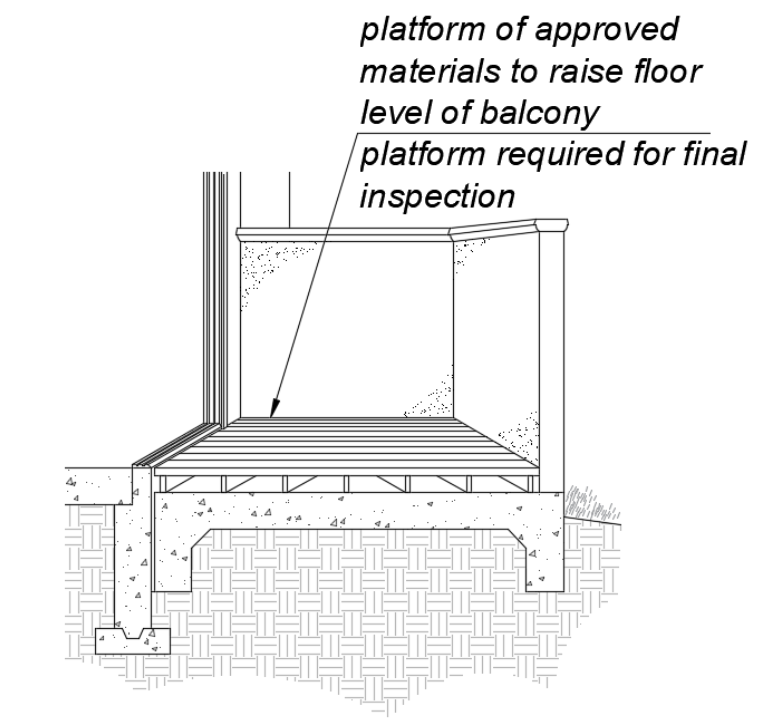
FIGURE 11B-809.8 Ex. 1(c)
PLATFORM AT SECONDARY EXTERIOR DOOR.
d. Secondary exterior doors onto decks, patios or balcony surfaces constructed of impervious materials (e.g., concrete, brick, flagstone) may have a maximum change in height from the interior landing of 1 inch (25 mm), provided a ramp with a maximum slope of 1:8 is permanently installed as illustrated in Figure 11B-809.8 (d).
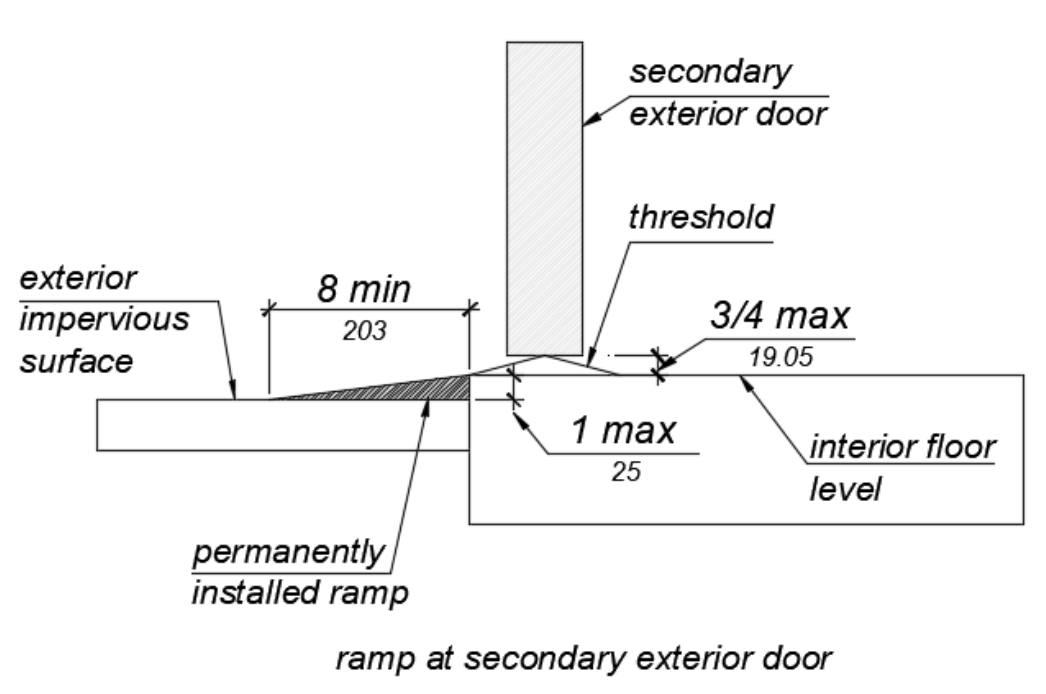
FIGURE 11B-809.8 Ex. 1(d)
RAMP AT SECONDARY EXTERIOR DOOR.
11B-809.8.1 Door Thresholds.
Secondary exterior door thresholds, including sliding door tracks, shall be 3/4 inch (19.1 mm) high maximum with a 1:2 maximum slope.
11B-809.8.2 Door opening force.
The opening force for primary entry exterior doors and secondary exterior doors shall be 8.5 pounds (38 N) maximum.
11B-809.8.3 Door maneuvering clearance.
-
At the dwelling unit side of the primary entry doors, secondary exterior doors, and required exit doors maneuvering clearances shall be 44 inches (1118 mm) minimum in length measured perpendicular to the face of the door in the closed position. The width of the maneuvering clearance shall extend 18 inches (457 mm) beyond the strike edge at the pull side of the door.
-
At interior doors maneuvering clearances shall be 42 inches (1067 mm) minimum in length on the both (sic) sides of the door measured perpendicular to the face of the door in the closed position. A 39 inch (991 mm) minimum length is allowed at interior doors when a clear opening width of 34 inches (864 mm) minimum is provided. The width of the maneuvering clearance shall extend 18 inches (457 mm) beyond the strike edge at the pull side of the door.
11B-809.8.4 Door signal devices.
Every primary entrance to a residential dwelling unit with adaptable features shall be provided with a door buzzer, bell, chime or equivalent. The activating mechanism shall be mounted 48 inches (1219 mm) maximum above the floor and connected to permanent wiring.
11B-809.9 Kitchens.
Kitchens shall be on an accessible route and shall comply with this section.
11B-809.9.1 Clear floor space.
Clear floor spaces 30 inches (762 mm) by 48 inches (1219 mm), with centerlines aligned with the centerline of the work surface, appliance, sink or fixture, shall be provided in the following locations:
-
For a parallel approach at the range.
-
For parallel or forward approach at a cooktop.
-
For a parallel or forward approach to the sink and to the work surface required by Sections 11B-809.9.3 and 11B-809.9.4.
-
For a parallel or forward approach to all other fixtures or appliances.
11B-809.9.2 Clear width.
Kitchens shall have a minimum clear width measured between any cabinet, work surface or the face of any appliance (excluding handles and controls) and the opposing cabinet, work surface, appliance or wall as follows:
a. U-shaped kitchens, designed with parallel approach at a sink, range, cooktop or other fixtures and appliances located at the base of the U without knee and toe clearance, shall provide a clear width of 60 inches (1524 mm) minimum.
b. U-shaped kitchens, with a cooktop, sink or work surface located at the base of the U, that provides knee and toe space complying Sections 11B-809.9.3 and 11B-809.9.4 to allow for a forward approach, shall provide a clear width of 48 inches (1219 mm) minimum.
c. All other kitchen designs shall provide a clear width of 48 inches (1219 mm) minimum.
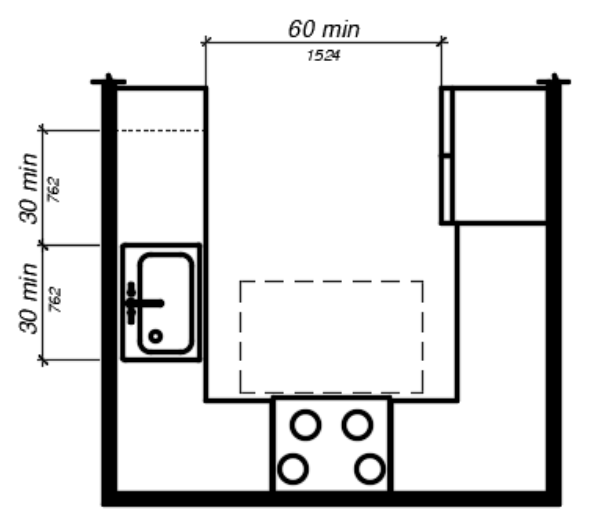
(a)
"U" shaped kitchen with parallel approach at range
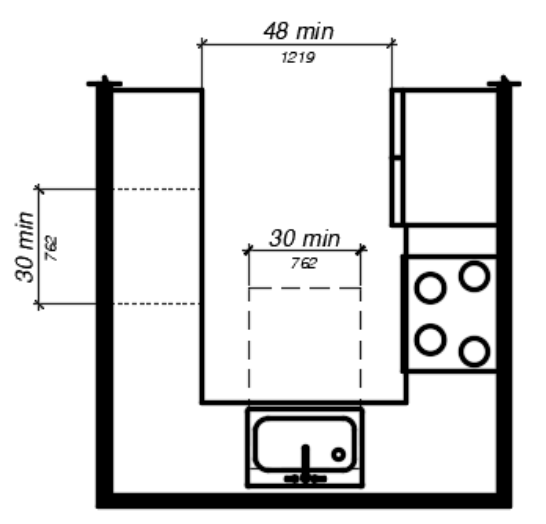
(b)
"U" shaped kitchen with forward approach at sink
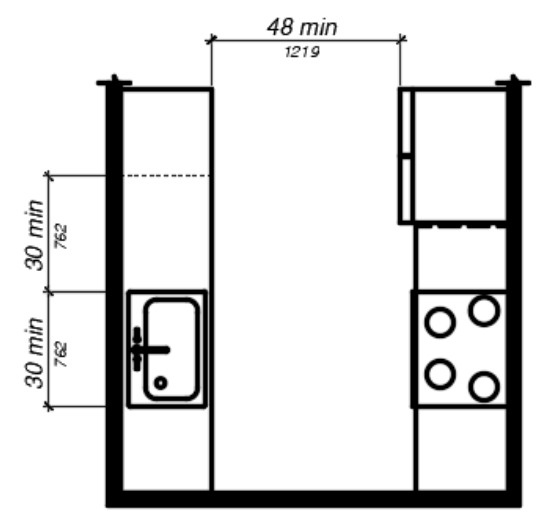
(c)
other kitchen designs
FIGURE 11B-809.9.2
CLEAR WIDTH AT KITCHENS.
11B-809.9.3 Removable base cabinets.
Knee and toe space complying with Section 11B-306 shall be provided at sinks and work surfaces required to comply with Section 11B-809.9.4.
Exception: Removable base cabinets shall be permitted under sinks and work surfaces provided that all of the following conditions are met:
a) base cabinets can be removed without the use of specialized tools or knowledge;
b) the finish floor extends under the base cabinet; and
c) the walls behind and surrounding the base cabinets are finished.
11B-809.9.4 Work surfaces.
Work surfaces shall be 36 inches (914 mm) maximum above the finish floor with minimum lengths at the following locations as required by this section:
-
Linear length of 30 inches (762 mm) minimum for installation of a sink.
-
Linear length of 30 inches (762 mm) minimum for work surfaces.
-
A sink and work surface in a single integral unit 60 inches (1524 mm) minimum in length, is permitted.
11B-809.9.5 Lower shelving.
Lower shelving and/or drawer space shall be provided at a height of 48 inches (1219 mm) maximum above the finish floor.
11B-809.9.6 Controls.
Controls for faucets shall comply with Section 11B-309.1. Hand-operated metering faucets shall remain open for 10 seconds minimum.
11B-809.9.7 Exposed pipes and surfaces.
Exposed water supply and drain pipes under sinks and lavatories shall comply with Section 11B-606.5.
11B-809.10.1 General.
All toilet and bathing rooms on an accessible route within residential dwelling units with adaptable features shall comply with Sections 11B-809.7, 11B-809.8, 11B-809.10.6.4, 11B-809.10.7.3 and 11B-809.12.
11B-809.10.2 Number of complying bathing rooms and fixtures.
One bathing room and one fixture of each type within the dwelling unit shall be designed to comply with the following:
-
Maneuvering space in toilet, bathing and shower rooms shall comply with Section 11B-809.10.4.
-
Bathtubs complying with Section 11B-809.10.5.
-
Showers complying with Section 11B-809.10.6.
-
Water closets complying with Section 11B-809.10.7.
-
Lavatories, vanities, mirrors and towel bars complying with Section 11B-809.10.8. When two or more lavatories are provided, at least one shall comply with Section 11B-809.10.8.
-
Where both a tub and shower are provided in the bathroom, at least one shall be made accessible. Where two or more bathrooms are provided, when a bathtub is installed in the first bathroom in compliance with Section 11B-809.10.5 and a shower compartment is provided in a subsequent bathroom, at least one shower compartment shall comply with Section 11B-809.10.6.
11B-809.10.3 Powder rooms.
Powder rooms shall be designed to comply with Sections 11B-809.7, 11B-809.8, 11B-809.10.5.2, 11B-809.10.6.4, 11B-809.10.7.3, and 11B-809.12. When the powder room is the only toilet facility located on an accessible level it shall, in addition, comply with Sections 11B-809.10.4, 11B-809.10.7 and 11B-809.10.8.
11B-809.10.4 Sufficient maneuvering space.
Where doors swing into the toilet and bathing or powder rooms required to comply with Section 11B-809.10, a clear maneuvering space of 30 (762 mm) inches by 48 inches (1219 mm) minimum shall be provided outside the arc of the door swing. The clear maneuvering space shall be permitted to include knee and toe clearance under bathroom fixtures. Doors shall be permitted to encroach into the clear floor space or clearance for fixtures where clear maneuvering space is provided outside the arc of the door swing. A turning space is not required within the room.
11B-809.10.5 Bathtubs.
Bathtubs required by Section 11B-809.10 shall comply with this section.
11B-809.10.5.1 Clear floor space.
A clear floor space 30 inches (762 mm) minimum by 48 inches (1219 mm) minimum shall be located with the long edge of the clear floor space parallel to the side of the bathtub or bathtub-shower combination. Controls shall be located on the wall at the foot of the bathtub. The edge of the clear floor space shall be flush with the control wall surface. The area under a lavatory, located at the control end of the tub, shall be permitted to encroach on the clear floor space provided the lavatory is 19 inches (483 mm) maximum in depth, and knee and toe clearance complying with Section 11B-306 is provided. Cabinets under lavatories and toilets shall not encroach on the clear floor space.
11B-809.10.5.2 Reinforcement for grab bars.
Reinforcement for grabs bars shall comply with the following:
1. Where bathtubs are installed without surrounding walls reinforcement shall be provided for floor-mounted grab bars.
2. Where bathtubs are installed with surrounding walls, grab bar reinforcement shall be installed as follows:
a. At the control end wall and head end wall, between 30 inches (762 mm) maximum to 38 inches (965 mm) minimum above the finish floor, extending 28 inches (711 mm) minimum from the front edge of the bathtub to the back wall of the bathtub. The grab bar reinforcement shall be 8 inches (203 mm) minimum in height.
b. At the back wall, from 5 inches (127 mm) maximum above the bathtub rim to 38 inches (965 mm) minimum above the finish floor. Grab bar backing shall be installed horizontally to permit the installation of a 48-inch (1219 mm) grab bar with each end 6 inches (152 mm) maximum from the end walls of the bathtub.
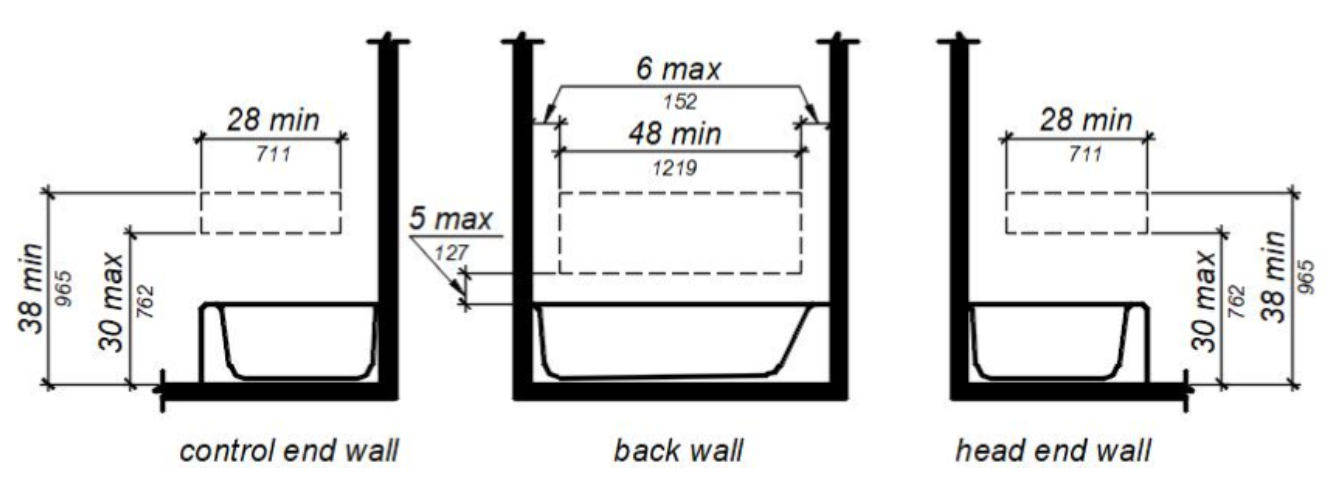
FIGURE 11B-809.10.5.2 REINFORCEMENT FOR GRAB BARS.
Controls and operating mechanisms shall comply with Section 11B-309.4.
Exception: Shower spray units are not required in bathtubs.
11B-809.10.5.4 Bathtub enclosures.
Doors and panels of bathtub enclosures shall be constructed from approved, shatter-resistant materials. Hinged doors shall open outward. Glazing used in doors and panels of bathtub enclosures shall be fully tempered, laminated safety glass or approved plastic. When glass is used, it shall be 1/8 inch (3.2 mm) thick minimum when fully tempered, or 1/4 inch (6.4 mm) thick minimum when laminated, and shall pass the test requirements of this part, Chapter 24 Glass and Glazing. Plastics used in doors and panels of bathtub enclosures shall be of a shatter-resistant type.
11B-809.10.6 Showers.
Showers required by Section 11B-809.10 shall comply with this section.
When one or more shower stalls are provided within the same dwelling unit, as least one shower stall shall comply with one of the following:
-
A transfer type shower compartment 36 inches (914 mm) wide by 36 inches (914 mm) deep with an entrance opening 36 inches (914 mm) complying with Section 11B-608.1 or;
-
A shower stall 30 inches (762 mm) deep minimum by 60 inches (1524 mm) wide minimum with an entrance opening 60 inches (1524 mm) minimum. A water closet shall be permitted to project 12 inches (305 mm) maximum into the opening provided that 36 inches (914 mm) minimum clear space is maintained between the water closet and the shower wall as illustrated in Figure 11B-809.10.6.1 or;
-
A shower stall 36 inches (914 mm) deep by 60 inches (1524 mm) wide minimum with an entrance 36 inches (914 mm) minimum when a wall is installed on the opening side.
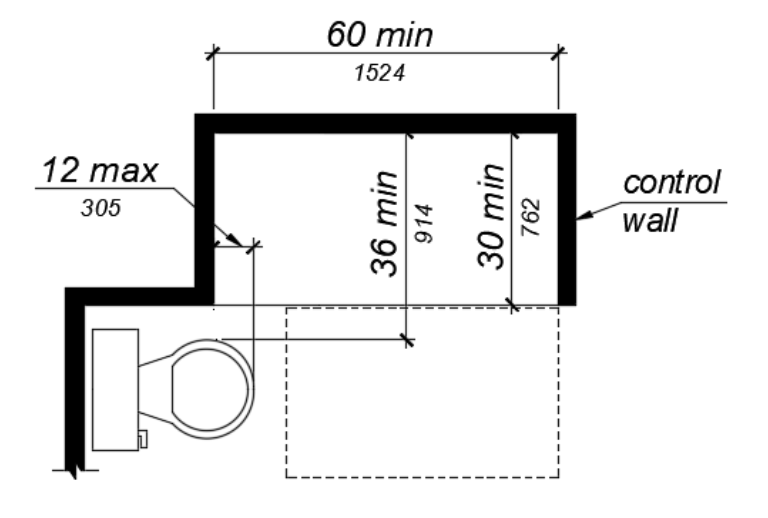
FIGURE 11B-809.10.6.1 SHOWERS.
The slope of the shower floor shall be 1/2 inch (12.7 mm) per foot maximum in any direction and shall slope to a drain. The floor surfaces shall be of Carborundum, grit-faced tile or of material providing equivalent slip resistance.
A clear maneuvering space 30 inches (762 mm) wide minimum by 48 inches (1219 mm) minimum in length shall be located outside the shower, with the width flush with the control wall and the length parallel to the length of the shower.
11B-809.10.6.4 Reinforcement for grab bars.
Reinforcement for grabs bars shall comply with the following: Continuous reinforcement shall be installed in the walls of showers 30 inches (762 mm) maximum to 38 inches (965 mm) minimum above the finish floor. The grab bar reinforcement shall be 8 inches (203 mm) minimum in height. Glass-walled shower stalls shall provide reinforcement for installation of floor-mounted or ceiling-mounted grab bars.
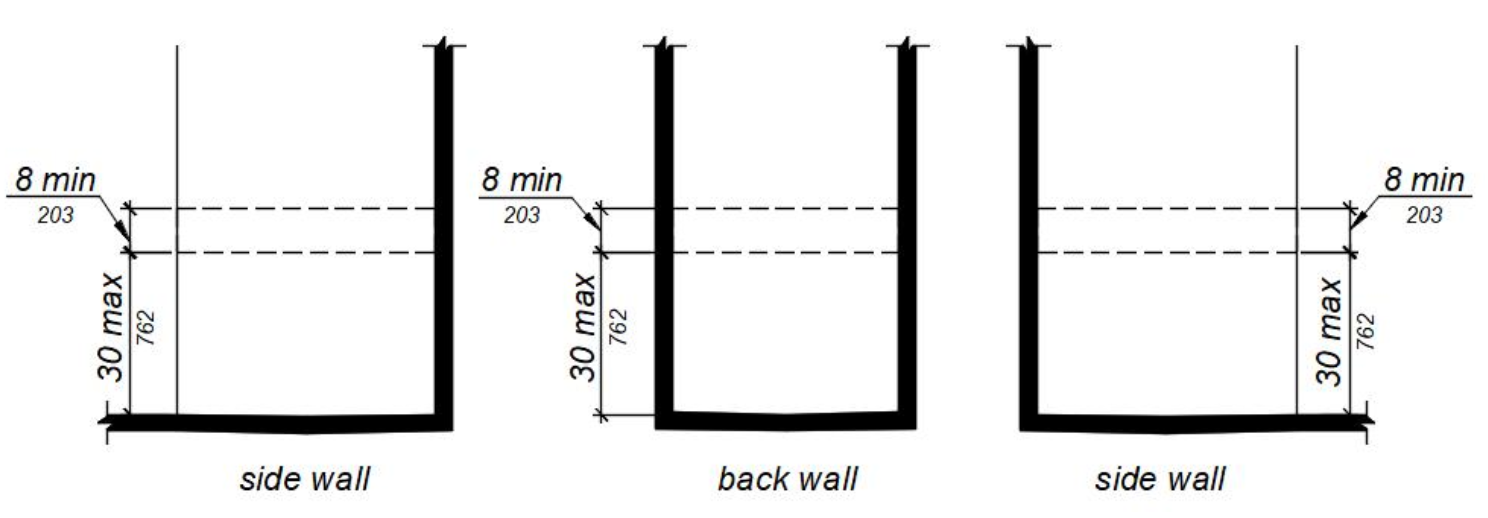
FIGURE 11B-809.10.6.4 REINFORCEMENT FOR GRAB BARS.
Where provided thresholds shall be 2 inches (51 mm) maximum in height and have a beveled or sloped angle not exceeding 1 unit vertical in 2 units horizontal (26.6 degrees from the horizontal). Thresholds 1/2 inch (12.7 mm) or less in height shall have a beveled or sloped angle not exceeding 1 unit vertical in 1 unit horizontal (45 degrees from the horizontal).
Controls and operating mechanisms shall comply with Section 11B-309.4.
11B-809.10.6.7 Shower enclosures.
Doors and panels of shower enclosures shall comply with Section 11B-809.10.5.4.
11B-809.10.7 Water closets.
Water closets required by Section 11B-809.10 shall comply with this section.
The floor space at water closets shall be 48 inches (1219 mm) wide minimum measured perpendicular to the side wall. A floor space 48 inches (1219 mm) wide minimum by 36 inches (914 mm) deep minimum shall be provided in front of the water closet.
Exception: The 48-inch (1219 mm) minimum clear width may be reduced to 36 inches (914 mm) minimum for lavatories, cabinets, wing walls, or privacy walls located immediately adjacent to a water closet which extend 24 inches (610 mm) maximum in depth.
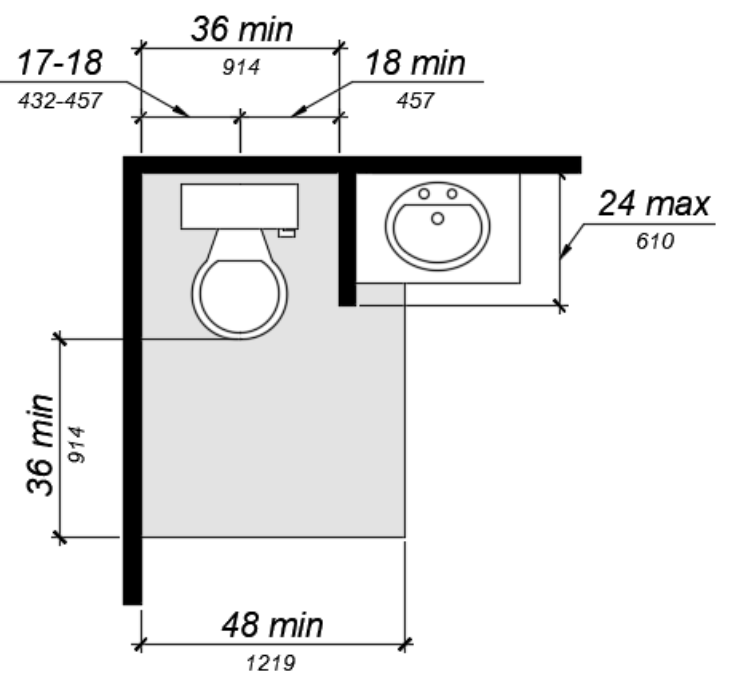
FIGURE 11B-809.10.7.1 FLOOR SPACE.
Water closets shall be located within bathrooms in a manner that permits a grab bar to be installed on at least one side of the fixture. The centerline of the water closet shall be 17 inches (432 mm) minimum to 18 inches (457 mm) maximum from a wall or partition that is 54 inches (1372 mm) minimum in length. In locations where water closets are adjacent to other walls, vanities, lavatories or bathtubs, the centerline of the fixture shall be 18 inches (457 mm) minimum from the obstacle.
11B-809.10.7.3 Reinforcement for grab bars.
Reinforcement for grabs bars shall comply with the following:
-
Where water closets are not placed adjacent to a side wall capable of accommodating a grab bar, the bathroom shall have provisions for installation of floor-mounted, foldaway or similar alternative grab bars.
-
Where water closets are placed adjacent to a side wall, reinforcement shall be installed on both sides or one side and the back. Where reinforcement is installed at the back, it shall be installed between 30 inches (762 mm) maximum and 38 inches (965 mm) minimum above the finish floor. The grab bar reinforcement shall be 8 inches (203 mm) minimum in height. The backing shall 40 (sic) inches (1016 mm) minimum in length.
-
Where the water closet is located adjacent to lavatories, cabinets, wing walls, or privacy walls the grab bar reinforcement shall be 36 inches (914 mm) in length. Reinforcement installed at the side wall of the water closet shall be between 30 inches (762 mm) minimum to 38 inches (965 mm) maximum above the finish floor. The reinforcement shall be 10 inches (254 mm) maximum from the rear wall and shall extend 30 inches (762 mm) minimum in front of the water closet. The grab bar reinforcement shall be 8 inches (203 mm) minimum in height.
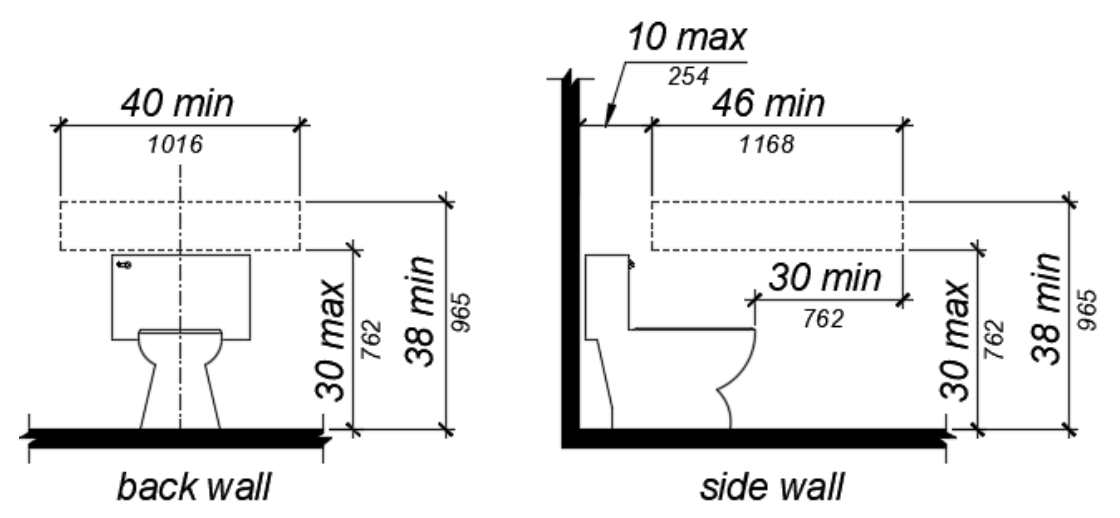
FIGURE 11B-809.10.7.3 REINFORCEMENT FOR GRAB BARS.
Water closet seats shall be 15 inches (381 mm) minimum and 19 inches (483 mm) maximum measured to the top of the seat above the finish floor.
Controls shall be mounted 44 inches (1118 mm) maximum above the finish floor. The force required to activate controls shall be 5 pounds (22.2 mm) maximum.
11B-809.10.8 Lavatories, vanities, mirrors and towel bars.
Bathing rooms or powder rooms required to comply with Section 11B-809.10 shall provide lavatories complying with this section. Where mirrors or towel bars are provided, no less than one of each shall comply with this section.
Lavatories without base cabinets shall be installed with the centerline 18 inches (457 mm) minimum from an adjoining wall or fixture to allow for forward approach. Lavatories with base cabinets shall be installed with the centerline 24 inches (610 mm) minimum from an adjoining wall or fixture to allow for a parallel approach. The top of the lavatory rim shall be 34 inches (864 mm) maximum above the finished floor.
A floor space 30 inches (762 mm) minimum by 48 inches (1219 mm) minimum shall be provided centered on the lavatory.
Cabinets shall be removable without the use of specialized knowledge and/or tools. The finished floor shall extend to the wall under the lavatory.
11B-809.10.8.4 Knee and toe clearance.
Knee and toe clearance shall be provided and comply with Section 11B-306.
11B-809.10.8.5 Plumbing protection.
Plumbing protection shall comply with Section 11B-809.9.7.
Faucet controls and operating mechanisms shall comply with Section 11B-309.4.
11B-809.10.8.7 Mirrors and towel bars.
Where mirrors are provided the bottom edge of the reflective surface shall be 40 inches (1016 mm) maximum above the finish floor. Where towel bars are provided they shall be installed 40 inches (1016 mm) maximum above the finish floor to the top of the bar.
11B-809.11 Washing machines and clothes dryers.
Where washing machines and clothes dryers are provided in residential dwelling units with adaptable features, one of each type shall be provided.
11B-809.12 Electrical receptacles, controls and switches.
Electrical receptacles on branch circuits of 30 amperes or less, communication system receptacles, controls and switches shall be located as follows:
-
Where there is no obstruction, 48 inches (1219 mm) maximum measured from the top of the receptacle box and 15 inches (381 mm) minimum measured from the bottom of the receptacle box to the finish floor.
-
Where the reach is over an obstruction, electrical receptacles, controls and switches shall comply with Sections 11B-309.2 and 11B-308.3.
-
When the reach is over a kitchen work surface and base cabinet, the work surface shall be 36 inches (914 mm) maximum above the finish floor and 25 1/2 inches (650 mm) maximum in depth. The base cabinet shall be 24 inches (610 mm) maximum in depth.
-
Where receptacles are provided in a kitchen at a corner work surface, one receptacle shall be located 36 inches (915 mm) from either wall at the inside corner.
Exceptions:
a. Electrical receptacles installed as part of permanently installed baseboard heaters.
b. Electrical receptacles in floors adjacent to sliding panels or walls.
c. Baseboard electrical receptacles in relocatable partitions, window walls or other electrical convenience floor outlets.
d. Appliances (e.g., stoves, dishwashers, range hoods, microwave ovens and similar appliances) which have controls located on the appliance.
e. Electrical receptacles dedicated to specific appliances.
f. Circuit breakers.
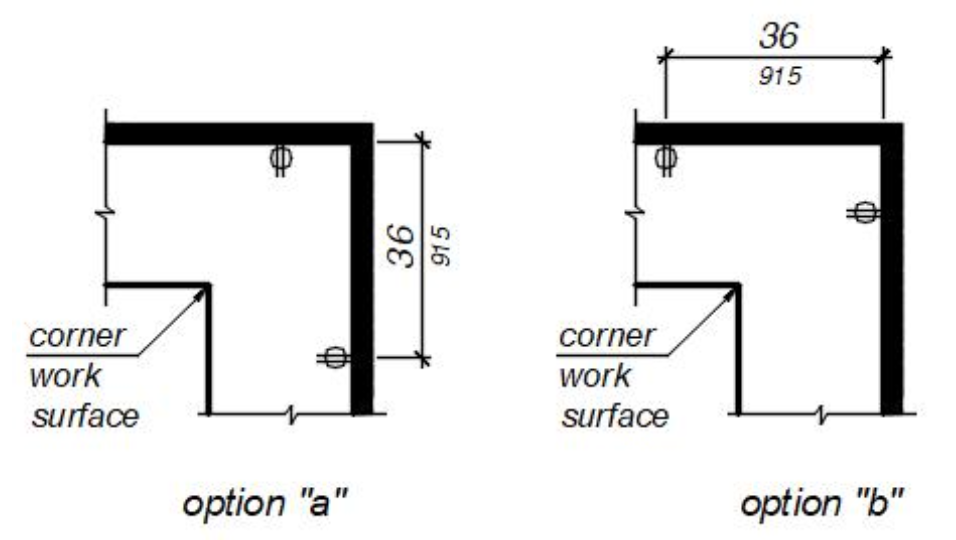
FIGURE 11B-809.12
ELECTRICAL RECEPTACLES AT CORNER WORKSURFACES
11B-810.1 General.
Transportation facilities shall comply with Section 11B-810.
11B-810.1.1 Vehicle boarding.
Stations shall not be designed or constructed so as to require persons with disabilities to board or alight from a vehicle at a location other than one used by the general public.
11B-810.1.2 Baggage systems.
Baggage check-in and retrieval systems shall be on an accessible route complying with Section 11B-402 and shall have space immediately adjacent complying with Section 11B-302.
11B-810.2 Bus boarding and alighting areas.
Bus boarding and alighting areas shall comply with Section 11B-810.2.

11B-810.2.1 Surface.
Bus stop boarding and alighting areas shall have a firm, stable surface.
11B-810.2.2 Dimensions.
Bus stop boarding and alighting areas shall provide a clear length of 96 inches (2438 mm) minimum, measured perpendicular to the curb or vehicle roadway edge, and a clear width of 60 inches (1524 mm) minimum, measured parallel to the vehicle roadway.
U.S. Access Board's Note to Reader:
The Department of Transportation's ADA Standards indicate that compliance is required to the extent construction specifications are within a public entity's control:
[ADA Title II - Public Transportation] 810.2.2 Dimensions. Bus boarding and alighting areas shall provide a clear length of 96 inches (2440 mm), measured perpendicular to the curb or vehicle roadway edge, and a clear width of 60 inches (1525 mm), measured parallel to the vehicle roadway. Public entities shall ensure that the construction of bus boarding and alighting areas comply with 810.2.2, to the extent the construction specifications are within their control.
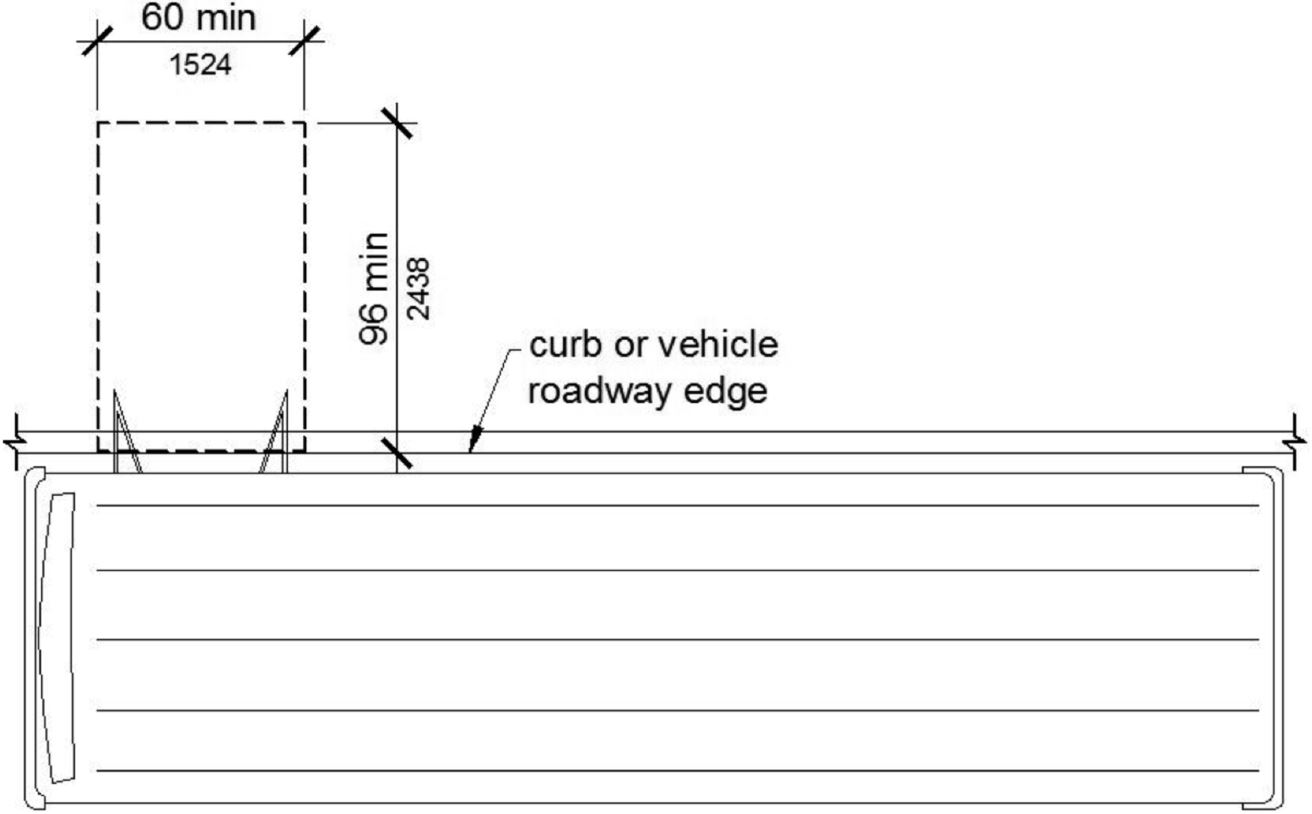
FIGURE 11B-810.2.2 DIMENSIONS OF BUS BOARDING AND ALIGHTING AREAS
11B-810.2.3 Connection.
Bus stop boarding and alighting areas shall be connected to streets, sidewalks, or pedestrian paths by an accessible route complying with Section 11B-402. Newly constructed bus stop boarding and alighting areas shall provide a detectable transition between the boarding/alighting area and the roadway; the detectable transition shall consist of a curb with the face sloped at 35 degrees maximum from vertical or detectable warnings complying with Sections 11B-705.1.1 and 11B-705.1.2.4.
[2010 ADA Standards] 810.2.3 Connection. Bus stop boarding and alighting areas shall be connected to streets, sidewalks, or pedestrian paths by an accessible route complying with 402.
11B-810.2.4 Slope.
Parallel to the roadway, the slope of the bus stop boarding and alighting area shall be the same as the roadway, to the maximum extent practicable. Perpendicular to the roadway, the slope of the bus stop boarding and alighting area shall not be steeper than 1:48.
11B-810.3 Bus shelters.
Bus shelters shall provide a minimum clear floor or ground space complying with Section 11B-305 entirely within the shelter. Bus shelters shall be connected by an accessible route complying with Section 11B-402 to a boarding and alighting area complying with Section 11B-810.2.
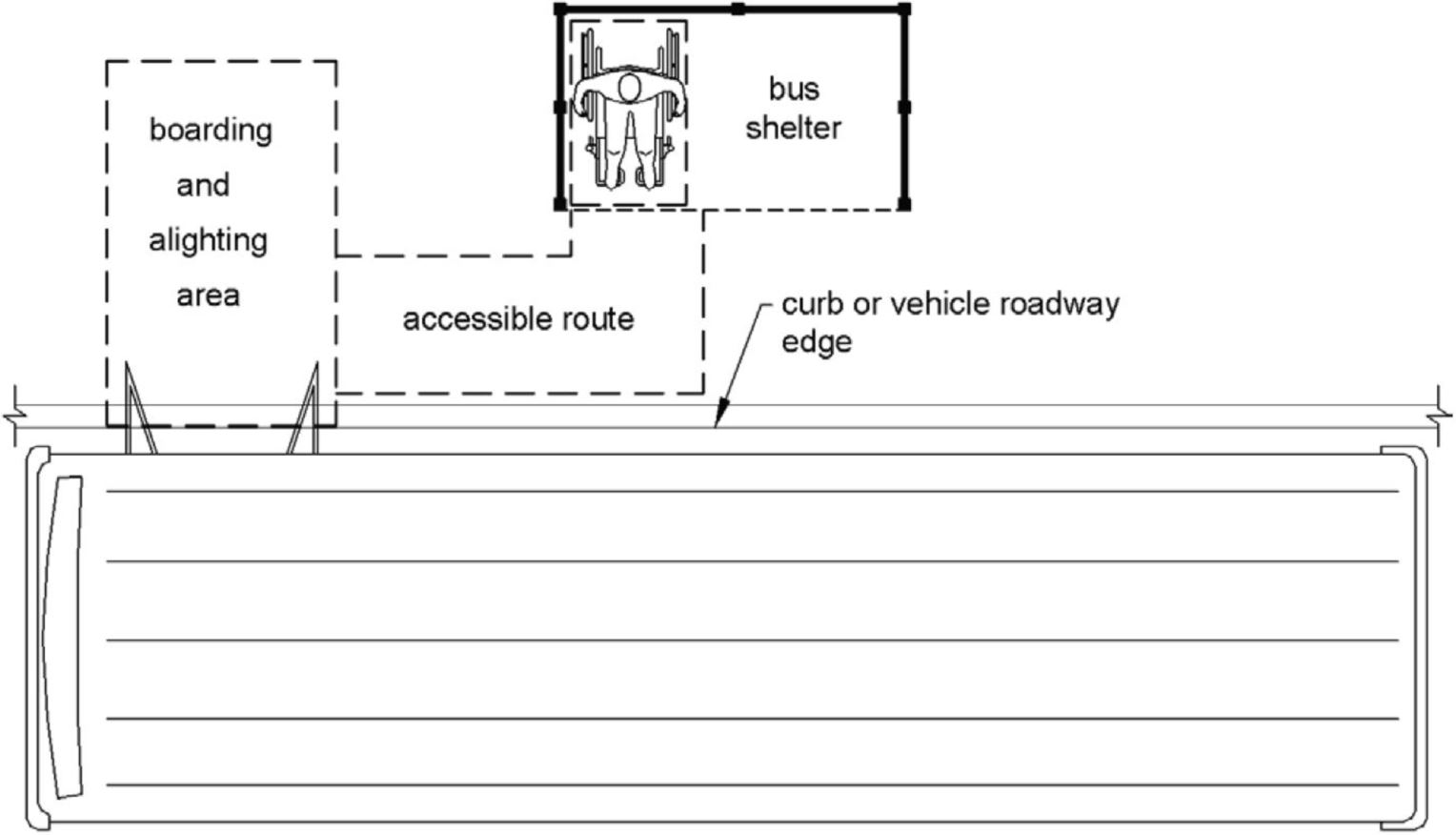
FIGURE 11B-810.3 BUS SHELTERS
11B-810.4 Bus signs.
Bus route identification signs shall comply with Sections 11B-703.5.1 through 11B-703.5.4, and Sections 11B-703.5.7 and 11B-703.5.8. In addition, to the maximum extent practicable, bus route identification signs shall comply with Section 11B-703.5.5.
Exception: Bus schedules, timetables and maps that are posted at the bus stop or bus bay shall not be required to comply.
11B-810.5 Rail Platforms.
Rail platforms shall comply with Section 11B-810.5.
11B-810.5.1 Slope.
Rail platforms shall not exceed a slope of 1:48 in all directions.
Exception: Where platforms serve vehicles operating on existing track or track laid in existing roadway, the slope of the platform parallel to the track shall be permitted to be equal to the slope (grade) of the roadway or existing track.
11B-810.5.2 Detectable warnings.
Platform boarding edges not protected by platform screens or guards shall have detectable warnings complying with Section 11B-705 along the full length of the public use area of the platform.
11B-810.5.3 Platform and vehicle floor coordination.
Station platforms shall be positioned to coordinate with vehicles in accordance with the applicable requirements of 36 CFR Part 1192. Low-level platforms shall be 8 inches (203 mm) minimum above top of rail.
Exception: Where vehicles are boarded from sidewalks or street-level, low-level platforms shall be permitted to be less than 8 inches (203 mm).
U.S. Access Board's Note to Reader:
The Department of Transportation's ADA Standards note permitted alternatives where compliance is not operationally or structurally feasible in light rail, commuter rail, or intercity rail systems:
[ADA Title II - Public Transportation] 810.5.3 Platform and Vehicle Floor Coordination. Station platforms shall be positioned to coordinate with vehicles in accordance with the applicable requirements of 36 CFR part 1192. Low-level platforms shall be 8 inches (205 mm) minimum above top of rail. In light rail, commuter rail, and intercity rail systems where it is not operationally or structurally feasible to meet the horizontal gap or vertical difference requirements of part 1192 or 49 CFR part 38, mini-high platforms, car-borne or platform-mounted lifts, ramps or bridge plates or similarly manually deployed devices, meeting the requirements of 49 CFR part 38, shall suffice.
EXCEPTION: Where vehicles are boarded from sidewalks or street-level, low-level platforms shall be permitted to be less than 8 inches (205 mm).

11B-810.6 Rail station signs.
Rail station signs shall comply with Section 11B-810.6.
Exception: Signs shall not be required to comply with Sections 11B-810.6.1 and 11B-810.6.2 where audible signs are remotely transmitted to hand-held receivers, or are user or proximity-actuated.

11B-810.6.1 Entrances.
Where signs identify a station or its entrance, at least one sign at each entrance shall comply with Section 11B-703.2 and shall be placed in uniform locations to the maximum extent practicable. Where signs identify a station that has no defined entrance, at least one sign shall comply with Section 11B-703.2 and shall be placed in a central location.
11B-810.6.2 Routes and destinations.
Lists of stations, routes and destinations served by the station which are located on boarding areas, platforms, or mezzanines shall comply with Section 11B-703.5. At least one tactile sign identifying the specific station and complying with Section 11B-703.2 shall be provided on each platform or boarding area. Signs covered by this requirement shall, to the maximum extent practicable, be placed in uniform locations within the system.
Exception: Where sign space is limited, characters shall not be required to exceed 3 inches (76 mm).

11B-810.6.3 Station names.
Stations covered by this section shall have identification signs complying with Section 11B-703.5. Signs shall be clearly visible and within the sight lines of standing and sitting passengers from within the vehicle on both sides when not obstructed by another vehicle.

11B-810.7 Public address systems.
Where public address systems convey audible information to the public, the same or equivalent information shall be provided in a visual format.
11B-810.8 Clocks.
Where clocks are provided for use by the public, the clock face shall be uncluttered so that its elements are clearly visible. Hands, numerals and digits shall contrast with the background either light-on-dark or dark-on-light. Where clocks are installed overhead, numerals and digits shall comply with Section 11B-703.5.
11B-810.9 Escalators.
Where provided, escalators shall comply with the sections 6.1.3.5.6 and 6.1.3.6.5 of ASME A17.1 and shall have a clear width of 32 inches (813 mm) minimum.
Exception: Existing escalators in key stations shall not be required to comply with Section 11B-810.9.
11B-810.10 Track crossings.
Where a circulation path serving boarding platforms crosses tracks, it shall comply with Section 11B-402.
Exception: Openings for wheel flanges shall be permitted to be 2½ inches (64 mm) maximum.

FIGURE 11B-810.10 (EXCEPTION) TRACK CROSSINGS
11B-811.1 General.
Storage shall comply with Section 11B-811.
11B-811.2 Clear floor or ground space.
A clear floor or ground space complying with Section 11B-305 shall be provided.
11B-811.3 Height.
Storage elements shall comply with at least one of the reach ranges specified in Section 11B-308.
11B-811.4 Operable parts.
Operable parts shall comply with Section 11B-309.
11B-812 Electric vehicle charging stations
ETA Editor's Note
EVCS are not addressed by 2010 ADA Standards, although a case could be made, based on the general obligation for governments to make their services, programs or activities available to individuals with disabilities [ADA Title II §35.130], and for public accommodations and commercial facilities to make their goods, services, facilities, etc. available [ADA Title III §36.201(a)], that, if EVCS are made available to the public by any of these entities, they must be made available to individuals with disabilities. However, the absence of scoping or technical requirements in the Standards would make it difficult to conclude what that means.
11B-812.1 General.
Electric vehicle charging stations (EVCS) shall comply with Section 11B-812 as required by Section 11B-228.3. Where vehicle spaces and access aisles are marked with lines, measurements shall be made from the centerline of the markings.
Exception: Where vehicle spaces or access aisles are not adjacent to another vehicle space, access aisle, or parking space, measurements shall be permitted to include the full width of the line defining the vehicle space or access aisle.
11B-812.3 Floor or ground surfaces.
Vehicle spaces and access aisles serving them shall comply with Section 11B-302. Access aisles shall be at the same level as the vehicle space they serve. Changes in level, slopes exceeding 1:48, and detectable warnings shall not be permitted.
11B-812.4 Vertical clearance.
Vehicle spaces, access aisles serving them, and vehicular routes serving them shall provide a vertical clearance of 98 inches (2489 mm) minimum. Where provided, overhead cable management systems shall not obstruct required vertical clearance.
11B-812.5.1 Accessible route to building or facility.
EVCS complying with Section 11B-812 that serve a particular building or facility shall be located on an accessible route to an entrance complying with Section 11B-206.4. Where EVCS do not serve a particular building or facility, EVCS complying with Section 11B-812 shall be located on an accessible route to an accessible pedestrian entrance of the EV charging facility.
Exception: EVCS complying with Section 11B-812 shall be permitted to be located in different EV charging facilities if substantially equivalent or greater accessibility is provided in terms of distance from an accessible entrance or entrances, charging fee, and user convenience.
11B-812.5.2 Accessible route to EV charger.
An accessible route complying with Section 11B-402 shall be provided between the vehicle space and the EV charger which serves it.
11B-812.5.3 Relationship to accessible routes.
Vehicle spaces and access aisles shall be designed so that when the vehicle space is occupied the required clear width of adjacent accessible routes is not obstructed. A curb, wheel stop, bollards, or other barrier shall be provided if required to prevent encroachment of vehicles over the required clear width of adjacent accessible routes.
11B-812.5.4 Arrangement.
Vehicle spaces and access aisles shall be designed so that persons using them are not required to travel behind vehicle spaces or parking spaces other than the vehicle space in which their vehicle has been left to charge.
Exceptions:
- Ambulatory EVCS shall not be required to comply with Section 11B-812.5.4.
- Vehicle spaces installed in existing facilities shall comply with Section 11B-812.5.4 to the maximum extent feasible.
11B-812.5.5 Obstructions.
EVCS shall be designed so accessible routes are not obstructed by cables or other elements.
11B-812.6 Vehicle spaces.
Vehicle spaces serving van accessible, standard accessible, ambulatory and drive-up EVCS shall be 216 inches (5486 mm) long minimum and shall comply with Sections 11B-812.6.1 through 11B-812.6.4 as applicable. All vehicle spaces shall be marked to define their width.
Exceptions:
- Where the long dimension of vehicle spaces is parallel to the traffic flow in the adjacent vehicular way, the length of vehicle spaces shall be 240 inches (6096 mm) minimum.
- Vehicle spaces at drive-up EVCS shall be 240 inches (6096 mm) long minimum and shall not be required to be marked to define their width.
11B-812.6.1 Van accessible.
Vehicle spaces serving van accessible EVCS shall be 144 inches (3658 mm) wide minimum and shall have an adjacent access aisle complying with Section 11B-812.7.
11B-812.6.2 Standard accessible.
Vehicle spaces serving standard accessible EVCS shall be 108 inches (2743 mm) wide minimum and shall have an adjacent access aisle complying with Section 11B-812.7.
11B-812.6.3 Ambulatory.
Vehicle spaces serving ambulatory EVCS shall be 120 inches (3048 mm) wide minimum and shall not be required to have an adjacent access aisle.
11B-812.6.4 Drive-up.
Vehicle spaces serving drive-up EVCS shall be 204 inches (5182 mm) wide minimum and shall not be required to have an adjacent access aisle.
11B-812.7 Access aisle.
Access aisles shall adjoin an accessible route. Two vehicle spaces or one parking space and one electric vehicle charging space shall be permitted to share a common access aisle. Access aisles shall be 60 inches (1524 mm) wide minimum and shall extend the full required length of the vehicle spaces they serve.
11B-812.7.1 Location.
Access aisles at vehicle spaces shall not overlap the vehicular way and may be placed on either side of the vehicle space they serve except for van accessible spaces which shall have access aisles located on the passenger side of the vehicle spaces.
Exception: Where four or fewer total EVCS are provided within a facility, the access aisle for non-angled van accessible spaces may be located on either the driver or passenger side of the vehicle space.
11B-812.7.2 Marking.
Access aisles at vehicle spaces shall be marked with a painted borderline around their perimeter. The area within the borderlines shall be marked with hatched lines a maximum of 36 inches (914 mm) on center. The color of the borderlines, hatched lines, and letters shall contrast with that of the surface of the access aisle. The blue color required for identification of access aisles for accessible parking shall not be used. Access aisle markings may extend beyond the minimum required length.
Exception: Where one parking space and one electric vehicle charging space share an access aisle, access aisle marking shall comply with Section 11B-502.3.3 and shall not be required to comply with Section 11B-812.7.2.
11B-812.7.3 Lettering.
The words “NO PARKING” shall be painted on the surface within each access aisle in letters a minimum of 12 inches (305 mm) in height and located to be visible from the adjacent vehicular way.
11B-812.8 Identification signs.
EVCS identification signs shall be provided in compliance with Section 11B-812.8.
11B-812.8.1 Four or fewer.
Where four or fewer total EVCS are provided, identification with an International Symbol of Accessibility (ISA) shall not be required.
11B-812.8.2 Five to twenty-five.
Where five to twenty-five total EVCS are provided, one van accessible EVCS shall be identified by an ISA complying with Section 11B-703.7.2.1. The required standard accessible EVCS shall not be required to be identified with an ISA.
11B-812.8.3 Twenty-six or more.
Where twenty-six or more total EVCS are provided, all required van accessible and all required standard accessible EVCS shall be identified by an ISA complying with Section 11B-703.7.2.1.
11B-812.8.4 Ambulatory.
Ambulatory EVCS shall not be required to be identified by an ISA.
11B-812.8.5 Drive-up.
Drive-up EVCS shall not be required to be identified by an ISA.
11B-812.8.6 Finish and size.
Identification signs shall be reflectorized with a minimum area of 70 square inches (45161 mm2).
11B-812.8.7 Location.
Required identification signs shall be visible from the EVCS it serves. Signs shall be permanently posted either immediately adjacent to the vehicle space or within the projected vehicle space width at the head end of the vehicle space. Signs identifying van accessible vehicle spaces shall contain the designation “van accessible.” Signs shall be 60 inches (1525 mm) minimum above the finish floor or ground surface measured to the bottom of the sign. Signs located within a circulation path shall be 80 inches (2032 mm) minimum above the finish floor or ground surface measured to the bottom of the sign. Signs may also be permanently posted on a wall at the interior end of the vehicle space.
11B-812.9 Surface marking.
EVCS vehicle spaces shall provide surface marking stating “EV CHARGING ONLY” in letters 12 inches (305 mm) high minimum. The centerline of the text shall be a maximum of 6 inches (152 mm) from the centerline of the vehicle space and its lower corner at, or lower side aligned with, the end of the vehicle space length.
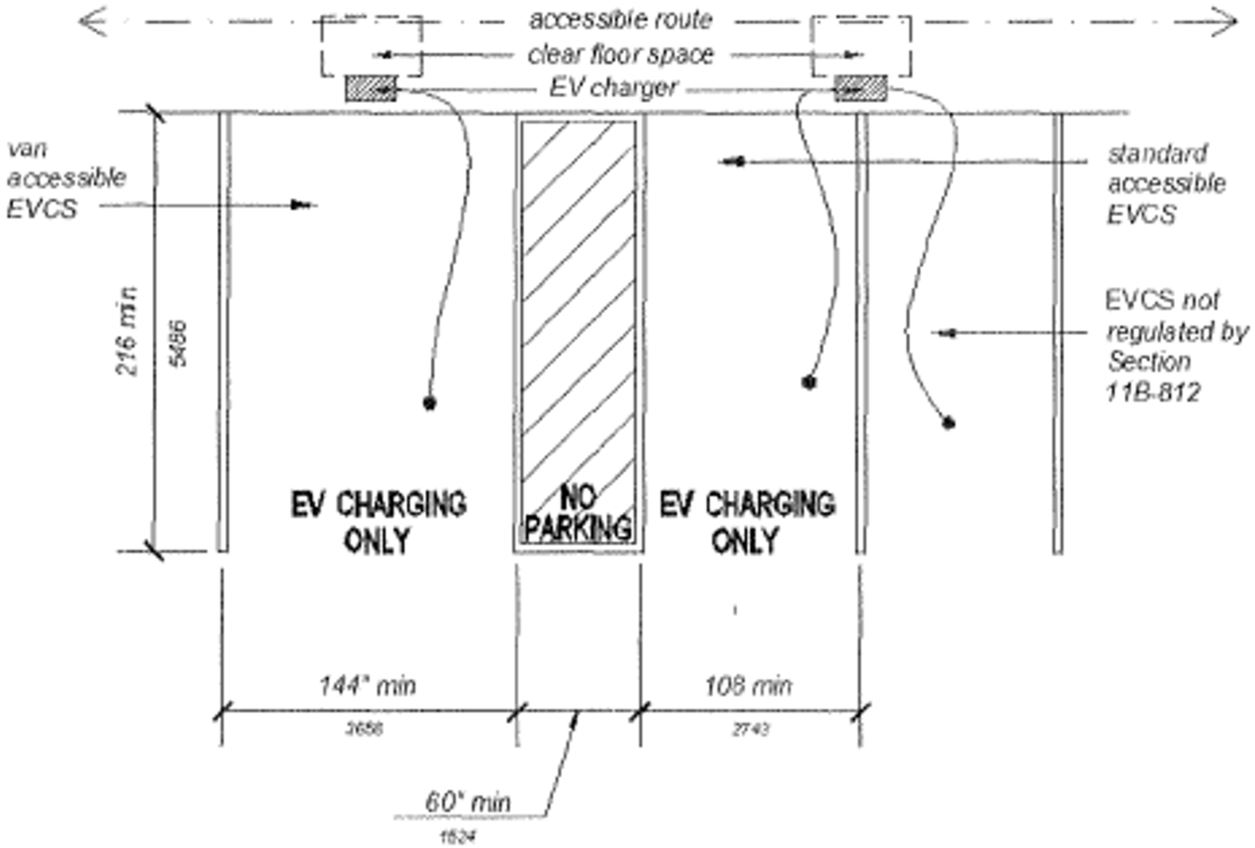
FIGURE 11B-812.9 SURFACE MARKING
11B-812.10.2 Operable parts.
Operable parts and charging cord storage shall comply with Section 11B-309.
11B-812.10.3 Point-of-sale devices.
Where provided, point-of-sale devices shall comply with Sections 11B-707.2, 11B-707.3, 11B-707.7.2, and 11B-707.9.
11B-812.10.4 Location.
EV chargers shall be adjacent to, and within the projected width of, the vehicle space being served.
Exceptions:
- EV chargers serving more than one EVCS shall be adjacent to, and within the combined projected width of, the vehicle spaces being served.
- For alterations at existing facilities where an accessible route or general circulation path is not provided adjacent to the head end of the vehicle space or access aisle, the EV charger may be located within the projected width of the access aisle 36 inches (914 mm) maximum from the head end of the space.
- Where the long dimension of a vehicle space is parallel to the vehicular way, the EV charger shall be adjacent to, and 48 inches (1219 mm) maximum from the head end or foot end of the vehicle space or access aisle being served.
11B-813 Adult changing facilities.
Adult changing facilities shall comply with Section 11B-813.
ETA Editor's Note
Adult changing facilities are not addressed by 2010 ADA Standards, although a case could be made, based on the general obligation for governments to make their services, programs or activities available to individuals with disabilities [ADA Title II §35.130], and for public accommodations and commercial facilities to make their goods, services, facilities, etc. available [ADA Title III §36.201(a)], that, if adult changing facilities are made available to the public by any of these entities, they must be made available to individuals with disabilities. However, the absence of scoping or technical requirements in the Standards would make it difficult to conclude what that means.
11B-813.1 Location.
Adult changing facilities shall be provided within a unisex (single-user or family) toilet room or other similar private room.
11B-813.2 Features.
Adult changing facilities shall provide features in compliance with Section 11B-813.2.
11B-813.2.1 Adult changing table.
Adult changing tables shall be fixed to the floor or a wall and shall comply with Section 11B-813.2.1.
Adult changing tables shall have a changing surface of 70 inches (1778 mm) minimum length and 30 inches (762 mm) minimum width.
A 36 inches minimum (914 mm) width side clearance shall be provided along the entire length of one side of adult changing tables. At both ends of adult changing tables, clearance shall be provided measuring 36 inches (914 mm) minimum wide and a minimum length as long as the table width plus the width of the side clearance. End and side clearances shall be measured from the outermost extent of the table. Floor or ground surfaces of clearances shall comply with Section 11B-302. Changes in level are not permitted.
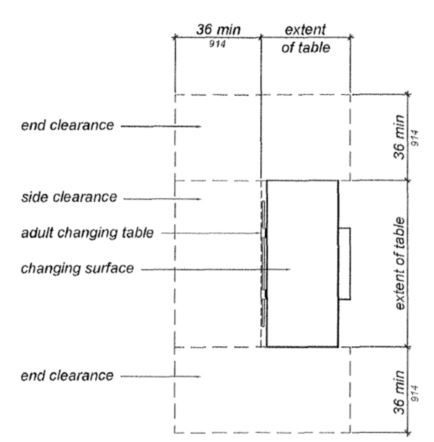
FIGURE 11B-813.2.1.2 CLEARANCE AROUND ADULT CHANGING TABLE
11B-813.2.1.3 Height and operation.
Adult changing table height shall be adjustable from 17 inches (432 mm) above the floor or ground to 38 inches (965 mm) above the floor or ground, as measured to the top of the changing surface. Height adjustability shall be powered. Operable parts shall comply with Section 11B-309.
Adult changing tables shall provide a minimum weight capacity of 300 pounds (136 kg).
When deployed, changing tables shall not obstruct the required width of an accessible route except as allowed by Section 11B-307.2.
11B-813.2.2 Water closet.
No fewer than one water closet in compliance with Section 11B-604.
11B-813.2.3 Lavatory.
One lavatory in compliance with Section 11B-606.
11B-813.2.4 Waste receptacle.
No fewer than one waste receptacle in compliance with Section 11B-603.5.
11B-813.2.5 Coat hook.
No fewer than one coat hook shall be provided in close proximity to the changing table and within one of the reach ranges specified in Section 11B-308.
11B-813.2.6 Shelf.
No fewer than one shelf shall be provided in close proximity to the changing table at 40 inches (1016 mm) minimum and 48 inches (1219 mm) maximum above the finish floor.
11B-813.2.7 Accessories.
Where provided, no fewer than one of each accessory shall comply with Section 11B-603.5.
11B-813.2.8 Turning space.
Turning space complying with Section 11B-304 shall be provided within adult changing facilities.
11B-813.2.9 Overlap.
Required clear floor spaces, clearance at fixtures, and turning space shall be permitted to overlap.
11B-813.2.10 Door swing.
A door, in any position, shall be permitted to encroach into the turning space by 12 inches (305 mm) maximum. Where a clear floor space complying with Section 11B-305.3 is provided within the room beyond the arc of the door swing, doors shall be permitted to swing into the clear floor space, clearance required for any fixture, and clearance required for adult changing tables.
11B-813.2.11 Privacy latch.
Each door to adult changing facilities shall have a privacy latch.
11B-813.2.12 Signs.
A room identification sign complying with Section 11B-216 shall be provided at entrances to adult changing facilities. The text of the room identification sign shall be “ADULT CHANGING FACILITY”.
An informational sign complying with Section 11B-216 shall be provided within adult changing facilities and in close proximity to the changing table. The informational sign shall indicate the maximum weight capacity of the adult changing table, as determined by the table manufacturer.
Where the commercial place of public amusement has a central directory, the central directory shall indicate the location of adult changing facilities. Where other directories indicate the location of toilet facilities, the other directories shall also indicate the location of adult changing facilities.
11B-901.1 Scope.
The provisions of Division 9 shall apply where required by Division 2 or where referenced by a requirement in this chapter.
11B-902.1 General.
Dining surfaces and work surfaces shall comply with Sections 11B-902.2 and 11B-902.3.
Exception: Dining surfaces and work surfaces for children’s use shall be permitted to comply with Section 11B-902.4.

11B-902.2 Clear floor or ground space.
A clear floor space complying with Section 11B-305 positioned for a forward approach shall be provided. Knee and toe clearance complying with Section 11B-306 shall be provided.
11B-902.3 Height.
The tops of dining surfaces and work surfaces shall be 28 inches (711 mm) minimum and 34 inches (864 mm) maximum above the finish floor or ground.
11B-902.4 Dining surfaces and work surfaces for children’s use.
Accessible dining surfaces and work surfaces for children’s use shall comply with Section 11B-902.4.
Exception: Dining surfaces and work surfaces that are used primarily by children 5 years and younger shall not be required to comply with Section 11B-902.4 where a clear floor or ground space complying with Section 11B-305 positioned for a parallel approach is provided.
11B-902.4.1 Clear floor or ground space.
A clear floor space complying with Section 11B-305 positioned for forward approach shall be provided. Knee and toe clearance complying with Section 11B-306 shall be provided, except that knee clearance 24 inches (610 mm) minimum above the finish floor or ground shall be permitted.
11B-902.4.2 Height.
The tops of tables and counters shall be 26 inches (660 mm) minimum and 30 inches (762 mm) maximum above the finish floor or ground.
11B-903.1 General.
Benches shall comply with Section 11B-903.

11B-903.2 Clear floor or ground space.
Clear floor or ground space complying with Section 11B-305 shall be provided and shall be positioned at the end of the bench seat and parallel to the short axis of the bench.
11B-903.3 Size.
Benches shall have seats that are 48 inches (1219 mm) long minimum and 20 inches (508 mm) deep minimum and 24 inches (610 mm) deep maximum.
[2010 ADA Standards] 903.3 Size. Benches shall have seats that are 42 inches (1065 mm) long minimum and 20 inches (510 mm) deep minimum and 24 inches (610 mm) deep maximum.
11B-903.4 Back support.
The bench shall provide for back support or shall be affixed to a wall along its long dimension. Back support shall be 48 inches (1219 mm) long minimum and shall extend from a point 2 inches (51 mm) maximum above the seat surface to a point 18 inches (457 mm) minimum above the seat surface. Back support shall be 2½ inches (64 mm) maximum from the rear edge of the seat measured horizontally.
[2010 ADA Standards] 903.4 Back Support. The bench shall provide for back support or shall be affixed to a wall. Back support shall be 42 inches (1065 mm) long minimum and shall extend from a point 2 inches (51 mm) maximum above the seat surface to a point 18 inches (455 mm) minimum above the seat surface. Back support shall be 2 1/2 inches maximum from the rear edge of the seat measured horizontally.

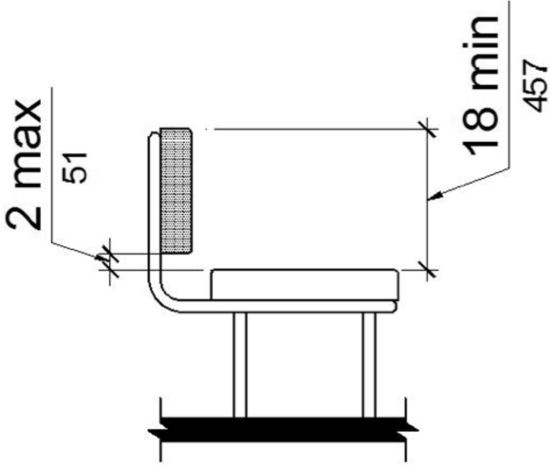
(a)
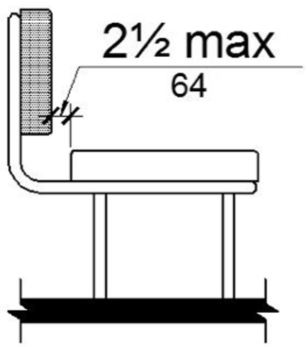
(b)
FIGURE 11B-903.4 BENCH BACK SUPPORT
11B-903.5 Height.
The top of the bench seat surface shall be 17 inches (432 mm) minimum and 19 inches (483 mm) maximum above the finish floor or ground.
11B-903.6 Structural strength.
Benches shall be affixed to the wall or floor. Allowable stresses shall not be exceeded for materials used when a vertical or horizontal force of 250 pounds (1112 N) is applied at any point on the seat, fastener, mounting device, or supporting structure.
[2010 ADA Standards] 903.6 Structural Strength. Allowable stresses shall not be exceeded for materials used when a vertical or horizontal force of 250 pounds (1112 N) is applied at any point on the seat, fastener, mounting device, or supporting structure.
11B-903.7 Wet locations.
Where installed in wet locations, the surface of the seat shall be slip resistant and shall not accumulate water.
11B-904.1 General.
Check-out aisles and sales and service counters shall comply with the applicable requirements of Section 11B-904.
11B-904.2 Approach.
All portions of counters required to comply with Section 11B-904 shall be located adjacent to a walking surface complying with Section 11B-403.

11B-904.3.2 Counter.
The counter surface height shall be 38 inches (965 mm) maximum above the finish floor or ground. The top of the counter edge protection shall be 2 inches (51 mm) maximum above the top of the counter surface on the aisle side of the check-out counter.
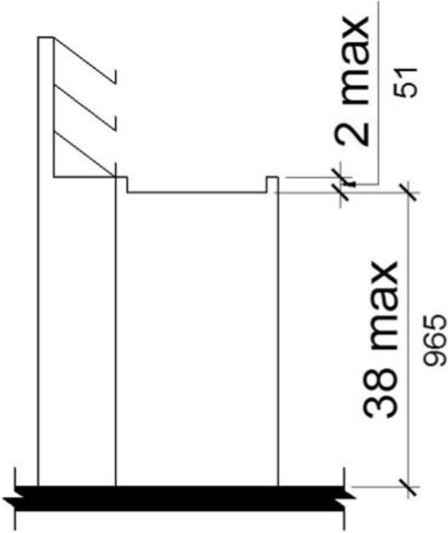
FIGURE 11B-904.3.2 CHECK-OUT AISLE COUNTERS
11B-904.3.3 Check writing surfaces.
Where provided, check writing surfaces shall comply with Section 11B-902.3.
11B-904.3.4 Identification sign.
When not all check-out aisles are accessible, accessible check-out aisles shall be identified by a sign clearly visible to a person in a wheelchair displaying the International Symbol of Accessibility complying with Section 11B-703.7.2.1. The sign shall be a minimum of 4 inches by 4 inches (102 mm by 102 mm).
11B-904.4 Sales and service counters.
Sales counters and service counters shall comply with Section 11B-904.4.1 or 11B-904.4.2. The accessible portion of the counter top shall extend the same depth as the sales or service counter top.
Exception: In alterations, when the provision of a counter complying with Section 11B-904.4 would result in a reduction of the number of existing counters at work stations or a reduction of the number of existing mail boxes, the counter shall be permitted to have a portion which is 24 inches (610 mm) long minimum complying with Section 11B-904.4.1 provided that the required clear floor or ground space is centered on the accessible length of the counter.
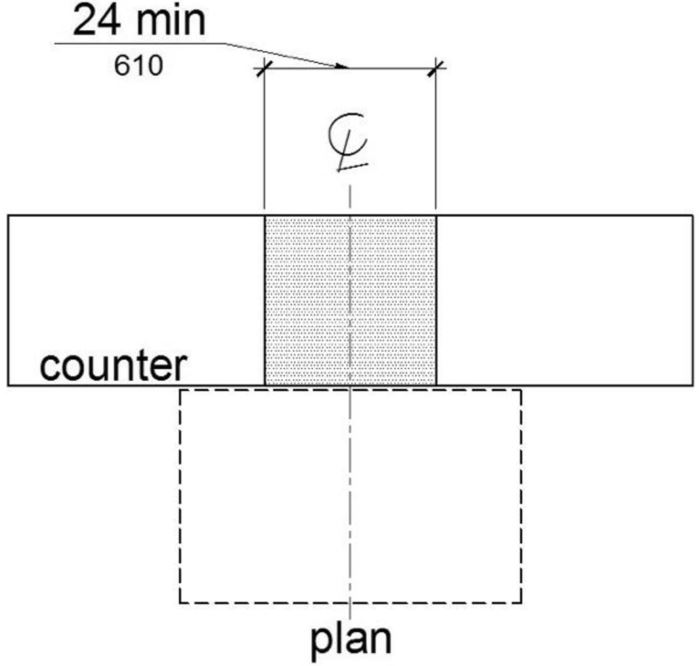
FIGURE 11B-904.4 (EXCEPTION) ALTERATION OF SALES AND SERVICE COUNTERS
11B-904.4.1 Parallel approach.
A portion of the counter surface that is 36 inches (914 mm) long minimum and 34 inches (864 mm) high maximum above the finish floor shall be provided. A clear floor or ground space complying with Section 11B-305 shall be positioned for a parallel approach adjacent to the 36 inch (914 mm) minimum length of counter.
[2010 ADA Standards] 904.4.1 Parallel Approach. A portion of the counter surface that is 36 inches (915 mm) long minimum and 36 inches (915 mm) high maximum above the finish floor shall be provided. A clear floor or ground space complying with 305 shall be positioned for a parallel approach adjacent to the 36 inch (915 mm) minimum length of counter.
Exception: Where the provided counter surface is less than 36 inches (914 mm) long, the entire counter surface shall be 34 inches (864 mm) high maximum above the finish floor.
[2010 ADA Standards] EXCEPTION: Where the provided counter surface is less than 36 inches (915 mm) long, the entire counter surface shall be 36 inches (915 mm) high maximum above the finish floor.
11B-904.4.2 Forward approach.
A portion of the counter surface that is 36 inches (914 mm) long minimum and 34 inches (864 mm) high maximum shall be provided. Knee and toe space complying with Section 11B-306 shall be provided under the counter. A clear floor or ground space complying with Section 11B-305 shall be positioned for a forward approach to the counter.
[2010 ADA Standards] 904.4.2 Forward Approach. A portion of the counter surface that is 30 inches (760 mm) long minimum and 36 inches (915 mm) high maximum shall be provided. Knee and toe space complying with 306 shall be provided under the counter. A clear floor or ground space complying with 305 shall be positioned for a forward approach to the counter.
11B-904.5 Food service lines.
Counters in food service lines shall comply with Section 11B-904.5.
11B-904.5.1 Self-service shelves and dispensing devices.
Self-service shelves and dispensing devices for tableware, dishware, condiments, food and beverages shall comply with Section 11B-308.
11B-904.5.2 Tray slides.
The tops of tray slides shall be 28 inches (711 mm) minimum and 34 inches (864 mm) maximum above the finish floor or ground.
Where counters or teller windows have security glazing to separate personnel from the public, a method to facilitate voice communication shall be provided. Telephone handset devices, if provided, shall comply with Section 11B-704.3.

11B-1001.1 Scope.
The provisions of Division 10 shall apply where required by Division 2 or where referenced by a requirement in this chapter.

11B-1002.1 General.
Amusement rides shall comply with Section 11B-1002.
11B-1002.2 Accessible routes.
Accessible routes serving amusement rides shall comply with Division 4.
Exceptions:
-
In load or unload areas and on amusement rides, where compliance with Section 11B-405.2 is not structurally or operationally feasible, ramp slope shall be permitted to be 1:8 maximum.

-
In load or unload areas and on amusement rides, handrails provided along walking surfaces complying with Section 11B-403 and required on ramps complying with Section 11B-405 shall not be required to comply with Section 11B-505 where compliance is not structurally or operationally feasible.
11B-1002.3 Load and unload areas.
A turning space complying with Sections 11B-304.2 and 11B-304.3 shall be provided in load and unload areas.
11B-1002.4 Wheelchair spaces in amusement rides.
Wheelchair spaces in amusement rides shall comply with Section 11B-1002.4.
11B-1002.4.1 Floor or ground surface.
The floor or ground surface of wheelchair spaces shall be stable and firm.
11B-1002.4.2 Slope.
The floor or ground surface of wheelchair spaces shall have a slope not steeper than 1:48 when in the load and unload position.
11B-1002.4.3 Gaps.
Floors of amusement rides with wheelchair spaces and floors of load and unload areas shall be coordinated so that, when amusement rides are at rest in the load and unload position, the vertical difference between the floors shall be within plus or minus 5/8 inches (15.9 mm) and the horizontal gap shall be 3 inches (76 mm) maximum under normal passenger load conditions.
Exception: Where compliance is not operationally or structurally feasible, ramps, bridge plates, or similar devices complying with the applicable requirements of 36 CFR 1192.83(c) shall be provided.

11B-1002.4.4 Clearances.
Clearances for wheelchair spaces shall comply with Section 11B-1002.4.4.
Exceptions:
- Where provided, securement devices shall be permitted to overlap required clearances.
- Wheelchair spaces shall be permitted to be mechanically or manually repositioned.
- Wheelchair spaces shall not be required to comply with Section 11B-307.4.

11B-1002.4.4.1 Width and length.
Wheelchair spaces shall provide a clear width of 30 inches (762 mm) minimum and a clear length of 48 inches (1219 mm) minimum measured to 9 inches (229 mm) minimum above the floor surface.
Where wheelchair spaces are entered only from the side, amusement rides shall be designed to permit sufficient maneuvering clearance for individuals using a wheelchair or mobility aid to enter and exit the ride.

11B-1002.4.4.3 Permitted protrusions in wheelchair spaces.
Objects are permitted to protrude a distance of 6 inches (152 mm) maximum along the front of the wheelchair space, where located 9 inches (229 mm) minimum and 27 inches (686 mm) maximum above the floor or ground surface of the wheelchair space. Objects are permitted to protrude a distance of 25 inches (635 mm) maximum along the front of the wheelchair space, where located more than 27 inches (686 mm) above the floor or ground surface of the wheelchair space.
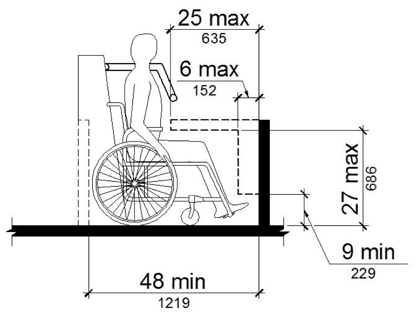
FIGURE 11B-1002.4.4.3 PROTRUSIONS IN WHEELCHAIR SPACES IN AMUSEMENT RIDES
11B-1002.4.5 Ride entry.
Openings providing entry to wheelchair spaces on amusement rides shall be 32 inches (813 mm) minimum clear.
11B-1002.4.6 Approach.
One side of the wheelchair space shall adjoin an accessible route when in the load and unload position.
11B-1002.4.7 Companion seats.
Where the interior width of the amusement ride is greater than 53 inches (1346 mm), seating is provided for more than one rider, and the wheelchair is not required to be centered within the amusement ride, a companion seat shall be provided for each wheelchair space.
11B-1002.4.7.1 Shoulder-to-shoulder seating.
Where an amusement ride provides shoulder-to-shoulder seating, companion seats shall be shoulder-to-shoulder with the adjacent wheelchair space.
Exception: Where shoulder-to-shoulder companion seating is not operationally or structurally feasible, compliance with this requirement shall be required to the maximum extent practicable.
11B-1002.5 Amusement ride seats designed for transfer.
Amusement ride seats designed for transfer shall comply with Section 11B-1002.5 when positioned for loading and unloading.

11B-1002.5.1 Clear floor or ground space.
A clear floor or ground space complying with Section 11B-305 shall be provided in the load and unload area adjacent to the amusement ride seats designed for transfer.
11B-1002.5.2 Transfer height.
The height of amusement ride seats designed for transfer shall be 14 inches (356 mm) minimum and 24 inches (610 mm) maximum measured from the surface of the load and unload area.
11B-1002.5.3 Transfer entry.
Where openings are provided for transfer to amusement ride seats, the openings shall provide clearance for transfer from a wheelchair or mobility aid to the amusement ride seat.
11B-1002.5.4 Wheelchair storage space.
Wheelchair storage spaces complying with Section 11B-305 shall be provided in or adjacent to unload areas for each required amusement ride seat designed for transfer and shall not overlap any required means of egress or accessible route.
11B-1002.6 Transfer devices for use with amusement rides.
Transfer devices for use with amusement rides shall comply with Section 11B-1002.6 when positioned for loading and unloading.

Designs that limit the number of transfers required from a wheelchair or mobility device to the ride seat are encouraged. When using a transfer device to access an amusement ride, the least number of transfers and the shortest distance is most usable. Where possible, designers are encouraged to locate the transfer device seat no higher than 17 to 19 inches (430 to 485 mm) above the load and unload surface. Where greater distances are required for transfers, providing gripping surfaces, seat padding, and avoiding sharp objects in the path of transfer will facilitate the transfer. Where a series of transfers are required to reach the amusement ride seat, each vertical transfer should not exceed 8 inches (205 mm). ◼
11B-1002.6.1 Clear floor or ground space.
A clear floor or ground space complying with Section 11B-305 shall be provided in the load and unload area adjacent to the transfer device.
11B-1002.6.2 Transfer height.
The height of transfer device seats shall be 14 inches (356 mm) minimum and 24 inches (610 mm) maximum measured from the load and unload surface.
11B-1002.6.3 Wheelchair storage space.
Wheelchair storage spaces complying with Section 11B-305 shall be provided in or adjacent to unload areas for each required transfer device and shall not overlap any required means of egress or accessible route.
11B-1003.1 General.
Recreational boating facilities shall comply with Section 11B-1003.
11B-1003.2 Accessible routes.
Accessible routes serving recreational boating facilities, including gangways and floating piers, shall comply with Division 4 except as modified by the exceptions in Section 11B-1003.2.
11B-1003.2.1 Boat slips.
Accessible routes serving boat slips shall be permitted to use the exceptions in Section 11B-1003.2.1.
Exceptions:
-
Where an existing gangway or series of gangways is replaced or altered, an increase in the length of the gangway shall not be required to comply with Section 11B-1003.2 unless required by Section 11B-202.4.
-
Gangways shall not be required to comply with the maximum rise specified in Section 11B-405.6.
-
Where the total length of a gangway or series of gangways serving as part of a required accessible route is 80 feet (24384 mm) minimum, gangways shall not be required to comply with Section 11B-405.2.

-
Where facilities contain fewer than 25 boat slips and the total length of the gangway or series of gangways serving as part of a required accessible route is 30 feet (9144 mm) minimum, gangways shall not be required to comply with Section 11B-405.2.
-
Where gangways connect to transition plates, landings specified by Section 11B-405.7 shall not be required.
-
Where gangways and transition plates connect and are required to have handrails, handrail extensions shall not be required. Where handrail extensions are provided on gangways or transition plates, the handrail extensions shall not be required to be parallel with the ground or floor surface.
-
The cross slope specified in Sections 11B-403.3 and 11B-405.3 for gangways, transition plates, and floating piers that are part of accessible routes shall be measured in the static position.
-
Changes in level complying with Sections 11B-303.3 and 11B-303.4 shall be permitted on the surfaces of gangways and boat launch ramps.
11B-1003.2.2 Boarding piers at boat launch ramps.
Accessible routes serving boarding piers at boat launch ramps shall be permitted to use the exceptions in Section 11B-1003.2.2.
Exceptions:
- Accessible routes serving floating boarding piers shall be permitted to use Exceptions 1, 2, 5, 6, 7 and 8 in Section 11B-1003.2.1.
- Where the total length of the gangway or series of gangways serving as part of a required accessible route is 30 feet (9144 mm) minimum, gangways shall not be required to comply with Section 11B-405.2.
- Where the accessible route serving a floating boarding pier or skid pier is located within a boat launch ramp, the portion of the accessible route located within the boat launch ramp shall not be required to comply with Section 11B-405.
11B-1003.3 Clearances.
Clearances at boat slips and on boarding piers at boat launch ramps shall comply with Section 11B-1003.3.

11B-1003.3.1 Boat slip clearance.
Boat slips shall provide clear pier space 60 inches (1524 mm) wide minimum and at least as long as the boat slips. Each 10 feet (3048 mm) maximum of linear pier edge serving boat slips shall contain at least one continuous clear opening 60 inches (1524 mm) wide minimum.
Exceptions:
- Clear pier space shall be permitted to be 36 inches (914 mm) wide minimum for a length of 24 inches (610 mm) maximum, provided that multiple 36 inch (914 mm) wide segments are separated by segments that are 60 inches (1524 mm) wide minimum and 60 inches (1524 mm) long minimum.
- Edge protection shall be permitted at the continuous clear openings, provided that it is 4 inches (102 mm) high maximum and 2 inches (51 mm) wide maximum.
- In existing piers, clear pier space shall be permitted to be located perpendicular to the boat slip and shall extend the width of the boat slip, where the facility has at least one boat slip complying with Section 11B-1003.3, and further compliance with Section 11B-1003.3 would result in a reduction in the number of boat slips available or result in a reduction of the widths of existing slips.

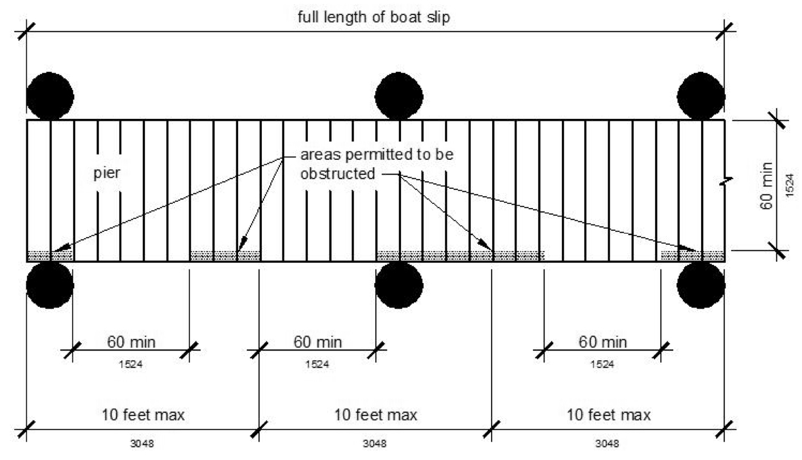
FIGURE 11B-1003.3.1 BOAT SLIP CLEARANCE
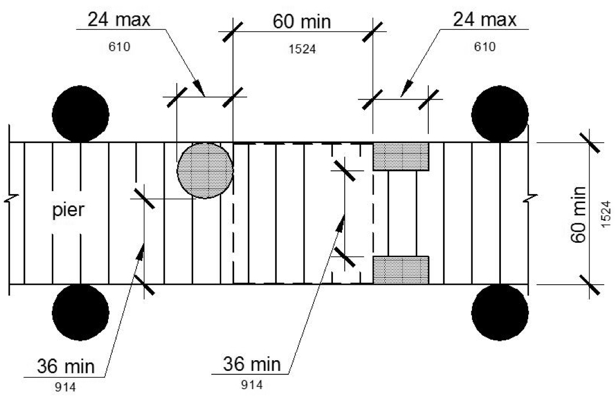
FIGURE 11B-1003.3.1 (EXCEPTION 1) CLEAR PIER SPACE REDUCTION AT BOAT SLIPS
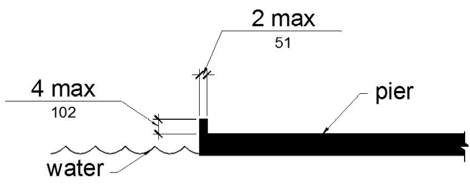
FIGURE 11B-1003.3.1 (EXCEPTION 2) EDGE PROTECTION AT BOAT SLIPS
11B-1003.3.2 Boarding pier clearances.
Boarding piers at boat launch ramps shall provide clear pier space 60 inches (1524 mm) wide minimum and shall extend the full length of the boarding pier. Every 10 feet (3048 mm) maximum of linear pier edge shall contain at least one continuous clear opening 60 inches (1524 mm) wide minimum.
Exceptions:
- The clear pier space shall be permitted to be 36 inches (914 mm) wide minimum for a length of 24 inches (610 mm) maximum provided that multiple 36 inch (914 mm) wide segments are separated by segments that are 60 inches (1524 mm) wide minimum and 60 inches (1524 mm) long minimum.
- Edge protection shall be permitted at the continuous clear openings provided that it is 4 inches (102 mm) high maximum and 2 inches (51 mm) wide maximum.

The following example applies to a boat launch ramp boarding pier: A chain of floats is provided on a launch ramp to be used as a boarding pier which is required to be accessible by Section 11B-1003.3.2. At high water, the entire chain is floating and a transition plate connects the first float to the surface of the launch ramp. As the water level decreases, segments of the chain end up resting on the launch ramp surface, matching the slope of the launch ramp. ◼
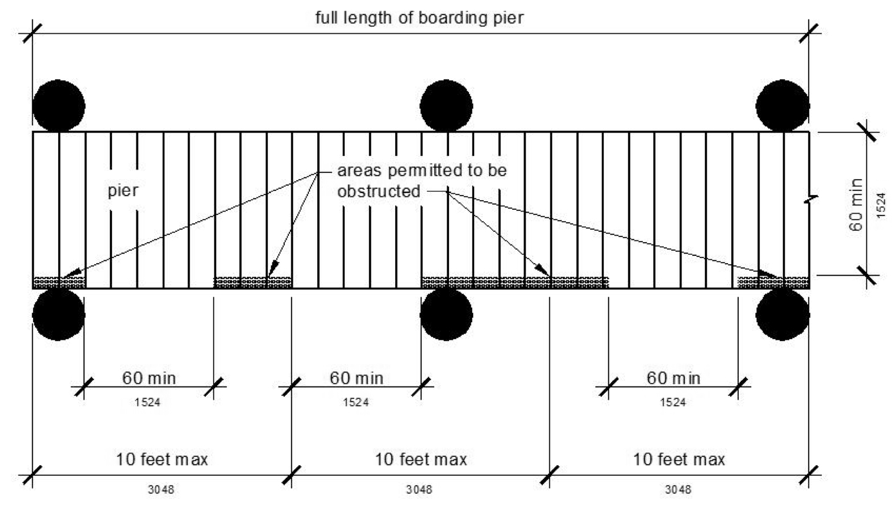
FIGURE 11B-1003.3.2 BOARDING PIER CLEARANCE
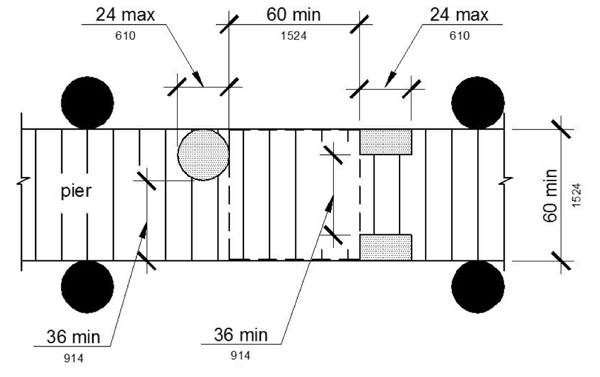
FIGURE 11B-1003.3.2 (EXCEPTION 1) CLEAR PIER SPACE REDUCTION AT BOARDING PIERS
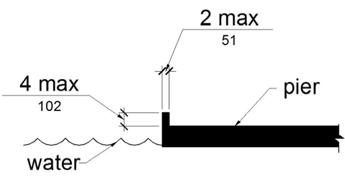
FIGURE 11B-1003.3.2 (EXCEPTION 2) EDGE PROTECTION AT BOARDING PIERS
11B-1004.1 Clear floor space.
Exercise machines and equipment shall have a clear floor space complying with Section 11B-305 positioned for transfer or for use by an individual seated in a wheelchair. Clear floor or ground spaces required at exercise machines and equipment shall be permitted to overlap.

11B-1005.1 Accessible routes.
Accessible routes serving fishing piers and platforms, including gangways and floating piers, shall comply with Division 4.
Exceptions:
- Accessible routes serving floating fishing piers and platforms shall be permitted to use Exceptions 1, 2, 5, 6, 7 and 8 in Section 11B-1003.2.1.
- Where the total length of the gangway or series of gangways serving as part of a required accessible route is 30 feet (9144 mm) minimum, gangways shall not be required to comply with Section 11B-405.2.
11B-1005.2 Railings.
Where provided, railings, guards, or handrails shall comply with Section 11B-1005.2.
11B-1005.2.1 Height.
At least 25 percent of the railings, guards, or handrails shall be 34 inches (864 mm) maximum above the ground or deck surface.
Exception: Where a guard complying with Chapter 10, Sections 1015.2 through 1015.4 is provided, the guard shall not be required to comply with Section 11B-1005.2.1.
[2010 ADA Standards] EXCEPTION: Where a guard complying with sections 1003.2.12.1 and 1003.2.12.2 of the International Building Code (2000 edition) or sections 1012.2 and 1012.3 of the International Building Code (2003 edition) (incorporated by reference, see "Referenced Standards" in Chapter 1) is provided, the guard shall not be required to comply with 1005.2.1.
Railings, guards, or handrails required to comply with Section 11B-1005.2.1 shall be dispersed throughout the fishing pier or platform.

11B-1005.3 Edge protection.
Where railings, guards, or handrails complying with Section 11B-1005.2 are provided, edge protection complying with Section 11B-1005.3.1 or 11B-1005.3.2 shall be provided.

11B-1005.3.1 Curb or barrier.
Curbs or barriers shall extend 2 inches (51 mm) minimum above the surface of the fishing pier or platform.
11B-1005.3.2 Extended ground or deck surface.
The ground or deck surface shall extend 12 inches (305 mm) minimum beyond the inside face of the railing. Toe clearance shall be provided and shall be 30 inches (762 mm) wide minimum and 9 inches (229 mm) minimum above the ground or deck surface beyond the railing.
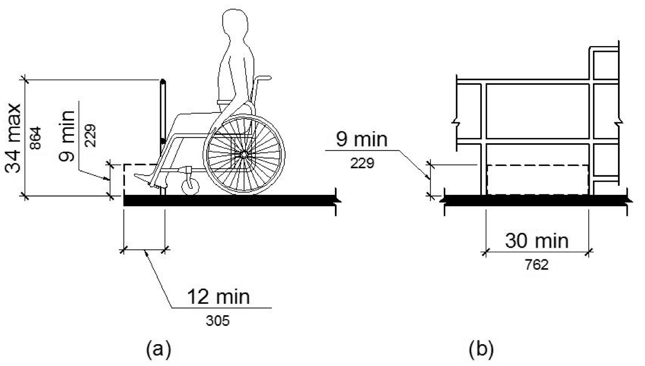
FIGURE 11B-1005.3.2 EXTENDED GROUND OR DECK SURFACE AT FISHING PIERS AND PLATFORMS
11B-1005.4 Clear floor or ground space.
At each location where there are railings, guards, or handrails complying with Section 11B-1005.2.1, a clear floor or ground space complying with Section 11B-305 shall be provided. Where there are no railings, guards, or handrails, at least one clear floor or ground space complying with Section 11B-305 shall be provided on the fishing pier or platform.
11B-1005.5 Turning space.
At least one turning space complying with Section 11B-304.3 shall be provided on fishing piers and platforms.
11B-1006.2 Accessible routes.
Accessible routes serving teeing grounds, practice teeing grounds, putting greens, practice putting greens, teeing stations at driving ranges, course weather shelters, golf car rental areas, bag drop areas, and course toilet rooms shall comply with Division 4 and shall be 48 inches (1219 mm) wide minimum. Where handrails are provided, accessible routes shall be 60 inches (1524 mm) wide minimum.
Exception: Handrails shall not be required on golf courses. Where handrails are provided on golf courses, the handrails shall not be required to comply with Section 11B-505.

Providing a golf car passage will permit a person that uses a golf car to practice driving a golf ball from the same position and stance used when playing the game. Additionally, the space required for a person using a golf car to enter and maneuver within the teeing stations required to be accessible should be considered. ◼
11B-1006.3.1 Clear width.
The clear width of golf car passages shall be 48 inches (1219 mm) minimum.
11B-1006.3.2 Barriers.
Where curbs or other constructed barriers prevent golf cars from entering a fairway, openings 60 inches (1524 mm) wide minimum shall be provided at intervals not to exceed 75 yards (69 m).
11B-1006.4 Weather shelters.
A clear floor or ground space 60 inches (1524 mm) minimum by 96 inches (2438 mm) minimum shall be provided within weather shelters.
11B-1007.1 General.
Miniature golf facilities shall comply with Section 11B-1007.
11B-1007.2 Accessible routes.
Accessible routes serving holes on miniature golf courses shall comply with Division 4. Accessible routes located on playing surfaces of miniature golf holes shall be permitted to use the exceptions in Section 11B-1007.2.
Exceptions:
- Playing surfaces shall not be required to comply with Section 11B-302.2.
- Where accessible routes intersect playing surfaces of holes, a 1 inch (25 mm) maximum curb shall be permitted for a width of 32 inches (813 mm) minimum.
- A slope not steeper than 1:4 for a 4 inch (102 mm) maximum rise shall be permitted.
- Ramp landing slopes specified by Section 11B-405.7.1 shall be permitted to be 1:20 maximum.
- Ramp landing length specified by Section 11B-405.7.3 shall be permitted to be 48 inches (1219 mm) long minimum.
- Ramp landing size specified by Section 11B-405.7.4 shall be permitted to be 48 inches (1219 mm) minimum by 60 inches (1524 mm) minimum.
- Handrails shall not be required on holes. Where handrails are provided on holes, the handrails shall not be required to comply with Section 11B-505.
11B-1007.3 Miniature golf holes.
Miniature golf holes shall comply with Section 11B-1007.3.
11B-1007.3.1 Start of play.
A clear floor or ground space 48 inches (1219 mm) minimum by 60 inches (1524 mm) minimum with slopes not steeper than 1:48 shall be provided at the start of play.
11B-1007.3.2 Golf club reach range area.
All areas within holes where golf balls rest shall be within 36 inches (914 mm) maximum of a clear floor or ground space 36 inches (914 mm) wide minimum and 48 inches (1219 mm) long minimum having a running slope not steeper than 1:20. The clear floor or ground space shall be served by an accessible route.

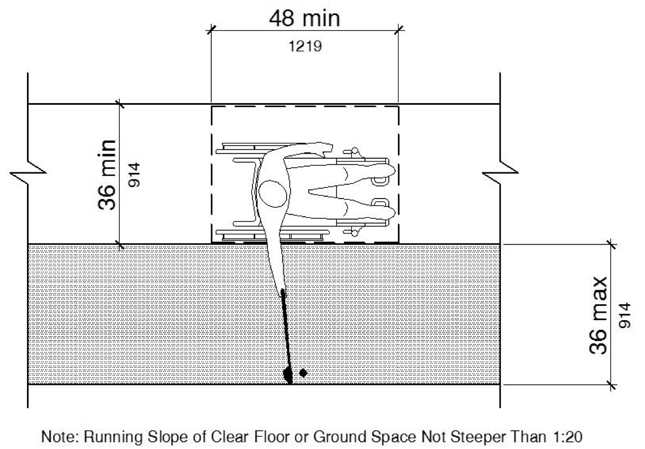
FIGURE 11B-1007.3.2 GOLF CLUB REACH RANGE AREA
11B-1008.2 Accessible routes.
Accessible routes serving play areas shall comply with Division 4 and Section 11B-1008.2 and shall be permitted to use the exceptions in Sections 11B-1008.2.1 through 11B-1008.2.3. Where accessible routes serve ground level play components, the vertical clearance shall be 80 inches (2032 mm) high minimum.
11B-1008.2.1 Ground level and elevated play components.
Accessible routes serving ground level play components and elevated play components shall be permitted to use the exceptions in Section 11B-1008.2.1.
Exceptions:
- Transfer systems complying with Section 11B-1008.3 shall be permitted to connect elevated play components except where 20 or more elevated play components are provided no more than 25 percent of the elevated play components shall be permitted to be connected by transfer systems.
- Where transfer systems are provided, an elevated play component shall be permitted to connect to another elevated play component as part of an accessible route.
11B-1008.2.2 Soft contained play structures.
Accessible routes serving soft contained play structures shall be permitted to use the exception in Section 11B-1008.2.2.
Exception: Transfer systems complying with Section 11B-1008.3 shall be permitted to be used as part of an accessible route.
11B-1008.2.3 Water play components.
Accessible routes serving water play components shall be permitted to use the exceptions in Section 11B-1008.2.3.
Exceptions:
- Where the surface of the accessible route, clear floor or ground spaces, or turning spaces serving water play components is submerged, compliance with Sections 11B-302, 11B-403.3, 11B-405.2, 11B-405.3, and 11B-1008.2.6 shall not be required.
- Transfer systems complying with Section 11B-1008.3 shall be permitted to connect elevated play components in water.

11B-1008.2.4 Clear width.
Accessible routes connecting play components shall provide a clear width complying with Section 11B-1008.2.4.
At ground level, the clear width of accessible routes shall be 60 inches (1524 mm) minimum.
Exceptions:
- In play areas less than 1000 square feet (93 m2), the clear width of accessible routes shall be permitted to be 44 inches (1118 mm) minimum, if at least one turning space complying with Section 11B-304.3 is provided where the restricted accessible route exceeds 30 feet (9144 mm) in length.
- The clear width of accessible routes shall be permitted to be 36 inches (914 mm) minimum for a distance of 60 inches (1524 mm) maximum provided that multiple reduced width segments are separated by segments that are 60 inches (1524 mm) wide minimum and 60 inches (1524 mm) long minimum.
The clear width of accessible routes connecting elevated play components shall be 36 inches (914 mm) minimum.
Exceptions:
- The clear width of accessible routes connecting elevated play components shall be permitted to be reduced to 32 inches (813 mm) minimum for a distance of 24 inches (610 mm) maximum provided that reduced width segments are separated by segments that are 48 inches (1219 mm) long minimum and 36 inches (914 mm) wide minimum.
- The clear width of transfer systems connecting elevated play components shall be permitted to be 24 inches (610 mm) minimum.
11B-1008.2.5 Ramps.
Within play areas, ramps connecting ground level play components and ramps connecting elevated play components shall comply with Section 11B-1008.2.5.
Ramp runs connecting ground level play components shall have a running slope not steeper than 1:16.
The rise for any ramp run connecting elevated play components shall be 12 inches (305 mm) maximum.
ETA Editor's Note
The above restrictions on ramp slope for ramps connecting ground level play components, and on ramp rise for ramps connecting elevated play components, are more stringent than the ramp slope and rise restrictions prescribed at CBC 11B-405.2 and 11B-405.6, and at 2010 ADA Standards 405.2 and 405.6.
Where required on ramps serving play components, the handrails shall comply with Section 11B-505 except as modified by Section 11B-1008.2.5.3.
Exceptions:
11B-1008.2.5.3.1 Handrail gripping surfaces.
Handrail gripping surfaces with a circular cross section shall have an outside diameter of 0.95 inch (24 mm) minimum and 1.55 inches (39 mm) maximum. Where the shape of the gripping surface is non-circular, the handrail shall provide an equivalent gripping surface.
11B-1008.2.5.3.2 Handrail height.
The top of handrail gripping surfaces shall be 20 inches (508 mm) minimum and 28 inches (711 mm) maximum above the ramp surface.
11B-1008.2.6 Ground surfaces.
Ground surfaces on accessible routes, clear floor or ground spaces, and turning spaces shall comply with Section 11B-1008.2.6.

Ground surfaces shall comply with ASTM F 1951. Ground surfaces shall be inspected and maintained regularly and frequently to ensure continued compliance with ASTM F 1951.
Ground surfaces located within use zones shall comply with ASTM F 1292 (1999 edition or 2004 edition).
11B-1008.3 Transfer systems.
Where transfer systems are provided to connect to elevated play components, transfer systems shall comply with Section 11B-1008.3.

11B-1008.3.1 Transfer platforms.
Transfer platforms shall be provided where transfer is intended from wheelchairs or other mobility aids. Transfer platforms shall comply with Section 11B-1008.3.1.
Transfer platforms shall have level surfaces 14 inches (356 mm) deep minimum and 24 inches (610 mm) wide minimum.
The height of transfer platforms shall be 11 inches (279 mm) minimum and 18 inches (457 mm) maximum measured to the top of the surface from the ground or floor surface.
11B-1008.3.1.3 Transfer space.
A transfer space complying with Sections 11B-305.2 and 11B-305.3 shall be provided adjacent to the transfer platform. The 48 inch (1219 mm) long minimum dimension of the transfer space shall be centered on and parallel to the 24 inch (610 mm) long minimum side of the transfer platform. The side of the transfer platform serving the transfer space shall be unobstructed.
11B-1008.3.1.4 Transfer supports.
At least one means of support for transferring shall be provided.
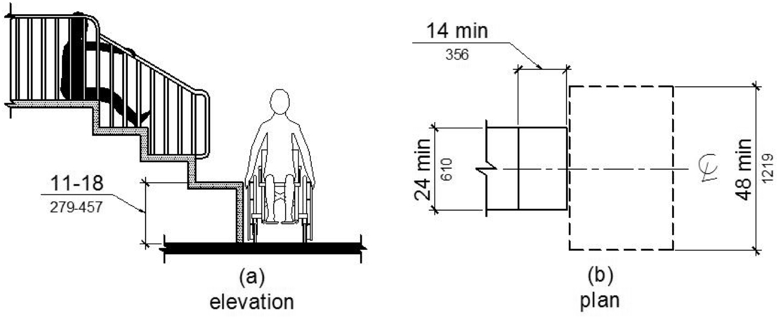
FIGURE 11B-1008.3.1 TRANSFER PLATFORMS
11B-1008.3.2 Transfer steps.
Transfer steps shall be provided where movement is intended from transfer platforms to levels with elevated play components required to be on accessible routes. Transfer steps shall comply with Section 11B-1008.3.2.
Transfer steps shall have level surfaces 14 inches (356 mm) deep minimum and 24 inches (610 mm) wide minimum.
Each transfer step shall be 8 inches (203 mm) high maximum.
11B-1008.3.2.3 Transfer supports.
At least one means of support for transferring shall be provided.

11B-1008.3.2.4 Contrasting stripe.
Striping complying with Section 11B-504.4.1 shall be provided at each transfer step.
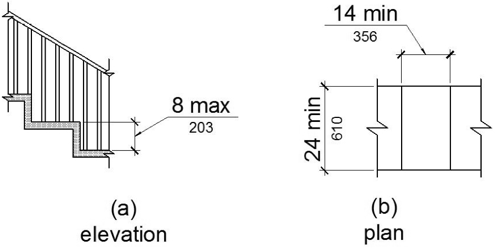
FIGURE 11B-1008.3.2 TRANSFER STEPS
11B-1008.4 Play components.
Ground level play components on accessible routes and elevated play components connected by ramps shall comply with Section 11B-1008.4.
11B-1008.4.1 Turning space.
At least one turning space complying with Section 11B-304 shall be provided on the same level as play components. Where swings are provided, the turning space shall be located immediately adjacent to the swing.
11B-1008.4.2 Clear floor or ground space.
Clear floor or ground space complying with Sections 11B-305.2 and 11B-305.3 shall be provided at play components.

When designing play components with manipulative or interactive features, consider appropriate reach ranges for children seated in wheelchairs. The following table provides guidance on reach ranges for children seated in wheelchairs. These dimensions apply to either forward or side reaches. The reach ranges are appropriate for use with those play components that children seated in wheelchairs may access and reach. Where transfer systems provide access to elevated play components, the reach ranges are not appropriate. ◼
[2010 ADA Standards] Children's Reach Ranges
|
Forward or Side Reach |
Ages 3 and 4 | Ages 5 through 8 |
Ages 9 through 12 |
|---|---|---|---|
|
High (maximum) |
36 in (915 mm) |
40 in (1015 mm) |
44 in (1120 mm) |
|
Low (minimum) |
20 in (510 mm) |
18 in (455 mm) |
16 in (405 mm) |
11B-1008.4.3 Play tables.
Where play tables are provided, knee clearance 24 inches (610 mm) high minimum, 17 inches deep (432 mm) minimum, and 30 inches (762 mm) wide minimum shall be provided. The tops of rims, curbs, or other obstructions shall be 31 inches (787 mm) high maximum.
Exception: Play tables designed and constructed primarily for children 5 years and younger shall not be required to provide knee clearance where the clear floor or ground space required by Section 11B-1008.4.2 is arranged for a parallel approach.
11B-1008.4.4 Entry points and seats.
Where play components require transfer to entry points or seats, the entry points or seats shall be 11 inches (279 mm) minimum and 24 inches (610 mm) maximum from the clear floor or ground space.
Exception: Entry points of slides shall not be required to comply with Section 11B-1008.4.4.
11B-1008.4.5 Transfer supports.
Where play components require transfer to entry points or seats, at least one means of support for transferring shall be provided.
11B-1009.1 General.
Where provided, pool lifts, sloped entries, transfer walls, transfer systems, and pool stairs shall comply with Section 11B-1009.
11B-1009.2 Pool lifts.
Pool lifts shall comply with Section 11B-1009.2.

11B-1009.2.1 Pool lift location.
Pool lifts shall be located where the water level is 36 inches (914 mm) minimum and 48 inches (1219 mm) maximum.
[2010 ADA Standards] 1009.2.1 Pool Lift Location. Pool lifts shall be located where the water level does not exceed 48 inches (1220 mm).
Exceptions:
1. Where the entire pool depth is less than 36 inches (914 mm) or greater than 48 inches (1219 mm), compliance with Section 11B-1009.2.1 shall not be required.
[2010 ADA Standards] 1. Where the entire pool depth is greater than 48 inches (1220 mm), compliance with 1009.2.1 shall not be required.
2. Where multiple pool lift locations are provided, no more than one pool lift shall be required to be located in an area where the water level is 48 inches (1219 mm) maximum.
11B-1009.2.2 Seat location.
In the raised position, the centerline of the seat shall be located over the deck and 16 inches (406 mm) minimum from the edge of the pool. The deck surface between the centerline of the seat and the pool edge shall have a slope not steeper than 1:48.
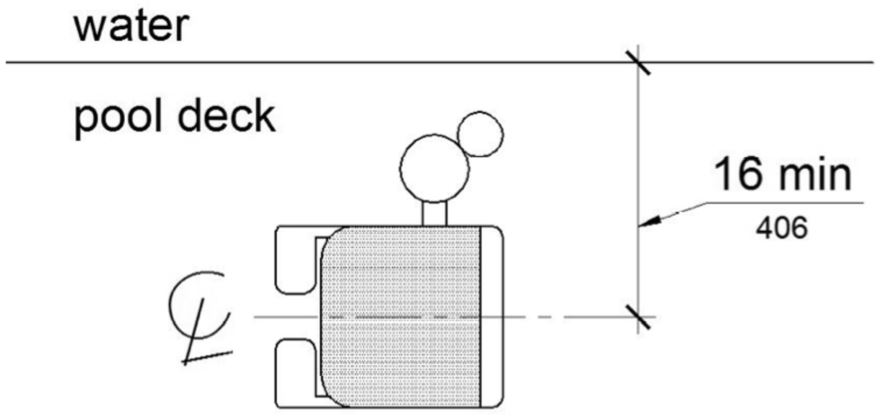
FIGURE 11B-1009.2.2 POOL LIFT SEAT LOCATION
11B-1009.2.3 Clear deck space.
On the side of the seat opposite the water, a clear deck space shall be provided parallel with the seat. The space shall be 36 inches (914 mm) wide minimum and shall extend forward 48 inches (1219 mm) minimum from a line located 12 inches (305 mm) behind the rear edge of the seat. The clear deck space shall have a slope not steeper than 1:48.
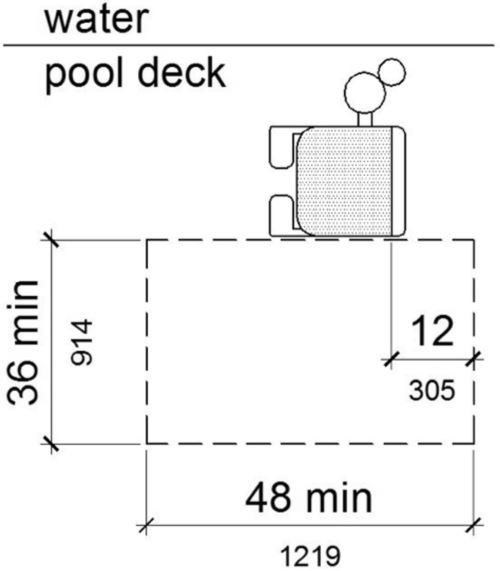
FIGURE 11B-1009.2.3 CLEAR DECK SPACE AT POOL LIFTS
11B-1009.2.4 Seat.
The seat shall be rigid and shall have a back support that is at least 12 inches (305 mm) tall. The height of the lift seat shall be designed to allow a stop at 17 inches (432 mm) minimum to 19 inches (483 mm) maximum measured from the deck to the top of the seat surface when in the raised (load) position. The seat shall have a restraint for the use of the occupant with operable parts complying with Section 11B-309.
[2010 ADA Standards] 1009.2.4 Seat Height. The height of the lift seat shall be designed to allow a stop at 16 inches (405 mm) minimum to 19 inches (485 mm) maximum measured from the deck to the top of the seat surface when in the raised (load) position.
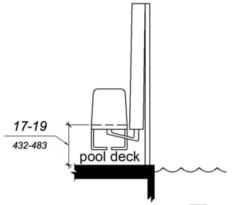
FIGURE 11B-1009.2.4 POOL LIFT SEAT HEIGHT ‡‡
11B-1009.2.5 Seat width.
The seat shall be 16 inches (406 mm) wide minimum.
11B-1009.2.6 Footrests and armrests.
Footrests shall be provided and shall move with the seat. The seat shall have two armrests. The armrest positioned opposite the water shall be removable or shall fold clear of the seat when the seat is in the raised (load) position.
[2010 ADA Standards] 1009.2.6 Footrests and Armrests. Footrests shall be provided and shall move with the seat. If provided, the armrest positioned opposite the water shall be removable or shall fold clear of the seat when the seat is in the raised (load) position.
Exception: Footrests shall not be required on pool lifts provided in spas.
11B-1009.2.7 Operation.
The lift shall be capable of unassisted operation from both the deck and water levels. Controls and operating mechanisms shall be unobstructed when the lift is in use and shall comply with Section 11B-309.4. The lift shall be stable and not permit unintended movement when a person is getting into or out of the seat.
[2010 ADA Standards] 1009.2.7 Operation. The lift shall be capable of unassisted operation from both the deck and water levels. Controls and operating mechanisms shall be unobstructed when the lift is in use and shall comply with 309.4.

11B-1009.2.8 Submerged depth.
The lift shall be designed so that the seat will submerge to a water depth of 18 inches (457 mm) minimum below the stationary water level.
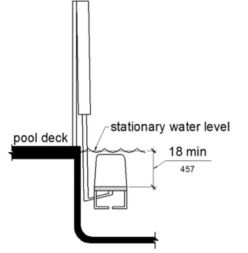
FIGURE 11B-1009.2.8 POOL LIFT SUBMERGED DEPTH
11B-1009.2.9 Lifting capacity.
Single person pool lifts shall have a weight capacity of 300 pounds (136 kg) minimum and be capable of sustaining a static load of at least one and a half times the rated load.

11B-1009.3 Sloped entries.
Sloped entries shall comply with Section 11B-1009.3.

11B-1009.3.1 Sloped entries.
Sloped entries shall comply with Division 4 except as modified in Sections 11B-1009.3.1 through 11B-1009.3.3.
Exception: Where sloped entries are provided, the surfaces shall not be required to be slip resistant.
11B-1009.3.2 Submerged depth.
Sloped entries shall extend to a depth of 24 inches (610 mm) minimum and 30 inches (762 mm) maximum below the stationary water level. Where landings are required by Section 11B-405.7, at least one landing shall be located 24 inches (610 mm) minimum and 30 inches (762 mm) maximum below the stationary water level.
Exception: In wading pools, the sloped entry and landings, if provided, shall extend to the deepest part of the wading pool.

FIGURE 11B-1009.3.2 SLOPED ENTRY SUBMERGED DEPTH
11B-1009.3.3 Handrails.
At least two handrails complying with Section 11B-505 shall be provided on the sloped entry. The clear width between required handrails shall be 33 inches (838 mm) minimum and 38 inches (965 mm) maximum.
Exceptions:
- Handrail extensions specified by Section 11B-505.10.1 shall not be required at the bottom landing serving a sloped entry.
- Where a sloped entry is provided for wave action pools, leisure rivers, sand bottom pools, and other pools where user access is limited to one area, the handrails shall not be required to comply with the clear width requirements of Section 11B-1009.3.3.
- Sloped entries in wading pools shall not be required to provide handrails complying with Section 11B-1009.3.3. If provided, handrails on sloped entries in wading pools shall not be required to comply with Section 11B-505.
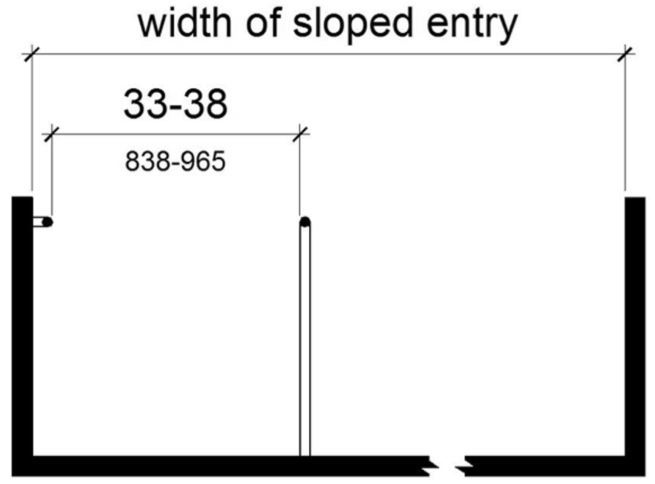
FIGURE 11B-1009.3.3 HANDRAILS FOR SLOPED ENTRY
11B-1009.4 Transfer walls.
Transfer walls shall comply with Section 11B-1009.4.
11B-1009.4.1 Clear deck space.
A clear deck space of 60 inches (1524 mm) minimum by 60 inches (1524 mm) minimum with a slope not steeper than 1:48 shall be provided at the base of the transfer wall. Where one grab bar is provided, the clear deck space shall be centered on the grab bar. Where two grab bars are provided, the clear deck space shall be centered on the clearance between the grab bars.
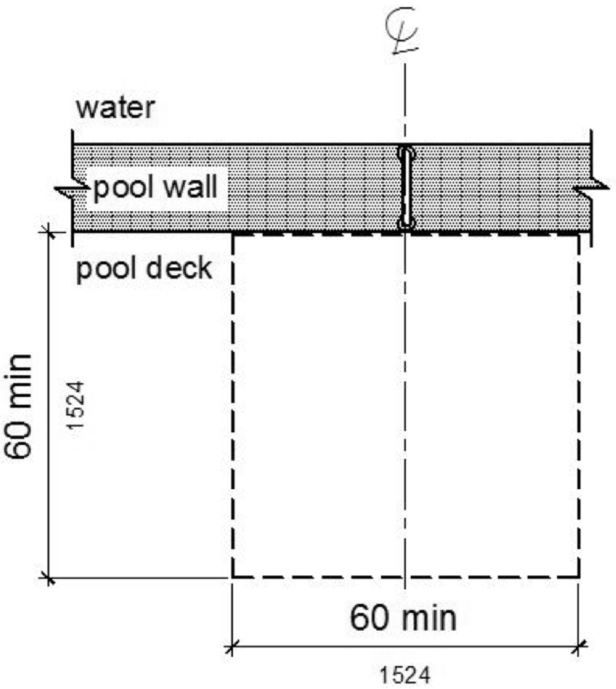
(a)
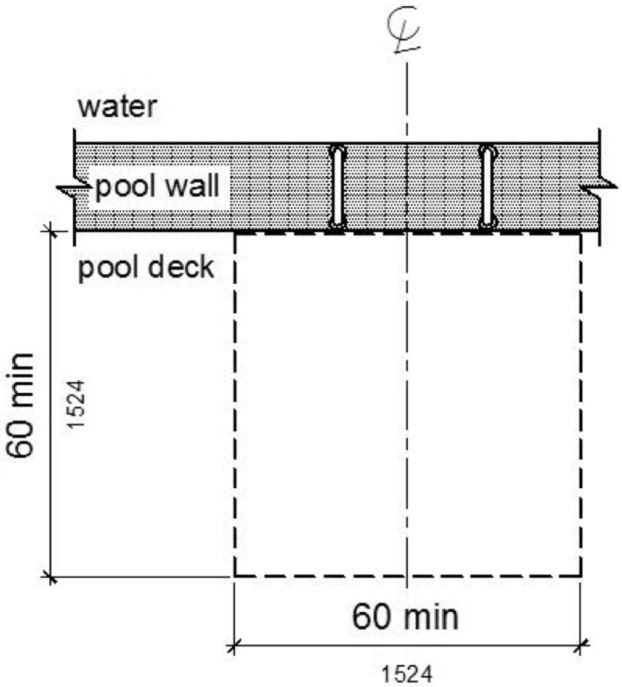
(b)
FIGURE 11B-1009.4.1 CLEAR DECK SPACE AT TRANSFER WALLS
11B-1009.4.2 Height.
The height of the transfer wall shall be 16 inches (406 mm) minimum and 19 inches (483 mm) maximum measured from the deck.
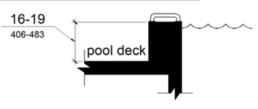
FIGURE 11B-1009.4.2 TRANSFER WALL HEIGHT
11B-1009.4.3 Wall depth and length.
The depth of the transfer wall shall be 12 inches (305 mm) minimum and 16 inches (406 mm) maximum. The length of the transfer wall shall be 60 inches (1524 mm) minimum and shall be centered on the clear deck space.
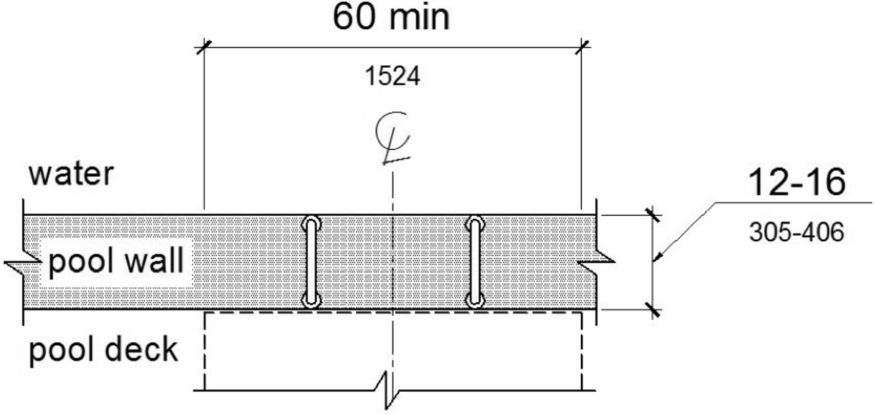
FIGURE 11B-1009.4.3 DEPTH AND LENGTH OF TRANSFER WALLS
11B-1009.4.4 Surface.
Surfaces of transfer walls shall not be sharp and shall have rounded edges.
11B-1009.4.5 Grab bars.
At least one grab bar complying with Section 11B-609 shall be provided on the transfer wall. Grab bars shall be perpendicular to the pool wall and shall extend the full depth of the transfer wall. The top of the gripping surface shall be 4 inches (102 mm) minimum and 6 inches (152 mm) maximum above transfer walls. Where one grab bar is provided, clearance shall be 24 inches (610 mm) minimum on both sides of the grab bar. Where two grab bars are provided, clearance between grab bars shall be 24 inches (610 mm) minimum.
Exception: Grab bars on transfer walls shall not be required to comply with Section 11B-609.4.
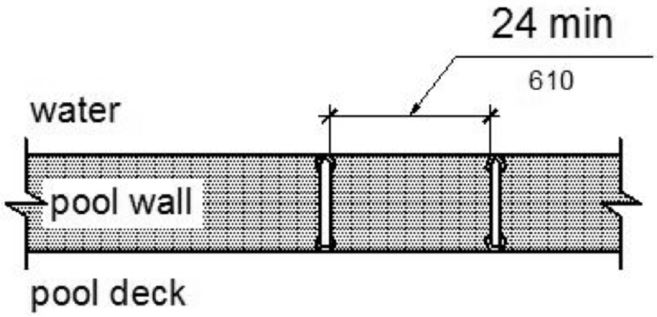
(a)
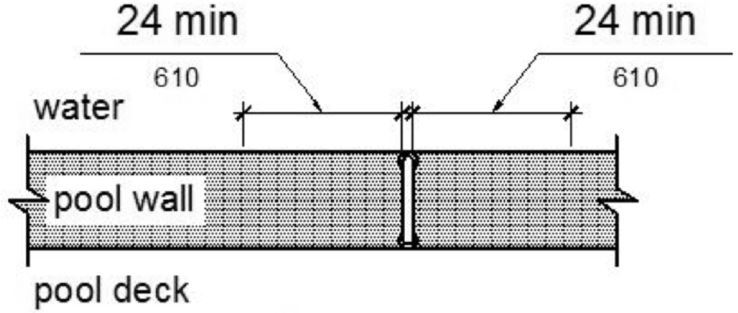
(b)
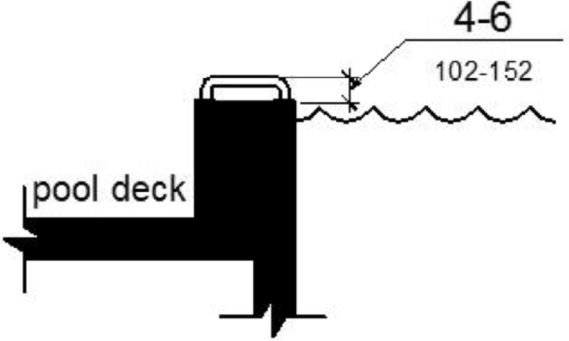
(c)
FIGURE 11B-1009.4.5 GRAB BARS FOR TRANSFER WALLS
11B-1009.5 Transfer systems.
Transfer systems shall comply with Section 11B-1009.5.
11B-1009.5.1 Transfer platform.
A transfer platform shall be provided at the head of each transfer system. Transfer platforms shall provide 19 inches (483 mm) minimum clear depth and 24 inches (610 mm) minimum clear width.
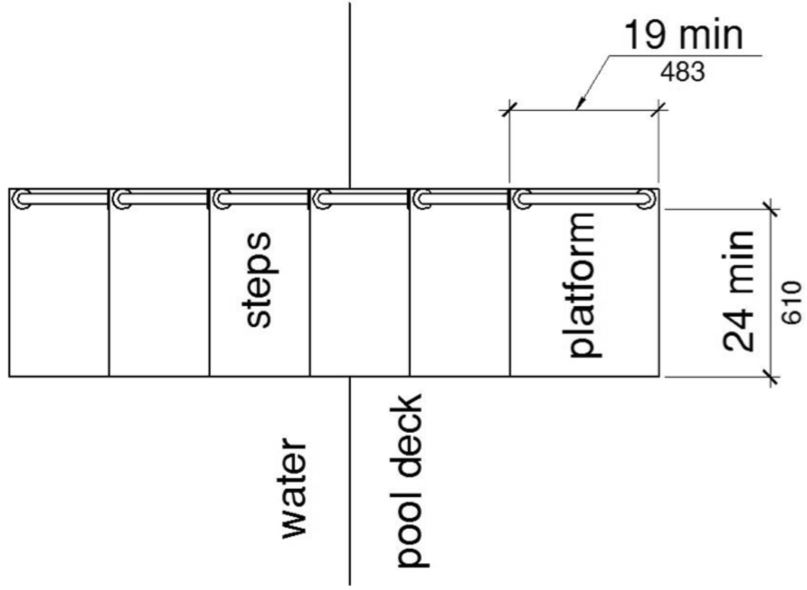
FIGURE 11B-1009.5.1 SIZE OF TRANSFER PLATFORM
11B-1009.5.2 Transfer space.
A transfer space of 60 inches (1524 mm) minimum by 60 inches (1524 mm) minimum with a slope not steeper than 1:48 shall be provided at the base of the transfer platform surface and shall be centered along a 24 inch (610 mm) minimum side of the transfer platform. The side of the transfer platform serving the transfer space shall be unobstructed.
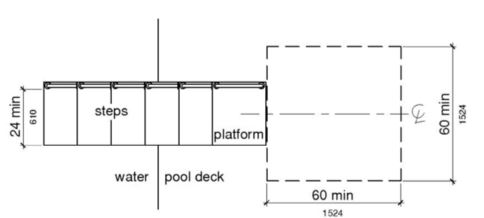
FIGURE 11B-1009.5.2 CLEAR DECK SPACE AT TRANSFER PLATFORM
11B-1009.5.3 Height.
The height of the transfer platform shall comply with Section 11B-1009.4.2.
11B-1009.5.4 Transfer steps.
Transfer step height shall be 8 inches (203 mm) maximum. The surface of the bottom tread shall extend to a water depth of 18 inches (457 mm) minimum below the stationary water level.

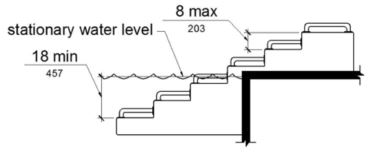
FIGURE 11B-1009.5.4 TRANSFER STEPS
11B-1009.5.5 Surface.
The surface of the transfer system shall not be sharp and shall have rounded edges.
11B-1009.5.6 Size.
Each transfer step shall have a tread clear depth of 14 inches (356 mm) minimum and 17 inches (432 mm) maximum and shall have a tread clear width of 24 inches (610 mm) minimum.
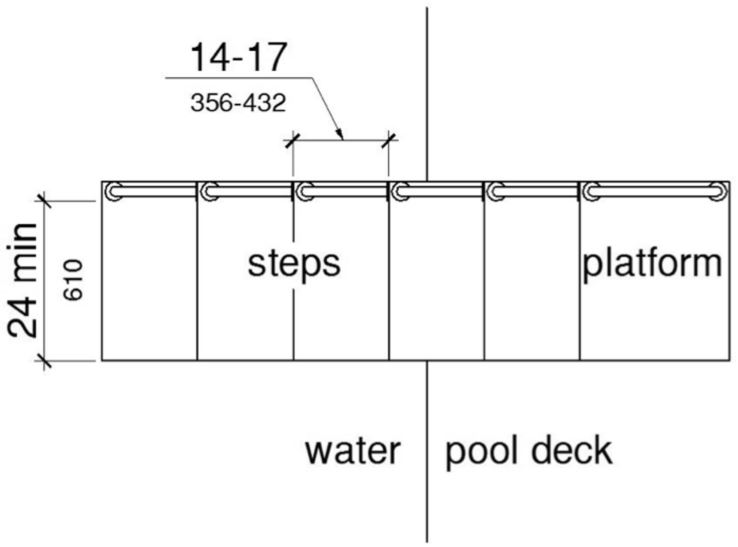
FIGURE 11B-1009.5.6 SIZE OF TRANSFER STEPS
11B-1009.5.7 Grab bars.
At least one grab bar on each transfer step and the transfer platform or a continuous grab bar serving each transfer step and the transfer platform shall be provided. Where a grab bar is provided on each step, the tops of gripping surfaces shall be 4 inches (102 mm) minimum and 6 inches (152 mm) maximum above each step and transfer platform. Where a continuous grab bar is provided, the top of the gripping surface shall be 4 inches (102 mm) minimum and 6 inches (152 mm) maximum above the step nosing and transfer platform. Grab bars shall comply with Section 11B-609 and be located on at least one side of the transfer system. The grab bar located at the transfer platform shall not obstruct transfer.
Exception: Grab bars on transfer systems shall not be required to comply with Section 11B-609.4.
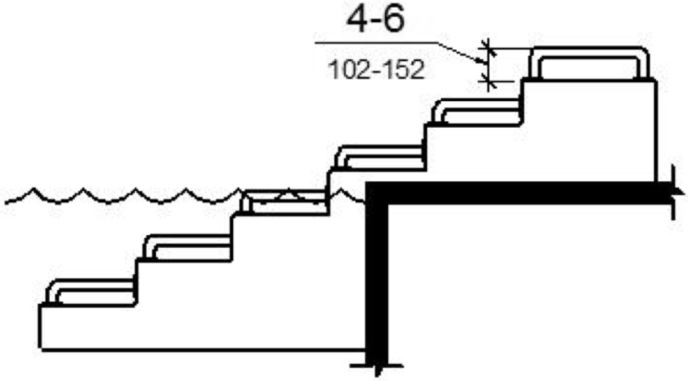
(a) individual grab bars
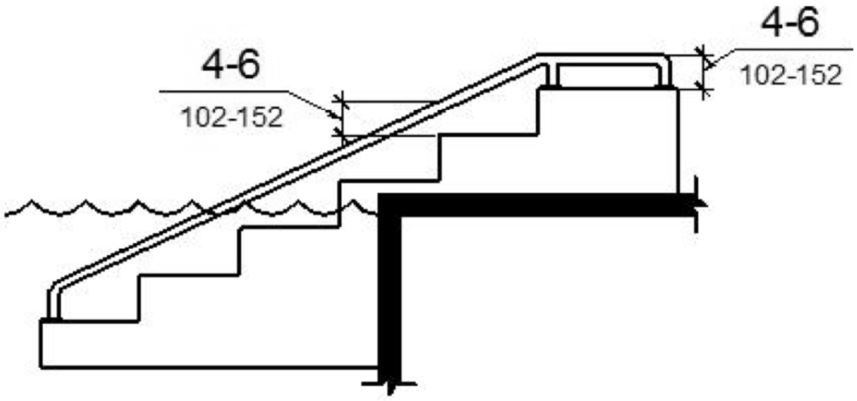
(b) continuous grab bars
FIGURE 11B-1009.5.7 GRAB BARS
11B-1009.6.1 Pool stairs.
Pool stairs shall comply with Section 11B-504.
Exception: Pool step riser heights shall not be required to be 4 inches (102 mm) high minimum and 7 inches (178 mm) high maximum provided that riser heights are uniform.
11B-1009.6.2 Handrails.
The width between handrails shall be 20 inches (508 mm) minimum and 24 inches (610 mm) maximum. Handrail extensions required by Section 11B-505.10.3 shall not be required on pool stairs.
11B-1010.1 Turning space.
A circular turning space 60 inches (1524 mm) diameter minimum with slopes not steeper than 1:48 shall be provided at shooting facilities with firing positions.















































User Comments/Questions
Add Comment/Question